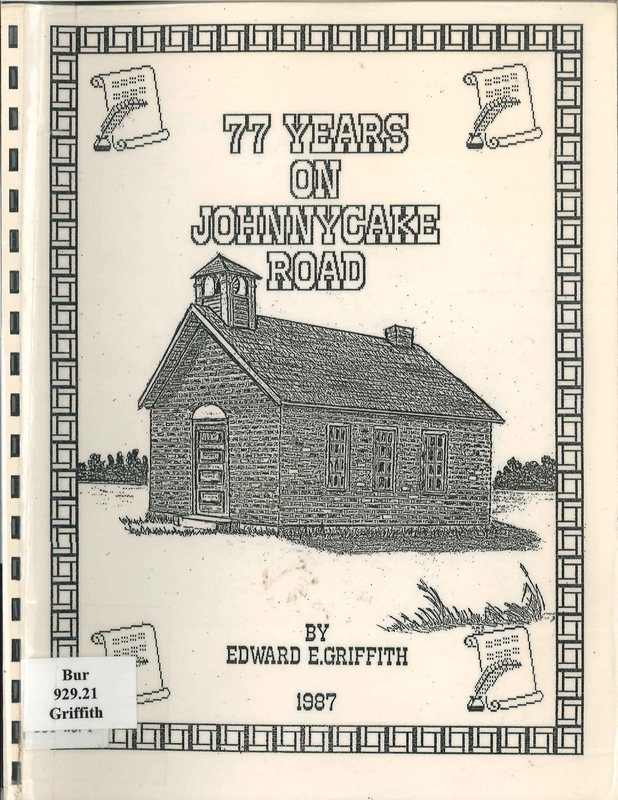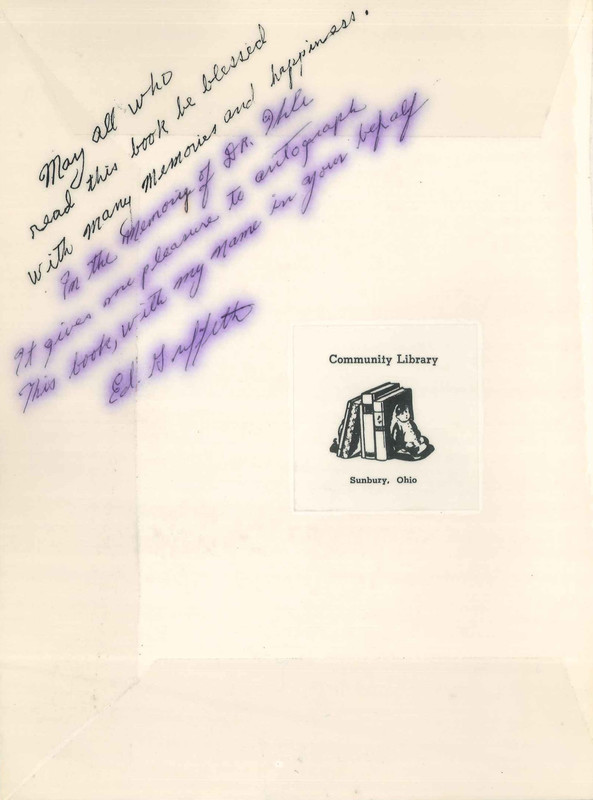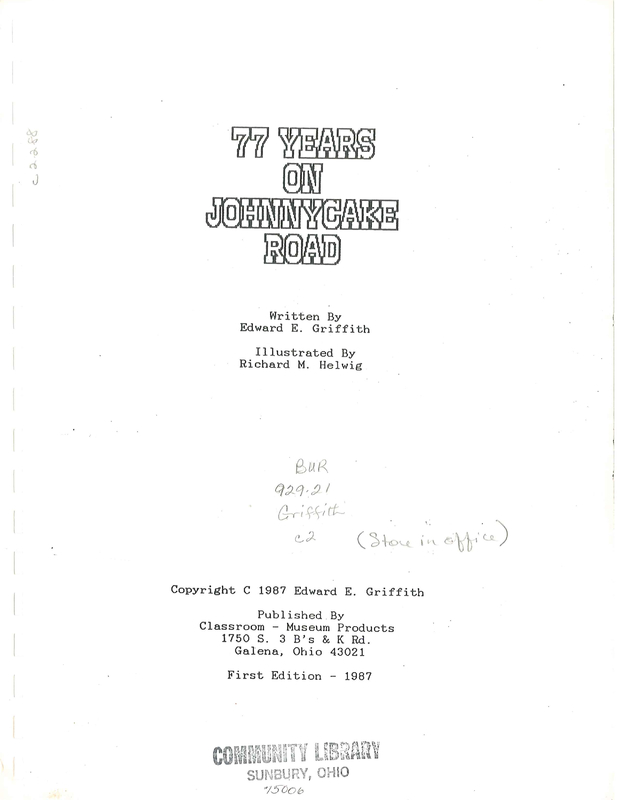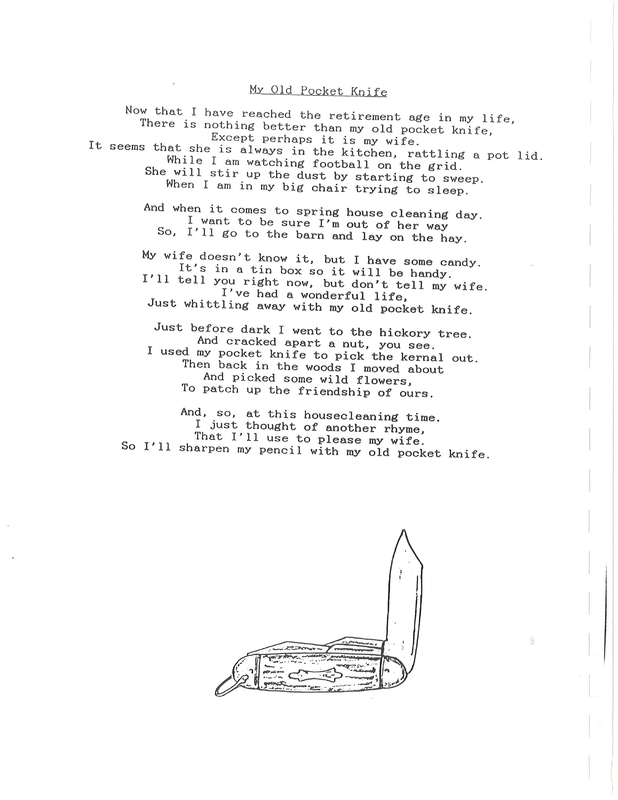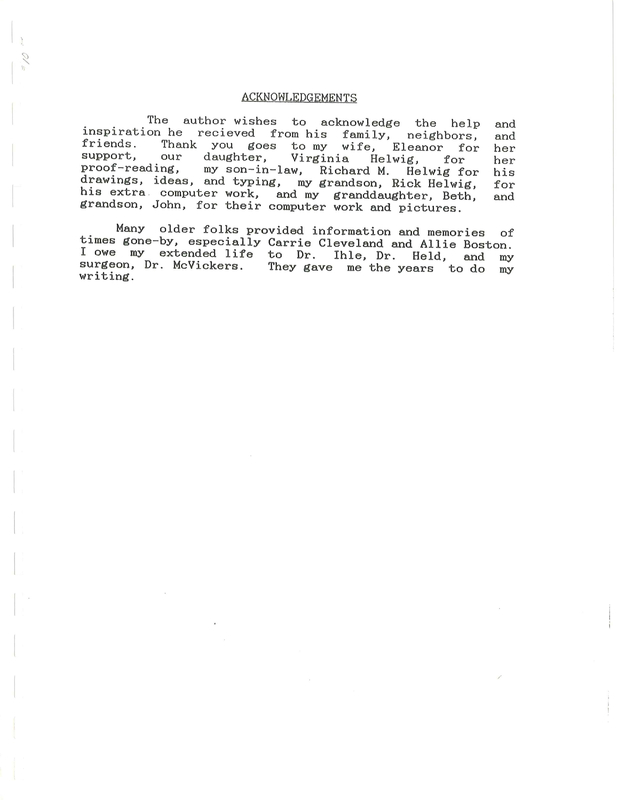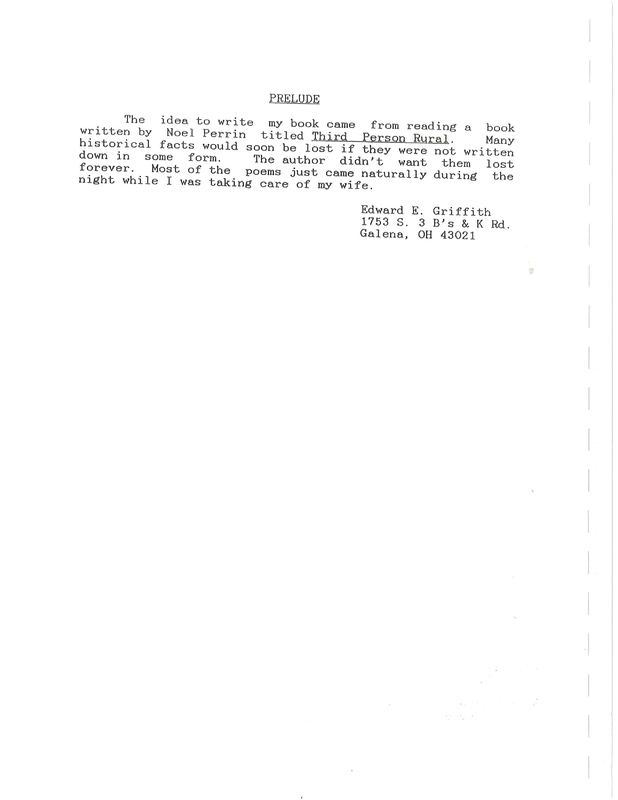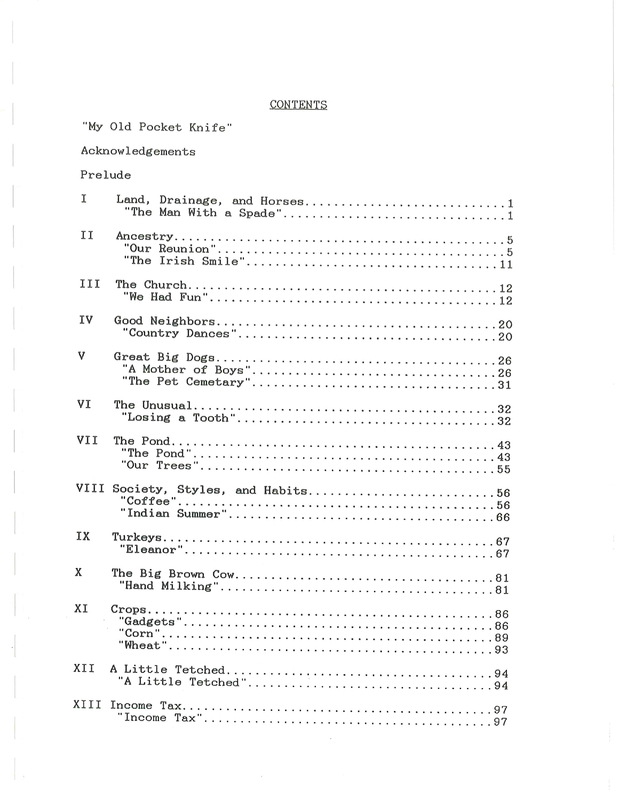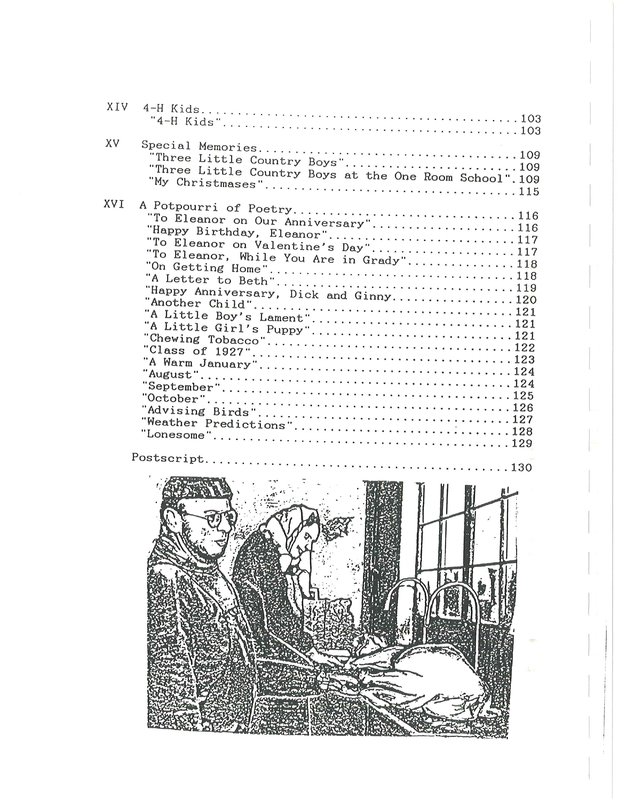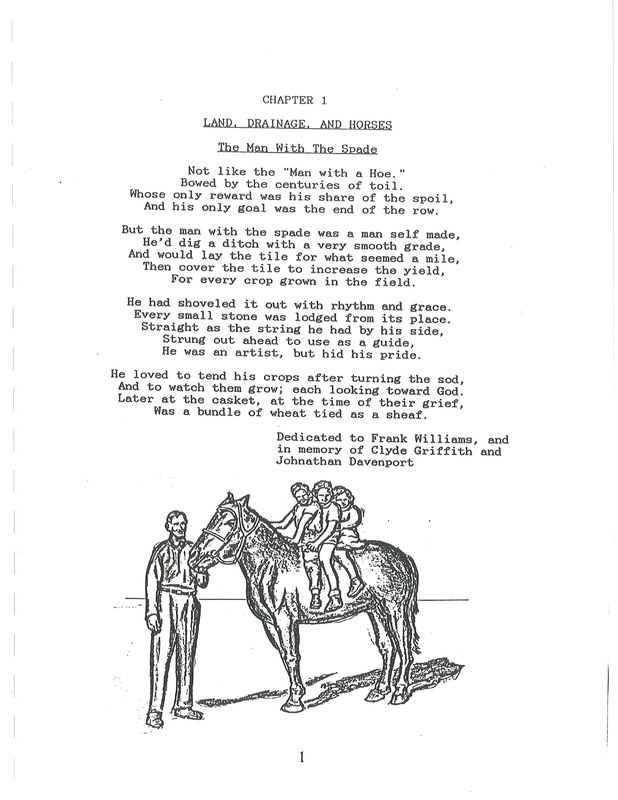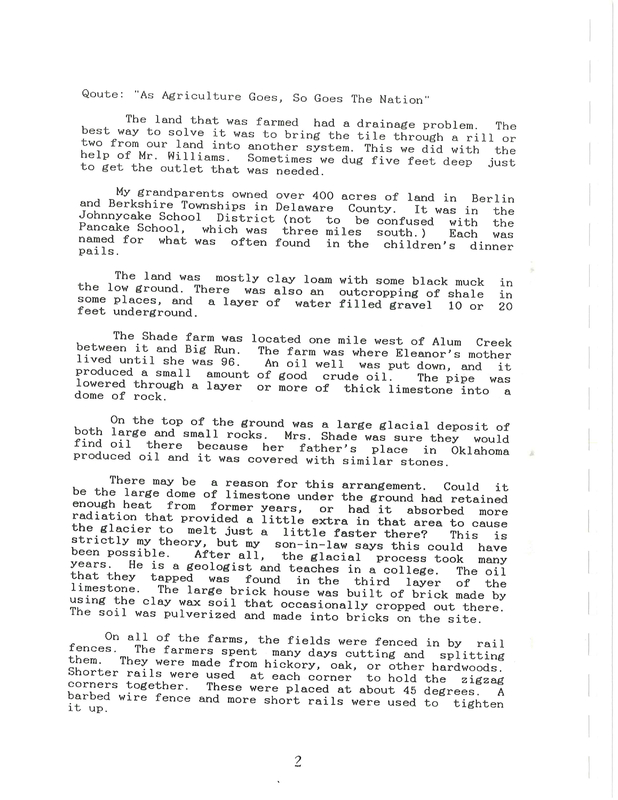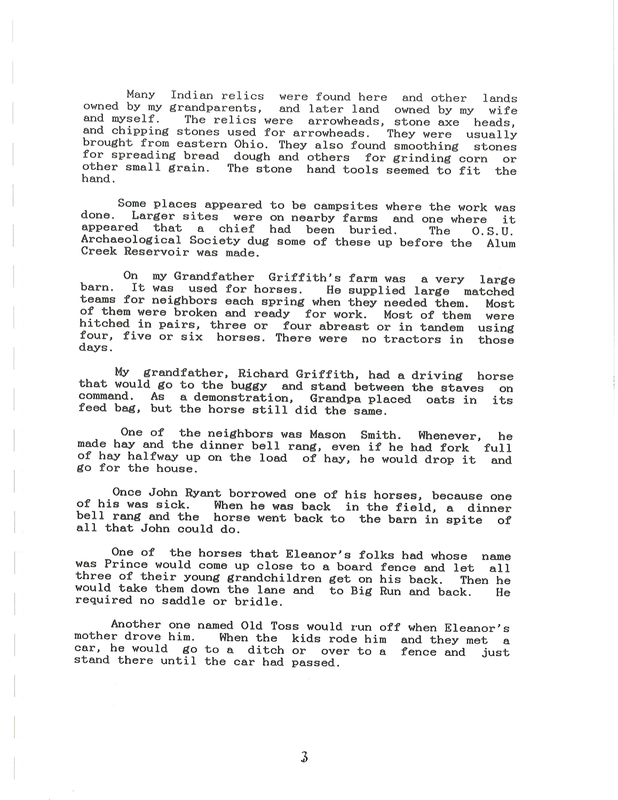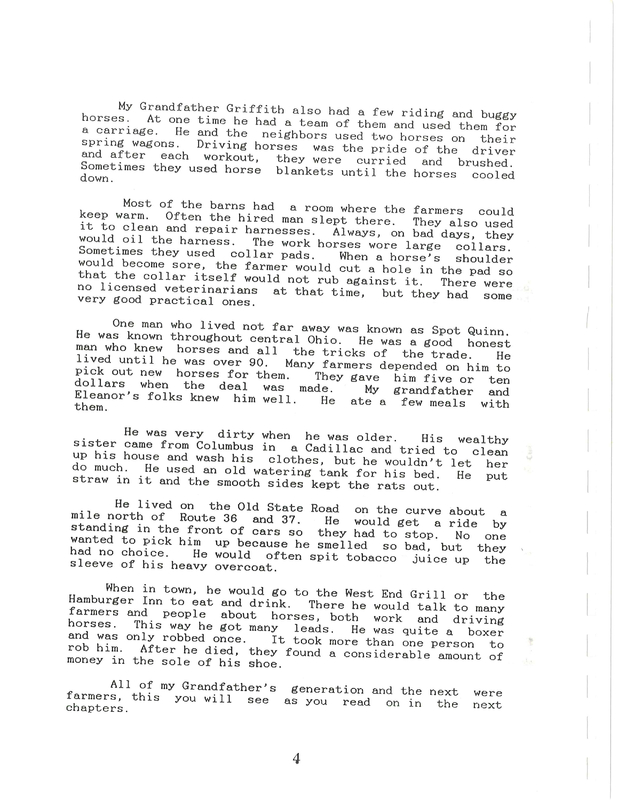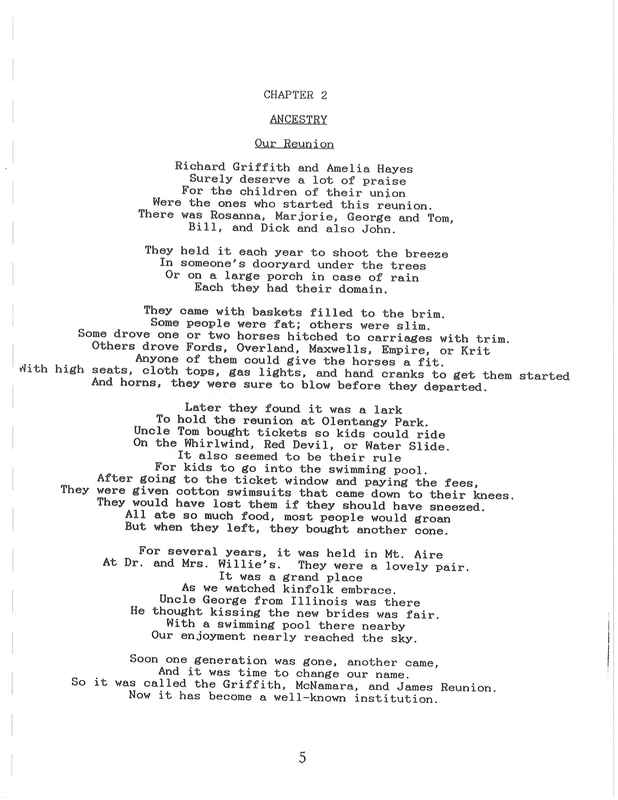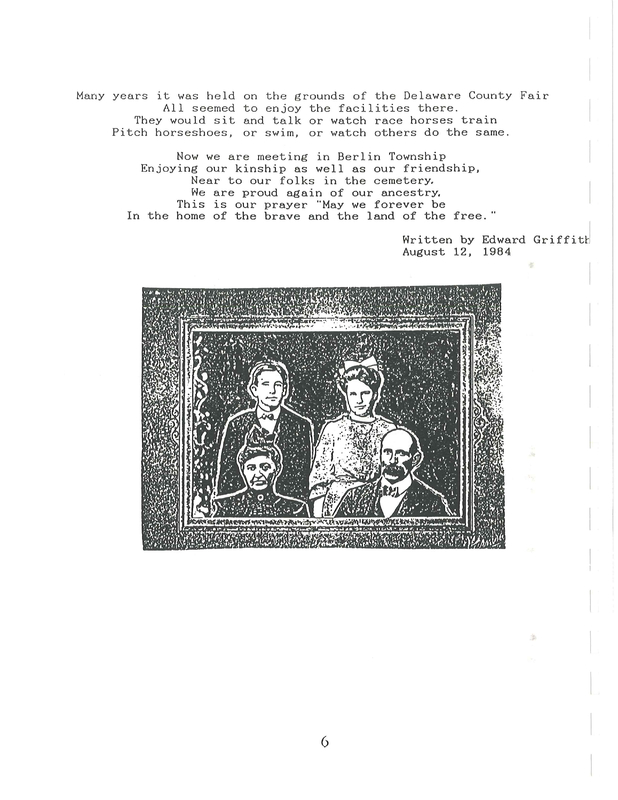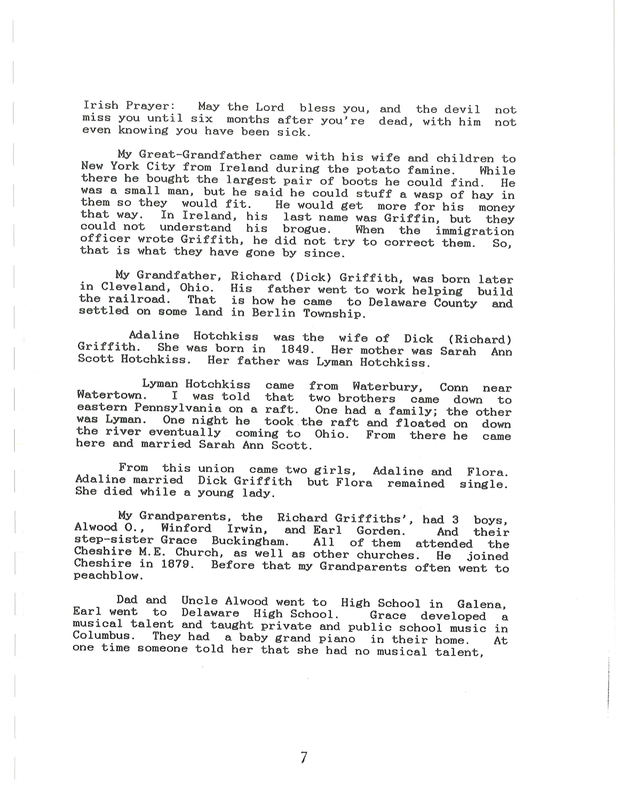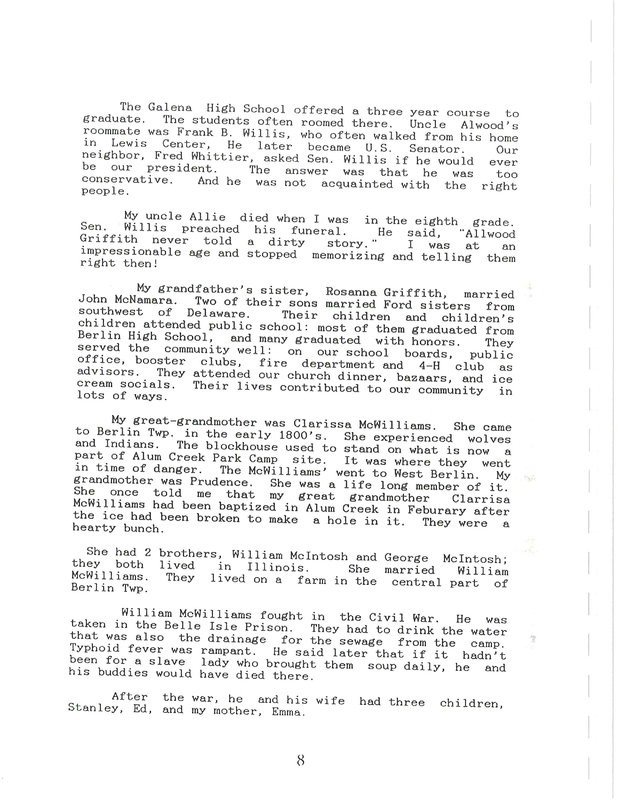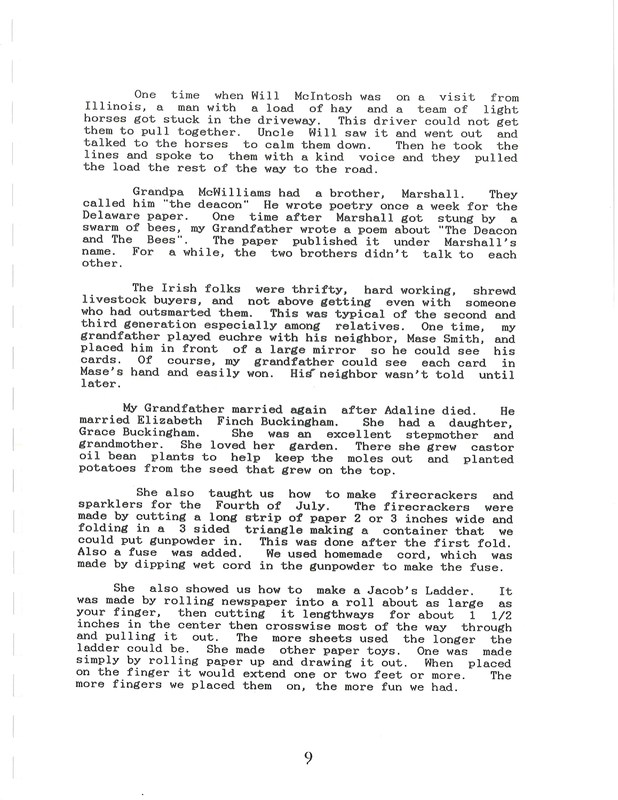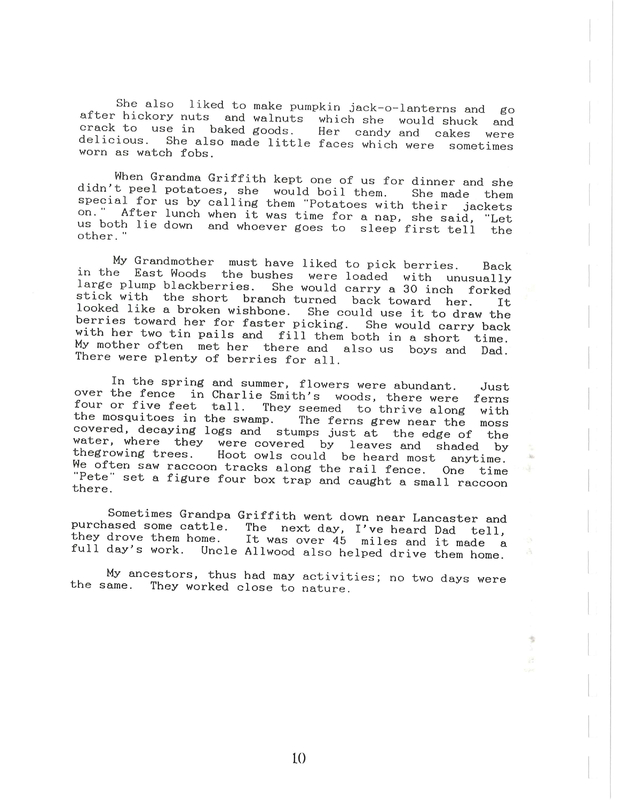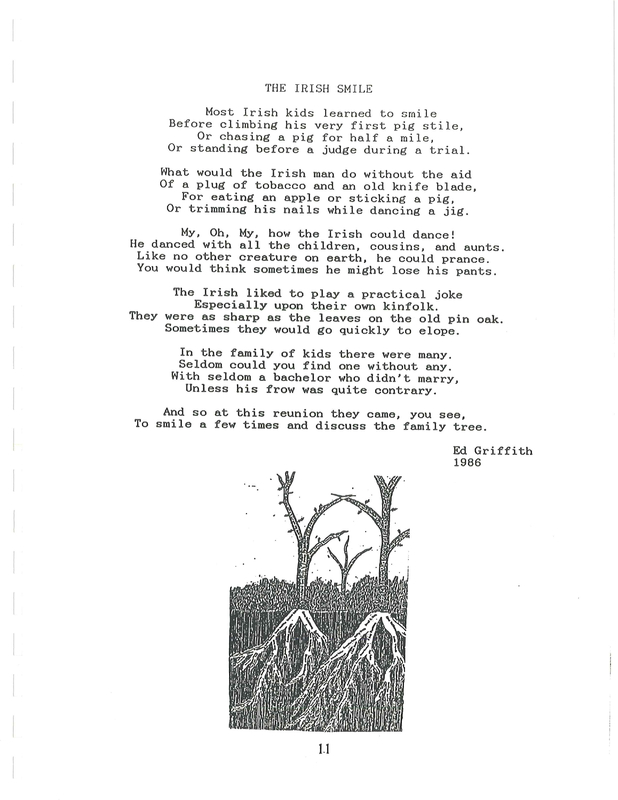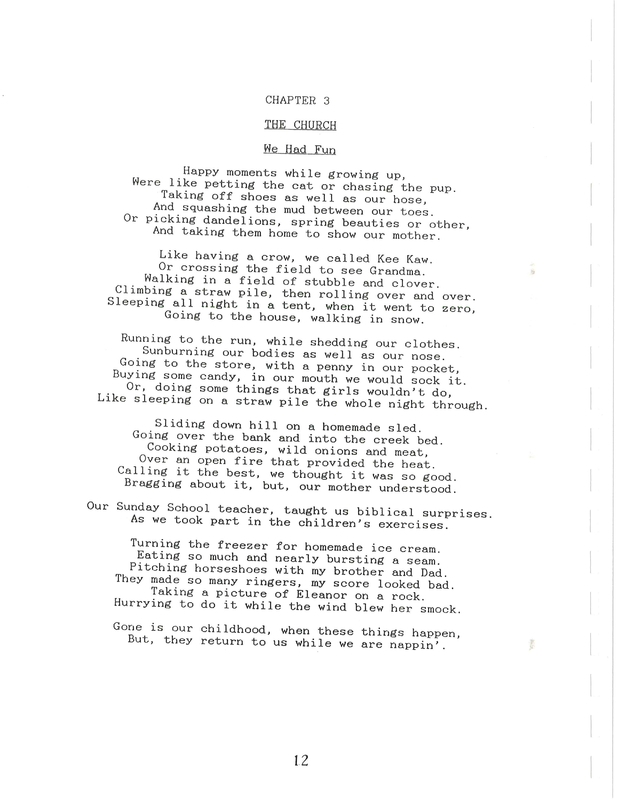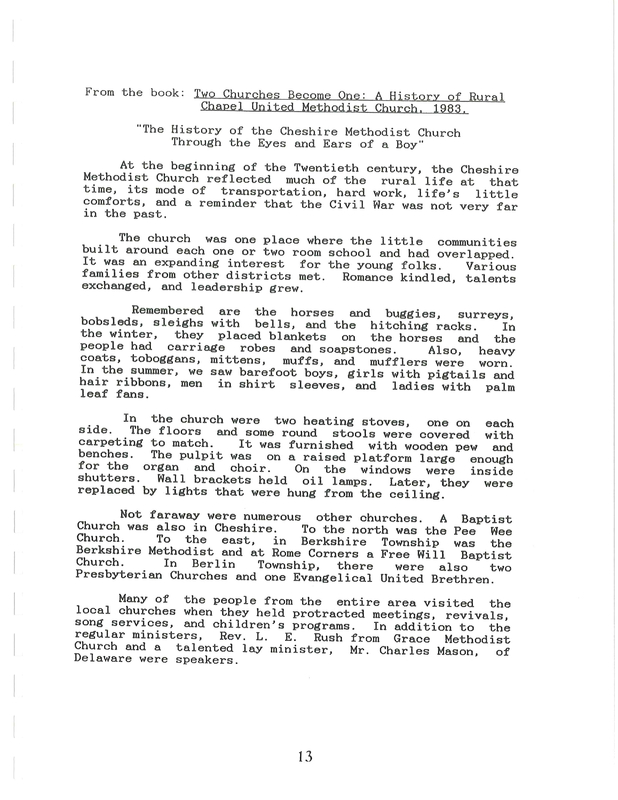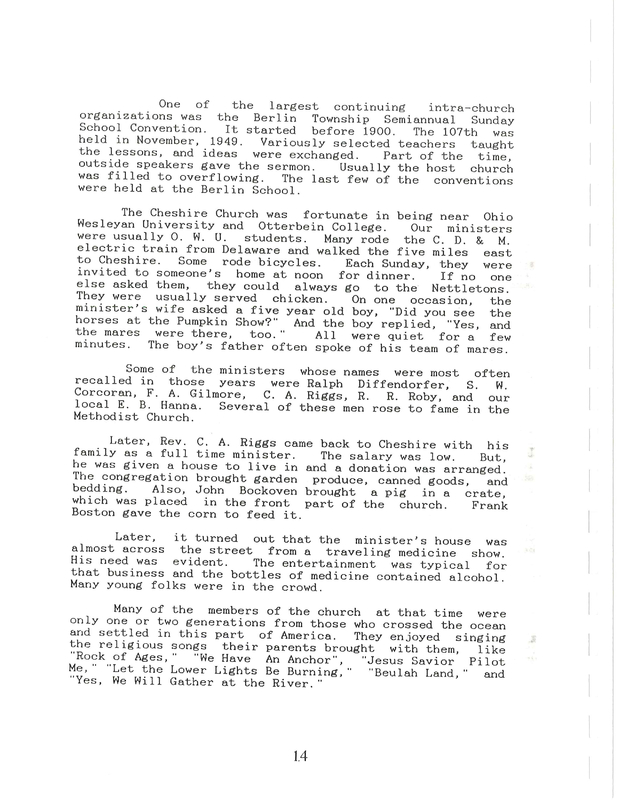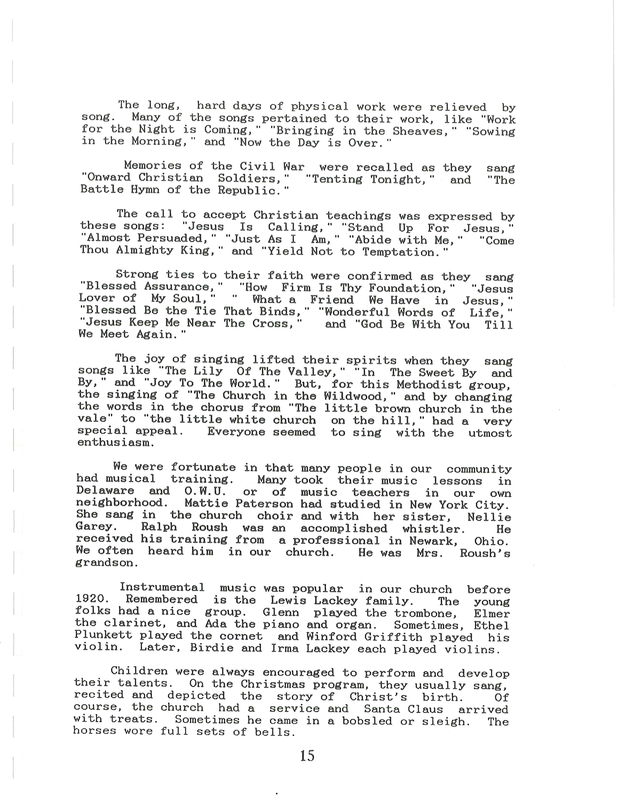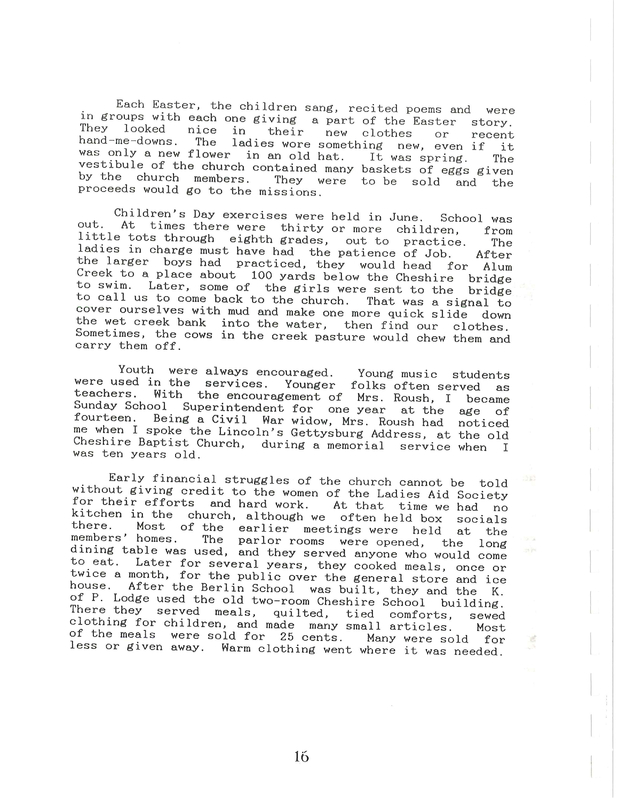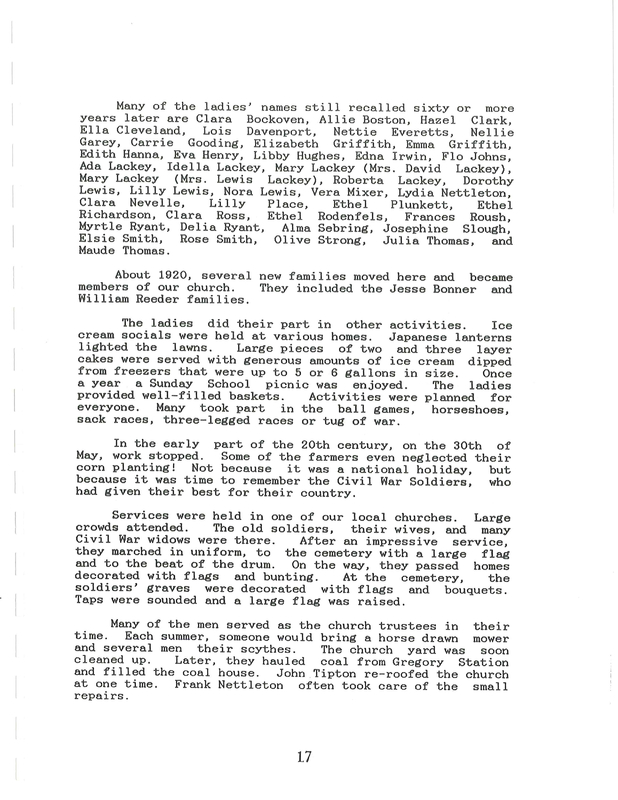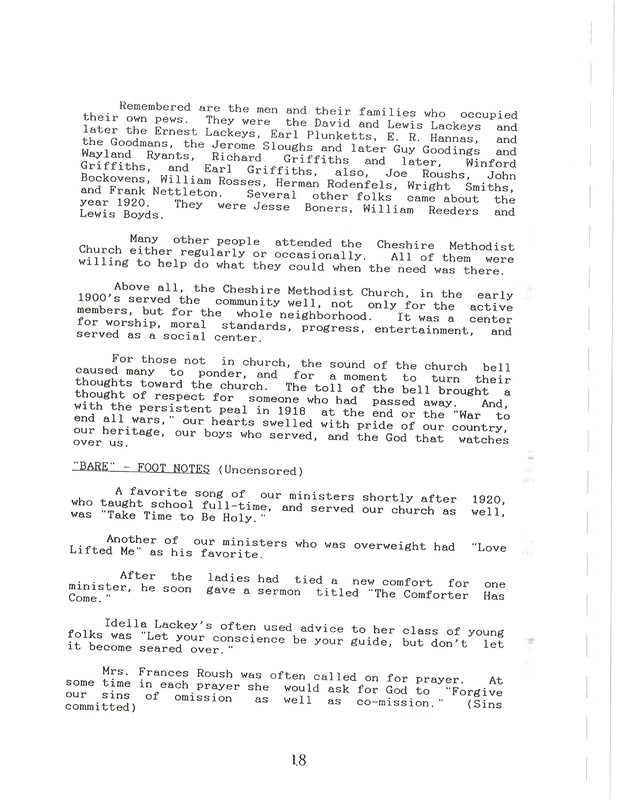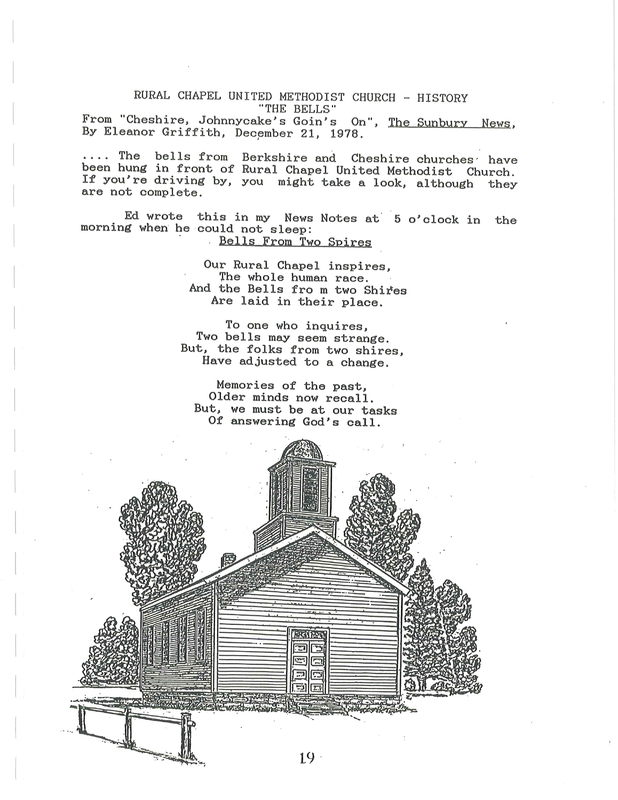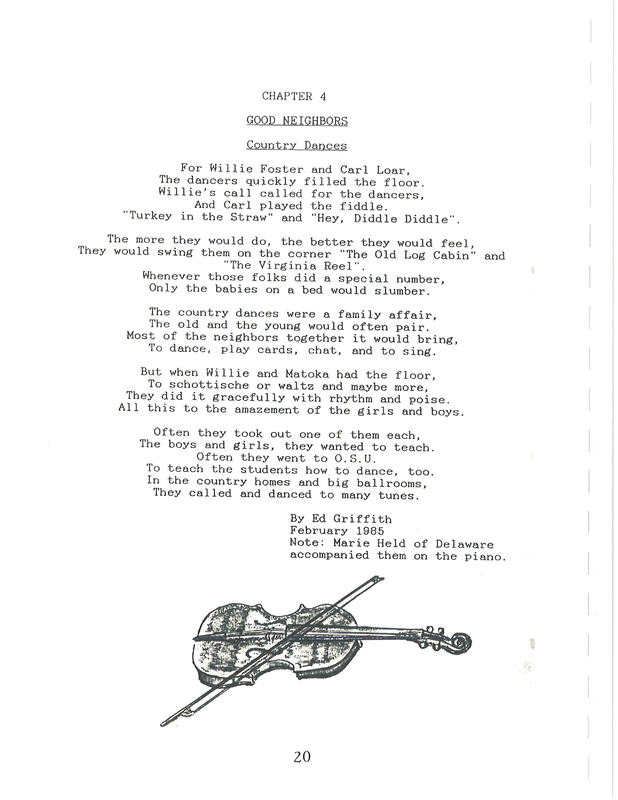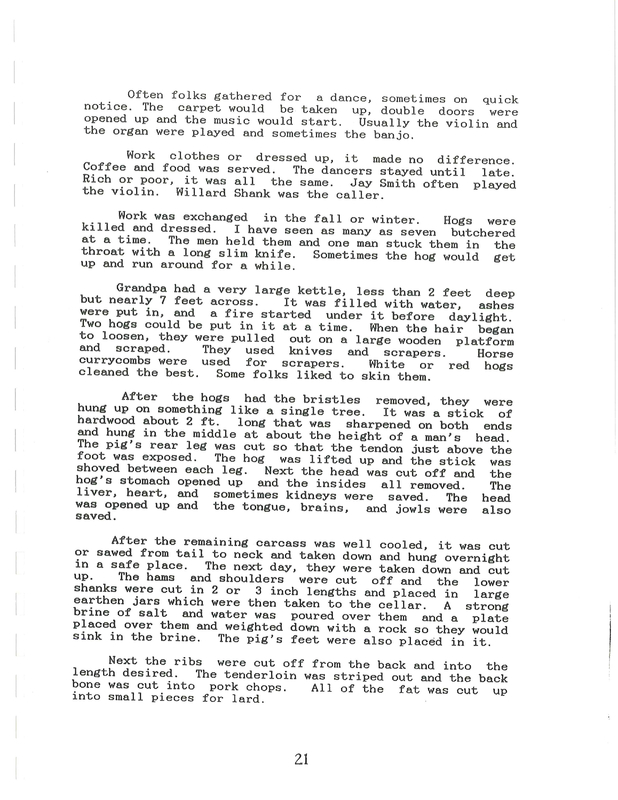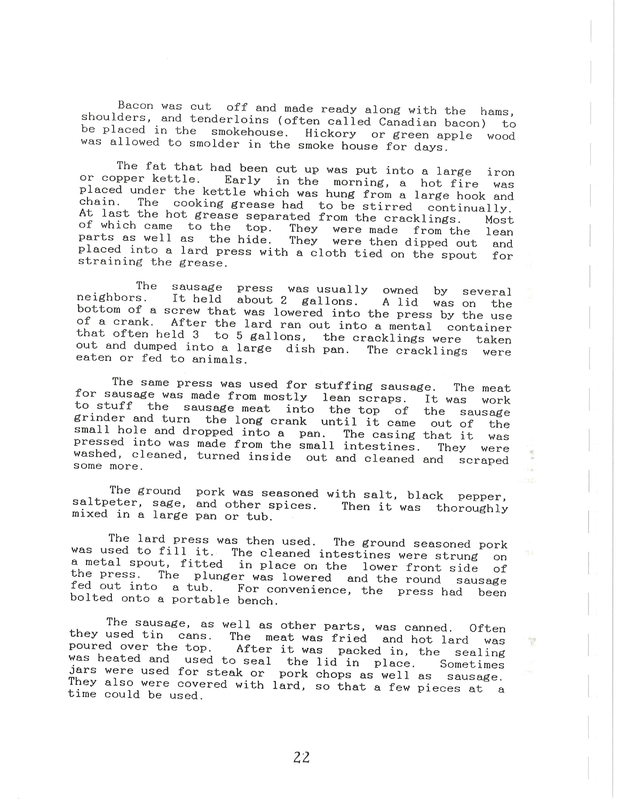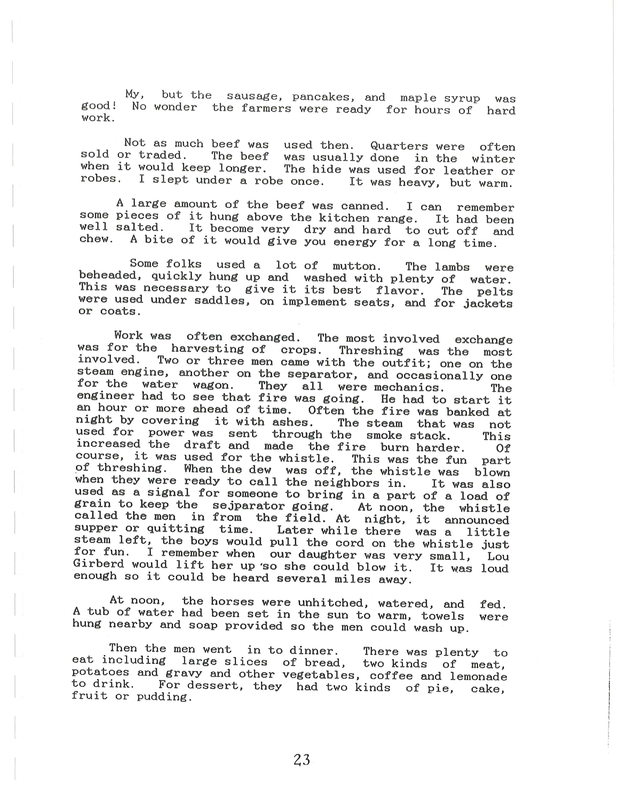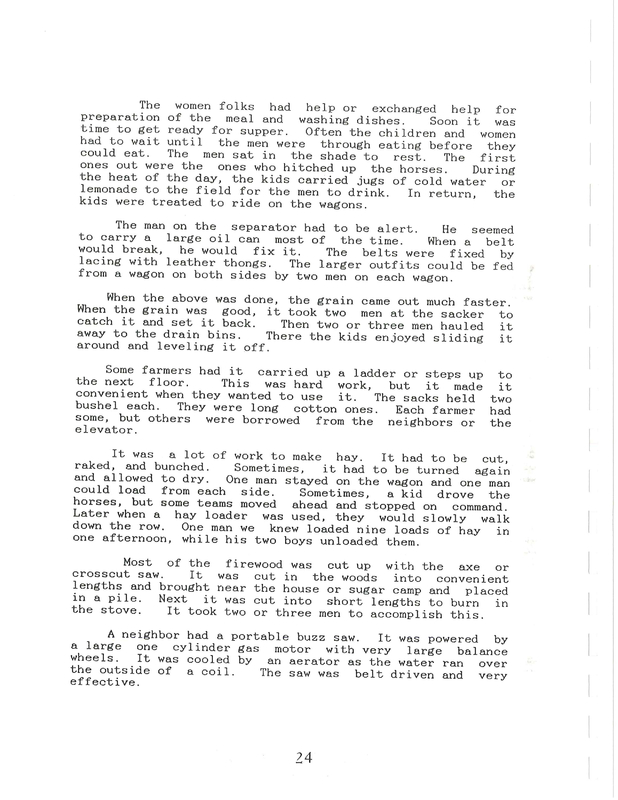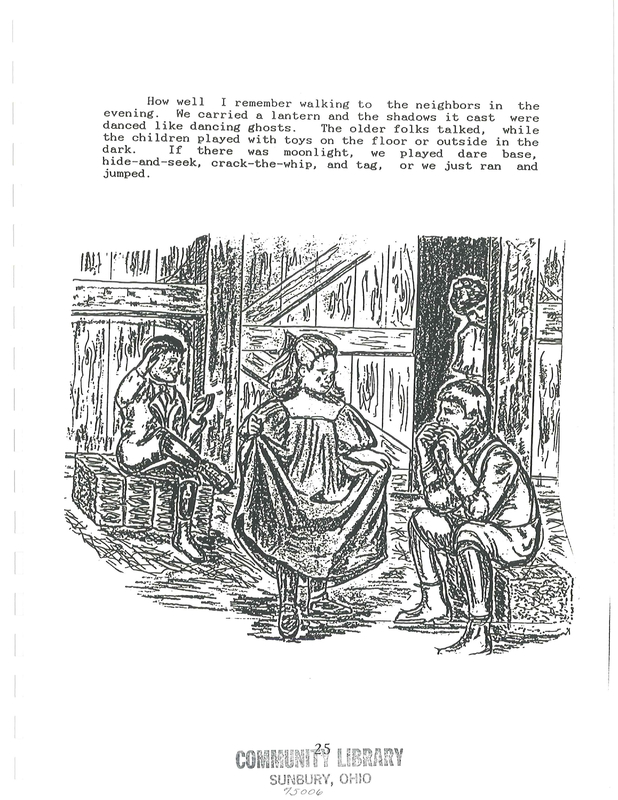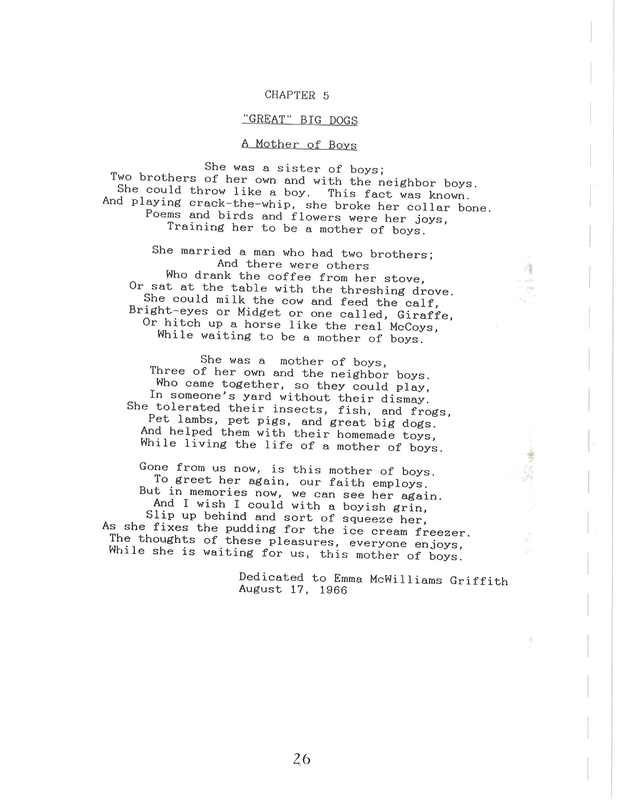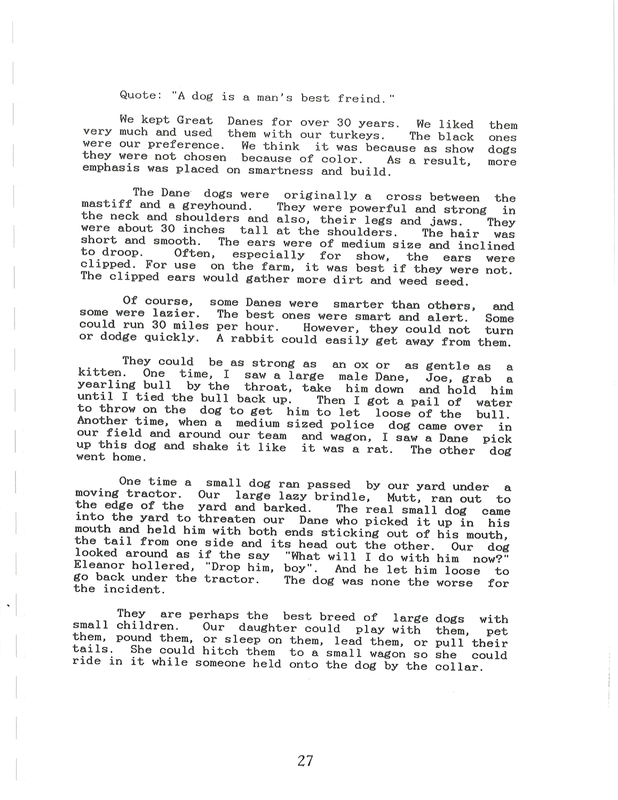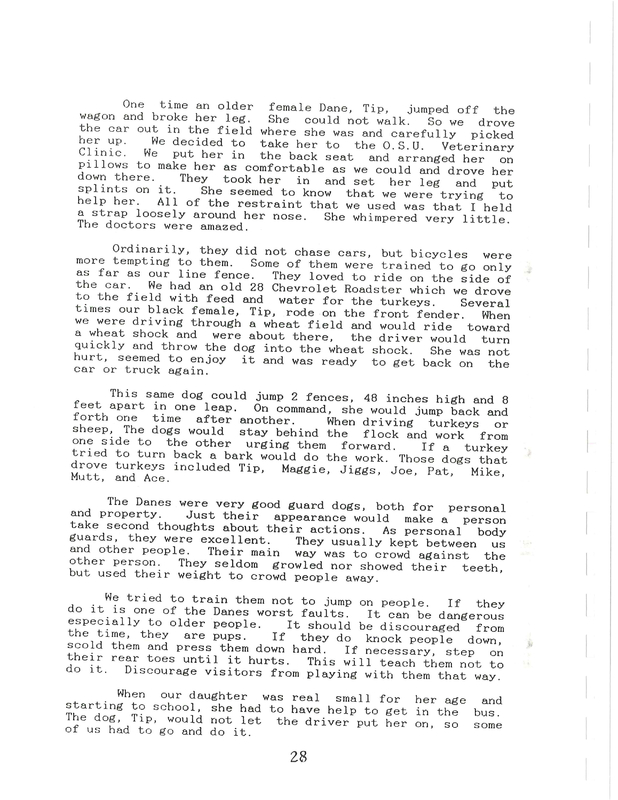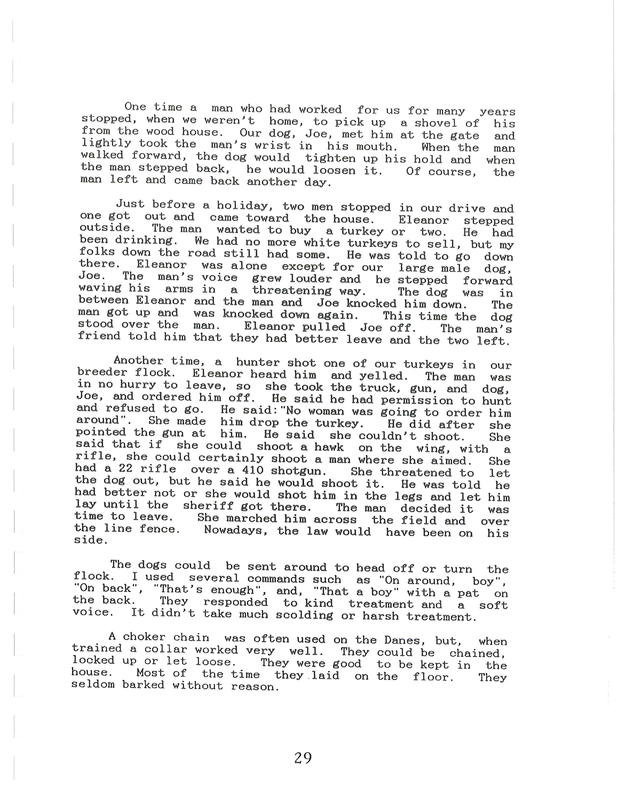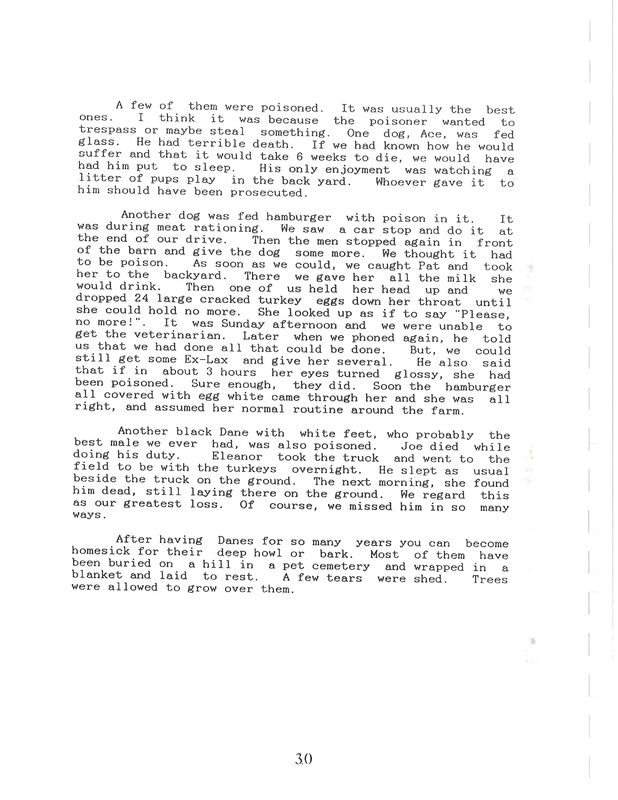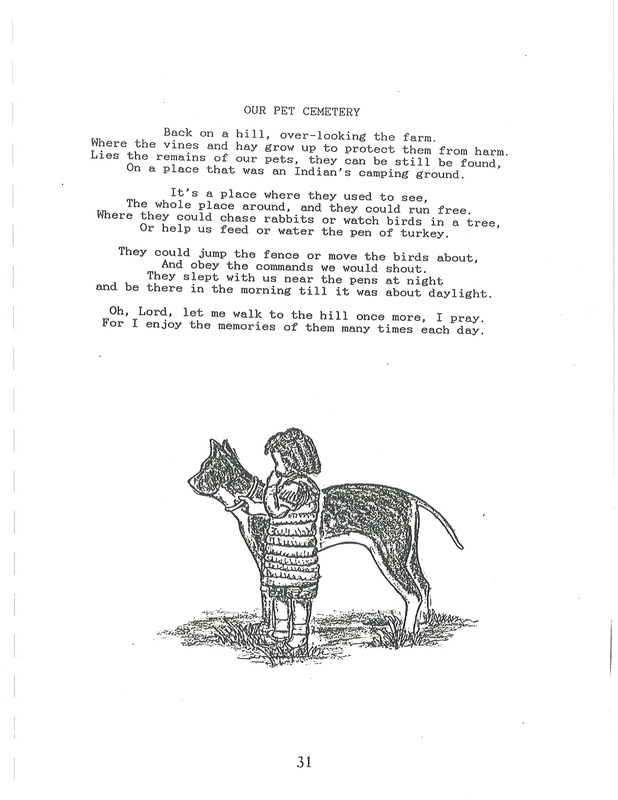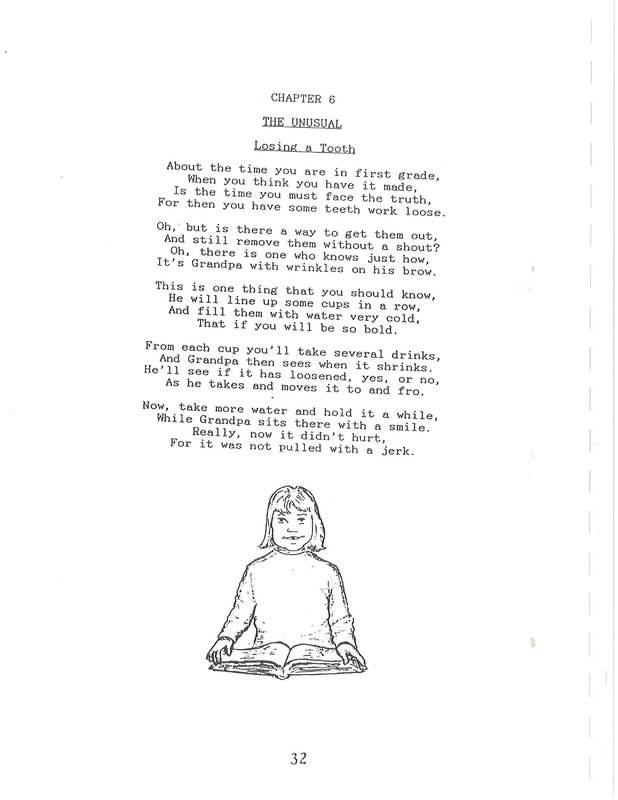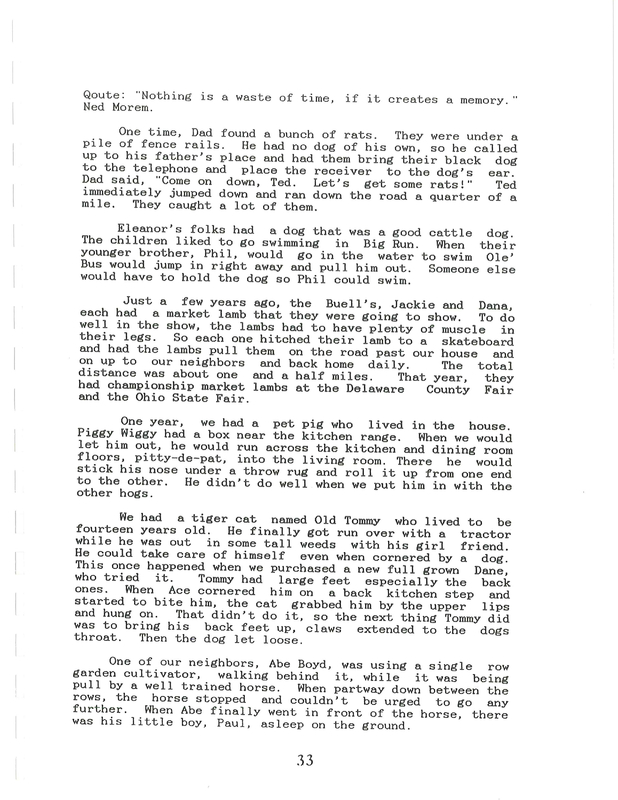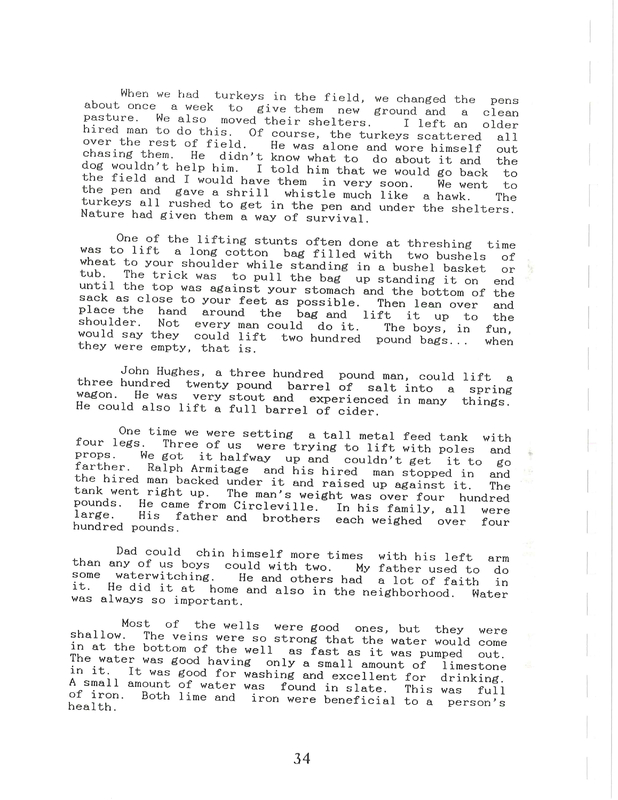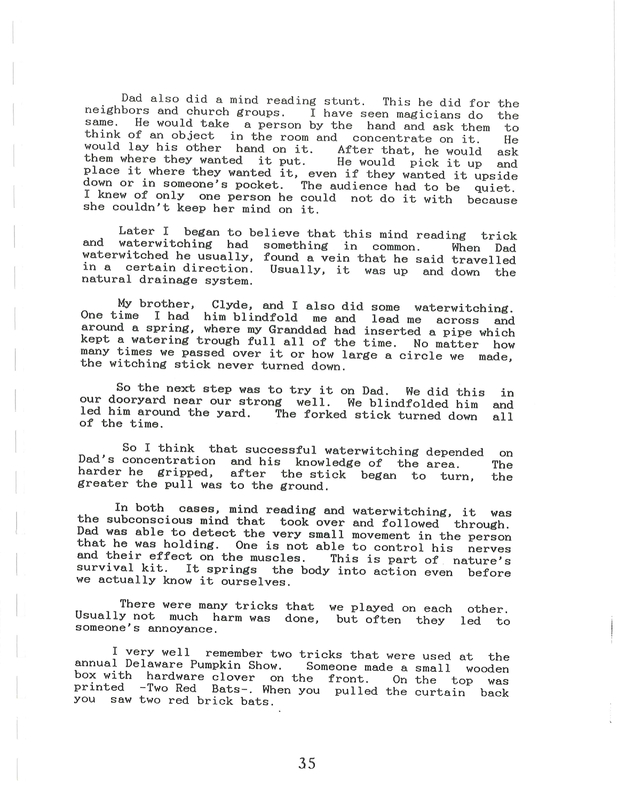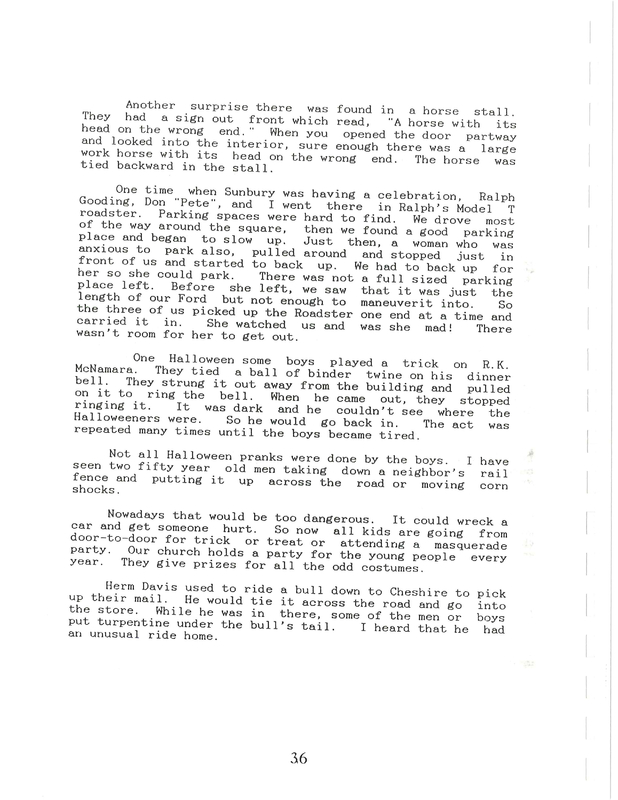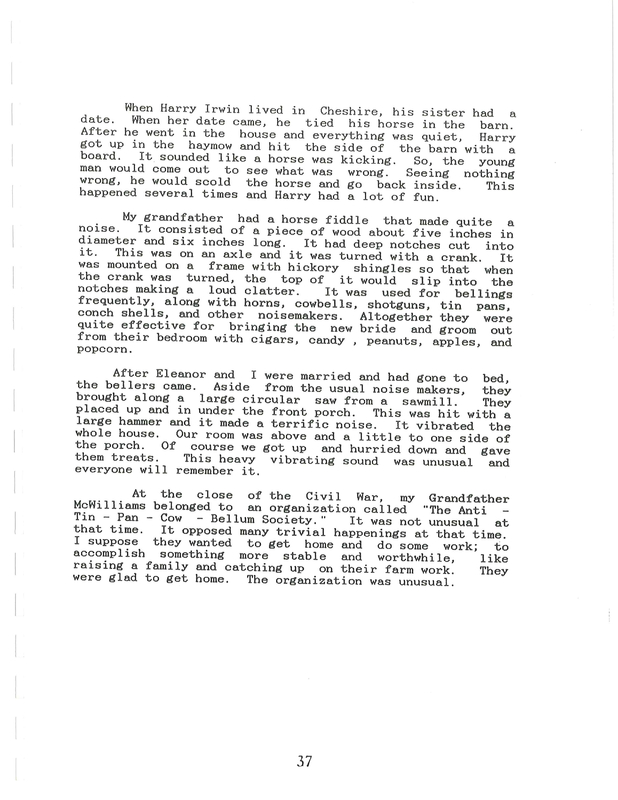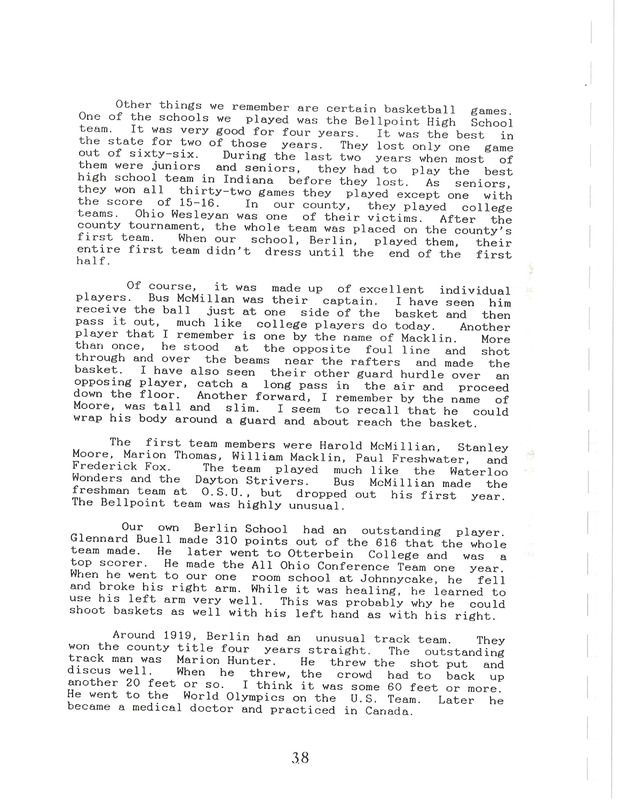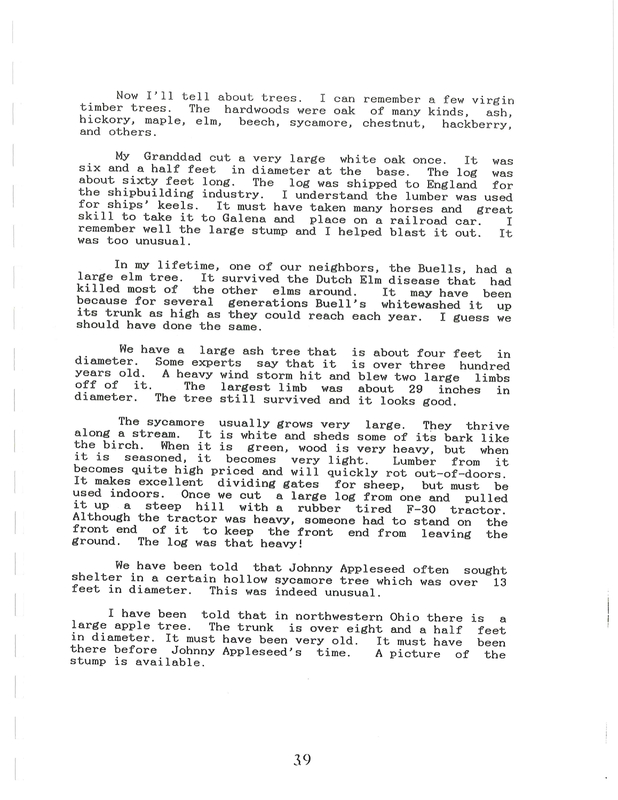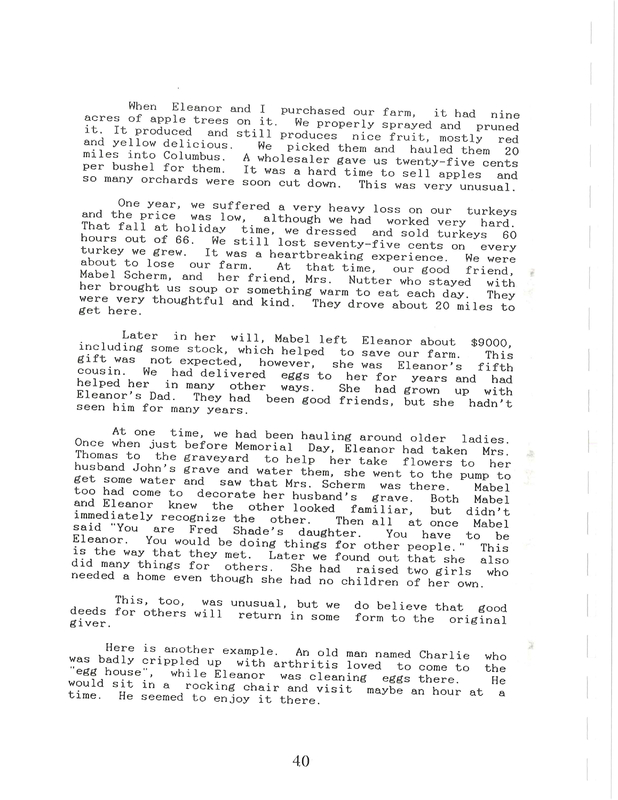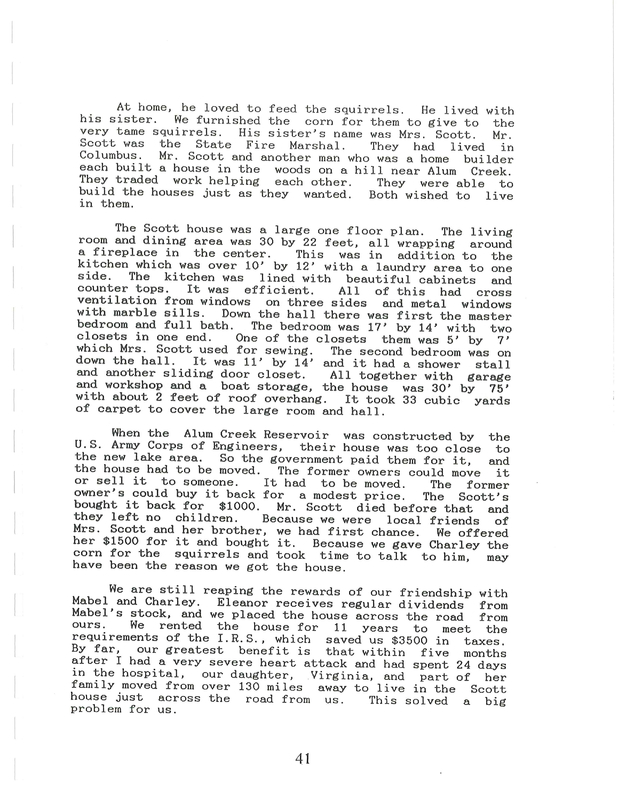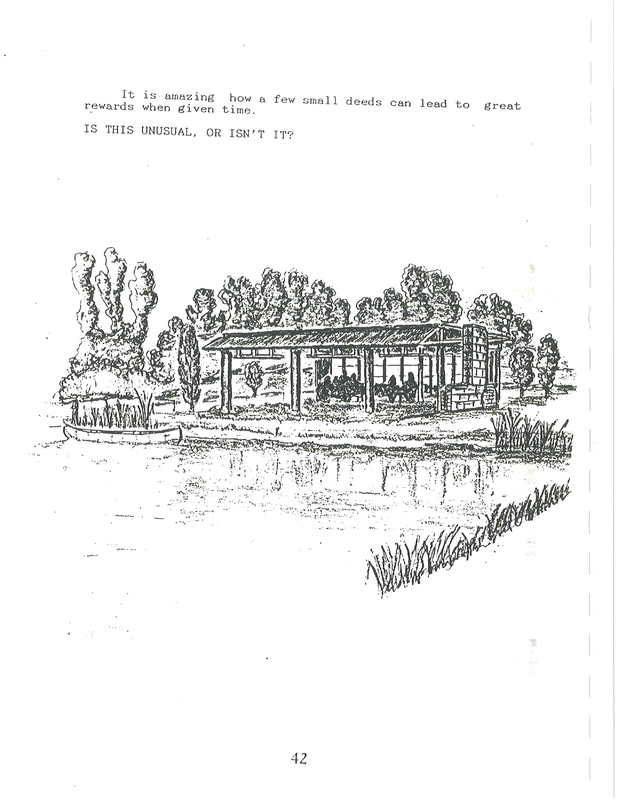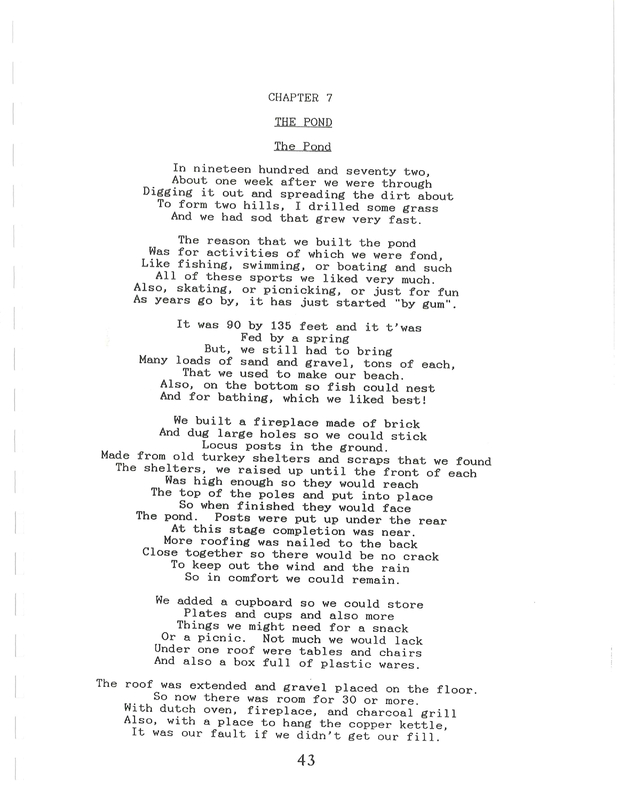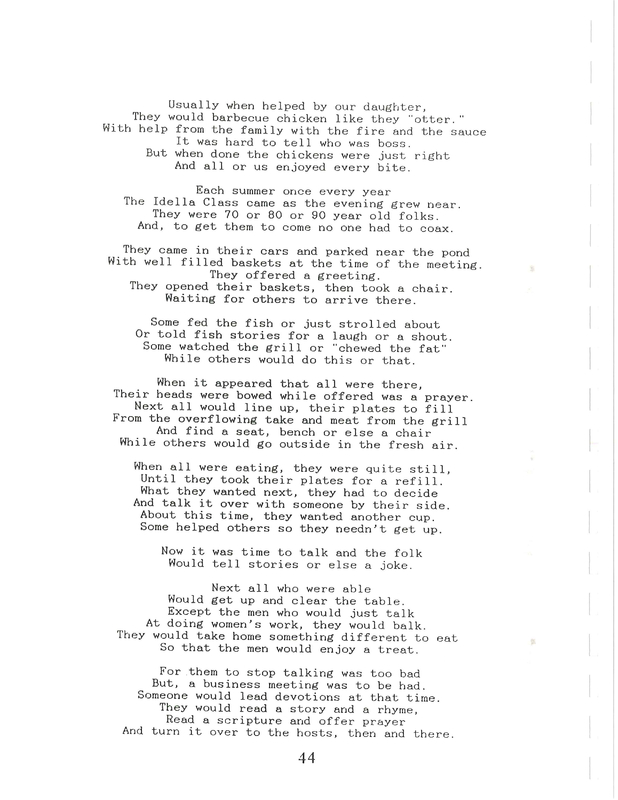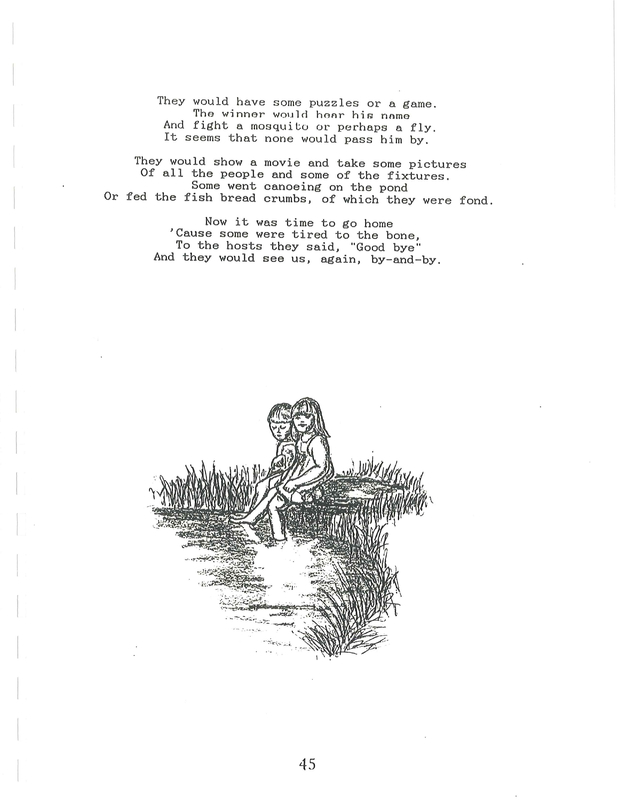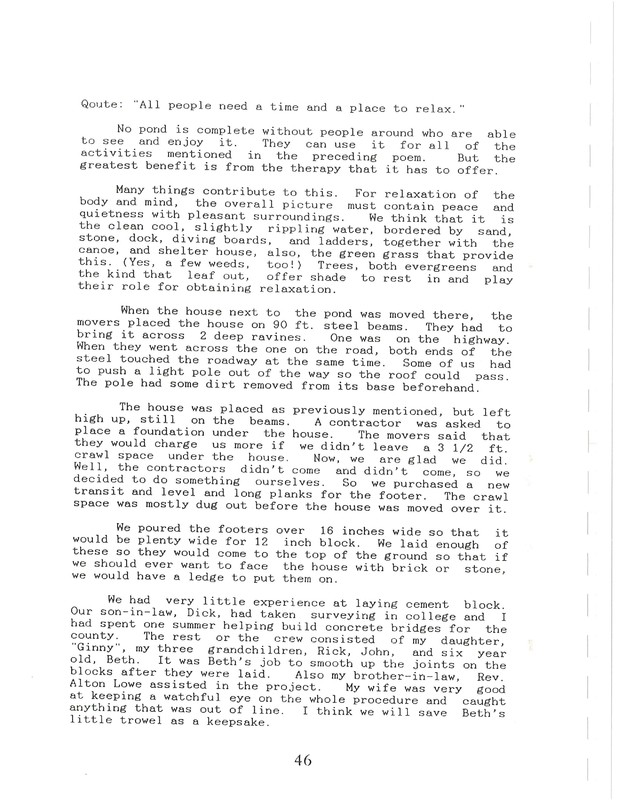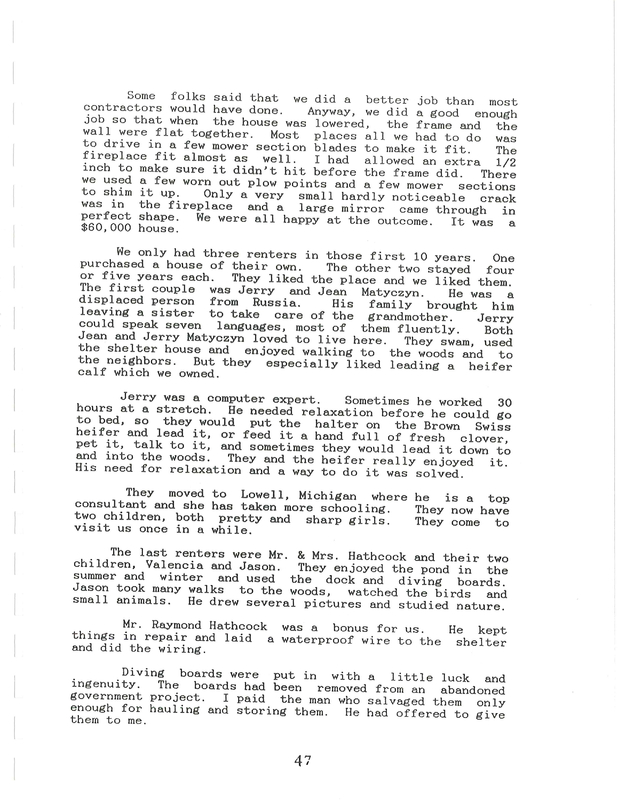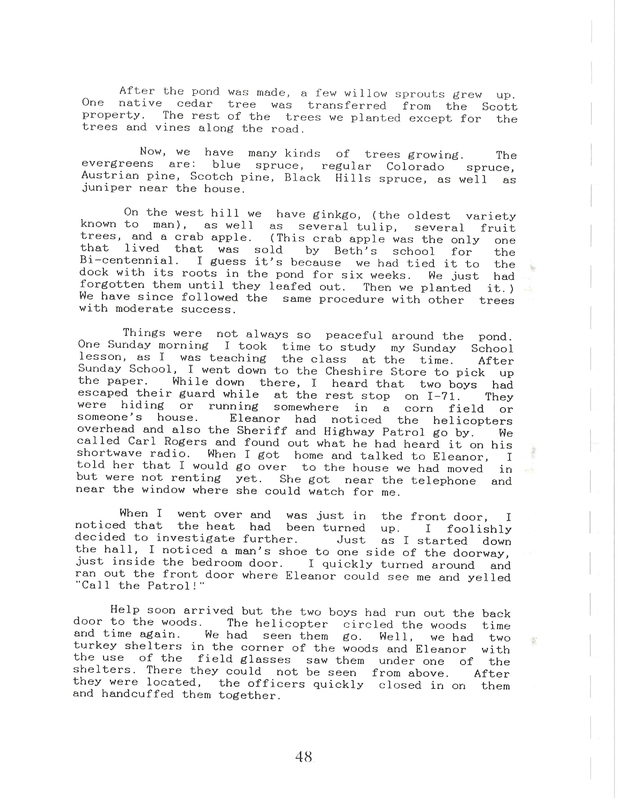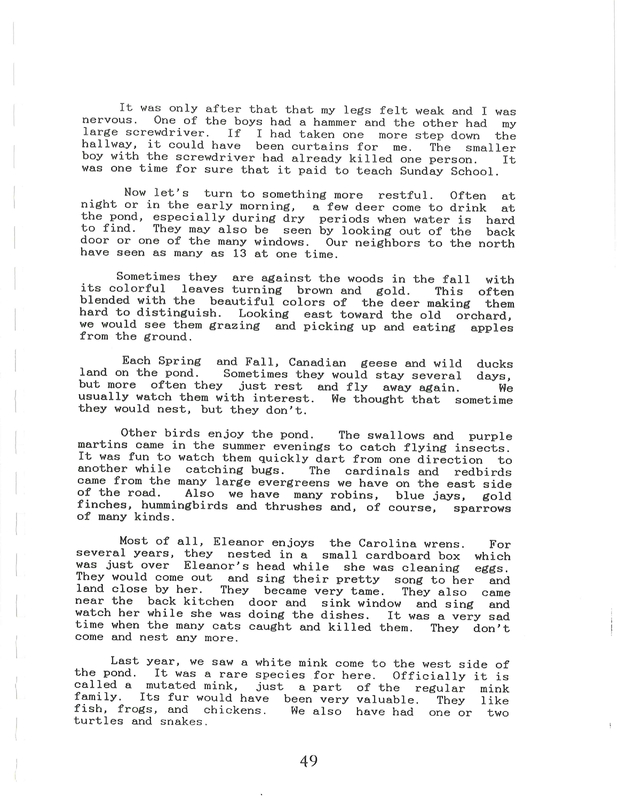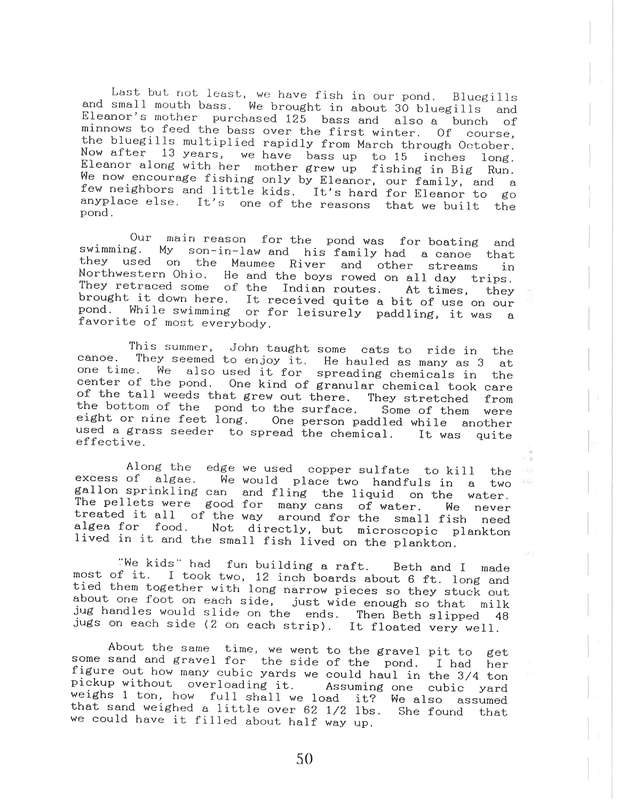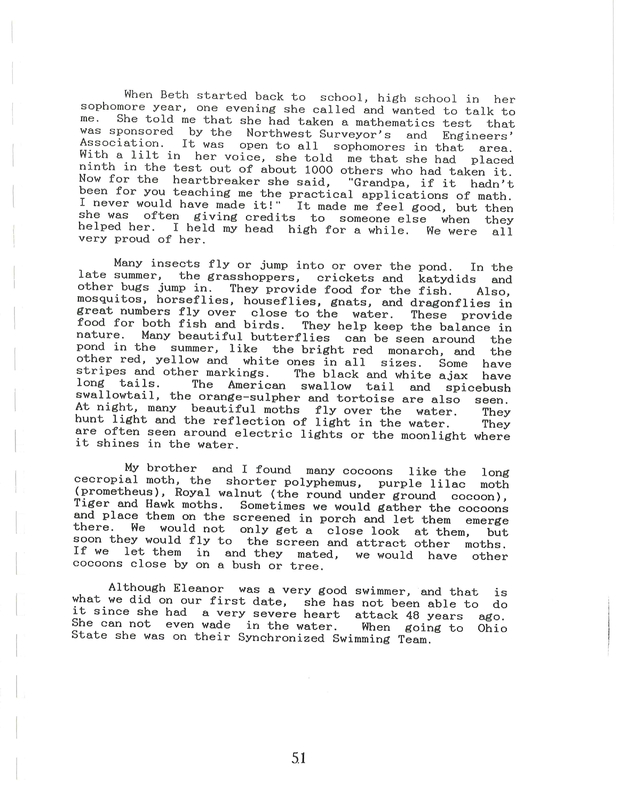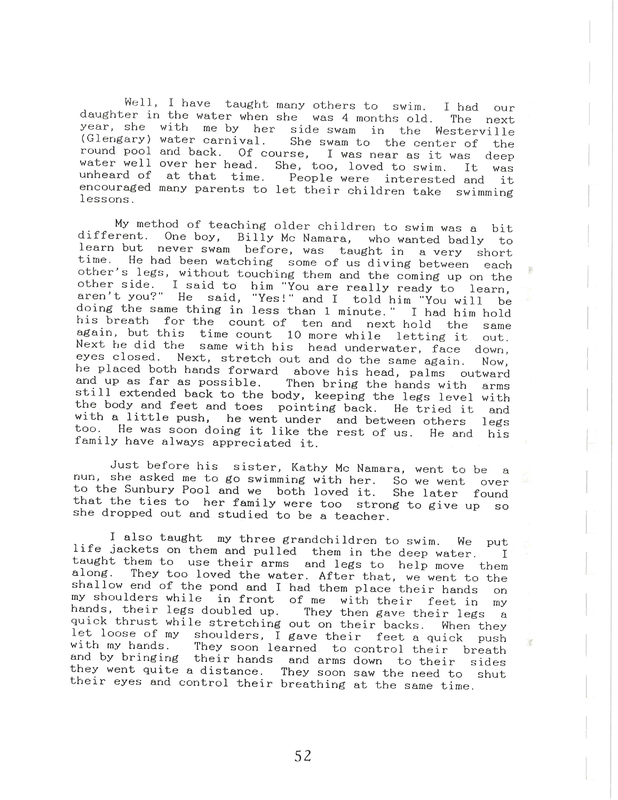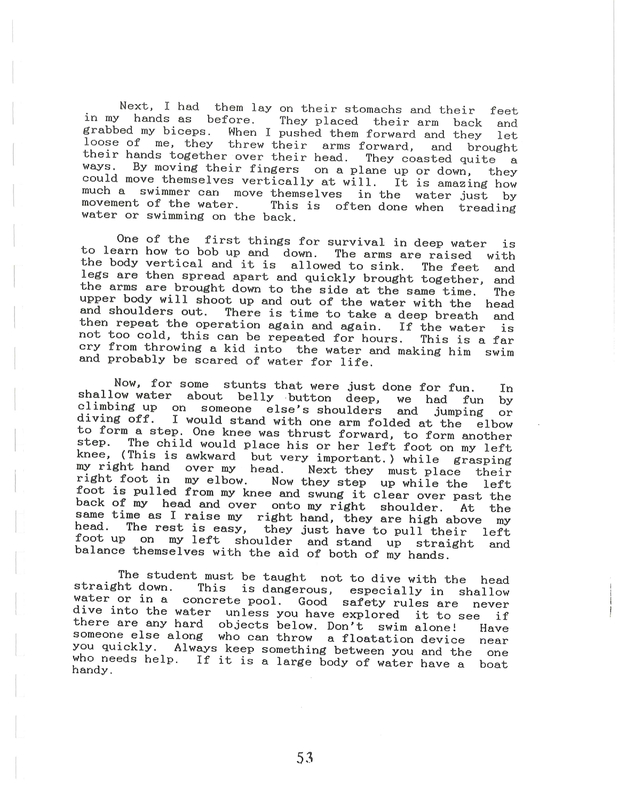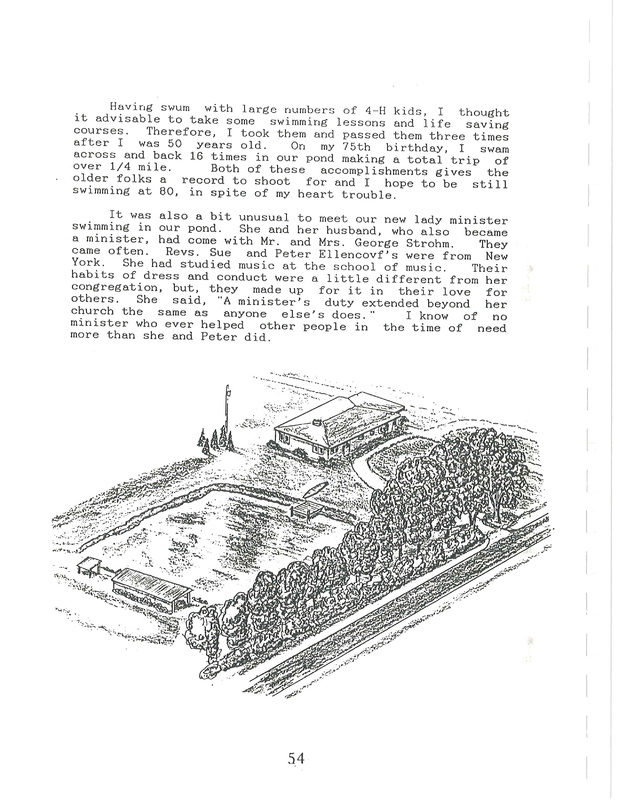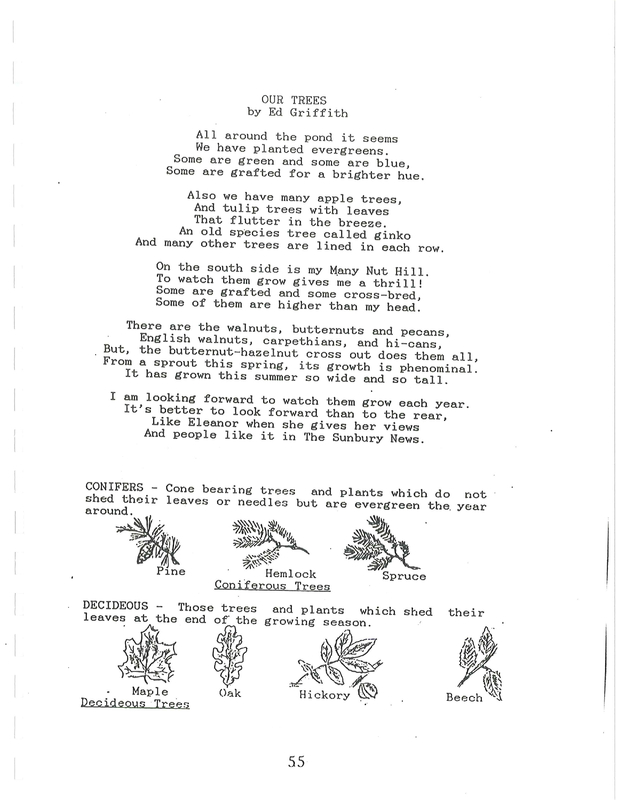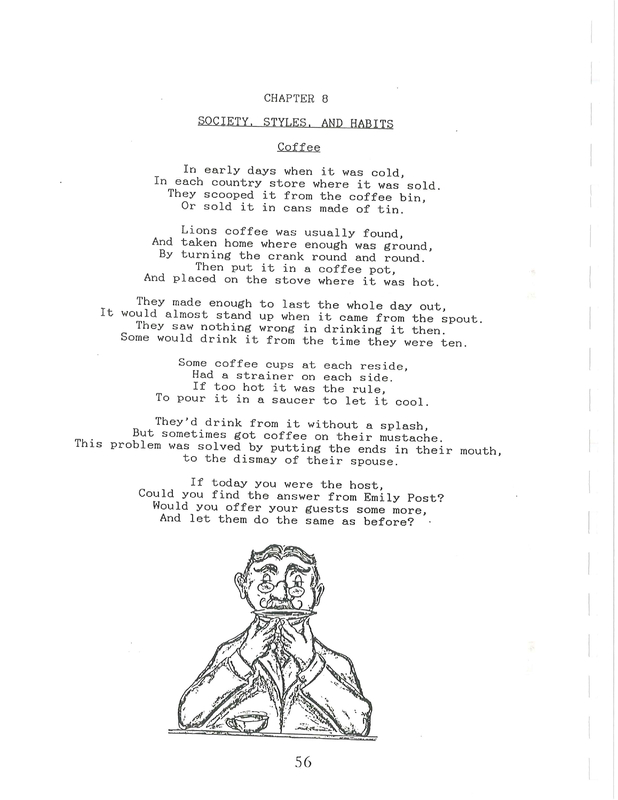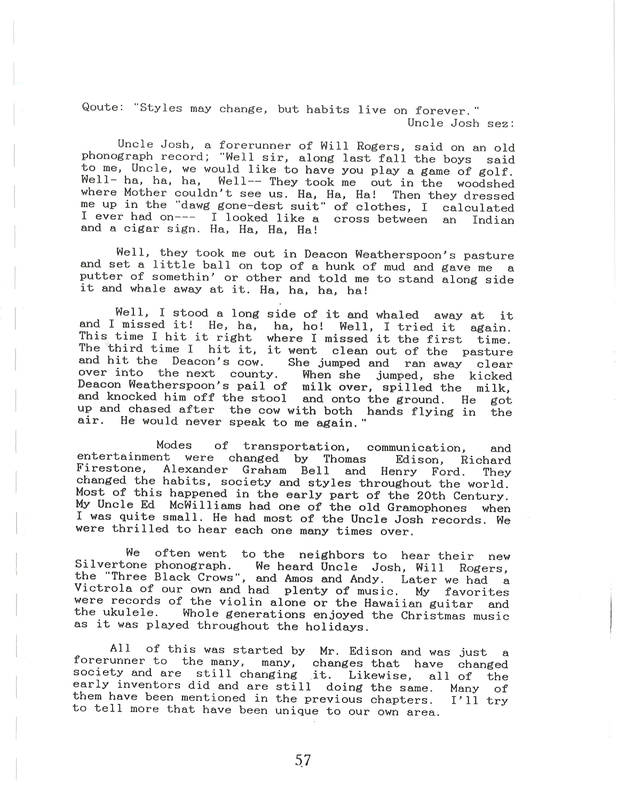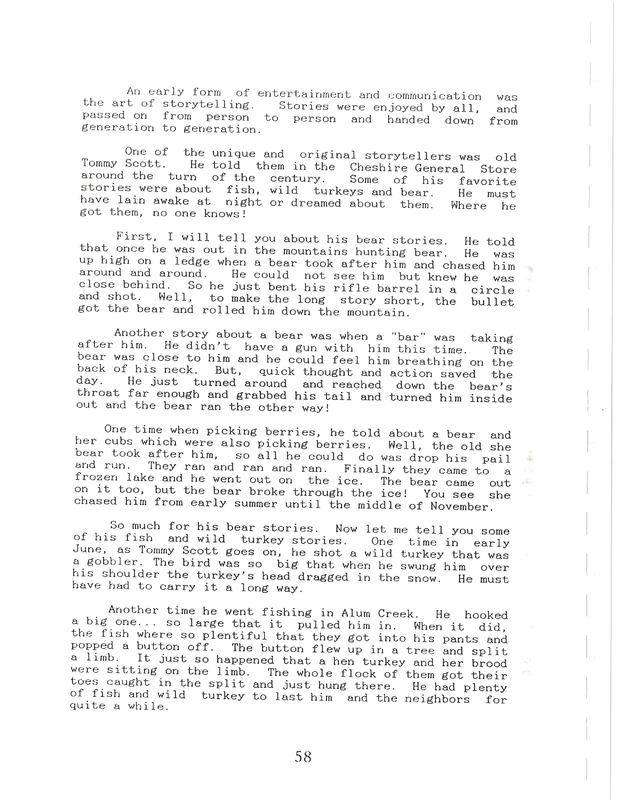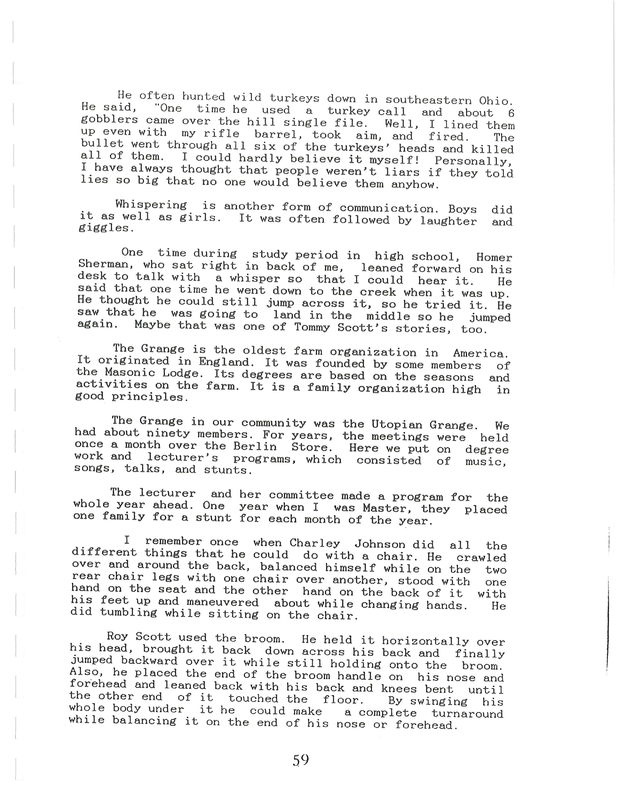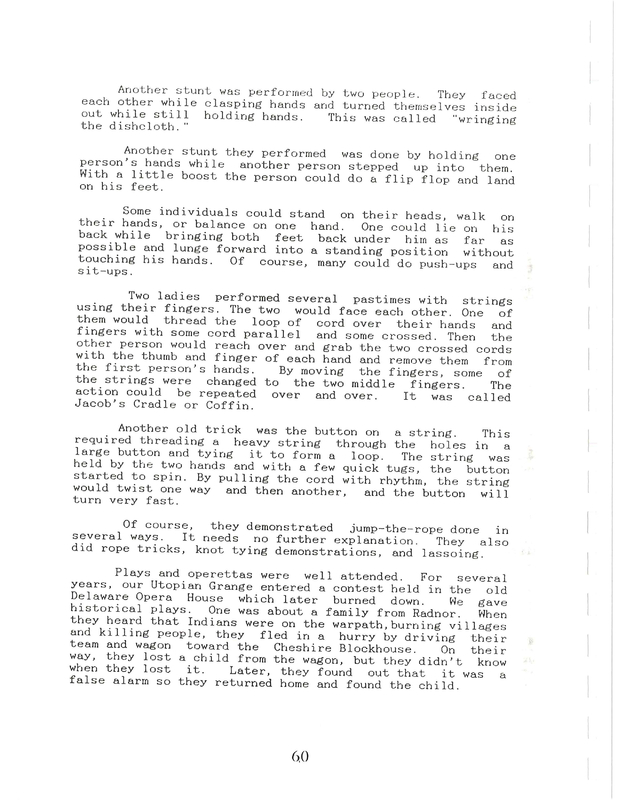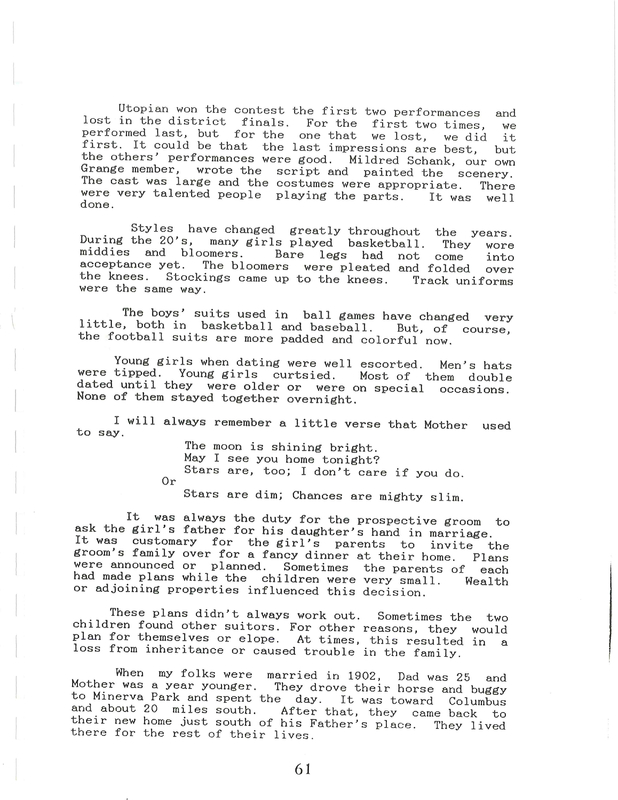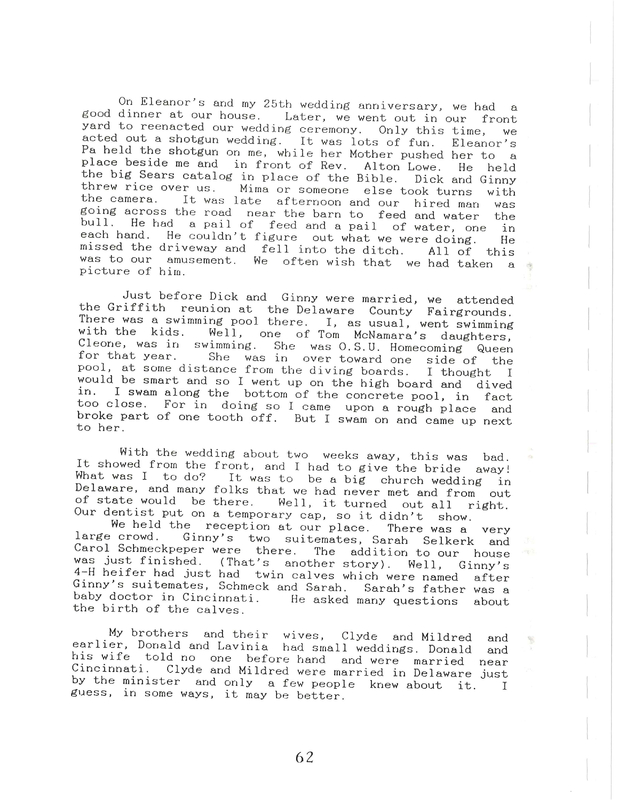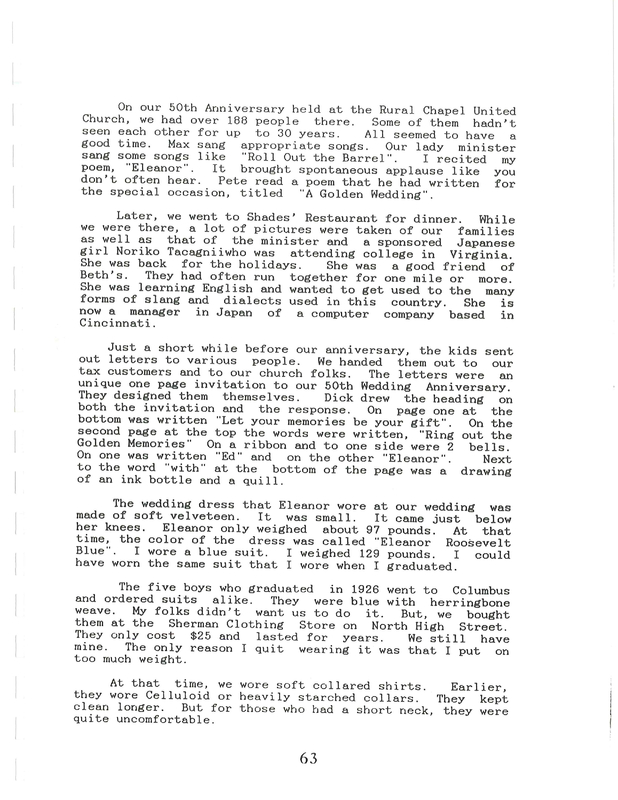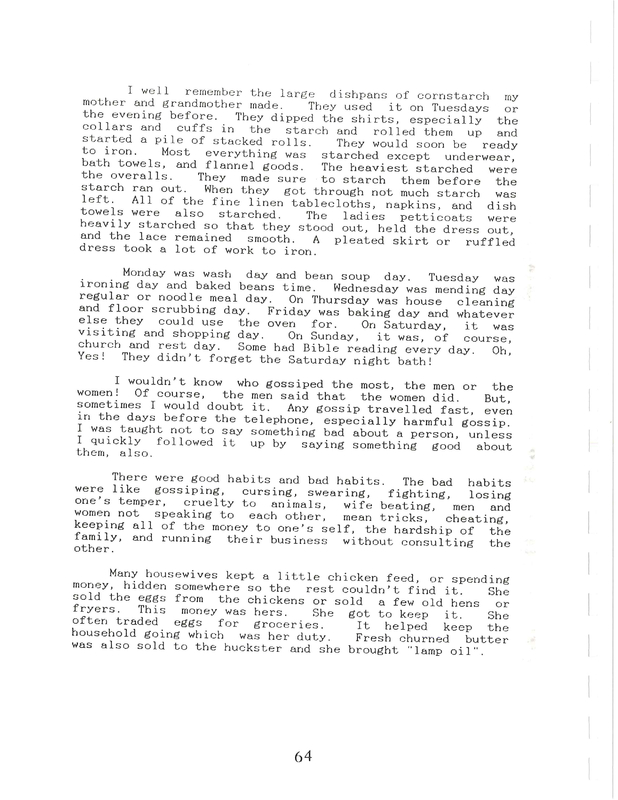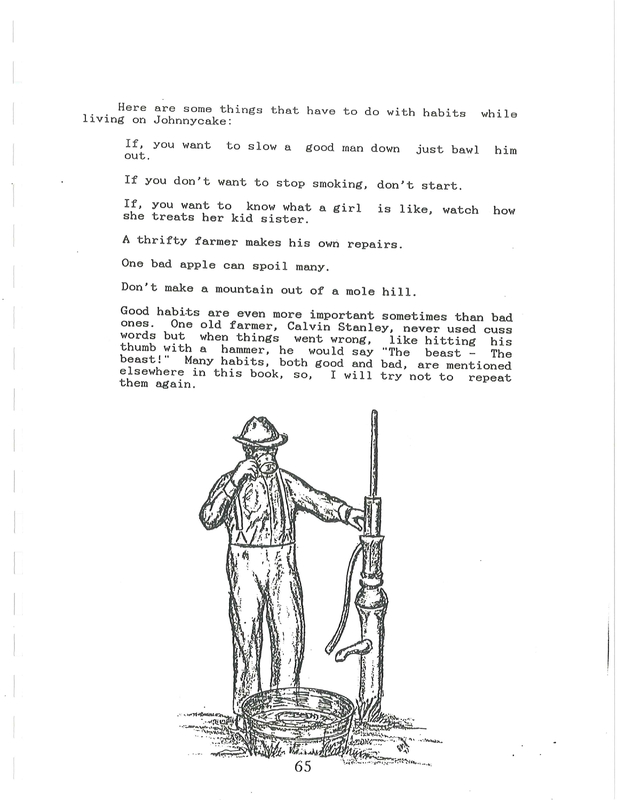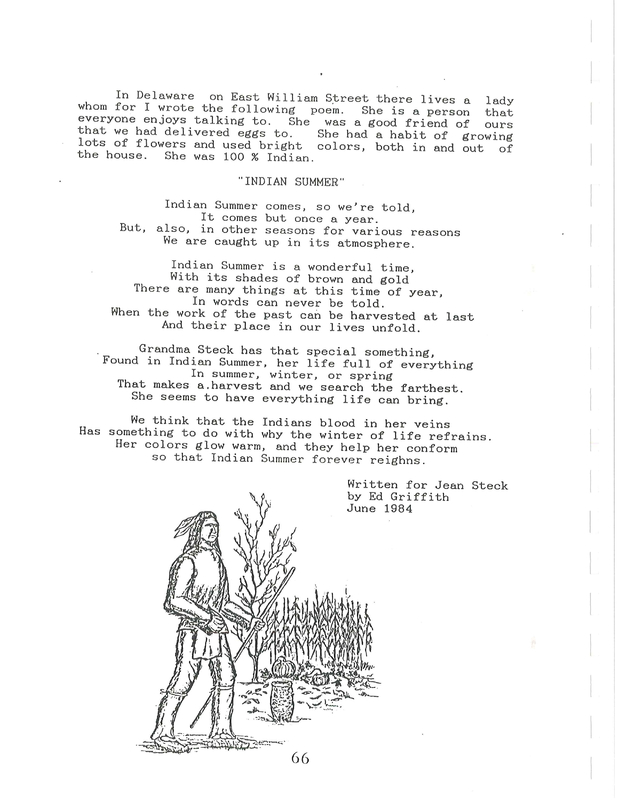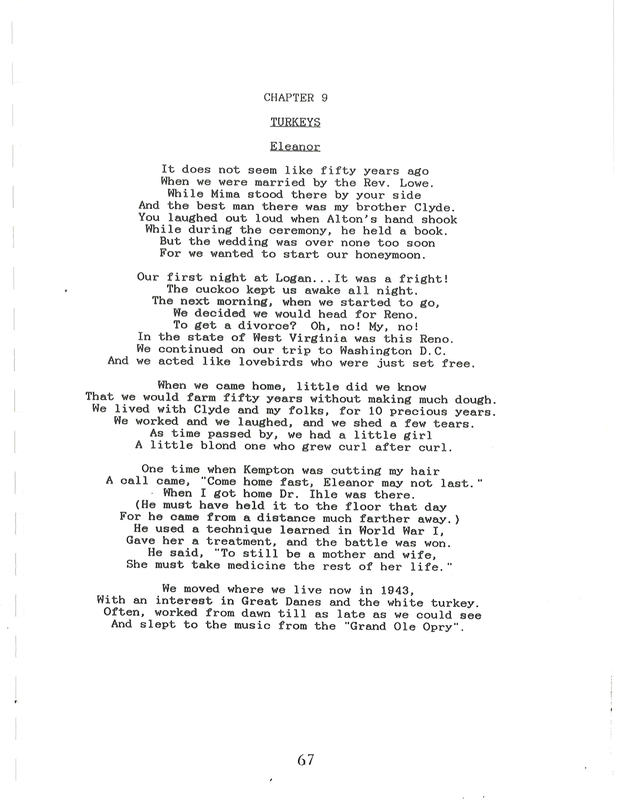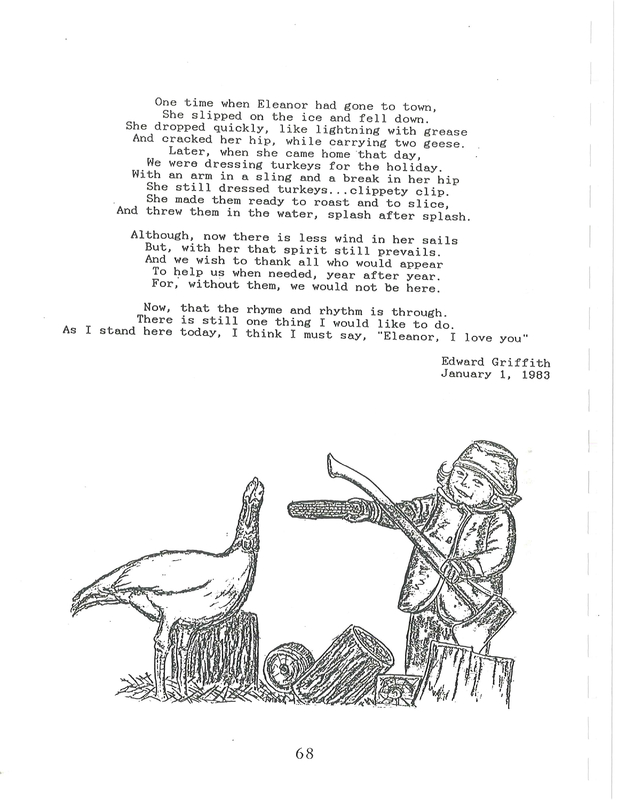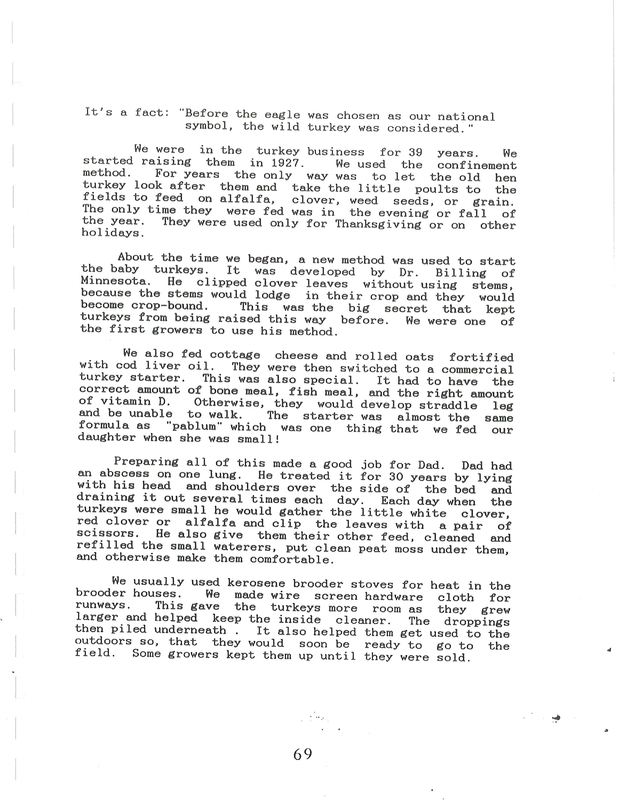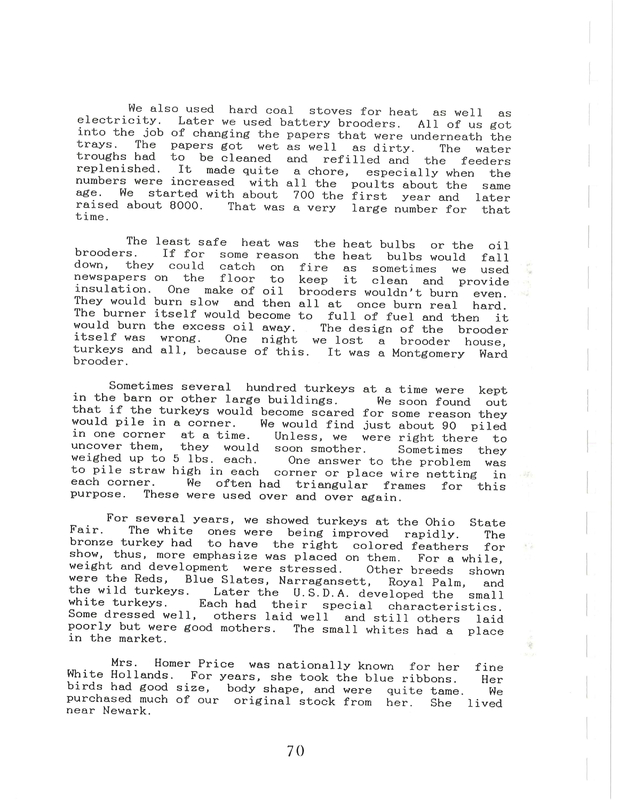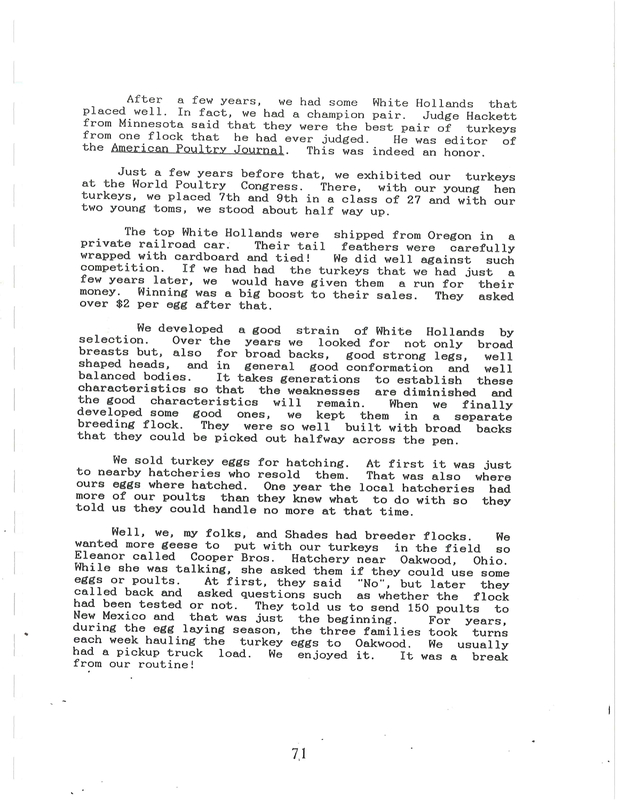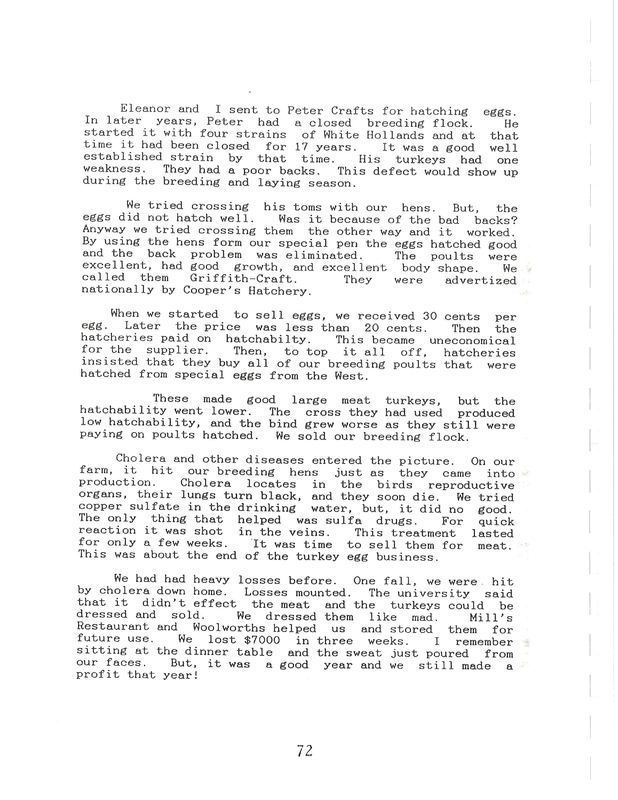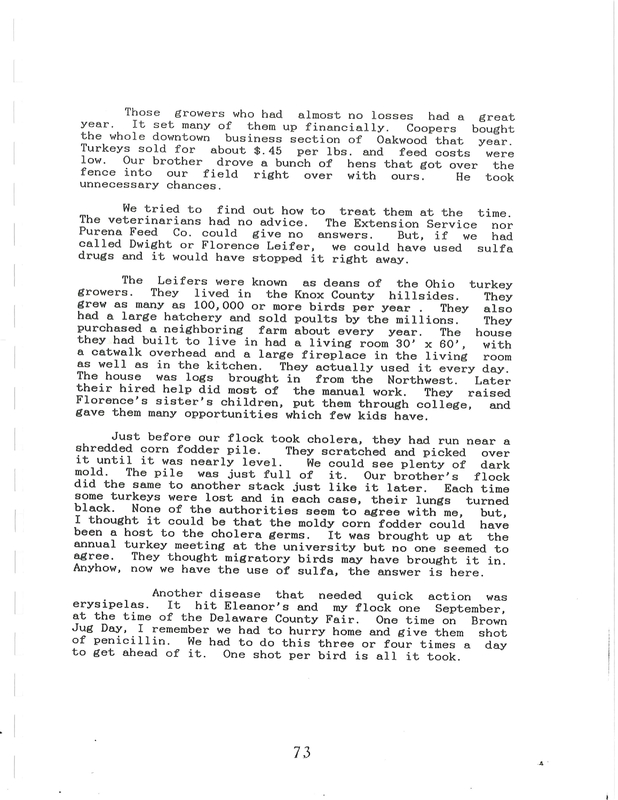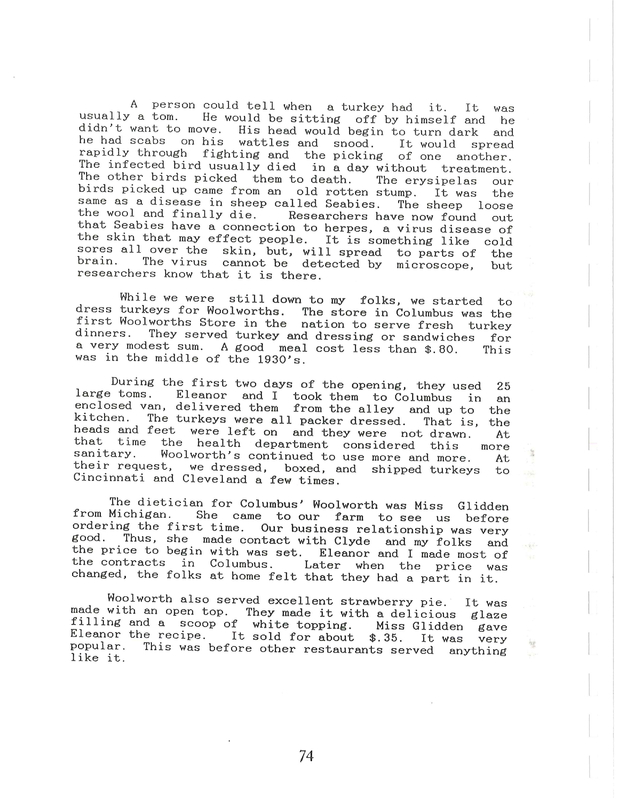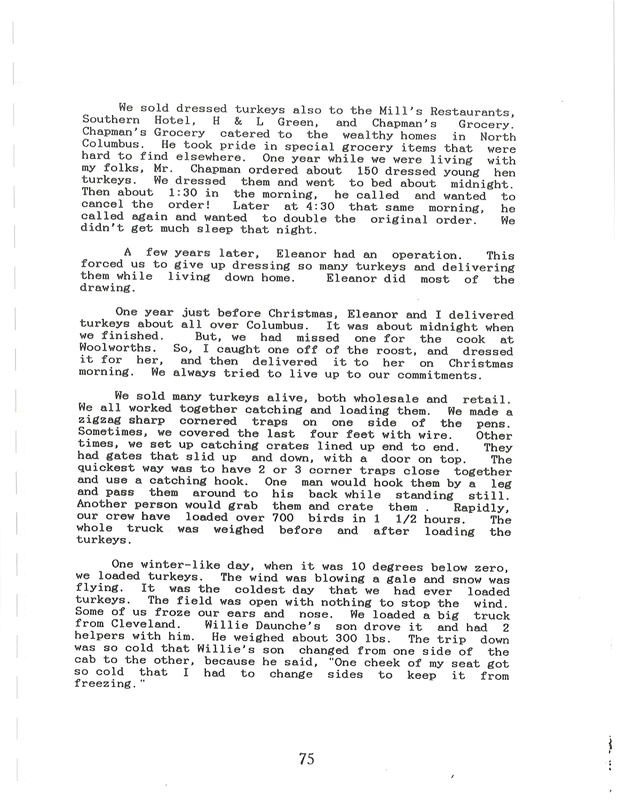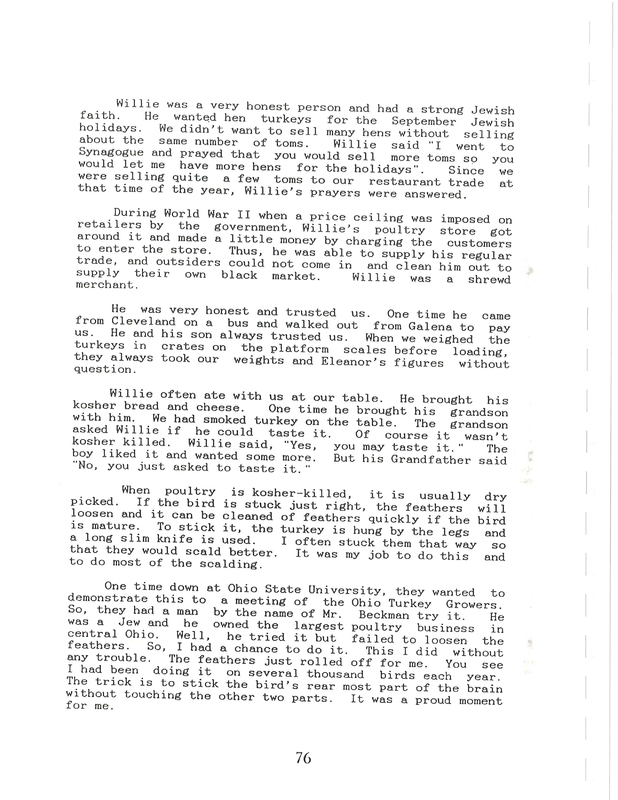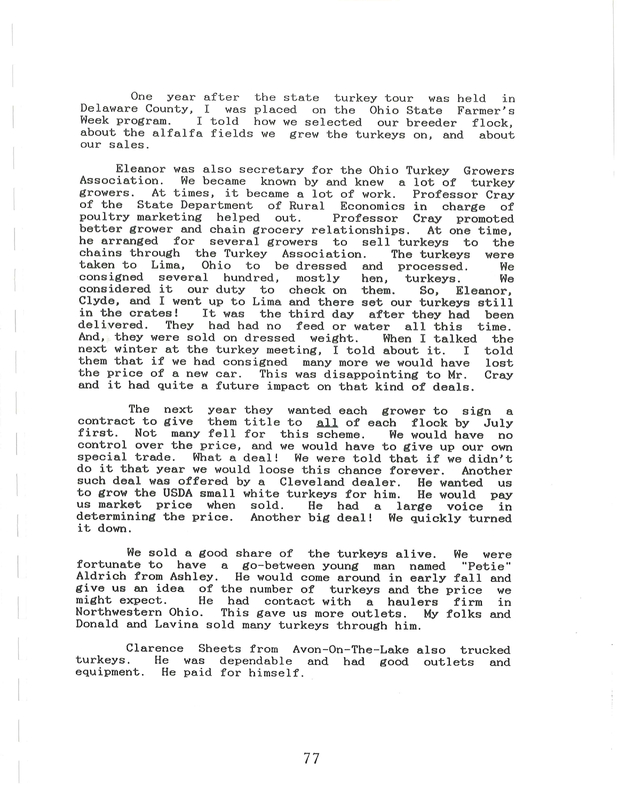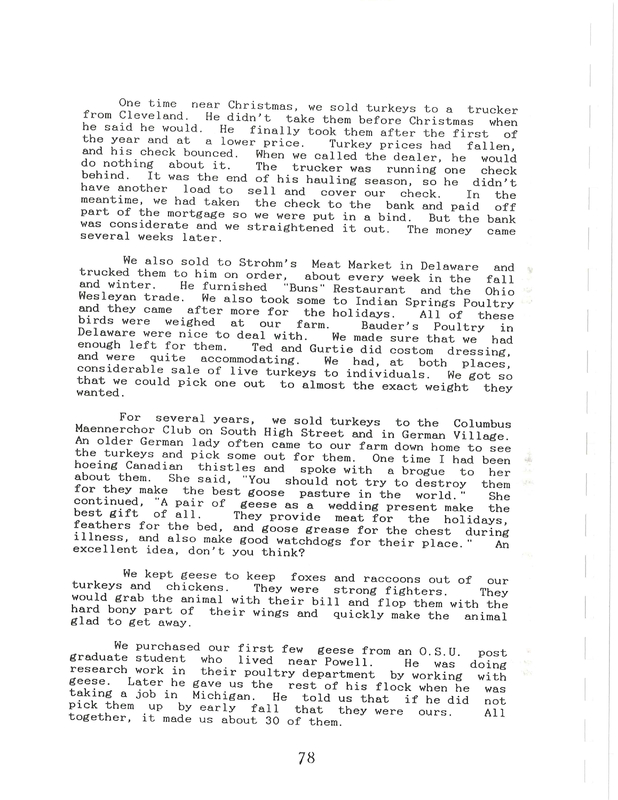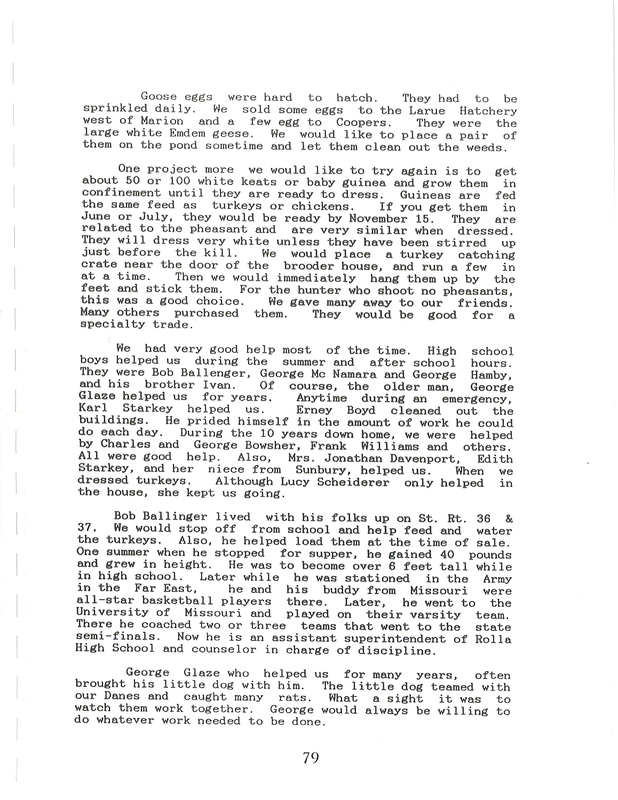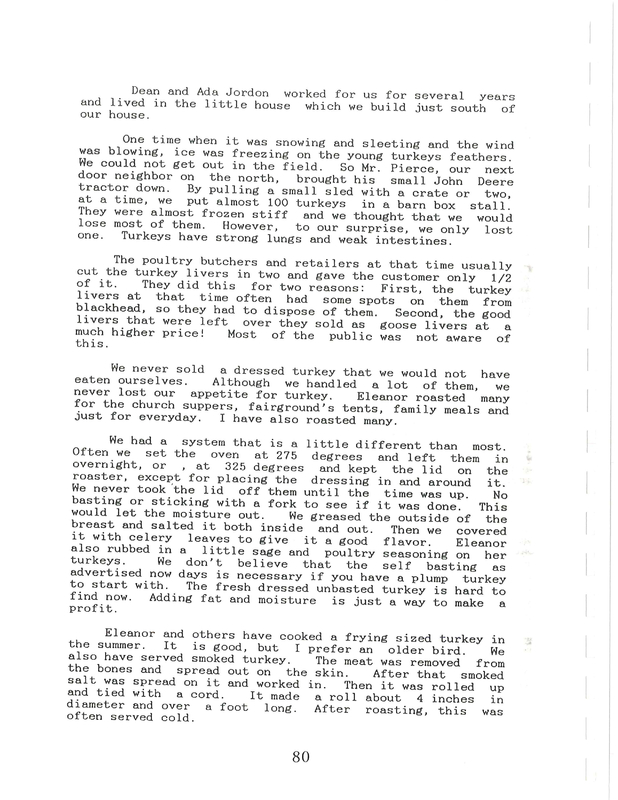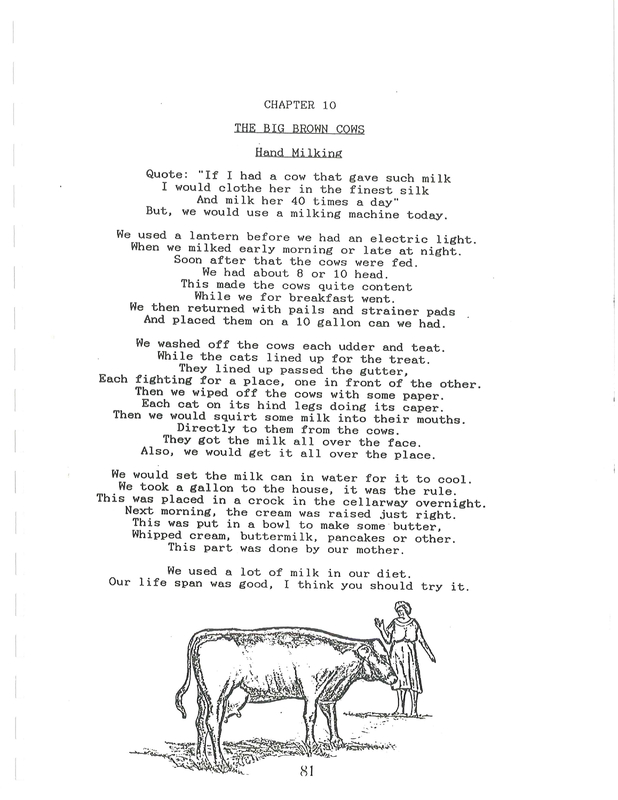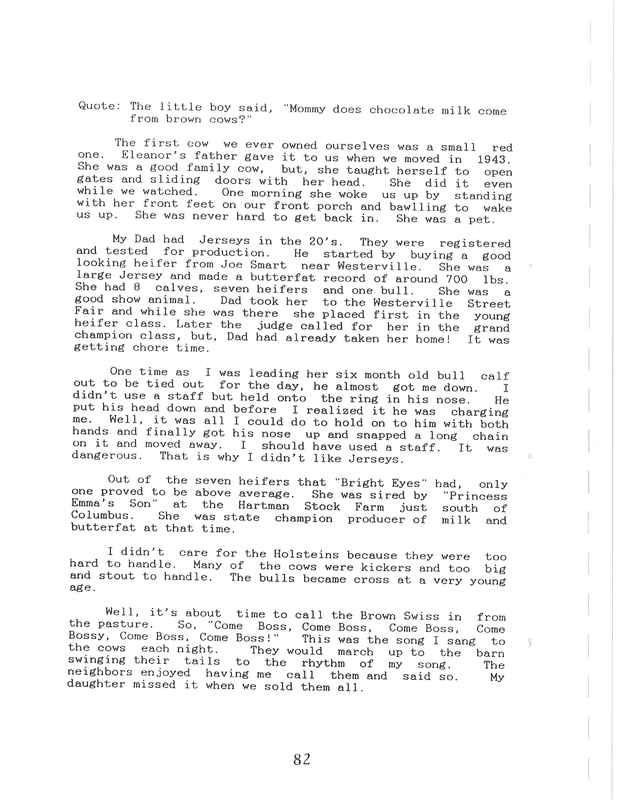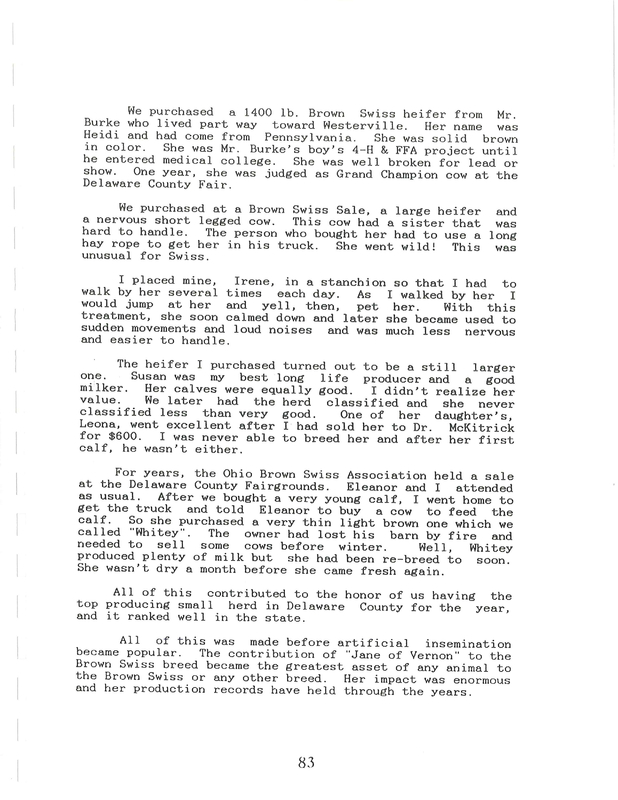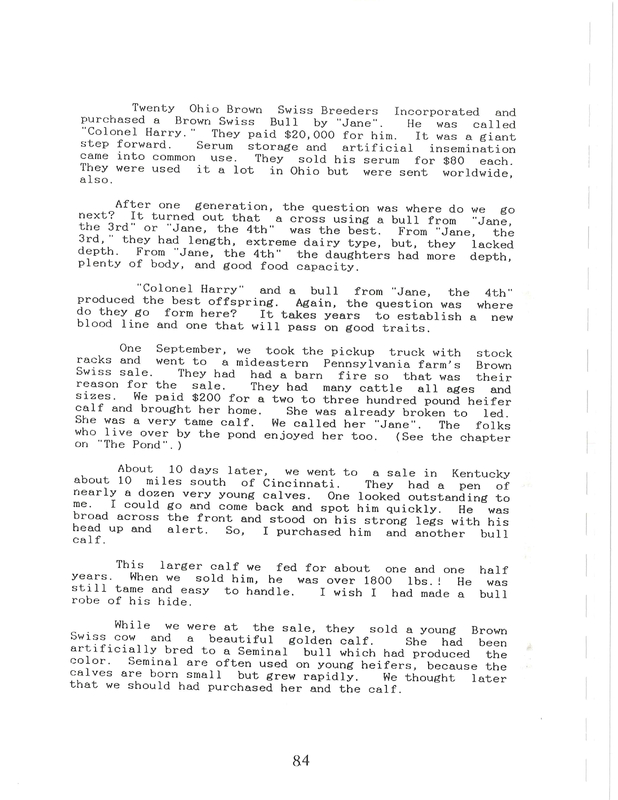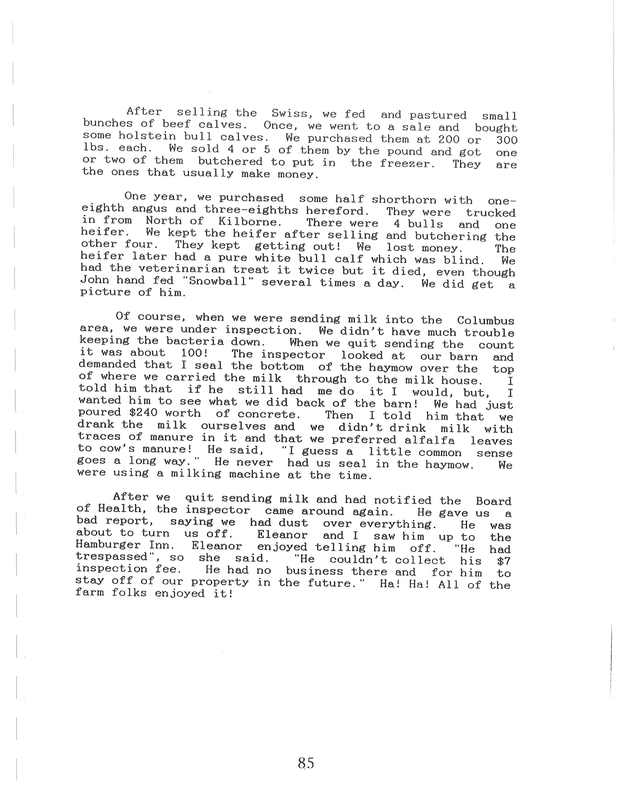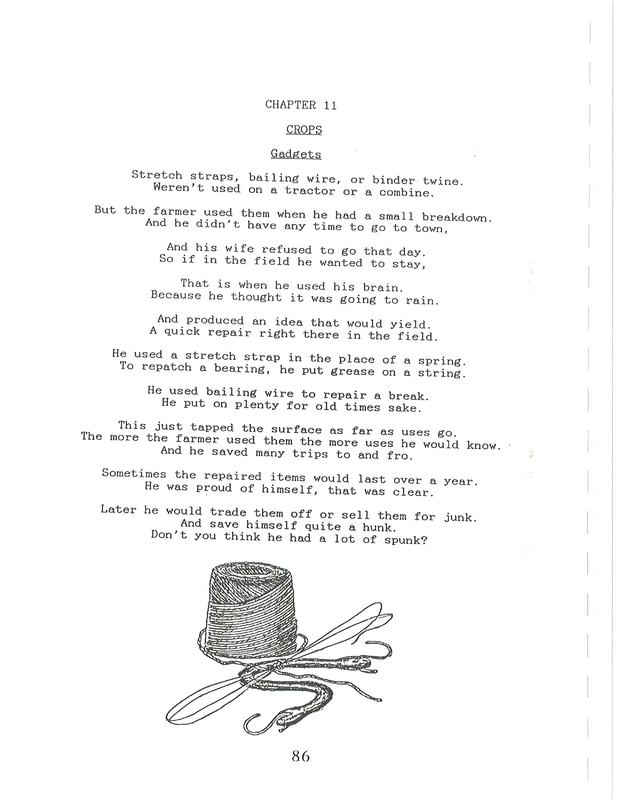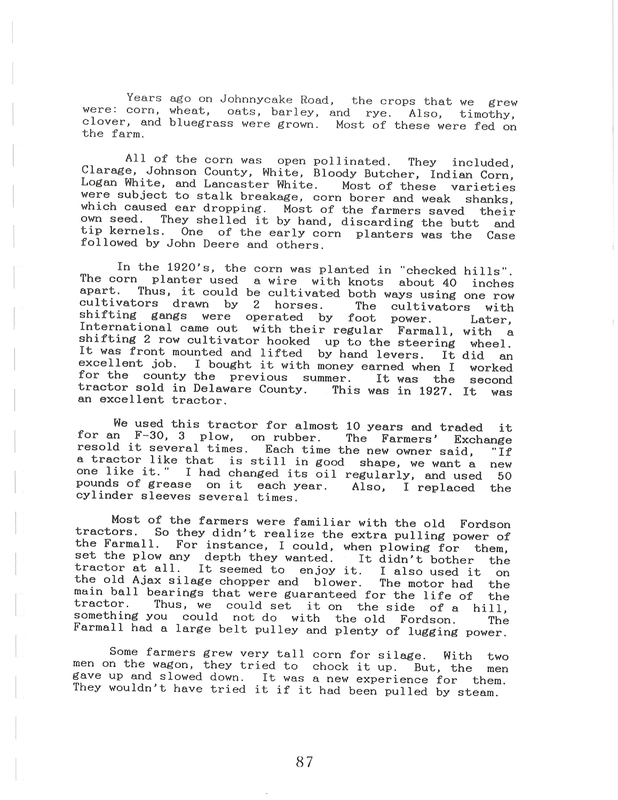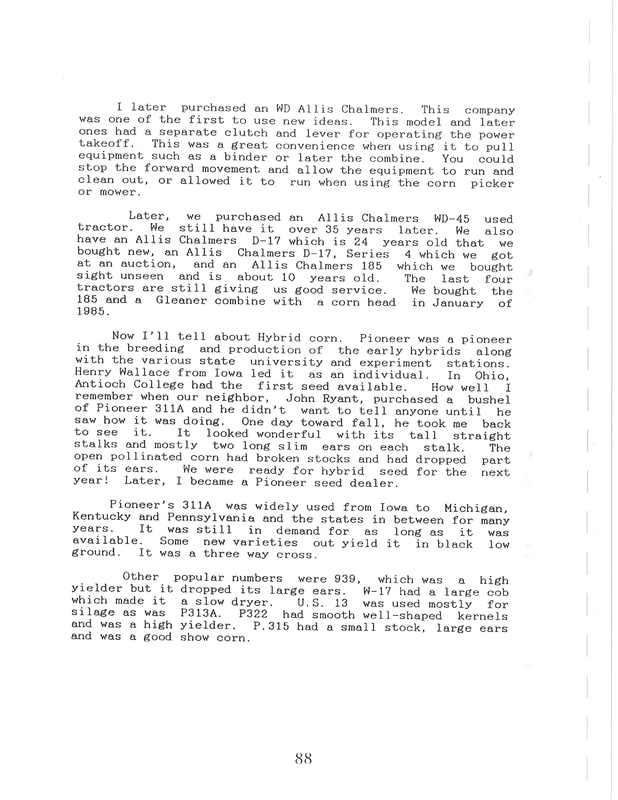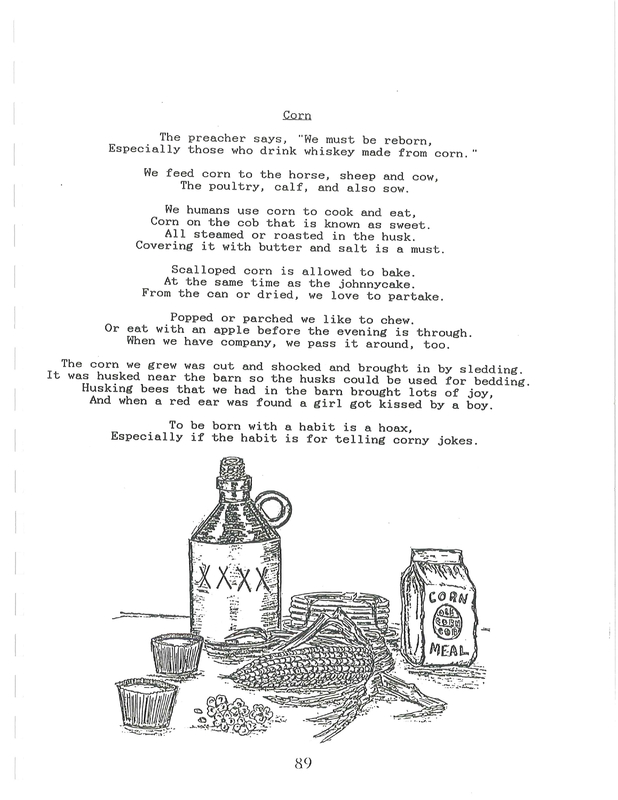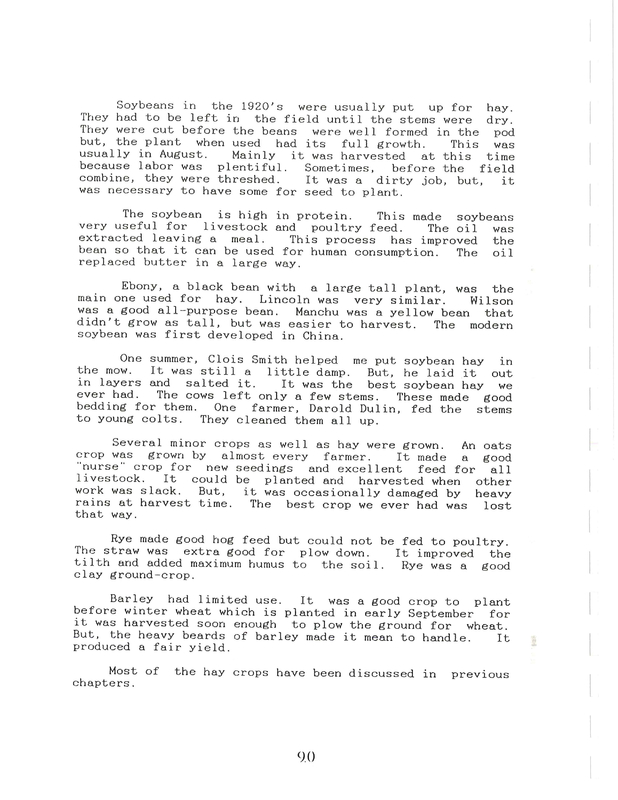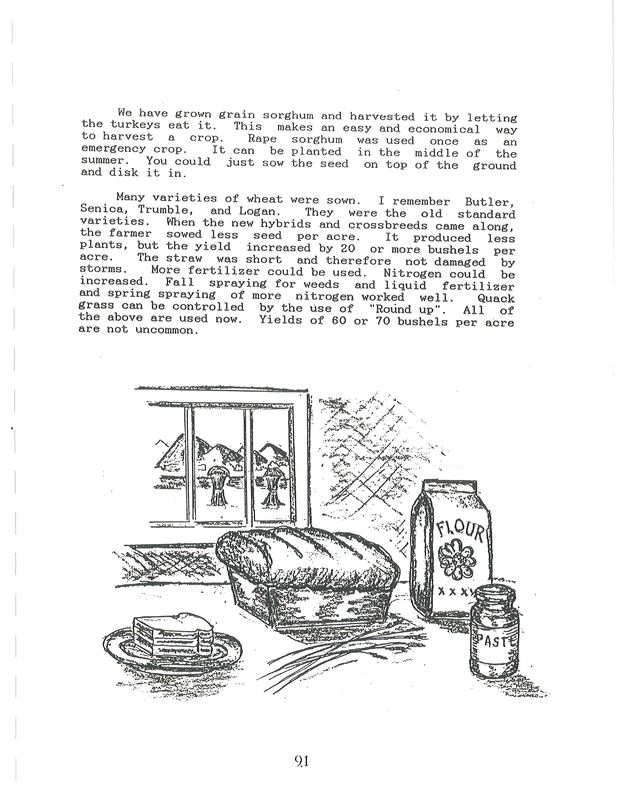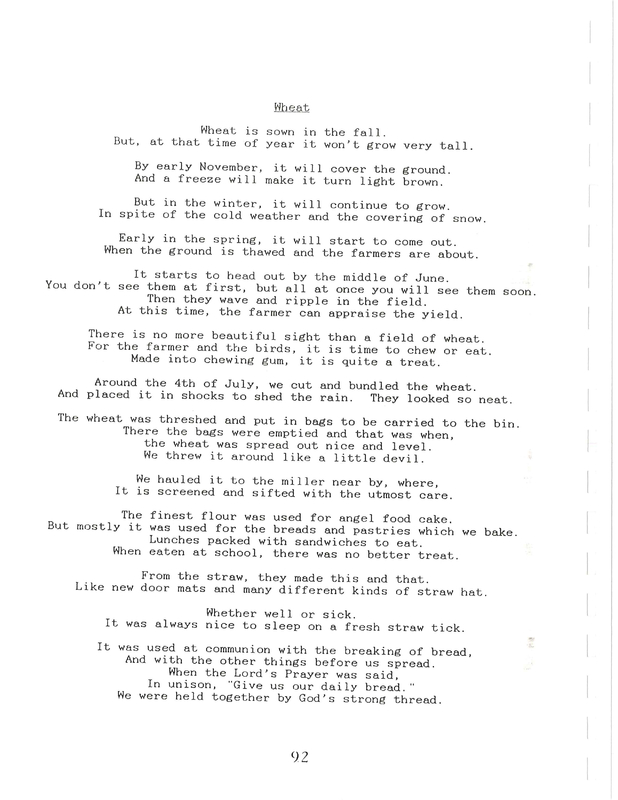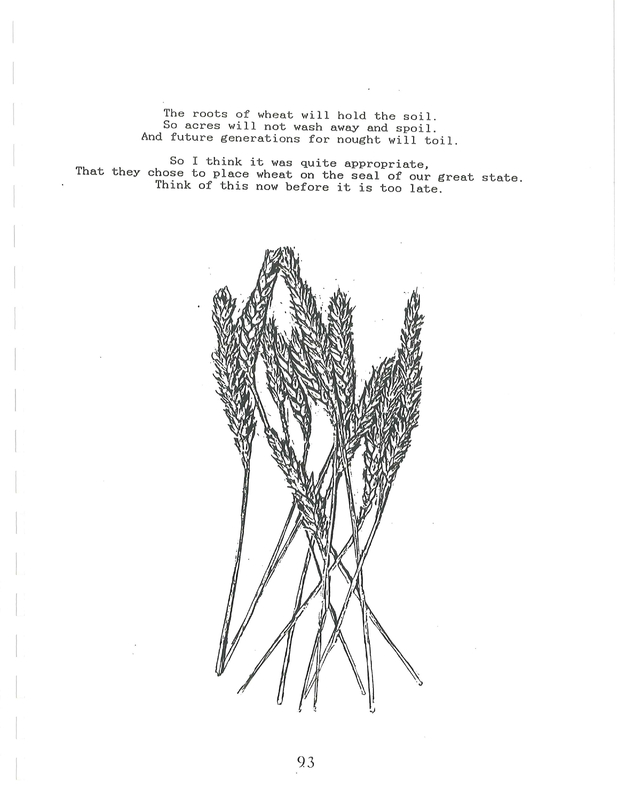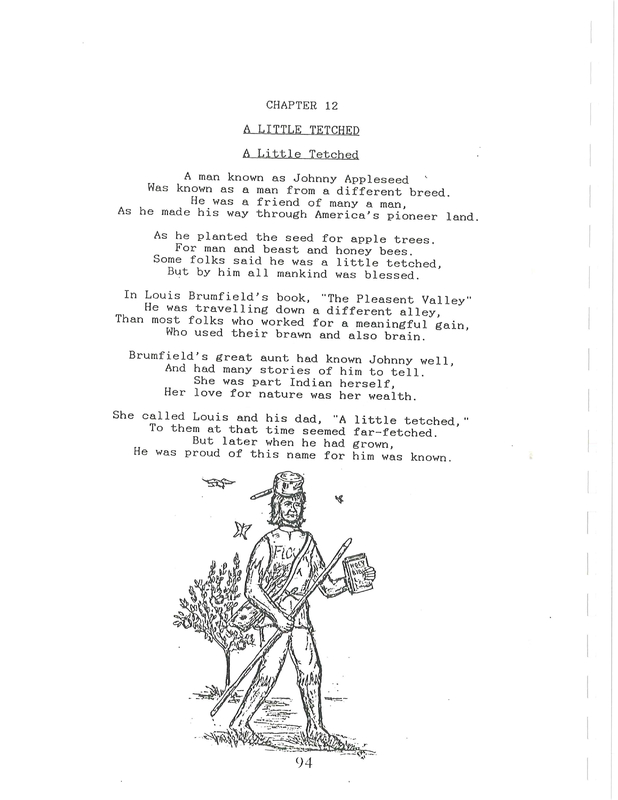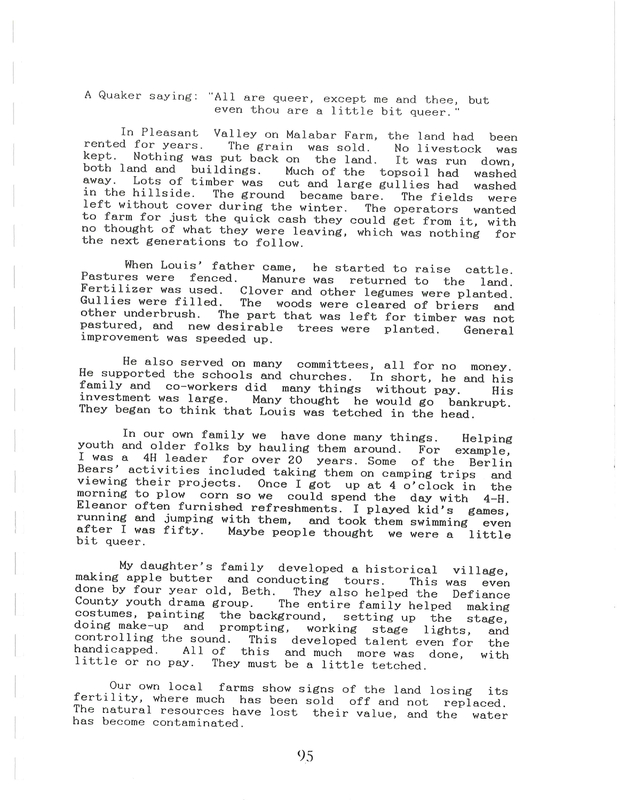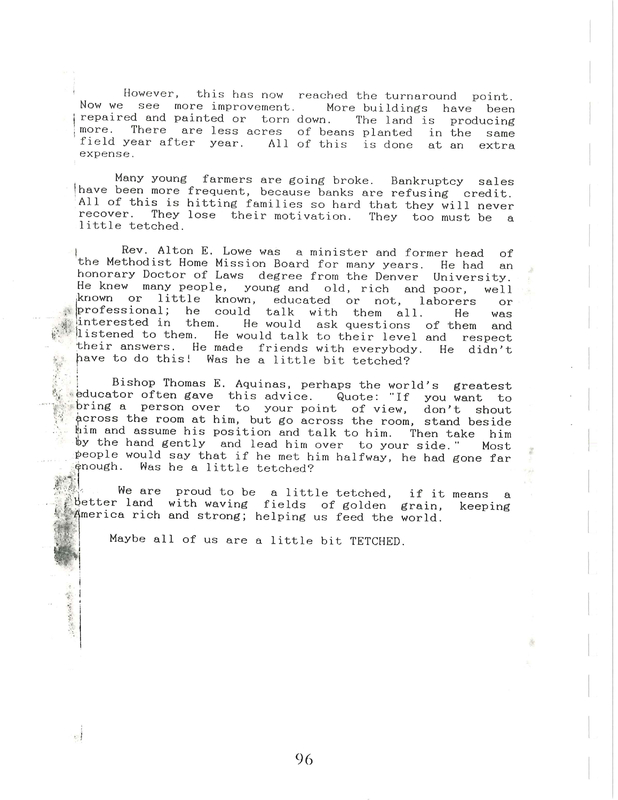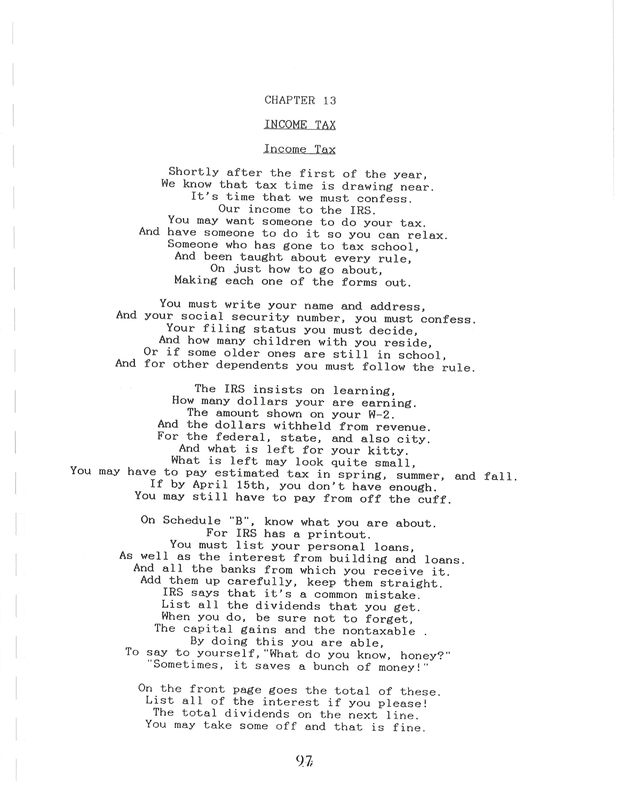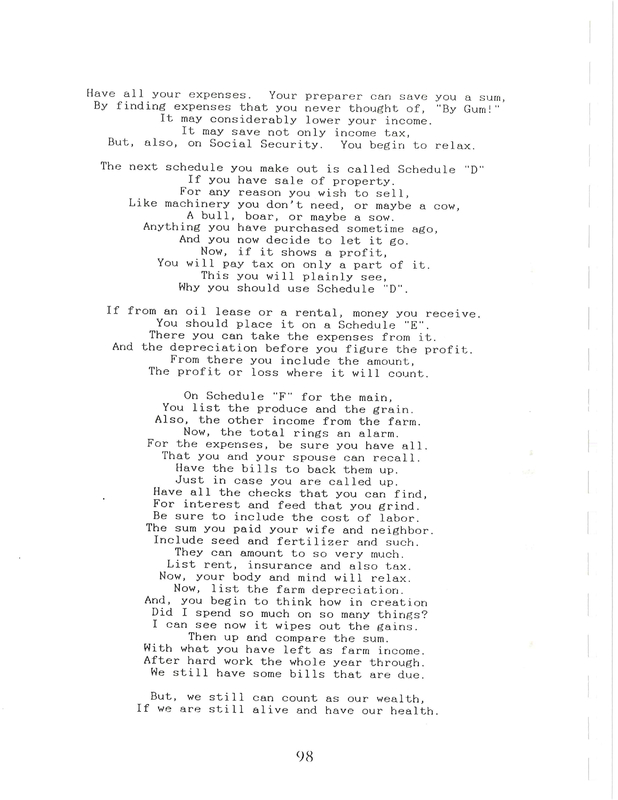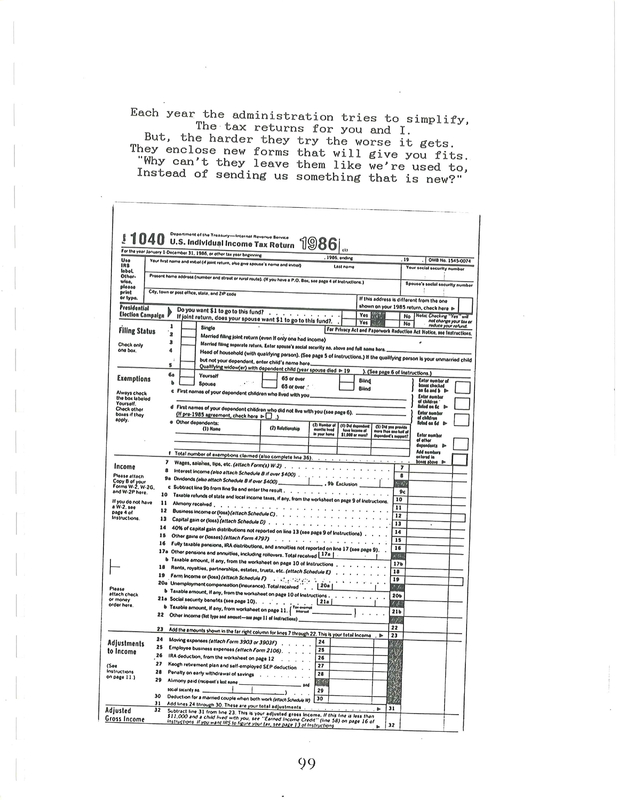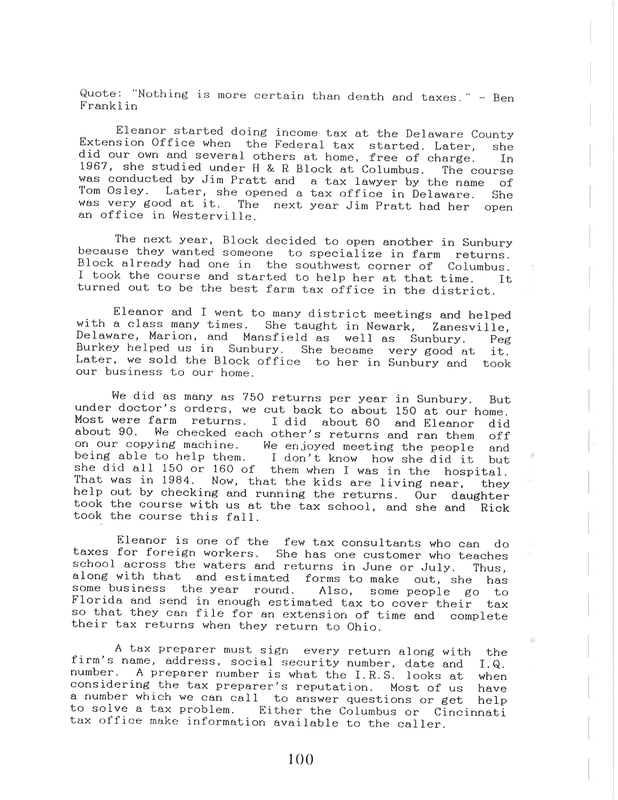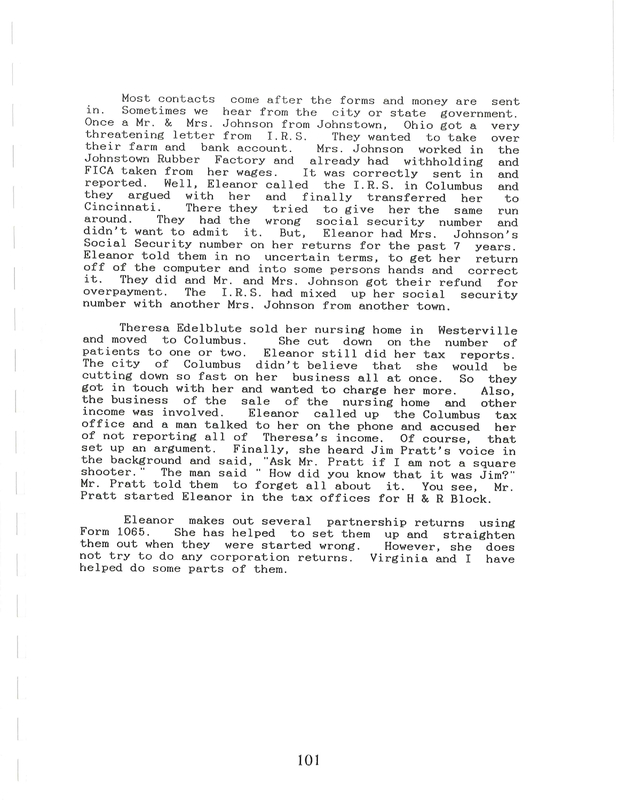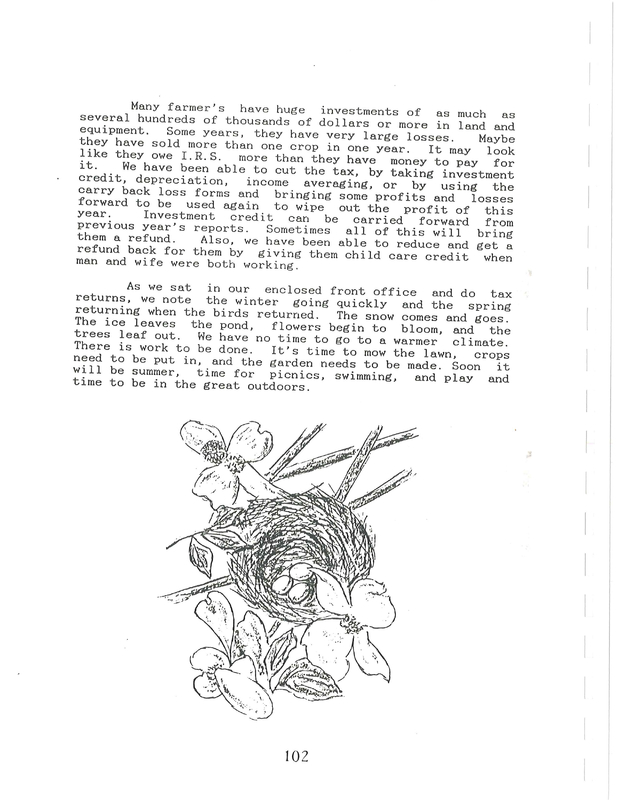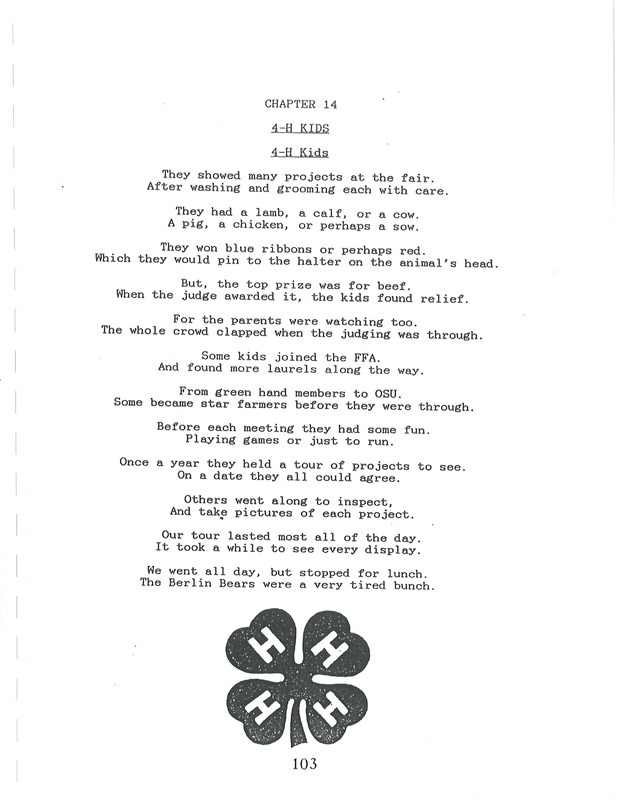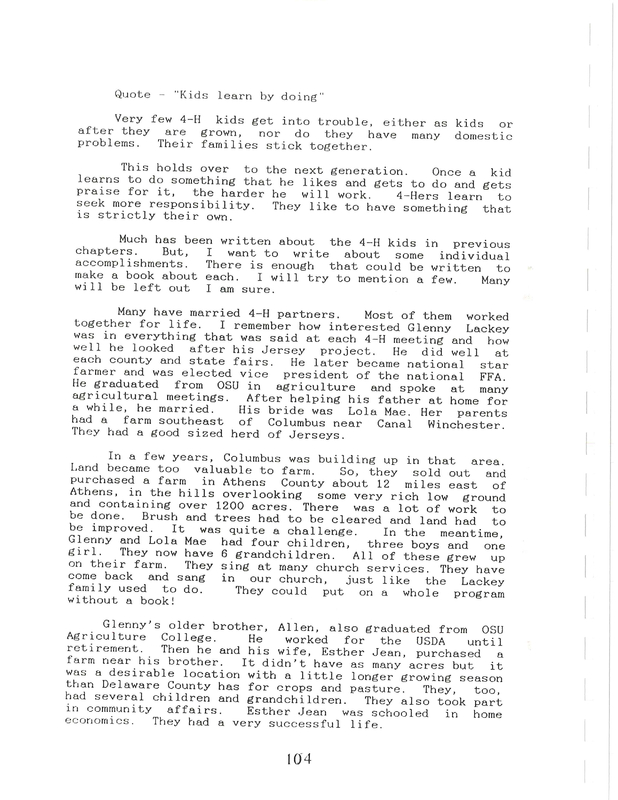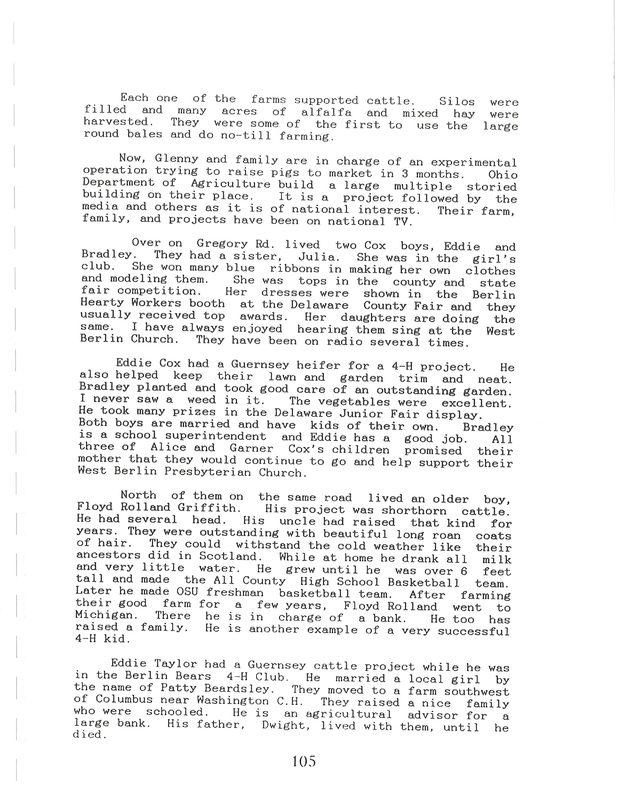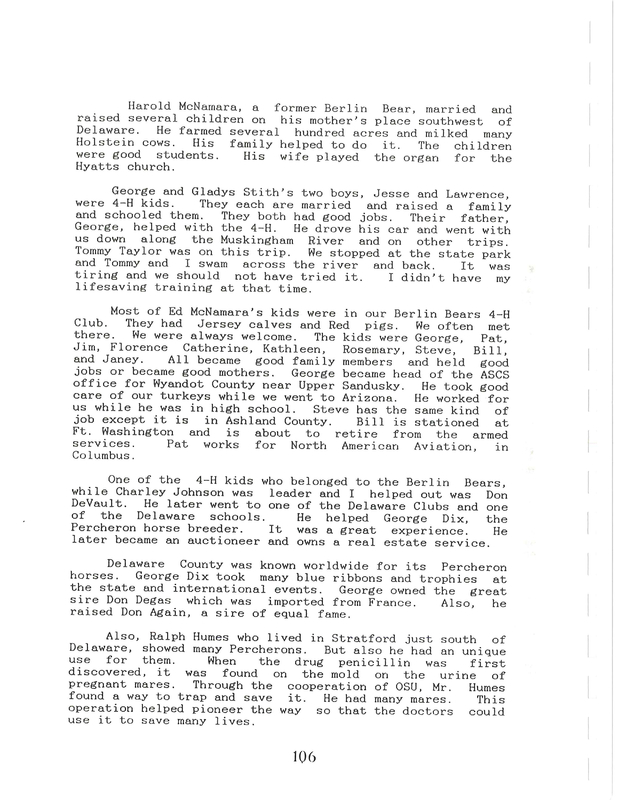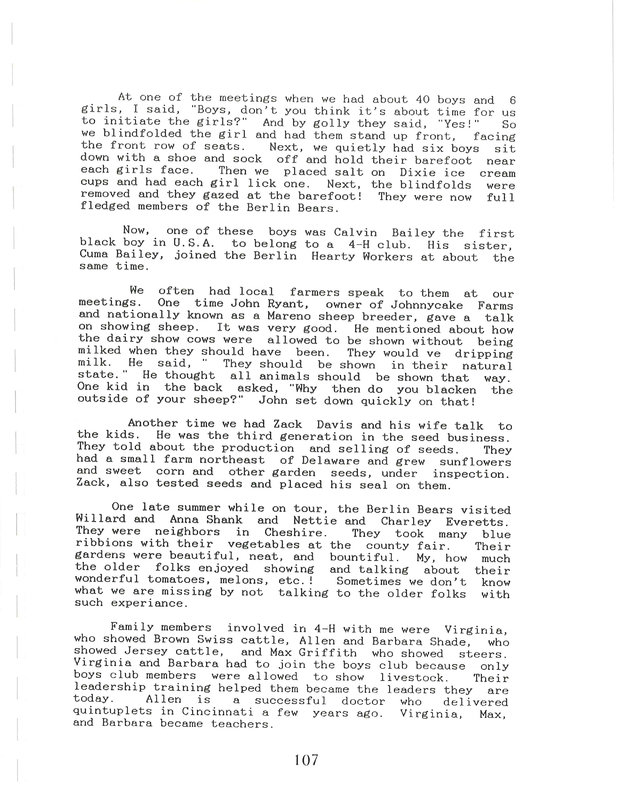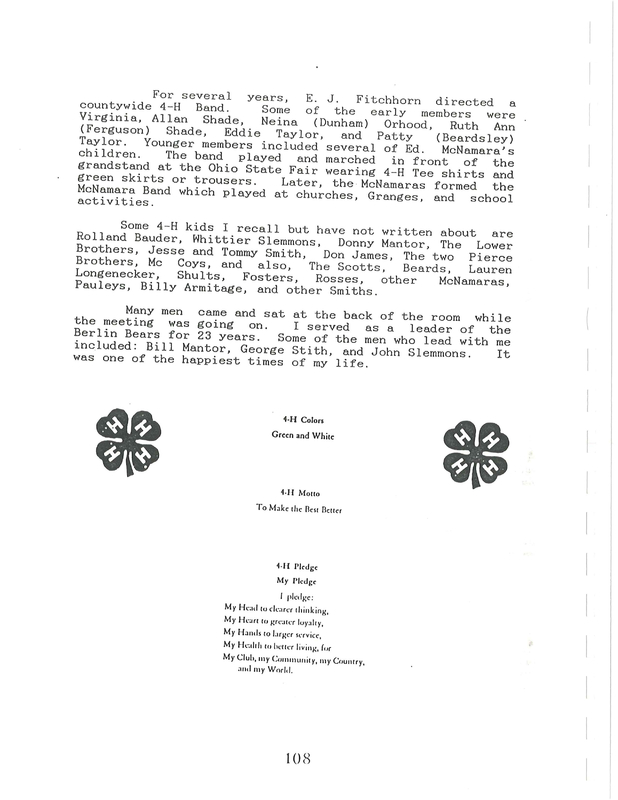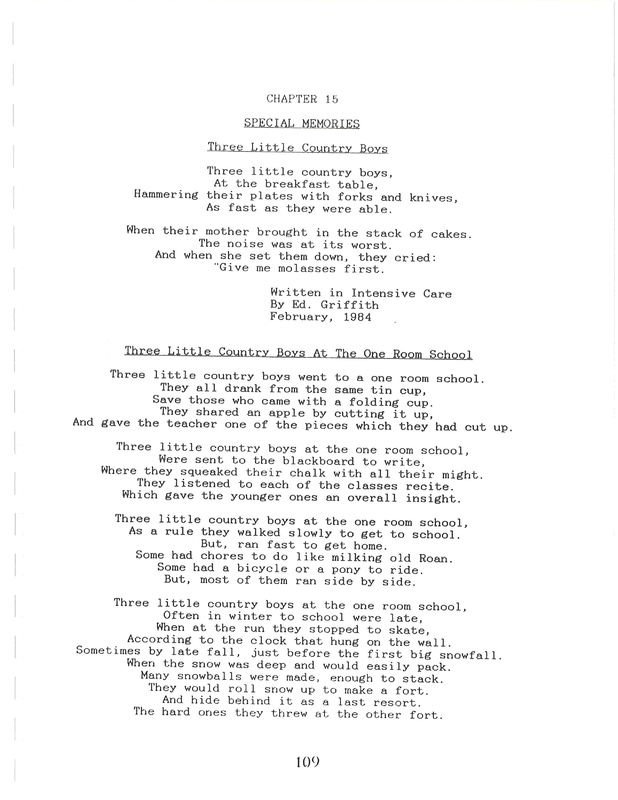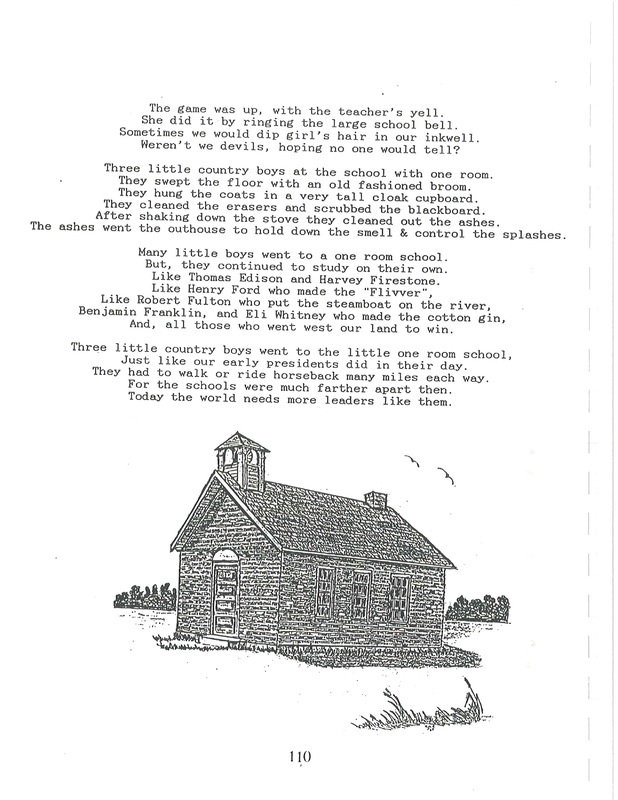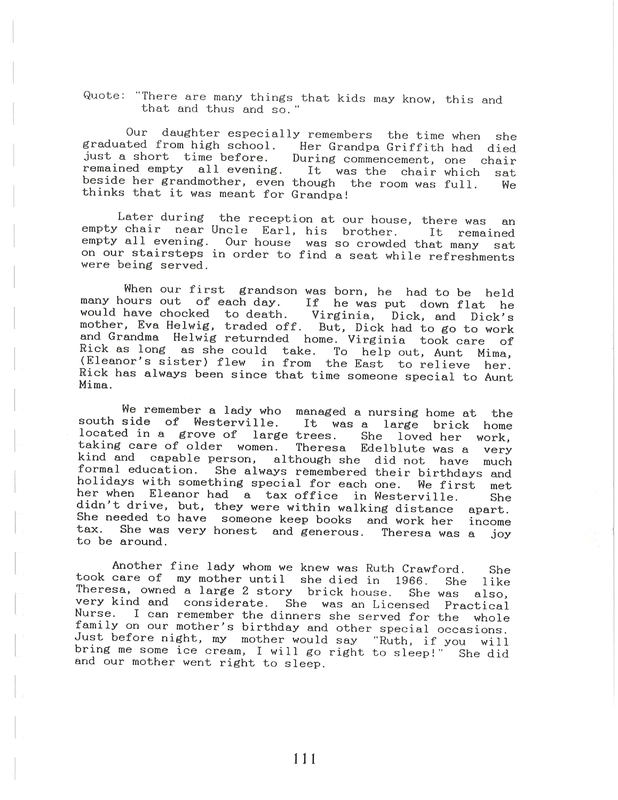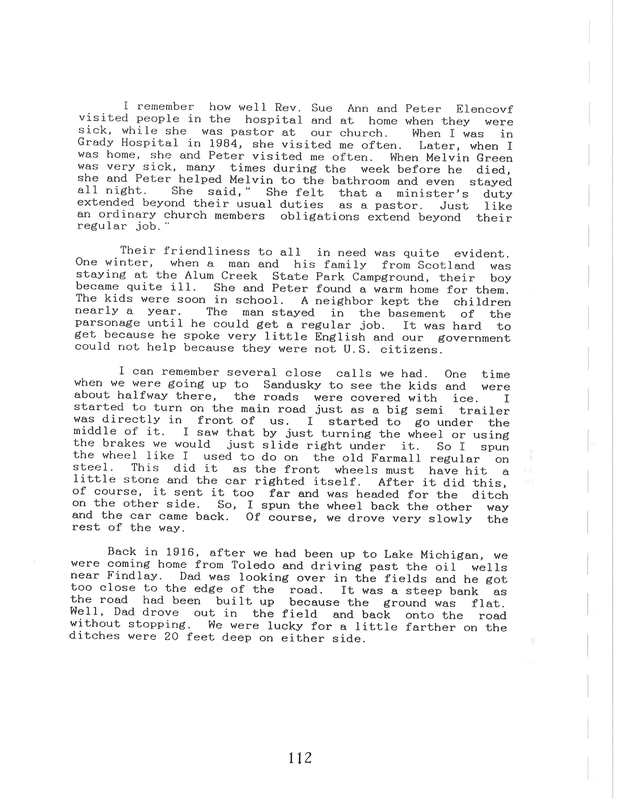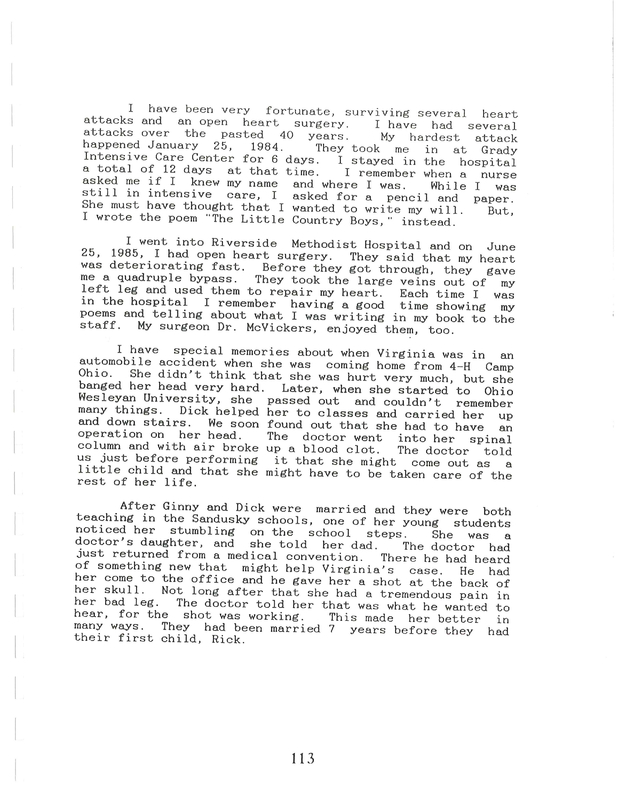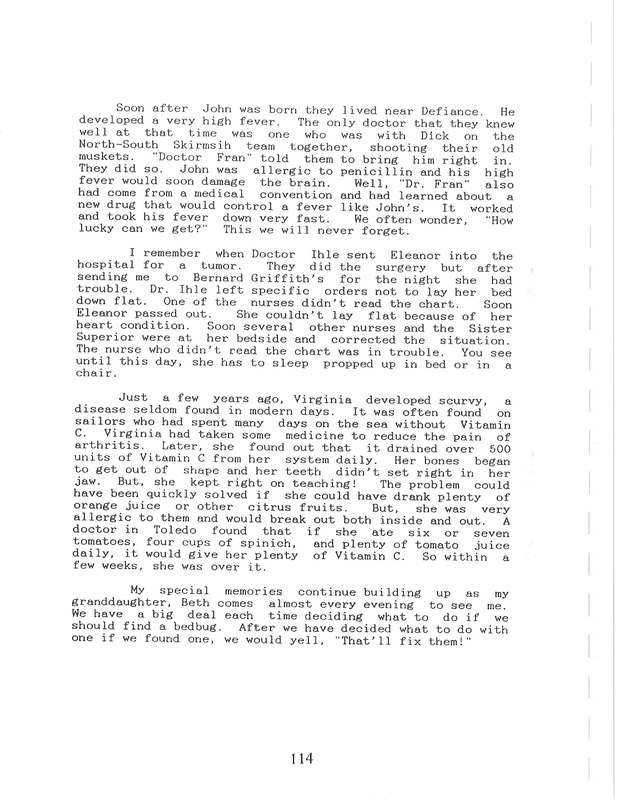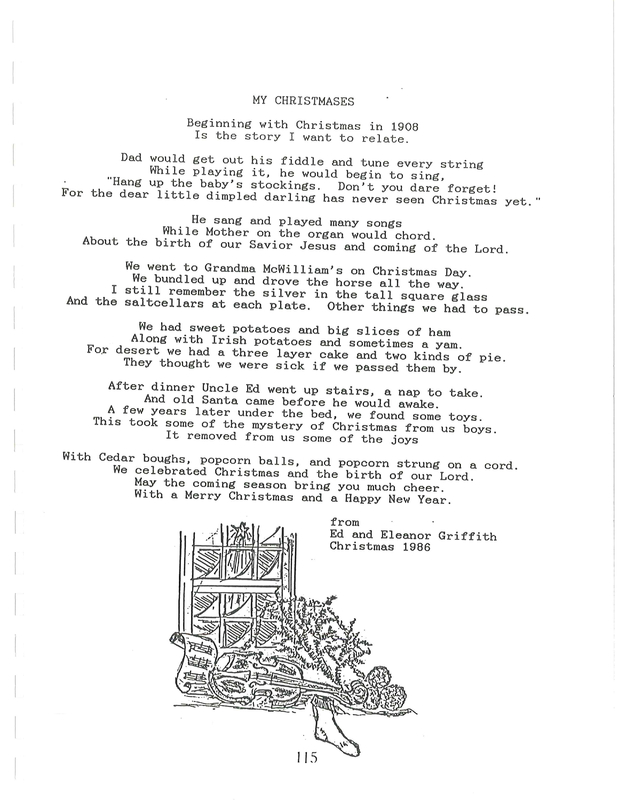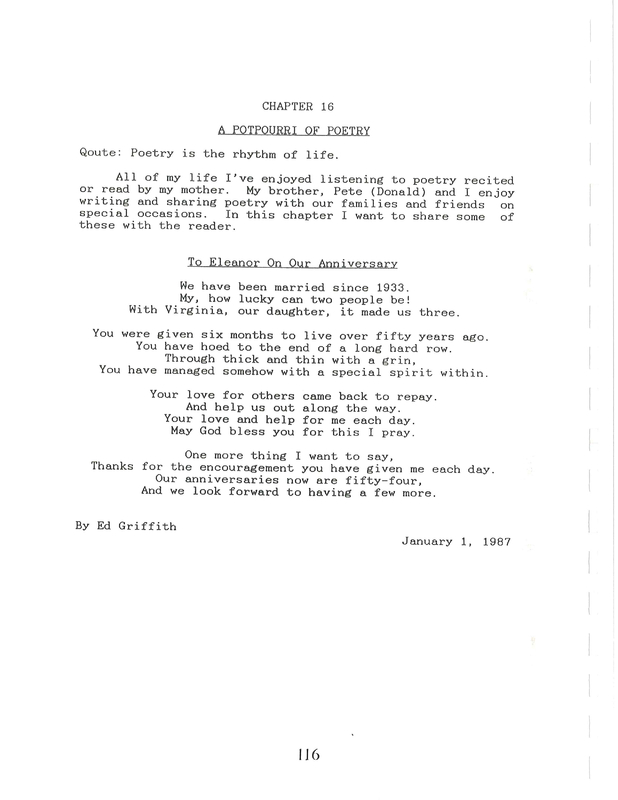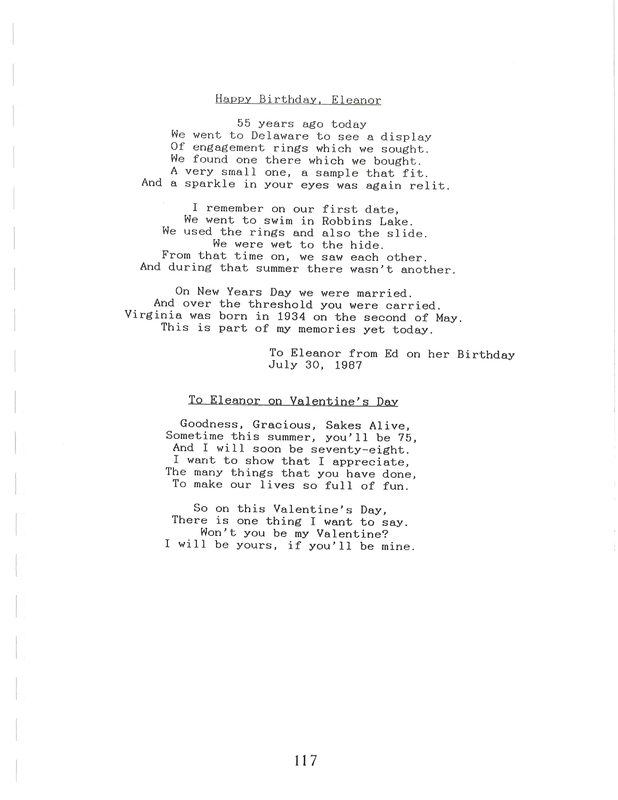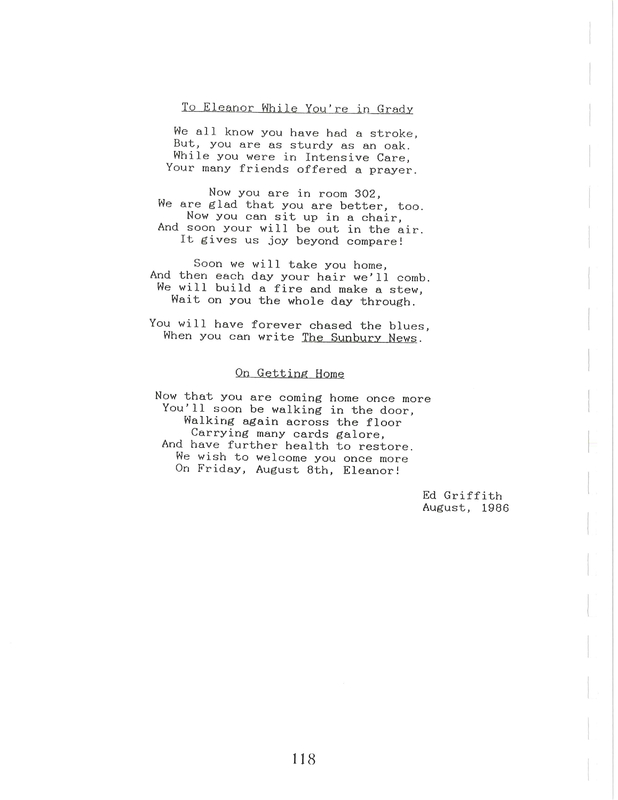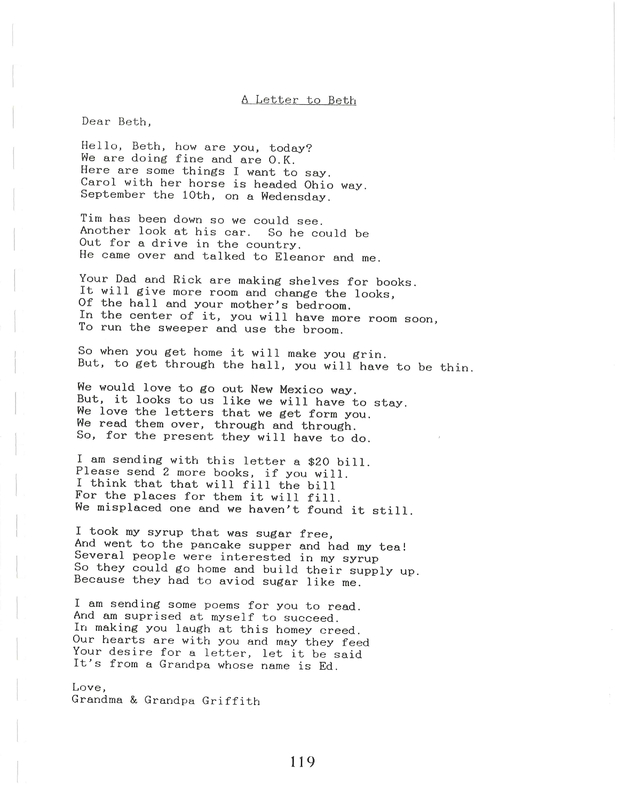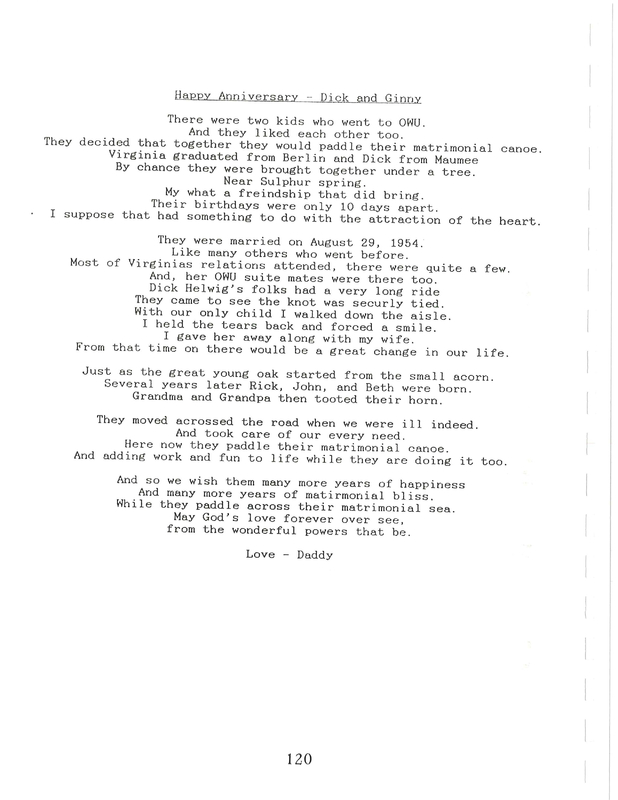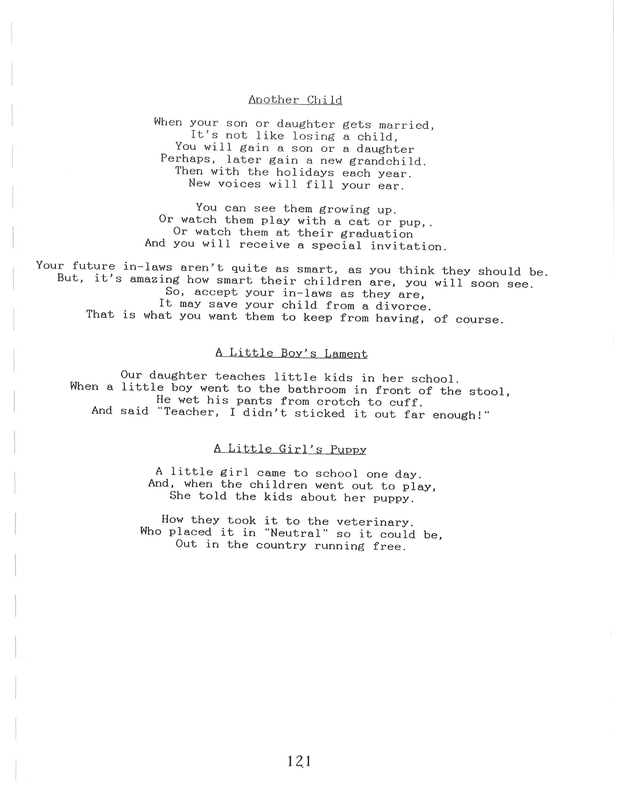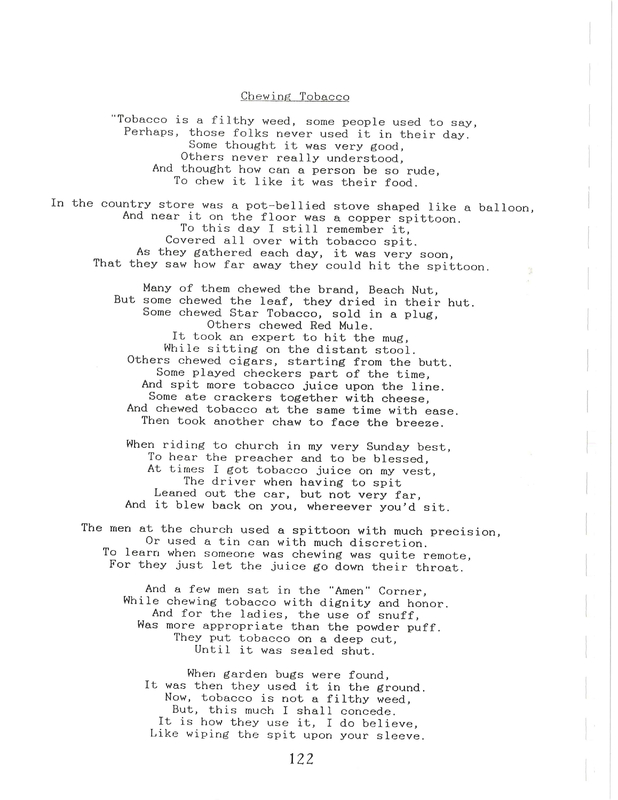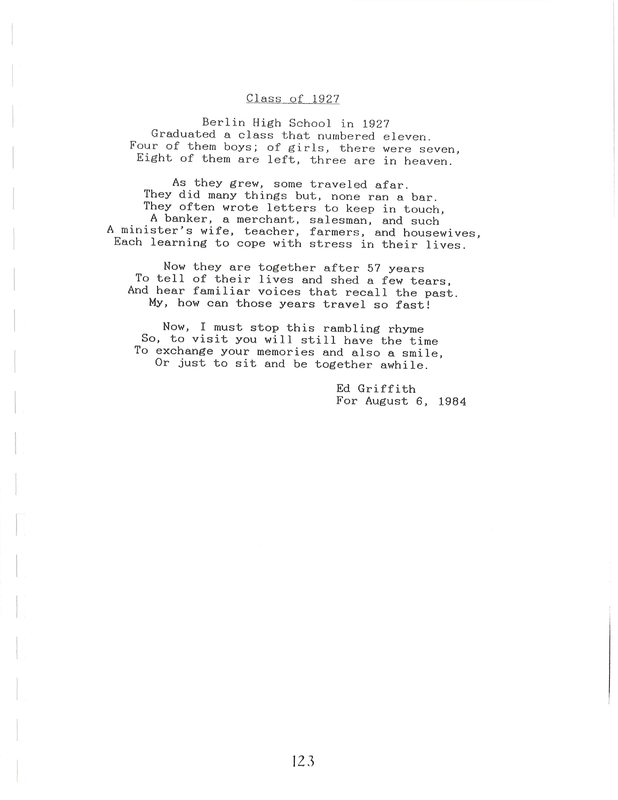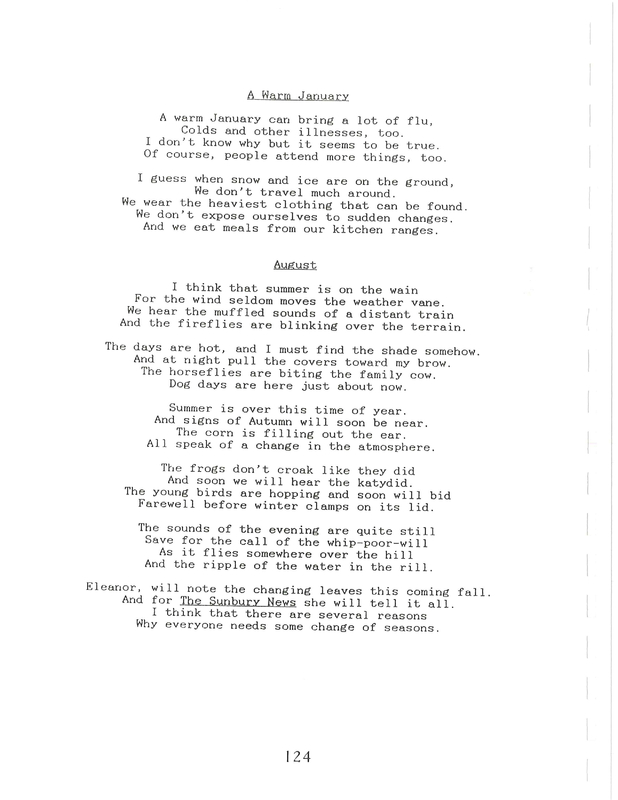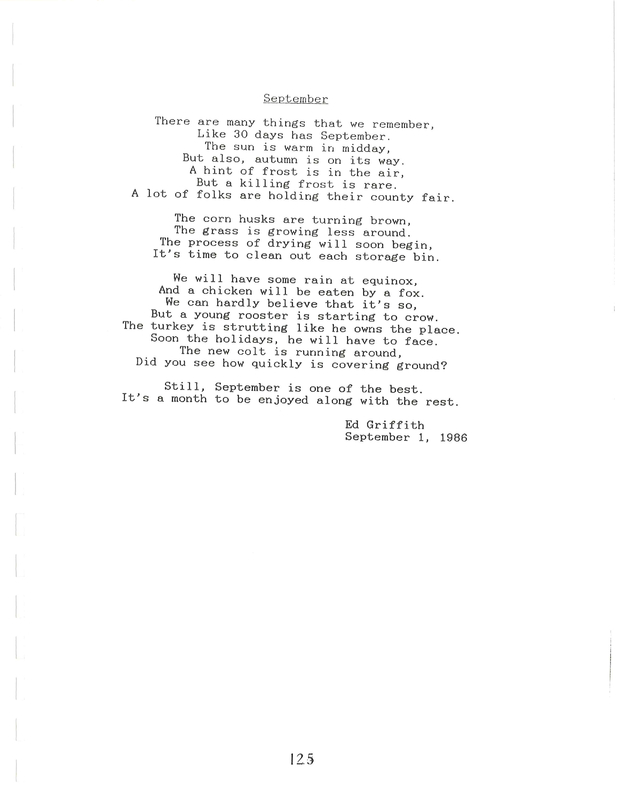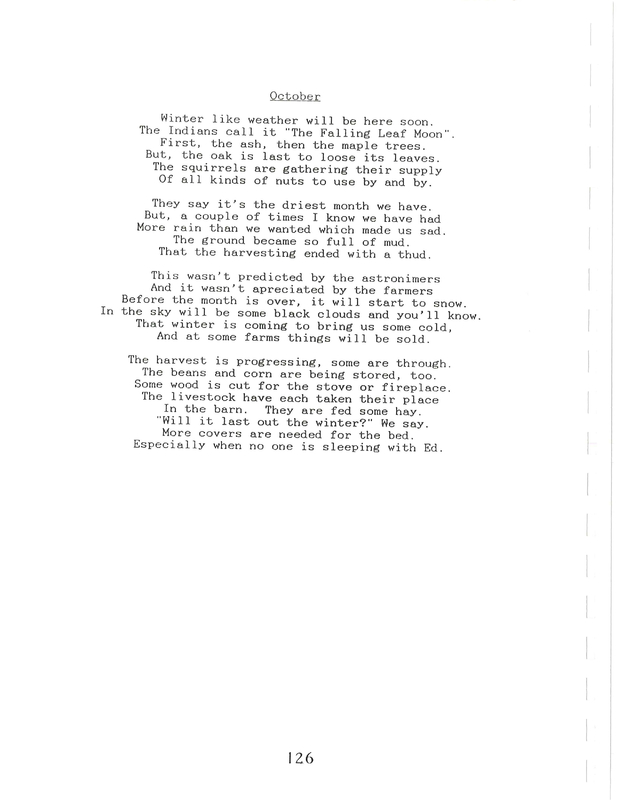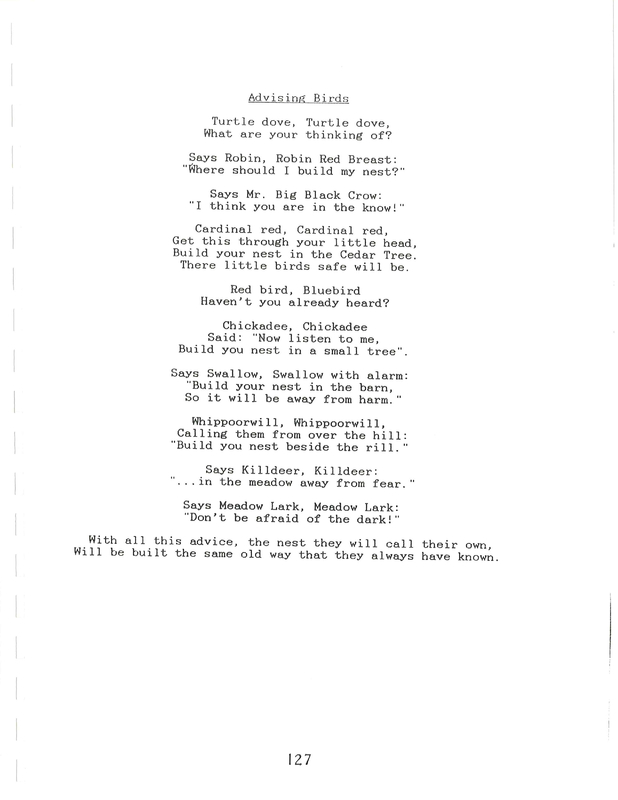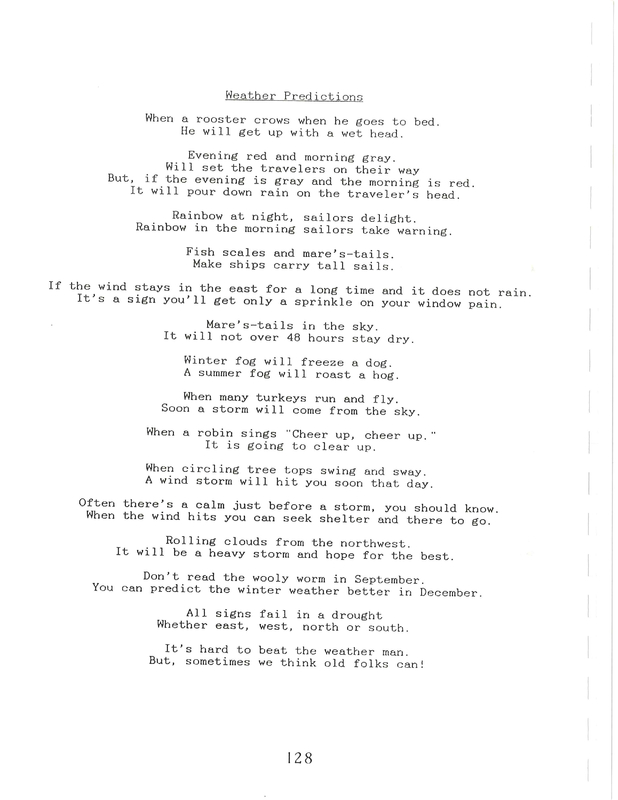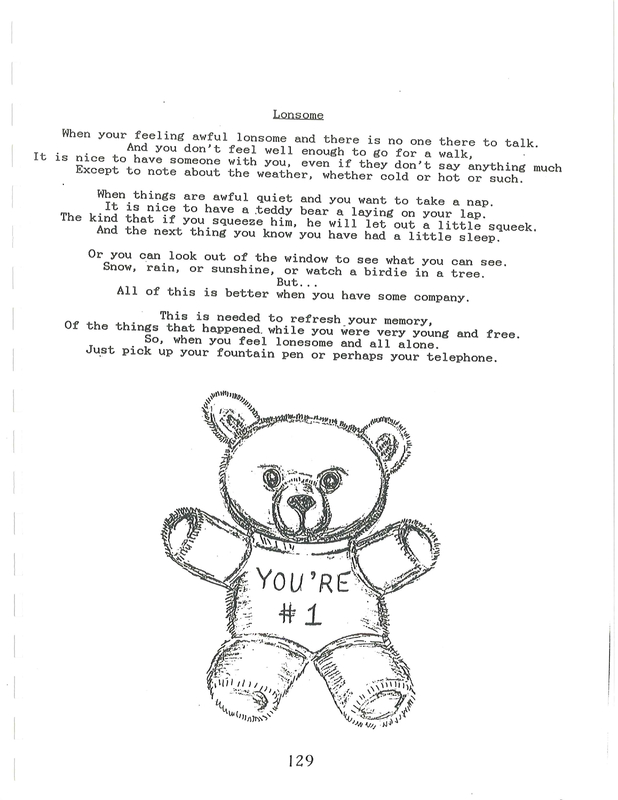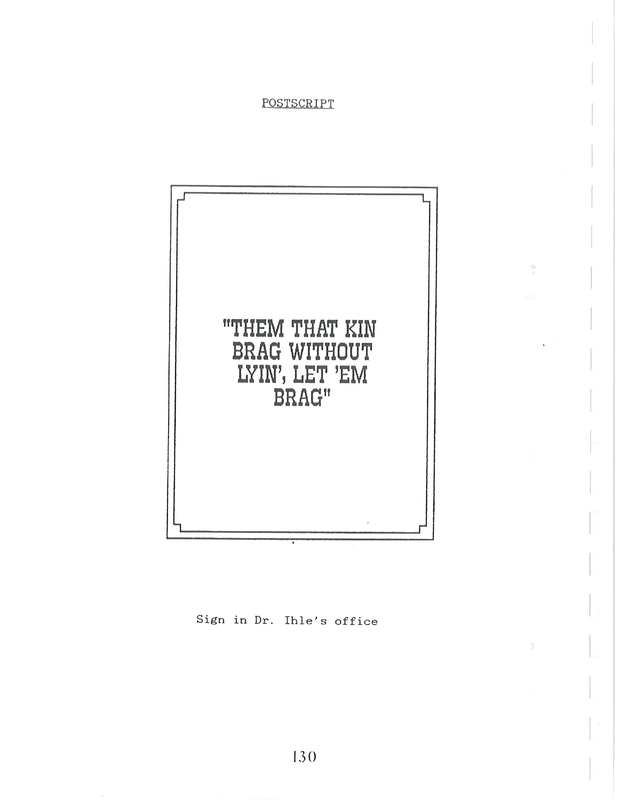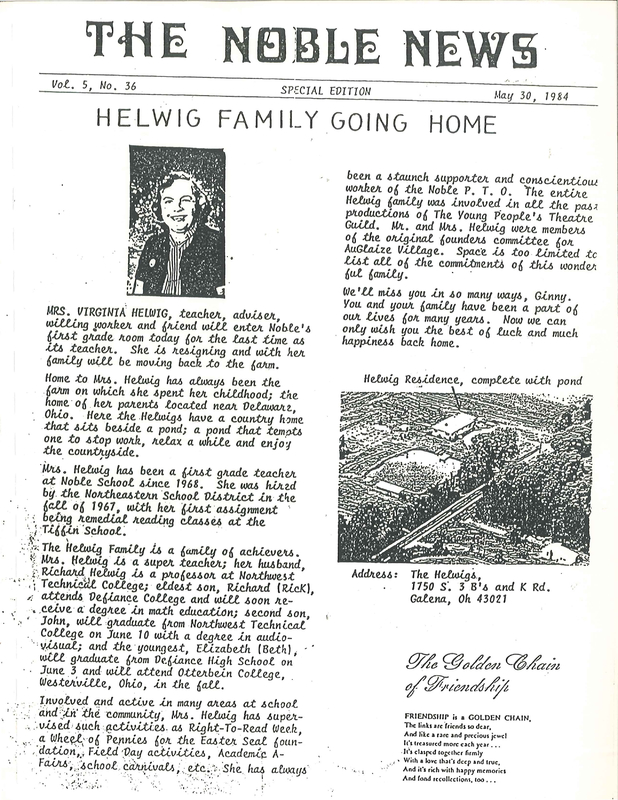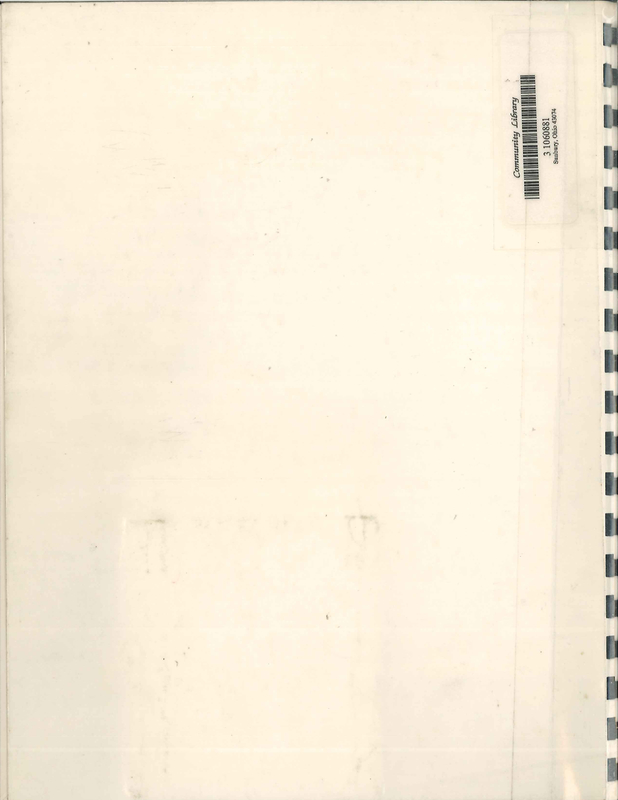77 Years on Johnnycake Road
Title
77 Years on Johnnycake Road (1)
Description
Corresponds to front cover of 77 Years on Johnnycake Road
77 YEARS
ON JOHNNYCAKE
ROAD
illustration of school house and scrolls with fountain pens in each corner
BY
EDWARD E. GRIFFITH
1987
77 YEARS
ON JOHNNYCAKE
ROAD
illustration of school house and scrolls with fountain pens in each corner
BY
EDWARD E. GRIFFITH
1987
Title
77 Years on Johnnycake Road (2)
Description
Corresponds to inside cover of 77 Years on Johnnycake Road
May all who read this book be blessed with many memories and happiness.
The Sunbury Community Library
It gives me pleasure to autograph this book, with my name in your behalf
Ed Griffith
illustration of Community Library bookplate
May all who read this book be blessed with many memories and happiness.
The Sunbury Community Library
It gives me pleasure to autograph this book, with my name in your behalf
Ed Griffith
illustration of Community Library bookplate
Title
77 Years on Johnnycake Road (3)
Description
Corresponds to title page cover of 77 Years on Johnnycake Road
77 YEARS
ON JOHNNYCAKE
ROAD
Written by
Edward E. Griffith
Illustrated By
Richard M. Helwig
Copyright C 1987 Edward E. Griffith
Published by
Classroom - Museum Products
1750 S 3 B's & K Rd.
Galena, Ohio 43021
First Edition - 1987
77 YEARS
ON JOHNNYCAKE
ROAD
Written by
Edward E. Griffith
Illustrated By
Richard M. Helwig
Copyright C 1987 Edward E. Griffith
Published by
Classroom - Museum Products
1750 S 3 B's & K Rd.
Galena, Ohio 43021
First Edition - 1987
Title
77 Years on Johnnycake Road (4)
Description
Corresponds to unnumbered page of 77 Years on Johnnycake Road
My Old Pocket Knife
Now that I have reached the retirement age in my life,
There is nothing better than my old pocket knife,
Except perhaps it is my wife.
It seems that she is always in the kitchen, rattling a pot lid.
While I am watching football on the grid.
She will stir up the dust by starting to sweep.
When I am in my big chair trying to sleep.
And when it comes to spring house cleaning day.
I want to be sure I'm out of her way
So, I'll go to the barn and lay on the hay.
My wife doesn't know it, but I have some candy,
It's in a tin box so it will be handy.
I'll tell you right now, but don't tell my wife.
I've had a wonderful life,
Just whittling away with my old pocket knife.
Just before dark I went to the hickory tree.
And cracked apart a nut, you see.
I used my pocket knife to pick the kernal out.
Then back in the woods I moved about
and picked some wild flowers,
to patch up the friendship of ours.
And, so, at this housecleaning time.
I just thought of another rhyme,
That I'll use to please my wife,
So I'll sharpen my pencil with my old pocket knife.
illustration of pocket knife
My Old Pocket Knife
Now that I have reached the retirement age in my life,
There is nothing better than my old pocket knife,
Except perhaps it is my wife.
It seems that she is always in the kitchen, rattling a pot lid.
While I am watching football on the grid.
She will stir up the dust by starting to sweep.
When I am in my big chair trying to sleep.
And when it comes to spring house cleaning day.
I want to be sure I'm out of her way
So, I'll go to the barn and lay on the hay.
My wife doesn't know it, but I have some candy,
It's in a tin box so it will be handy.
I'll tell you right now, but don't tell my wife.
I've had a wonderful life,
Just whittling away with my old pocket knife.
Just before dark I went to the hickory tree.
And cracked apart a nut, you see.
I used my pocket knife to pick the kernal out.
Then back in the woods I moved about
and picked some wild flowers,
to patch up the friendship of ours.
And, so, at this housecleaning time.
I just thought of another rhyme,
That I'll use to please my wife,
So I'll sharpen my pencil with my old pocket knife.
illustration of pocket knife
Title
77 Years on Johnnycake Road (5)
Description
Corresponds to unnumbered page of 77 Years on Johnnycake Road
ACKNOWLEDGMENTS
The author wishes to acknowledge the help and
inspiration he recieved from his family, neighbors, and
friends. Thank you goes to my wife, Eleanor for her
support, our daughter, Virginia Helwig, for her
proof-reading, my son-in-law, Richard M. Helwig, for his
drawings, ideas, and typing, my grandson, Rick Helwig, for
his extra computer work, and my granddaughter, Beth, and
grandson, John, for their computer work and pictures.
Many older folks provided information and memories of
times gone-by, especially Carrie Cleveland and Allie Boston.
I owe my extended life to Dr. Ihle, Dr. Held, and my
surgeon Dr. McVickers. They gave my the years to do my
writing.
ACKNOWLEDGMENTS
The author wishes to acknowledge the help and
inspiration he recieved from his family, neighbors, and
friends. Thank you goes to my wife, Eleanor for her
support, our daughter, Virginia Helwig, for her
proof-reading, my son-in-law, Richard M. Helwig, for his
drawings, ideas, and typing, my grandson, Rick Helwig, for
his extra computer work, and my granddaughter, Beth, and
grandson, John, for their computer work and pictures.
Many older folks provided information and memories of
times gone-by, especially Carrie Cleveland and Allie Boston.
I owe my extended life to Dr. Ihle, Dr. Held, and my
surgeon Dr. McVickers. They gave my the years to do my
writing.
Title
77 Years on Johnnycake Road (6)
Description
Corresponds to unnumbered page of 77 Years on Johnnycake Road
PRELUDE
The idea to write my book came from reading a book
written by Noel Perrin titled Third Person Rural. Many
historical facts would soon be lost if they were not written
down in some form. The author didn't want them lost
forever. Most of the poems just cam naturally during the
night while I was taking care of my wife.
Edward E. Griffith
1754 S. 3 B's & K Rd.
Galena, OH 43021
PRELUDE
The idea to write my book came from reading a book
written by Noel Perrin titled Third Person Rural. Many
historical facts would soon be lost if they were not written
down in some form. The author didn't want them lost
forever. Most of the poems just cam naturally during the
night while I was taking care of my wife.
Edward E. Griffith
1754 S. 3 B's & K Rd.
Galena, OH 43021
Title
77 Years on Johnnycake Road (7)
Description
Corresponds to unnumbered page of 77 Years on Johnnycake Road
CONTENTS
"My Old Pocket Knife"
Acknowledgements
Prelude
I Land, Drainage, and Horses..........1
"The Man With a Spade"..........1
II Ancestry...............................................5
"Our Reunion"...............................5
"The Irish Smile".........................11
III The Church .....................................12
"We had Fun".......................................12
IV Good Neighbors...........................20
"Country Dances"..............................20
V Great Big Dogs..............................26
"A Mother of Boys"...........................26
"the Pet Cemetary"..........................31
VI The Usual.......................................32
"Losing a Tooth".................................32
VII The Pond......................................43
"The Pond"..........................................43
"Our Trees".........................................55
VIII Society, Styles, and Habits..56
"Coffee"...............................................56
"Indian Summer"..............................66
IX Turkeys...........................................67
"Eleanor".............................................67
X The Big Brown Cow....................81
"Hand Milking"..................................81
XI Crops...............................................86
"Gadgets"............................................86
"Corn"...................................................89
"Wheat"...............................................93
XII A Little Tetched".......................94
"A Little Tetched"............................94
XIII Income Tax................................97
"Income Tax".....................................97
CONTENTS
"My Old Pocket Knife"
Acknowledgements
Prelude
I Land, Drainage, and Horses..........1
"The Man With a Spade"..........1
II Ancestry...............................................5
"Our Reunion"...............................5
"The Irish Smile".........................11
III The Church .....................................12
"We had Fun".......................................12
IV Good Neighbors...........................20
"Country Dances"..............................20
V Great Big Dogs..............................26
"A Mother of Boys"...........................26
"the Pet Cemetary"..........................31
VI The Usual.......................................32
"Losing a Tooth".................................32
VII The Pond......................................43
"The Pond"..........................................43
"Our Trees".........................................55
VIII Society, Styles, and Habits..56
"Coffee"...............................................56
"Indian Summer"..............................66
IX Turkeys...........................................67
"Eleanor".............................................67
X The Big Brown Cow....................81
"Hand Milking"..................................81
XI Crops...............................................86
"Gadgets"............................................86
"Corn"...................................................89
"Wheat"...............................................93
XII A Little Tetched".......................94
"A Little Tetched"............................94
XIII Income Tax................................97
"Income Tax".....................................97
Title
77 Years on Johnnycake Road (8)
Description
Corresponds to unnumbered page of 77 Years on Johnnycake Road
XIV 4-H Kids..........................................103
"4-H Kids"...............................................103
XV Special Memories.........................109
"Three Little Country Boys"............109
"Three Little Country Boys at the one Room School"...109
"My Christmases"................................115
XVI A Potpourri of Poetry................116
"To Eleanor on Our Anniversary"..116
"Happy Birthday, Eleanor"................117
"To Eleanor on Valentine's Day".....117
"To Eleanor, While You Are in Grady"...118
"On Getting Home".............................118
"A Letter to Beth".................................119
"Happy Anniversary, Dick and Ginny"...120
"Another Child"....................................121
"A Little Boy's Lament"......................121
"A Little Girl's Puppy".........................121
"Chewing Tobacco".............................122
"Class of 1927".....................................123
"A Warm January"...............................124
"August"...................................................125
"September"...........................................126
"October"................................................127
"Advising Birds"....................................128
"Lonesome".............................................129
Postscript................................................130
illustration of a woman preparing turkeys and a man standing beside her
XIV 4-H Kids..........................................103
"4-H Kids"...............................................103
XV Special Memories.........................109
"Three Little Country Boys"............109
"Three Little Country Boys at the one Room School"...109
"My Christmases"................................115
XVI A Potpourri of Poetry................116
"To Eleanor on Our Anniversary"..116
"Happy Birthday, Eleanor"................117
"To Eleanor on Valentine's Day".....117
"To Eleanor, While You Are in Grady"...118
"On Getting Home".............................118
"A Letter to Beth".................................119
"Happy Anniversary, Dick and Ginny"...120
"Another Child"....................................121
"A Little Boy's Lament"......................121
"A Little Girl's Puppy".........................121
"Chewing Tobacco".............................122
"Class of 1927".....................................123
"A Warm January"...............................124
"August"...................................................125
"September"...........................................126
"October"................................................127
"Advising Birds"....................................128
"Lonesome".............................................129
Postscript................................................130
illustration of a woman preparing turkeys and a man standing beside her
Title
77 Years on Johnnycake Road (9)
Description
Corresponds to page 1 of 77 Years on Johnnycake Road
CHAPTER 1
LAND, DRAINAGE, AND HORSES
The Man with The Spade
Not like the "Man with a Hoe"
Bowed by the centuries of toil.
Whose only reward was his share of the spoil,
And his only goal was the end of the row.
But the man with the spade was a man self made,
He'd dig a ditch with a very smooth grade,
And would lay the tile for what seemed a mile,
Then cover the tile to increase the yield,
For every crop grown in the field.
He had shoveled it out with rhythm and grace.
Every small stone was lodged from its place.
Straight as the string he had by his side,
Strung out ahead to use as a guide.
He was an artist, but hid his pride.
He loved to tend his crops after turning the sod,
And to watch them grow; each looking toward God.
Later at the casket, at the time of their grief,
Was a bundle of wheat tied as a sheaf.
Dedicated to Frank Williams, and
in memory of Clyde Griffith and
Johnathan Davenport
illustration of a man holding a horse with 3 children on the horse's back
1
CHAPTER 1
LAND, DRAINAGE, AND HORSES
The Man with The Spade
Not like the "Man with a Hoe"
Bowed by the centuries of toil.
Whose only reward was his share of the spoil,
And his only goal was the end of the row.
But the man with the spade was a man self made,
He'd dig a ditch with a very smooth grade,
And would lay the tile for what seemed a mile,
Then cover the tile to increase the yield,
For every crop grown in the field.
He had shoveled it out with rhythm and grace.
Every small stone was lodged from its place.
Straight as the string he had by his side,
Strung out ahead to use as a guide.
He was an artist, but hid his pride.
He loved to tend his crops after turning the sod,
And to watch them grow; each looking toward God.
Later at the casket, at the time of their grief,
Was a bundle of wheat tied as a sheaf.
Dedicated to Frank Williams, and
in memory of Clyde Griffith and
Johnathan Davenport
illustration of a man holding a horse with 3 children on the horse's back
1
Title
77 Years on Johnnycake Road (10)
Description
Corresponds to page 2 of 77 Years on Johnnycake Road
Quote: As Agriculture Goes, So Goes The Nation"
The land that was farmed had a drainage problem. The
best way to solve it was to bring the tile through a rill or
two from our land into another system. This we did with the
help of Mr. Williams. Sometimes we dug five feet deep just
to get the outlet that was needed.
My grandparents owned over 400 acres of land in Berlin
and Berkshire Townships in Delaware County. It was in the
Johnnycake School District (not to be confused with the
Pancake School, which was three miles south.) Each was
named for what was often found in the children's dinner
pails.
The land was mostly clay loam with some of black muck in
the low ground. There was also an outcropping of shale in
some places, and a layer of water filled gravel 10 or 20
feet underground.
The Shade farm was located one mile west of Alum Creek
between it and Big Run. The farm was where Eleanor's mother
lived until she was 96. An oil well was put down, and it
produced a small amount of good crude oil. The pipe was
lowered through a layer or more of thick limestone into a
dome of rock.
On the top of the ground was a large glacial deposit of
both large and small rocks. Mrs. Shade was sure they would
find oil there because her father's place in Oklahoma
produced oil and it was covered with similar stones.
There may be a reason for this arrangement. Could it
be the large dome of limestone under the ground had retained
enough heat from former years, or had it absorbed more
radiation that provided a little extra in that area to cause
the glacier to melt just a little faster there? This is
strictly my theory, but my son-in-law says this could have
been possible. After all, the glacial process took many
years. He is a geologist and teaches in a college. The oil
that they tapped was found in the third layer of the
limestone. The large brick house was built of brick made by
using the clay wax soil that occasionally cropped out there.
The soil was pulverized and made into bricks on the site.
On all of the farms, the fields were fenced in by rail
fences. The farmers spent many days cutting and splitting
them. They were made from hickory, oak , or other hardwoods.
Shorter rails were used at each corner to hold the zigzag
corners together. these were paced at about 45 degrees. A
barbed wire fence and more short rails were used to tighten
it up.
2
Quote: As Agriculture Goes, So Goes The Nation"
The land that was farmed had a drainage problem. The
best way to solve it was to bring the tile through a rill or
two from our land into another system. This we did with the
help of Mr. Williams. Sometimes we dug five feet deep just
to get the outlet that was needed.
My grandparents owned over 400 acres of land in Berlin
and Berkshire Townships in Delaware County. It was in the
Johnnycake School District (not to be confused with the
Pancake School, which was three miles south.) Each was
named for what was often found in the children's dinner
pails.
The land was mostly clay loam with some of black muck in
the low ground. There was also an outcropping of shale in
some places, and a layer of water filled gravel 10 or 20
feet underground.
The Shade farm was located one mile west of Alum Creek
between it and Big Run. The farm was where Eleanor's mother
lived until she was 96. An oil well was put down, and it
produced a small amount of good crude oil. The pipe was
lowered through a layer or more of thick limestone into a
dome of rock.
On the top of the ground was a large glacial deposit of
both large and small rocks. Mrs. Shade was sure they would
find oil there because her father's place in Oklahoma
produced oil and it was covered with similar stones.
There may be a reason for this arrangement. Could it
be the large dome of limestone under the ground had retained
enough heat from former years, or had it absorbed more
radiation that provided a little extra in that area to cause
the glacier to melt just a little faster there? This is
strictly my theory, but my son-in-law says this could have
been possible. After all, the glacial process took many
years. He is a geologist and teaches in a college. The oil
that they tapped was found in the third layer of the
limestone. The large brick house was built of brick made by
using the clay wax soil that occasionally cropped out there.
The soil was pulverized and made into bricks on the site.
On all of the farms, the fields were fenced in by rail
fences. The farmers spent many days cutting and splitting
them. They were made from hickory, oak , or other hardwoods.
Shorter rails were used at each corner to hold the zigzag
corners together. these were paced at about 45 degrees. A
barbed wire fence and more short rails were used to tighten
it up.
2
Title
77 Years on Johnnycake Road (11)
Description
Corresponds to page 3 of 77 Years on Johnnycake Road
Many Indian relics were found here and other lands
owned by my grandparents, and later land owned by my wife
and myself. The relics were arrowheads. they were usually
brought from eastern Ohio. They also found smoothing stones
for spreading bread dough and others for grinding corn or
other small grain. the stone hand tools seemed to fit the
hand.
Some places appeared to be campsites where the work was
done. Larger sites were on nearby farms and one where it
appeared that a chief had been buried. The O.S.U.
Archaeological Society dug some of these up before the Alum
Creek Reservoir was made.
On my Grandfather Griffith's farm was a very large
barn. It was used for horses. He supplied large matched
teams for neighbors each spring when they needed them. Most
of them were broken and ready for work. Most of them were
hitched in pairs, three or four abreast or in tandem using
four, five or six horses. There were no tractors in those
days.
My grandfather, Richard Griffith, had a driving horse
that would go to the buggy and stand between the staves on
command. As a demonstration, Grandpa placed oats in its
feed bag, but the horse still did the same.
One of the neighbors was Mason Smith. whenever, he
made hay and the dinner bell rang, even if he had fork full
of hay halfway up on the load of hay, he would drop it and
go for the house.
Once John Ryant borrowed one of his horses, because one
of his was sick. When he was back in the field, a dinner
bell rang and the horse went back to the barn in spite of
all that John could do.
One of the horses that Eleanor's folks had whose name
was Prince would come up close to a board fence and let all
three of their young grandchildren get on his back. Then he
would take them down the land and to Big Run and back. He
required no saddle or bridle.
Another one Old Toss would run off when Eleanor's
mother drove him. When the kids rode him and they met a
car, he would go to a ditch or over to a fence and just
stand there until the car had passed.
3
Many Indian relics were found here and other lands
owned by my grandparents, and later land owned by my wife
and myself. The relics were arrowheads. they were usually
brought from eastern Ohio. They also found smoothing stones
for spreading bread dough and others for grinding corn or
other small grain. the stone hand tools seemed to fit the
hand.
Some places appeared to be campsites where the work was
done. Larger sites were on nearby farms and one where it
appeared that a chief had been buried. The O.S.U.
Archaeological Society dug some of these up before the Alum
Creek Reservoir was made.
On my Grandfather Griffith's farm was a very large
barn. It was used for horses. He supplied large matched
teams for neighbors each spring when they needed them. Most
of them were broken and ready for work. Most of them were
hitched in pairs, three or four abreast or in tandem using
four, five or six horses. There were no tractors in those
days.
My grandfather, Richard Griffith, had a driving horse
that would go to the buggy and stand between the staves on
command. As a demonstration, Grandpa placed oats in its
feed bag, but the horse still did the same.
One of the neighbors was Mason Smith. whenever, he
made hay and the dinner bell rang, even if he had fork full
of hay halfway up on the load of hay, he would drop it and
go for the house.
Once John Ryant borrowed one of his horses, because one
of his was sick. When he was back in the field, a dinner
bell rang and the horse went back to the barn in spite of
all that John could do.
One of the horses that Eleanor's folks had whose name
was Prince would come up close to a board fence and let all
three of their young grandchildren get on his back. Then he
would take them down the land and to Big Run and back. He
required no saddle or bridle.
Another one Old Toss would run off when Eleanor's
mother drove him. When the kids rode him and they met a
car, he would go to a ditch or over to a fence and just
stand there until the car had passed.
3
Title
77 Years on Johnnycake Road (12)
Description
Corresponds to page 4 of 77 Years on Johnnycake Road
My Grandfather Griffith also had a few riding and buggy
horses. At one time he had a team of them and used them for
a carriage. He and the neighbors used two horses on their
spring wagons. Driving horses was the pride of the driver
and after each workout, they were curried and brushed.
Sometimes they used horse blankets until the horses cooled
down.
Most of the barns had a room where the farmers could
keep warm. often the hired man slept there. They also used
it to clean and repair harnesses. Always, on bad days, they
would oil the harness. The work horses wore large collars.
Sometimes they used collar pads. When a horses's shoulder
would become sore, the farmer would cut out a hole in the pad so
that the collar itself would not rub against it. There were
no licensed veterinarians at that time, but they had some
very good practical ones.
One man who lived not far away was known a Spot Quinn.
He was known through out central Ohio. He was a good honest
man who knew horses and all the tricks of the trade. He
lived until he was over 90. Many farmers depended on him to
pick out new horses for them. They gave him five or ten
dollars when the deal was made. My grandfather and
Eleanor's folks knew him well. He ate a few meals with
them.
He was very dirty when he was older. His wealthy
sister came from Columbus in a Cadillac and tried to clean
up his house and wash his clothes, but he wouldn't let her
do much. He used an old watering tank for his bed. He put
straw in it and the smooth sides kept the rats out.
He lived on the Old State Road on the curve about a
mile north of Route 36 and 37. He would get a ride by
standing in the front of cars so they had to stop. No one
wanted to pick him up because he smelled so bad, but they
had no choice. He would often spit tobacco juice up the
sleeve of his heavy overcoat.
When in town, he would to the West End Grill or the
Hamburger Inn to eat and drink. There he would talk to many
farmers and people about horses, both work and driving
horses. This way he got many leads. He was quite a boxer
and was only robbed once. It took more than one person to
rob him. After he died, they found a considerable amount of
money in the sole of his shoe.
All of my Grandfather's generation and the next were
farmers, this you will see as you read on in the next
chapters.
4
My Grandfather Griffith also had a few riding and buggy
horses. At one time he had a team of them and used them for
a carriage. He and the neighbors used two horses on their
spring wagons. Driving horses was the pride of the driver
and after each workout, they were curried and brushed.
Sometimes they used horse blankets until the horses cooled
down.
Most of the barns had a room where the farmers could
keep warm. often the hired man slept there. They also used
it to clean and repair harnesses. Always, on bad days, they
would oil the harness. The work horses wore large collars.
Sometimes they used collar pads. When a horses's shoulder
would become sore, the farmer would cut out a hole in the pad so
that the collar itself would not rub against it. There were
no licensed veterinarians at that time, but they had some
very good practical ones.
One man who lived not far away was known a Spot Quinn.
He was known through out central Ohio. He was a good honest
man who knew horses and all the tricks of the trade. He
lived until he was over 90. Many farmers depended on him to
pick out new horses for them. They gave him five or ten
dollars when the deal was made. My grandfather and
Eleanor's folks knew him well. He ate a few meals with
them.
He was very dirty when he was older. His wealthy
sister came from Columbus in a Cadillac and tried to clean
up his house and wash his clothes, but he wouldn't let her
do much. He used an old watering tank for his bed. He put
straw in it and the smooth sides kept the rats out.
He lived on the Old State Road on the curve about a
mile north of Route 36 and 37. He would get a ride by
standing in the front of cars so they had to stop. No one
wanted to pick him up because he smelled so bad, but they
had no choice. He would often spit tobacco juice up the
sleeve of his heavy overcoat.
When in town, he would to the West End Grill or the
Hamburger Inn to eat and drink. There he would talk to many
farmers and people about horses, both work and driving
horses. This way he got many leads. He was quite a boxer
and was only robbed once. It took more than one person to
rob him. After he died, they found a considerable amount of
money in the sole of his shoe.
All of my Grandfather's generation and the next were
farmers, this you will see as you read on in the next
chapters.
4
Title
77 Years on Johnnycake Road (13)
Description
Corresponds to page 5 of 77 Years on Johnnycake Road
CHAPTER 2
ANCESTRY
Our Reunion
Richard Griffith and Amelia Hayes
Surely deserve a lot of praise
For the children of their union
Were the ones who started this reunion.
There was Rosanna, Marjorie, George and Tom.
Bill and Dick and also John.
They held it each year to shoot the breeze
In someone's dooryard under the trees
Or on a large porch in case of rain
Each they had their domain.
They came with baskets filled to the brim.
Some people were fat: others were slim.
Some drove on or two horses hitched to carriages with trim.
Others drove Fords, Overland, Maxwells, Empire, or Krit
Anyone of them could give the horses a fit.
With high seats, cloth tops, gas lights, and hand cranks to get them started
And horns, they were sure to blow before they departed.
Later they found it was a lark
Top hold the reunion at Olentangy Park.
Uncle Tom brought tickets so kids could ride
On the Whirlwind, Red Devil, or Water Slide.
It also seemed to be their rule
For kids to go into the swimming pool.
After going to the ticket window and paying the fees,
They were given cotton swimsuits that came down to their knees.
They would have lost them if they should have sneezed.
All ate so much food, most people would groan
But when they left, they bought another cone.
For several years, it was held in Mt. Aire
At Dr. and Mrs. Willie's. They were a lovely pair.
It was a grand place
As we watched kinfolk embrace.
Uncle George from Illinois was there
He thought kissing the new brides was fair.
With a swimming pool there nearby
Our enjoyment nearly reached the sky.
Soon one generation was gone, another came,
And it was time to change our name.
So it was called the Griffith, McNamara, and James Reunion
Now it has become a well-known institution.
5
CHAPTER 2
ANCESTRY
Our Reunion
Richard Griffith and Amelia Hayes
Surely deserve a lot of praise
For the children of their union
Were the ones who started this reunion.
There was Rosanna, Marjorie, George and Tom.
Bill and Dick and also John.
They held it each year to shoot the breeze
In someone's dooryard under the trees
Or on a large porch in case of rain
Each they had their domain.
They came with baskets filled to the brim.
Some people were fat: others were slim.
Some drove on or two horses hitched to carriages with trim.
Others drove Fords, Overland, Maxwells, Empire, or Krit
Anyone of them could give the horses a fit.
With high seats, cloth tops, gas lights, and hand cranks to get them started
And horns, they were sure to blow before they departed.
Later they found it was a lark
Top hold the reunion at Olentangy Park.
Uncle Tom brought tickets so kids could ride
On the Whirlwind, Red Devil, or Water Slide.
It also seemed to be their rule
For kids to go into the swimming pool.
After going to the ticket window and paying the fees,
They were given cotton swimsuits that came down to their knees.
They would have lost them if they should have sneezed.
All ate so much food, most people would groan
But when they left, they bought another cone.
For several years, it was held in Mt. Aire
At Dr. and Mrs. Willie's. They were a lovely pair.
It was a grand place
As we watched kinfolk embrace.
Uncle George from Illinois was there
He thought kissing the new brides was fair.
With a swimming pool there nearby
Our enjoyment nearly reached the sky.
Soon one generation was gone, another came,
And it was time to change our name.
So it was called the Griffith, McNamara, and James Reunion
Now it has become a well-known institution.
5
Title
77 Years on Johnnycake Road (14)
Description
Corresponds to page 6 of 77 Years on Johnnycake Road
Many years it was held on the grounds of the Delaware County Fair
All seemed to enjoy the facilities there.
They would sit and talk or watch race horses train
Pitch horseshoes, or swim, or watch others do the same.
Now we are meeting in Berlin Twonship
Enjoying our kinship as well as our friendship.
Near to our folks in the cemetery.
We are proud again of our ancestry.
This is our prayer "May we forever be
In the home of the brave and the land of the free."
Written by Edward Griffith
August 12, 1984
illustration of Griffith family members
6
Many years it was held on the grounds of the Delaware County Fair
All seemed to enjoy the facilities there.
They would sit and talk or watch race horses train
Pitch horseshoes, or swim, or watch others do the same.
Now we are meeting in Berlin Twonship
Enjoying our kinship as well as our friendship.
Near to our folks in the cemetery.
We are proud again of our ancestry.
This is our prayer "May we forever be
In the home of the brave and the land of the free."
Written by Edward Griffith
August 12, 1984
illustration of Griffith family members
6
Title
77 Years on Johnnycake Road (15)
Description
Corresponds to page 7 of 77 Years on Johnnycake Road
Irish Prayer: May the Lord bless you, and the devil not
miss you until six months after you're dead, with him not
even knowing you have been sick.
My Great-Grandfather came with his wife and children toNew YorkCity from Ireland during the potato famine. While
there he bought the largest pair of boots he could find. He
was a small man, but he said he could stuff a wasp of hay in
them so they would fit. He would get more for his money
that way. In Ireland, his last name was Griffin, but they
could not understand his brogue. When the immigration
officer wrote Griffith, he did not try to correct them. So, that is what they have gone by since.
My Grandfather, Richard (Dick) Griffith, was born later
in Cleveland, Ohio. His father went to work helping build
the railroad. That is how he came to Delaware County and
settled on some land in Berlin Township.
Adaline Hotchkiss was the wife of Dick (Richard)
Griffith. She was born in 1849. Her mother was Sarah Ann
Scott Hotchkiss. Her father was Lyman Hotchkiss.
Lyman Hotchkiss came from Waterbury, Conn
near Watertown. I was told that two brothers came down to eastern Pennsylvania on a raft. One had a family: the other was Lyman. One night he took the raft and floated on down
the river eventually come to Ohio. From there he came
here and married Sarah Ann Scott.
From this union came two girls, Adaline and Flora.
Adaline married Dick Griffith but Flora remained single.
She died while a young lady.
My grandparents, the Richard Griffiths', had 3 boys,
Alwood O., Winfred Irwin, and Earl Gorden. And their
step-sister Grace Buckingham. All of them attended the Cheshire M. E. Church, as well as other churches. He joined
Cheshire in 1879. Before that my Grandparents often went to peachblow.
Dad and Uncle Alwood went to High School in Galena,
Earl went to Delaware High School. Grace developed a
musical talent and taught private and public school music in Columbus. They had a baby grand piano in their home. At
one time someone told her that she had no
musical talent,
7
Irish Prayer: May the Lord bless you, and the devil not
miss you until six months after you're dead, with him not
even knowing you have been sick.
My Great-Grandfather came with his wife and children toNew YorkCity from Ireland during the potato famine. While
there he bought the largest pair of boots he could find. He
was a small man, but he said he could stuff a wasp of hay in
them so they would fit. He would get more for his money
that way. In Ireland, his last name was Griffin, but they
could not understand his brogue. When the immigration
officer wrote Griffith, he did not try to correct them. So, that is what they have gone by since.
My Grandfather, Richard (Dick) Griffith, was born later
in Cleveland, Ohio. His father went to work helping build
the railroad. That is how he came to Delaware County and
settled on some land in Berlin Township.
Adaline Hotchkiss was the wife of Dick (Richard)
Griffith. She was born in 1849. Her mother was Sarah Ann
Scott Hotchkiss. Her father was Lyman Hotchkiss.
Lyman Hotchkiss came from Waterbury, Conn
near Watertown. I was told that two brothers came down to eastern Pennsylvania on a raft. One had a family: the other was Lyman. One night he took the raft and floated on down
the river eventually come to Ohio. From there he came
here and married Sarah Ann Scott.
From this union came two girls, Adaline and Flora.
Adaline married Dick Griffith but Flora remained single.
She died while a young lady.
My grandparents, the Richard Griffiths', had 3 boys,
Alwood O., Winfred Irwin, and Earl Gorden. And their
step-sister Grace Buckingham. All of them attended the Cheshire M. E. Church, as well as other churches. He joined
Cheshire in 1879. Before that my Grandparents often went to peachblow.
Dad and Uncle Alwood went to High School in Galena,
Earl went to Delaware High School. Grace developed a
musical talent and taught private and public school music in Columbus. They had a baby grand piano in their home. At
one time someone told her that she had no
musical talent,
7
Title
77 Years on Johnnycake Road (16)
Description
Corresponds to page 8 of 77 Years on Johnnycake Road
The Galena High School offered a three year course to
graduate. The students often roomed there. Uncle Alwood's
roommate was Frank B. Willis, who often walked from his home
in Lewis Center, He later became U.S. Senator. Our
neighbor, Fred Whittier, asked Sen. Willis if he would ever
be our president. The answer was that he was too
conservative. And he was not acquainted with the right
people.
My uncle Allie died when I was in the eighth grade.
Sen. Willis preached his funeral. He said, "Allwood
Griffith never told a dirty story." I was at an
impressionable age and stopped memorizing and telling them
right then!
My grandfather's sister, Rosanna Griffith, married
John McNamara. Two of their sons married Ford sisters form
southwest of Delaware. Their children and children's
children attended public school: most of them graduated from
Berlin High School, and many graduated with honor. They
served the community well: on our school boards, public
office, booster clubs, fire department and 4-H club as
advisors. They attended our church dinner, bazaars, and ice
cream socials. Their lives contributed to our community in
lots of ways.
My great-grandmother was Clarissa Mc Williams. She came
to Berlin Twp. in the early 1800"s. She experienced wolves
and Indians. The blockhouse used to stand on what is now a
part of Alum Creek Park Camp site. It was where they went
in time of danger. The McWilliams' went to West Berlin. My
grandmother was Prudence. She was a life long member of it.
She once told me that my great grandmother Clarrisa
McWilliams had been baptized in Alum Creek in February after
the ice had been broken to make a hole it it. They were a
hearty bunch.
She had 2 brothers, William McIntosh and George McIntosh:
they both lived in Illinois. She married William
McWilliams. They lived on a farm in the central part of
Berlin Twp.
William McWilliams fought in the Civil War. He was
taken in the Belle Isle Prison. They had to drink the water
that was also the drainage for the sewage from the camp.
Typhoid fever was rampant. He said later that if it hadn't
been for a slave lady brought them soup daily, he and
his buddies would have died there.
After the war, he and his wife had three children,
Stanley, Ed, and my mother, Emma.
8
The Galena High School offered a three year course to
graduate. The students often roomed there. Uncle Alwood's
roommate was Frank B. Willis, who often walked from his home
in Lewis Center, He later became U.S. Senator. Our
neighbor, Fred Whittier, asked Sen. Willis if he would ever
be our president. The answer was that he was too
conservative. And he was not acquainted with the right
people.
My uncle Allie died when I was in the eighth grade.
Sen. Willis preached his funeral. He said, "Allwood
Griffith never told a dirty story." I was at an
impressionable age and stopped memorizing and telling them
right then!
My grandfather's sister, Rosanna Griffith, married
John McNamara. Two of their sons married Ford sisters form
southwest of Delaware. Their children and children's
children attended public school: most of them graduated from
Berlin High School, and many graduated with honor. They
served the community well: on our school boards, public
office, booster clubs, fire department and 4-H club as
advisors. They attended our church dinner, bazaars, and ice
cream socials. Their lives contributed to our community in
lots of ways.
My great-grandmother was Clarissa Mc Williams. She came
to Berlin Twp. in the early 1800"s. She experienced wolves
and Indians. The blockhouse used to stand on what is now a
part of Alum Creek Park Camp site. It was where they went
in time of danger. The McWilliams' went to West Berlin. My
grandmother was Prudence. She was a life long member of it.
She once told me that my great grandmother Clarrisa
McWilliams had been baptized in Alum Creek in February after
the ice had been broken to make a hole it it. They were a
hearty bunch.
She had 2 brothers, William McIntosh and George McIntosh:
they both lived in Illinois. She married William
McWilliams. They lived on a farm in the central part of
Berlin Twp.
William McWilliams fought in the Civil War. He was
taken in the Belle Isle Prison. They had to drink the water
that was also the drainage for the sewage from the camp.
Typhoid fever was rampant. He said later that if it hadn't
been for a slave lady brought them soup daily, he and
his buddies would have died there.
After the war, he and his wife had three children,
Stanley, Ed, and my mother, Emma.
8
Title
77 Years on Johnnycake Road (17)
Description
Corresponds to page 9 of 77 Years on Johnnycake Road
One time when Will McIntosh was on a visit from
Illinois, a man with a load of hay and a team of light
horses got stuck in the driveway. This driver could not get
them to pull together. Uncle Will saw it and went out and
talked to the horses to calm them down. Then he took the
lines and spoke to them with a kind voice and they pulled
the load the rest of the way to the road.
Grandpa McWilliams had a brother, Marshall. They
called him "the deacon" He wrote poetry once a week for the
Delaware paper. One time after Marshall got stung by a
swarm of bees, my Grandfather wrote a poem about "The Deacon
and the Bees". The paper published it under Marshall's
name. For a while, the two brothers didn't talk to each other.
The Irish folks were thrifty, hard working, shrewd
livestock buyers, and not above getting even with someone
who had outsmarted them. This was typical of the second and
third generation especially among relatives. One time, my
grandfather played euchre with neighbor, Mase Smith, and
placed him in front of a large mirror so he could see his
cards. Of course, my grandfather could see each card in
Mase's hand and easily won. His neighbor wasn't told until
later.
My Grandfather married again after after Adaline died. He
married Elizabeth Finch Buckingham. She had a daughter
Grace Buckingham. She was an excellent stepmother and
grandmother. She loved her garden. There she grew castor
oil bean plants to help keep the moles out and planted
potatoes from the seed that grew on the top.
She also taught us how to make firecrackers and
sparklers for the Fourth of July. The firecrackers were
made by cutting a long strip of paper 2 or 3 inches wide and
folding in a 3 sided triangle making a container that we
could put gunpowder in. This was done after the first fold.
Also a fuse was added. We used homemade cord, which was
made by dipping wet cord in the gunpowder to make the fuse.
She also showed us how to make a Jacob's ladder. It
was made by rolling newspaper into a roll about as large as
your finger, then cutting it lengthways for about 1 1/2
inches in the center then crosswise most of the way through
and pulling it out. The more sheets used the longer the
ladder could be. She made other paper toys. One was made
simply by rolling paper up and drawing it out. When placed
on the finger it would extend one or two feet or more. The
more fingers we place them on, the more fun we had.
9
One time when Will McIntosh was on a visit from
Illinois, a man with a load of hay and a team of light
horses got stuck in the driveway. This driver could not get
them to pull together. Uncle Will saw it and went out and
talked to the horses to calm them down. Then he took the
lines and spoke to them with a kind voice and they pulled
the load the rest of the way to the road.
Grandpa McWilliams had a brother, Marshall. They
called him "the deacon" He wrote poetry once a week for the
Delaware paper. One time after Marshall got stung by a
swarm of bees, my Grandfather wrote a poem about "The Deacon
and the Bees". The paper published it under Marshall's
name. For a while, the two brothers didn't talk to each other.
The Irish folks were thrifty, hard working, shrewd
livestock buyers, and not above getting even with someone
who had outsmarted them. This was typical of the second and
third generation especially among relatives. One time, my
grandfather played euchre with neighbor, Mase Smith, and
placed him in front of a large mirror so he could see his
cards. Of course, my grandfather could see each card in
Mase's hand and easily won. His neighbor wasn't told until
later.
My Grandfather married again after after Adaline died. He
married Elizabeth Finch Buckingham. She had a daughter
Grace Buckingham. She was an excellent stepmother and
grandmother. She loved her garden. There she grew castor
oil bean plants to help keep the moles out and planted
potatoes from the seed that grew on the top.
She also taught us how to make firecrackers and
sparklers for the Fourth of July. The firecrackers were
made by cutting a long strip of paper 2 or 3 inches wide and
folding in a 3 sided triangle making a container that we
could put gunpowder in. This was done after the first fold.
Also a fuse was added. We used homemade cord, which was
made by dipping wet cord in the gunpowder to make the fuse.
She also showed us how to make a Jacob's ladder. It
was made by rolling newspaper into a roll about as large as
your finger, then cutting it lengthways for about 1 1/2
inches in the center then crosswise most of the way through
and pulling it out. The more sheets used the longer the
ladder could be. She made other paper toys. One was made
simply by rolling paper up and drawing it out. When placed
on the finger it would extend one or two feet or more. The
more fingers we place them on, the more fun we had.
9
Title
77 Years on Johnnycake Road (18)
Description
Corresponds to page 10 of 77 Years on Johnnycake Road
She also liked to make pumpkin jack-o-lanterns and go
after hickory nuts and walnuts which she would shuck and
crack to use in baked goods. Her candy and cakes were
delicious. She also made little faces which were sometimes
worn as watch fobs.
When Grandma Griffith kept one of us for dinner and she
didn't peel potatoes, she would boil them. She made them
special for us by calling them "Potatoes with their jackets
on." After lunch when it was time for a nap, she said, "Let
us both lie down and whoever goes to sleep first tell the
other."
My Grandmother must have liked to pick berries. Back
in the East Woods the bushes were loaded with unusually
large plump blackberries. She would carry a 30 inch forked
stick with the short branch turned back toward her. It
looked like a broken wishbone. She could us it to draw the
berries toward her for faster picking. She would carry back
with her two tin pails and fill them both in a short time.
My mother often met her there and also us boys and Dad.
There were plenty of berries for all.
In the spring and summer, flowers were abundant. Just
over the fence in Charlie Smith's woods, there were ferns
four or five feet tall. They seemed to thrive along with
the mosquitoes in the swamp. The ferns grew near the moss
covered, decaying logs and stumps just at the edge of the
water, where they were covered by leaves and shaded by
the growing trees. Hoot owls could be heard most anytime.
We often saw raccoon tracks along the rail fence. One time
"Pete" set a figure four box trap and caught a small raccoon
there.
Sometimes Grandpa Griffith went down near Lancaster and
purchased some cattle. The next day, I've heard Dad tell,
they drove them home. It was over 45 miles and it made a
full day's work. Uncle Allwood also helped drive them home.
My ancestors, thus had may activities; no two days were
the same. they worked close to nature.
10
She also liked to make pumpkin jack-o-lanterns and go
after hickory nuts and walnuts which she would shuck and
crack to use in baked goods. Her candy and cakes were
delicious. She also made little faces which were sometimes
worn as watch fobs.
When Grandma Griffith kept one of us for dinner and she
didn't peel potatoes, she would boil them. She made them
special for us by calling them "Potatoes with their jackets
on." After lunch when it was time for a nap, she said, "Let
us both lie down and whoever goes to sleep first tell the
other."
My Grandmother must have liked to pick berries. Back
in the East Woods the bushes were loaded with unusually
large plump blackberries. She would carry a 30 inch forked
stick with the short branch turned back toward her. It
looked like a broken wishbone. She could us it to draw the
berries toward her for faster picking. She would carry back
with her two tin pails and fill them both in a short time.
My mother often met her there and also us boys and Dad.
There were plenty of berries for all.
In the spring and summer, flowers were abundant. Just
over the fence in Charlie Smith's woods, there were ferns
four or five feet tall. They seemed to thrive along with
the mosquitoes in the swamp. The ferns grew near the moss
covered, decaying logs and stumps just at the edge of the
water, where they were covered by leaves and shaded by
the growing trees. Hoot owls could be heard most anytime.
We often saw raccoon tracks along the rail fence. One time
"Pete" set a figure four box trap and caught a small raccoon
there.
Sometimes Grandpa Griffith went down near Lancaster and
purchased some cattle. The next day, I've heard Dad tell,
they drove them home. It was over 45 miles and it made a
full day's work. Uncle Allwood also helped drive them home.
My ancestors, thus had may activities; no two days were
the same. they worked close to nature.
10
Title
77 Years on Johnnycake Road (19)
Description
Corresponds to page 11 of 77 Years on Johnnycake Road
The Irish Smile
Most Irish kids learned to smile
Before climbing his very first pig stile,
Or chasing a pig for half a mile,
Or standing before a judge during a trial.
What would the Irish man do without the aid
Of a plug of tobacco and an old knife blade,
For eating an apple or sticking a pig,
Or trimming his nails while dancing a jig.
My, Oh, My, how the Irish could dance!
He danced with all the children, cousins, and aunts.
Like no other creature on earth, he could prance.
You would think sometimes he might lose his pants.
The Irish liked to play a practical joke
Especially upon their own kinfolk.
They were as sharp as the leaves on the old pin oak.
Sometimes they would go quickly to elope.
In the family of kids there were many.
Seldom could you find one without any.
With seldom a bachelor who didn't marry,
Unless his frow was quite contrary.
And so at this reunion they came, you see,
To smile a few times and discuss the family tree.
Ed Griffith
1986
illustration of trees and underground roots
11
The Irish Smile
Most Irish kids learned to smile
Before climbing his very first pig stile,
Or chasing a pig for half a mile,
Or standing before a judge during a trial.
What would the Irish man do without the aid
Of a plug of tobacco and an old knife blade,
For eating an apple or sticking a pig,
Or trimming his nails while dancing a jig.
My, Oh, My, how the Irish could dance!
He danced with all the children, cousins, and aunts.
Like no other creature on earth, he could prance.
You would think sometimes he might lose his pants.
The Irish liked to play a practical joke
Especially upon their own kinfolk.
They were as sharp as the leaves on the old pin oak.
Sometimes they would go quickly to elope.
In the family of kids there were many.
Seldom could you find one without any.
With seldom a bachelor who didn't marry,
Unless his frow was quite contrary.
And so at this reunion they came, you see,
To smile a few times and discuss the family tree.
Ed Griffith
1986
illustration of trees and underground roots
11
Title
77 Years on Johnnycake Road (20)
Subject
Corresponds to page 12 of 77 Years on Johnnycake Road
CHAPTER 3
THE CHURCH
We Had Fun
Happy moments while growing up,
Were like petting the cat or chasing the pup.
Taking off shoes as well as our hose.
And squashing the mud between our toes.
Or picking dandelions, spring beauties or other,
And taking them home to show our mother.
Like having a crow, we called Kee Kaw.
Or crossing the field to see Grandma.
Walking in a field of stubble and clover.
Climbing a straw pile, then rolling over and over.
Sleeping all night in a tent, when it went to zero,
Going to the house, walking in snow.
CHAPTER 3
THE CHURCH
We Had Fun
Happy moments while growing up,
Were like petting the cat or chasing the pup.
Taking off shoes as well as our hose.
And squashing the mud between our toes.
Or picking dandelions, spring beauties or other,
And taking them home to show our mother.
Like having a crow, we called Kee Kaw.
Or crossing the field to see Grandma.
Walking in a field of stubble and clover.
Climbing a straw pile, then rolling over and over.
Sleeping all night in a tent, when it went to zero,
Going to the house, walking in snow.
Description
Corresponds to page 12 of 77 Years on Johnnycake Road
CHAPTER 3
THE CHURCH
We Had Fun
Happy moments while growing up,
Were like petting the cat or chasing the pup.
Taking off shoes as well as our hose.
And squashing the mud between our toes.
Or picking dandelions, spring beauties or other,
And taking them home to show our mother.
Like having a crow, we called Kee Kaw.
Or crossing the field to see Grandma.
Walking in a field of stubble and clover.
Climbing a straw pile, then rolling over and over.
Sleeping all night in a tent, when it went to zero,
Going to the house, walking in snow.
Running to the run, while shedding our clothes.
Sunburning our bodies as well as our nose.
Going to the store, with a penny in our pockets,
Buying some candy, in our mouth we would sock it.
Or, doing some things that girls wouldn't do,
Like sleeping on a straw pile the whole night through.
Sliding down hill on a homemade sled.
Going over the bank and into the creek bed.
Cooking potatoes, wild onions and meat,
Over an open fire that provided the heat,
Calling it the best, we thought it was so good.
Bragging about it, but, our mother understood.
On Sunday School teacher, taught us biblical surprises.
As we took part in the children's exercises.
Turning the freezer for homemade ice cream.
Eating so much and nearly bursting a seam.
Pitching horseshoes with my brother and Dad.
They made so many ringers, my score looked bad.
Taking a picture of Eleanor on a rock.
Hurrying to do it while the wind blew her smock.
Gone is our childhood, when these things happen,
But, they return to us while we are nappin'.
12
CHAPTER 3
THE CHURCH
We Had Fun
Happy moments while growing up,
Were like petting the cat or chasing the pup.
Taking off shoes as well as our hose.
And squashing the mud between our toes.
Or picking dandelions, spring beauties or other,
And taking them home to show our mother.
Like having a crow, we called Kee Kaw.
Or crossing the field to see Grandma.
Walking in a field of stubble and clover.
Climbing a straw pile, then rolling over and over.
Sleeping all night in a tent, when it went to zero,
Going to the house, walking in snow.
Running to the run, while shedding our clothes.
Sunburning our bodies as well as our nose.
Going to the store, with a penny in our pockets,
Buying some candy, in our mouth we would sock it.
Or, doing some things that girls wouldn't do,
Like sleeping on a straw pile the whole night through.
Sliding down hill on a homemade sled.
Going over the bank and into the creek bed.
Cooking potatoes, wild onions and meat,
Over an open fire that provided the heat,
Calling it the best, we thought it was so good.
Bragging about it, but, our mother understood.
On Sunday School teacher, taught us biblical surprises.
As we took part in the children's exercises.
Turning the freezer for homemade ice cream.
Eating so much and nearly bursting a seam.
Pitching horseshoes with my brother and Dad.
They made so many ringers, my score looked bad.
Taking a picture of Eleanor on a rock.
Hurrying to do it while the wind blew her smock.
Gone is our childhood, when these things happen,
But, they return to us while we are nappin'.
12
Title
77 Years on Johnnycake Road (21)
Description
Corresponds to page 13 of 77 Years on Johnnycake Road
From the book: Two Churches Become one: A History of Rural
Chapel United Methodist Church, 1983.
"The History of the Cheshire Methodist Church
Through the Eyes and Ears of a Boy"
At the beginning of the Twentieth century, the Cheshire
Methodist Church reflected much of the rural life at that
time, its mode of transportation, hard work, life's little
comforts, and a reminder that the Civil War was not very far
in the past.
The church was one place where the little communities
built around each one or two room school and had overlapped.
It was an expanding interest for the young folks. Various
families from other districts met. Romance kindled, talent
exchanged, and leadership grew.
Remembered are the horses and buggies, surreys,
bobsleds, sleighs with bells, and the hitching racks. In
the winter, they placed blankets on the horses and the
people had carriage robes and soapstones. Also, heavy
coats, toboggans, mittens, muffs, and mufflers were worn.
In the summer, we saw barefoot boys, girls with pigtails and
hair ribbons, men in shirt sleeves, and ladies with palm
leaf fans.
In the church were two heating stoves, one on each
side. The floors and some round stools were covered with
carpeting to match. It was furnished with wooden pew and
benches. The pulpit was on a raised platform large enough
for the organ and choir. On the windows were inside
shutters. Wall brackets held oil lamps. Later, they were
replaced by lights that were hung from the ceiling.
Not faraway were numerous other churches. A Baptist
Church was also in Cheshire. To the north was the Pee Wee
Church. To the east, in Berkshire Township was the
Berkshire Methodist and at Rome Corners a Free Will Baptist
Church. In Berlin Township, there were also two
Presbyterian Churches and one Evangelical United Brethren.
Many of the people from the entire area visited the
local churches when they held protracted meetings, revivals,
song services, and children's programs. In addition to the
regular ministers, Rev. L. E. Rush from Grace Methodist
Church and a talented lay minister, Mr. Charles Mason, of
Delaware were speakers.
13
From the book: Two Churches Become one: A History of Rural
Chapel United Methodist Church, 1983.
"The History of the Cheshire Methodist Church
Through the Eyes and Ears of a Boy"
At the beginning of the Twentieth century, the Cheshire
Methodist Church reflected much of the rural life at that
time, its mode of transportation, hard work, life's little
comforts, and a reminder that the Civil War was not very far
in the past.
The church was one place where the little communities
built around each one or two room school and had overlapped.
It was an expanding interest for the young folks. Various
families from other districts met. Romance kindled, talent
exchanged, and leadership grew.
Remembered are the horses and buggies, surreys,
bobsleds, sleighs with bells, and the hitching racks. In
the winter, they placed blankets on the horses and the
people had carriage robes and soapstones. Also, heavy
coats, toboggans, mittens, muffs, and mufflers were worn.
In the summer, we saw barefoot boys, girls with pigtails and
hair ribbons, men in shirt sleeves, and ladies with palm
leaf fans.
In the church were two heating stoves, one on each
side. The floors and some round stools were covered with
carpeting to match. It was furnished with wooden pew and
benches. The pulpit was on a raised platform large enough
for the organ and choir. On the windows were inside
shutters. Wall brackets held oil lamps. Later, they were
replaced by lights that were hung from the ceiling.
Not faraway were numerous other churches. A Baptist
Church was also in Cheshire. To the north was the Pee Wee
Church. To the east, in Berkshire Township was the
Berkshire Methodist and at Rome Corners a Free Will Baptist
Church. In Berlin Township, there were also two
Presbyterian Churches and one Evangelical United Brethren.
Many of the people from the entire area visited the
local churches when they held protracted meetings, revivals,
song services, and children's programs. In addition to the
regular ministers, Rev. L. E. Rush from Grace Methodist
Church and a talented lay minister, Mr. Charles Mason, of
Delaware were speakers.
13
Title
77 Years on Johnnycake Road (22)
Description
Corresponds to page 14 of 77 Years on Johnnycake Road
One of the largest continuing intra-church
organizations was the Berlin Township and Semiannual Sunday
School Convention. It started before 1900. The 107th was
held in November, 1949. Variously selected teachers taught
the lessons, and ideas were exchanged. Part of the time,
outside speakers gave the sermon. Usually the host church
was filled to overflowing. The last few of the conventions
were held at the Berlin School.
The Cheshire Church was fortunate in being near Ohio
Wesleyan University and Otterbein College. Our ministers
were usually O. W. U. students . Many rode the C. D. & M.
electric train from Delaware and walked the five miles east
to Cheshire. Some rode bicycles. Each Sunday, they were
invited to someone's home at noon for dinner. If no one
else asked them, they could always go to the Nettletons.
They were usually served chicken. On one occasion, the
minister's wife asked a five year old boy, "Did you see the
horses at the Pumpkin Show?" And the boy replied, "Yes, and
the mares were there, too." All were quiet for a few
minutes. The boy's father often spoke of his team of mares.
Some of the ministers whose names were most often
recalled in those years were Ralph Diffendorfer, S. W.
Corcoran, F. A. Gilmore, C. A. Riggs, R. R. Roby, and our
local E. B. Hanna. Several of these men rose to fame in the
Methodist Church.
Later, Rev. C. A. Riggs came back to Cheshire with his
family as a full time minister. The salary was low. But,
he was given a house to live in and a donation was arranged.
The congregation brought garden produce, canned goods, and
bedding. Also, John Bockoven brought a pig in a crate,
which was placed in the front part of the church. Frank
Boston gave the corn to feed it.
Later, it turned out that the minister's house was
almost across the street from a traveling medicine show.
His need was evident. The entertainment was typical for
that business and the bottles of medicine contained alcohol.
Many young folks were in the crowd.
Many of the members of the church at that time were
only one or two generations from those who crossed the ocean
and settled in this part of America. They enjoyed singing
the religious songs their parents brought with them, like
"Rock of Ages," "We Have An Anchor", "Jesus Savior Pilot
Me," "Let the Lower Lights Be Burning," "Beulah Land," and
"Yes, We will Gather at the River."
14
One of the largest continuing intra-church
organizations was the Berlin Township and Semiannual Sunday
School Convention. It started before 1900. The 107th was
held in November, 1949. Variously selected teachers taught
the lessons, and ideas were exchanged. Part of the time,
outside speakers gave the sermon. Usually the host church
was filled to overflowing. The last few of the conventions
were held at the Berlin School.
The Cheshire Church was fortunate in being near Ohio
Wesleyan University and Otterbein College. Our ministers
were usually O. W. U. students . Many rode the C. D. & M.
electric train from Delaware and walked the five miles east
to Cheshire. Some rode bicycles. Each Sunday, they were
invited to someone's home at noon for dinner. If no one
else asked them, they could always go to the Nettletons.
They were usually served chicken. On one occasion, the
minister's wife asked a five year old boy, "Did you see the
horses at the Pumpkin Show?" And the boy replied, "Yes, and
the mares were there, too." All were quiet for a few
minutes. The boy's father often spoke of his team of mares.
Some of the ministers whose names were most often
recalled in those years were Ralph Diffendorfer, S. W.
Corcoran, F. A. Gilmore, C. A. Riggs, R. R. Roby, and our
local E. B. Hanna. Several of these men rose to fame in the
Methodist Church.
Later, Rev. C. A. Riggs came back to Cheshire with his
family as a full time minister. The salary was low. But,
he was given a house to live in and a donation was arranged.
The congregation brought garden produce, canned goods, and
bedding. Also, John Bockoven brought a pig in a crate,
which was placed in the front part of the church. Frank
Boston gave the corn to feed it.
Later, it turned out that the minister's house was
almost across the street from a traveling medicine show.
His need was evident. The entertainment was typical for
that business and the bottles of medicine contained alcohol.
Many young folks were in the crowd.
Many of the members of the church at that time were
only one or two generations from those who crossed the ocean
and settled in this part of America. They enjoyed singing
the religious songs their parents brought with them, like
"Rock of Ages," "We Have An Anchor", "Jesus Savior Pilot
Me," "Let the Lower Lights Be Burning," "Beulah Land," and
"Yes, We will Gather at the River."
14
Title
77 Years on Johnnycake Road (23)
Description
Corresponds to page 15 of 77 Years on Johnnycake Road
The long, hard days of physical work were relieved by
song. Many of the songs pertained to their work, like "Work
for the Night is Coming," "Bringing in the Sheaves," "Sowing
in the Morning," and "Now the Day is Over."
Memories of the Civil War were recalled as they sang
"Onward Christian Soldiers," "Tenting Tonight," and "The
Battle Hymn of the Republic."
The call to accept Christian teachings was expressed by
these songs: "Jesus Is Calling," "Stand up For Jesus,"
"Almost Persuaded," "Just As I Am," "Abide with Me," "Come
Thou Almighty King," and "Yield Not to Temptation."
Strong ties to their faith were confirmed as they sang
"Blessed Assurance," "How Firm Is Thy Foundation," "Jesus
Lover of My Soul," "What a Friend We Have in Jesus,"
"Blessed Be the Tie That Binds," "Wonderful Word of Life,"
"Jesus keep Me Near The Cross," and God Be with You Till
We Meet Again."
The joy of singing lifted their spirits when they sang
songs like "The Lily Of The Valley, "In The Sweet By and
By," and "Joy To The World." But, for this Methodist group,
the singing of the "The Church in the Wildwood," and by changing
the words in the chorus from "The little brown church in the
vale" to "the little white church on the the hill," had a very
special appeal. Everyone seemed to sing with the utmost
enthusiasm.
We were fortunate in that many people in our community
had musical training. Many took their music lessons in
Delaware and O.W.U. or of music teachers in our own
neighborhood. Mattie Paterson had studied in New York City.
She sang in the church choir and with her sister, Nellie
Garey. Ralph Roush was an accomplished whistler. He
received his training from a professional in Newark, Ohio.
We often heard him in our church. He was Mrs. Roush's
grandson.
Instrumental music was popular in our church before
1920. Remembered is the Lewis Lackey Family. The young
folks had a nice group. Glenn played the trombone, Elmer
the clarinet, and Ada the piano and organ. Sometimes, Ethel
Plunkett played the cornet and Winford Griffith played his
violin. Later, Birdie and Irma Lackey each played violins.
Children were always encouraged to perform and develop
their talents. On the Christmas program, they usually sang,
recited and depicted the story of Christ's birth. Of
course, the church had a service and Santa Claus arrived
with treats. Sometimes he came in a bobsled or sleigh. The
horses wore full sets of bells.
15
The long, hard days of physical work were relieved by
song. Many of the songs pertained to their work, like "Work
for the Night is Coming," "Bringing in the Sheaves," "Sowing
in the Morning," and "Now the Day is Over."
Memories of the Civil War were recalled as they sang
"Onward Christian Soldiers," "Tenting Tonight," and "The
Battle Hymn of the Republic."
The call to accept Christian teachings was expressed by
these songs: "Jesus Is Calling," "Stand up For Jesus,"
"Almost Persuaded," "Just As I Am," "Abide with Me," "Come
Thou Almighty King," and "Yield Not to Temptation."
Strong ties to their faith were confirmed as they sang
"Blessed Assurance," "How Firm Is Thy Foundation," "Jesus
Lover of My Soul," "What a Friend We Have in Jesus,"
"Blessed Be the Tie That Binds," "Wonderful Word of Life,"
"Jesus keep Me Near The Cross," and God Be with You Till
We Meet Again."
The joy of singing lifted their spirits when they sang
songs like "The Lily Of The Valley, "In The Sweet By and
By," and "Joy To The World." But, for this Methodist group,
the singing of the "The Church in the Wildwood," and by changing
the words in the chorus from "The little brown church in the
vale" to "the little white church on the the hill," had a very
special appeal. Everyone seemed to sing with the utmost
enthusiasm.
We were fortunate in that many people in our community
had musical training. Many took their music lessons in
Delaware and O.W.U. or of music teachers in our own
neighborhood. Mattie Paterson had studied in New York City.
She sang in the church choir and with her sister, Nellie
Garey. Ralph Roush was an accomplished whistler. He
received his training from a professional in Newark, Ohio.
We often heard him in our church. He was Mrs. Roush's
grandson.
Instrumental music was popular in our church before
1920. Remembered is the Lewis Lackey Family. The young
folks had a nice group. Glenn played the trombone, Elmer
the clarinet, and Ada the piano and organ. Sometimes, Ethel
Plunkett played the cornet and Winford Griffith played his
violin. Later, Birdie and Irma Lackey each played violins.
Children were always encouraged to perform and develop
their talents. On the Christmas program, they usually sang,
recited and depicted the story of Christ's birth. Of
course, the church had a service and Santa Claus arrived
with treats. Sometimes he came in a bobsled or sleigh. The
horses wore full sets of bells.
15
Title
77 Years on Johnnycake Road (24)
Description
Corresponds to page 16 of 77 Years on Johnnycake Road
Each Easter, the children sang, recited poems and were
in groups with each one giving a part of the Easter story.
They looked nice in their new clothes or recent
hand-me-downs. The ladies wore something new, even if it
was only a new flower in an old hat. It was spring. The
vestibule of the church contained many baskets of eggs given
by the church members. They were to be sold and the
proceeds would go to the mission.
Children's day exercises were held in June. School was
out. At times there were thirty or more children, from
little tots through eighth grades, out to practice. The
ladies in charge must have had the patience of Job. After
the large boys had practiced, they would head for Alum
Creek to a place about 100 yards below the Cheshire bridge
to swim. Later, some of the girls were sent to the bridge
to call us to come back to the church. That was a signal to
cover ourselves with mud and make one more quick slide down
the wet creek bank into the water, then find our clothes.
Sometimes, the cows in the creek pasture would chew them and
carry them off.
Youth were always encouraged. Young music students
were used in the services. Younger folks often served as
teachers. With the encouragement of Mrs. Roush, I became
Sunday School Superintendent for one year at the age of
fourteen. Being a Civil War widow, Mrs. Roush had noticed
me when I spoke the Lincoln's Gettysburg Address, at the old
Cheshire Baptist Church, during a memorial service when I
was ten years old.
Early financial struggles of the church cannot be told
without giving credit to the women of the Ladies Aid Society
for their efforts and hard work. At that time we had no
kitchen in the church, although we often held box socials
there. Most of the earlier meetings were held at the
members' homes. The parlor rooms were opened, the long
dining table was used, and they served anyone who would come
to eat. Later for several years, they cooked meals, once or
twice a month, for the public over the general store and ice
house. After the Berlin School was built, they and the K.
of P. Lodge used the old two-room Cheshire School building.
There they served meals, quilted, tied comforts, sewed
clothing for children, and made many small articles. Most
of the meals were sold for 25 cents. Many were sold for
less or given away. Warm clothing went to it was needed.
16
Each Easter, the children sang, recited poems and were
in groups with each one giving a part of the Easter story.
They looked nice in their new clothes or recent
hand-me-downs. The ladies wore something new, even if it
was only a new flower in an old hat. It was spring. The
vestibule of the church contained many baskets of eggs given
by the church members. They were to be sold and the
proceeds would go to the mission.
Children's day exercises were held in June. School was
out. At times there were thirty or more children, from
little tots through eighth grades, out to practice. The
ladies in charge must have had the patience of Job. After
the large boys had practiced, they would head for Alum
Creek to a place about 100 yards below the Cheshire bridge
to swim. Later, some of the girls were sent to the bridge
to call us to come back to the church. That was a signal to
cover ourselves with mud and make one more quick slide down
the wet creek bank into the water, then find our clothes.
Sometimes, the cows in the creek pasture would chew them and
carry them off.
Youth were always encouraged. Young music students
were used in the services. Younger folks often served as
teachers. With the encouragement of Mrs. Roush, I became
Sunday School Superintendent for one year at the age of
fourteen. Being a Civil War widow, Mrs. Roush had noticed
me when I spoke the Lincoln's Gettysburg Address, at the old
Cheshire Baptist Church, during a memorial service when I
was ten years old.
Early financial struggles of the church cannot be told
without giving credit to the women of the Ladies Aid Society
for their efforts and hard work. At that time we had no
kitchen in the church, although we often held box socials
there. Most of the earlier meetings were held at the
members' homes. The parlor rooms were opened, the long
dining table was used, and they served anyone who would come
to eat. Later for several years, they cooked meals, once or
twice a month, for the public over the general store and ice
house. After the Berlin School was built, they and the K.
of P. Lodge used the old two-room Cheshire School building.
There they served meals, quilted, tied comforts, sewed
clothing for children, and made many small articles. Most
of the meals were sold for 25 cents. Many were sold for
less or given away. Warm clothing went to it was needed.
16
Title
77 Years on Johnnycake Road (25)
Description
Corresponds to page 17 of 77 Years on Johnnycake Road
Many of the ladies' names still recalled sixty or more
years later are Clara Bockoven, Allie Boston, Hazel Clark,
Ella Cleveland, Lois Davenport, Nettie Everetts, Nellie
Garey, Carrie Gooding, Elizabeth Griffith, Emma Griffith,
Ada Lackey, Idella Lackey, Mary Lackey (Mrs. David Lackey),
Mary Lackey (Mrs. Lewis Lackey), Roberta Lackey, Dorothy
Lewis, Lilly Lewis, Nora Lewis, Vera Mixer, Lydia Nettleton,
Clara Nevelle, Lilly Place, Ethel Plunkett, Ethel
Richardson, Clara Ross, Ethel Rodenfels, Frances Roush,
Myrtle Ryant, Delia Ryant, Alma Sebring, Josephine Slough,
Elsie Smith, Rosa Smith, Oliver Strong, Julie Thomas, and
Maude Thomas.
About 1920, several new families moved here and became
members of our church. They included the Jesse Bonner and
William Reeder families.
The ladies did their part in other activities. Ice
cream socials were held at various homes. Japanese lanterns
lighted the lawns. Large pieces of two and three layer
cakes were served with generous amounts of ice cream dipped
from freezers that were up to 5 or 6 gallons in size. Once
a year a Sunday School picnic was enjoyed. The ladies
provided well-filled baskets. Activities were planned for
everyone. Many took part in the ball games, horseshoes,
sack races, three legged races or tug or war.
In the early part of the 20th century, on the 30th of
May, work stopped. Some of the farmers even neglected their
corn planting! Not because it was a national holiday, but
because it was time to remember the Civil War Soldiers, who
had given their best for their country.
Services were held in one of our local churches. Large
crowds attended. The old soldiers, their wives, and many
Civil War widows were there. After an impressive service,
they marched in uniform, to the cemetery with a large flag
and to the beat of the drum. On the way, they passed homes
decorated with flags and bunting. At the cemetery, the
soldiers' graves were decorated with flags and bouquets.
Taps were sounded and a large flag was raised.
Many of the men served as the church trustees in their
time. Each summer, someone would bring a horse drawn mower
and several men their scythes. The church yard was soon
cleaned up. Later they hauled coal from Gregory Station
and filled the coal. John Tipton re-roofed the church
at one time. Frank Nettleton often took care of the small
repairs.
17
Many of the ladies' names still recalled sixty or more
years later are Clara Bockoven, Allie Boston, Hazel Clark,
Ella Cleveland, Lois Davenport, Nettie Everetts, Nellie
Garey, Carrie Gooding, Elizabeth Griffith, Emma Griffith,
Ada Lackey, Idella Lackey, Mary Lackey (Mrs. David Lackey),
Mary Lackey (Mrs. Lewis Lackey), Roberta Lackey, Dorothy
Lewis, Lilly Lewis, Nora Lewis, Vera Mixer, Lydia Nettleton,
Clara Nevelle, Lilly Place, Ethel Plunkett, Ethel
Richardson, Clara Ross, Ethel Rodenfels, Frances Roush,
Myrtle Ryant, Delia Ryant, Alma Sebring, Josephine Slough,
Elsie Smith, Rosa Smith, Oliver Strong, Julie Thomas, and
Maude Thomas.
About 1920, several new families moved here and became
members of our church. They included the Jesse Bonner and
William Reeder families.
The ladies did their part in other activities. Ice
cream socials were held at various homes. Japanese lanterns
lighted the lawns. Large pieces of two and three layer
cakes were served with generous amounts of ice cream dipped
from freezers that were up to 5 or 6 gallons in size. Once
a year a Sunday School picnic was enjoyed. The ladies
provided well-filled baskets. Activities were planned for
everyone. Many took part in the ball games, horseshoes,
sack races, three legged races or tug or war.
In the early part of the 20th century, on the 30th of
May, work stopped. Some of the farmers even neglected their
corn planting! Not because it was a national holiday, but
because it was time to remember the Civil War Soldiers, who
had given their best for their country.
Services were held in one of our local churches. Large
crowds attended. The old soldiers, their wives, and many
Civil War widows were there. After an impressive service,
they marched in uniform, to the cemetery with a large flag
and to the beat of the drum. On the way, they passed homes
decorated with flags and bunting. At the cemetery, the
soldiers' graves were decorated with flags and bouquets.
Taps were sounded and a large flag was raised.
Many of the men served as the church trustees in their
time. Each summer, someone would bring a horse drawn mower
and several men their scythes. The church yard was soon
cleaned up. Later they hauled coal from Gregory Station
and filled the coal. John Tipton re-roofed the church
at one time. Frank Nettleton often took care of the small
repairs.
17
Title
77 Years on Johnnycake Road (26)
Description
Corresponds to page 18 of 77 Years on Johnnycake Road
Remembered are the men and their families who occupied
their own pews. They were the David and Lewis Lackeys and
later the Ernest Lackeys, Earl Plunketts, E. R. Hannas, and
the Goodmans, the Jerome Sloughs and later Guy Goodings and
Weyland Ryants, Richard Griffiths and later, Winford
Bockovens, William Rosses, Herman Rodefels, Wright Smiths
and Frank Nettleton. Several other folks came about the
year 1920. They were Jesse Boners, William Reeders and
Lewis Boyds.
Many other people attended the Cheshire Methodist
Church either regularly or occasionally. All of them were
willing to help do what they could when the need was there.
Above all, the Cheshire Methodist Church, in the early
1900's served the community well, not only for the active
members, but for the whole neighborhood. It was a center
for worship, moral standards, progress, entertainment, and
served as a social center.
For those not in church, the sound of the church bell
caused many to ponder, and for a moment to turn their
thoughts toward the church. The toll of the bell brought a
thought of respect for someone who had passed away. And,
with the persistent peal in 1918 at the end or the "War to
end all wars," our hearts swelled with pride of our country,
our heritage, our boys who served, and the God that watches
over us.
"BARE" - FOOT NOTES (Uncensored)
A favorite song of our ministers shortly after 1920,
who taught school full-time, and served our church as well,
was "Take Time to Be Holy."
Another of our ministers who was overweight had "Love
Lifted Me" as his favorite.
After the ladies had tied a new comfort for one
minister, he soon gave a sermon titled "The Comforter Has
Come."
Idella Lackey's often used advice to her class of young
folks was "Let your conscience be your guide, but don't let
it become seared over."
Mrs. Frances Roush was often called on for prayer. At
some time in each prayer she would ask for God to "Forgive
our sins of omission as well as co-mission." (Sins
committed)
18
Remembered are the men and their families who occupied
their own pews. They were the David and Lewis Lackeys and
later the Ernest Lackeys, Earl Plunketts, E. R. Hannas, and
the Goodmans, the Jerome Sloughs and later Guy Goodings and
Weyland Ryants, Richard Griffiths and later, Winford
Bockovens, William Rosses, Herman Rodefels, Wright Smiths
and Frank Nettleton. Several other folks came about the
year 1920. They were Jesse Boners, William Reeders and
Lewis Boyds.
Many other people attended the Cheshire Methodist
Church either regularly or occasionally. All of them were
willing to help do what they could when the need was there.
Above all, the Cheshire Methodist Church, in the early
1900's served the community well, not only for the active
members, but for the whole neighborhood. It was a center
for worship, moral standards, progress, entertainment, and
served as a social center.
For those not in church, the sound of the church bell
caused many to ponder, and for a moment to turn their
thoughts toward the church. The toll of the bell brought a
thought of respect for someone who had passed away. And,
with the persistent peal in 1918 at the end or the "War to
end all wars," our hearts swelled with pride of our country,
our heritage, our boys who served, and the God that watches
over us.
"BARE" - FOOT NOTES (Uncensored)
A favorite song of our ministers shortly after 1920,
who taught school full-time, and served our church as well,
was "Take Time to Be Holy."
Another of our ministers who was overweight had "Love
Lifted Me" as his favorite.
After the ladies had tied a new comfort for one
minister, he soon gave a sermon titled "The Comforter Has
Come."
Idella Lackey's often used advice to her class of young
folks was "Let your conscience be your guide, but don't let
it become seared over."
Mrs. Frances Roush was often called on for prayer. At
some time in each prayer she would ask for God to "Forgive
our sins of omission as well as co-mission." (Sins
committed)
18
Title
77 Years on Johnnycake Road (27)
Description
Corresponds to page 19 of 77 Years on Johnnycake Road
RURAL CHAPEL UNITED METHODIST CHURCH - HISTORY
"THE BELLS"
From "Cheshire, Johnnycake's Goin's On" The Sunbury News,
by Eleanor Griffith, December 21, 1978.
. . . . The bells from Berkshire and Cheshire churches have
been hung in front of Rural Chapel United Methodist Church.
If you're driving by, you might take a look, although they
are not complete.
Ed wrote this in my News Notes at 5 o'clock in the
morning when he could not sleep:
Bells From Two Spires
Our Rural Chapel inspires.
The whole human race.
And the Bells from two Shires
Are laid in their place.
To one who inquires,
Two bells many seem strange.
But, the folks from two shires,
Have adjusted to a change.
Memories of the past,
Older minds now recall.
But, we must be at our tasks
Of answering God's call.
illustration of a rural church
19
RURAL CHAPEL UNITED METHODIST CHURCH - HISTORY
"THE BELLS"
From "Cheshire, Johnnycake's Goin's On" The Sunbury News,
by Eleanor Griffith, December 21, 1978.
. . . . The bells from Berkshire and Cheshire churches have
been hung in front of Rural Chapel United Methodist Church.
If you're driving by, you might take a look, although they
are not complete.
Ed wrote this in my News Notes at 5 o'clock in the
morning when he could not sleep:
Bells From Two Spires
Our Rural Chapel inspires.
The whole human race.
And the Bells from two Shires
Are laid in their place.
To one who inquires,
Two bells many seem strange.
But, the folks from two shires,
Have adjusted to a change.
Memories of the past,
Older minds now recall.
But, we must be at our tasks
Of answering God's call.
illustration of a rural church
19
Title
77 Years on Johnnycake Road (28)
Description
Corresponds to page 20 of 77 Years on Johnnycake Road
CHAPTER 4
GOOD NEIGHBORS
Country Dances
For Willie Foster and Carl Loar,
The dancers quickly filled the floor.
Willie's call called for the dancers,
And Carl played the fiddle.
"Turkey in the Straw" and "Hey, Diddle, Diddle".
The more they would do, the better they would feel,
They would swing them on the corner "The Old Log Cabin" and
"The Virginia Reel".
Whenever those folks did a special number,
Only the babies on a bed would slumber.
The country dances were a family affair,
The old and the young would often pair.
Most of the neighbors together it would bring.
To dance, play cards, chat, and to sing.
But when Willie and Matoka had the floor,
To schottische or waltz and maybe more,
They did it gracefully with rhythm and poise.
All this to the amazement of the girls and boys.
Often they took out one of them each,
The boys and girls, they wanted to teach,
Often they went to O.S.U.
To teach the students how to dance, too,
In the country homes and big ballrooms,
They called and danced to many tunes.
By
Ed Griffith
February 1985
Note: Marie Held of Delaware
accompanied them on the piano.
illustration of a violin and bow
20
CHAPTER 4
GOOD NEIGHBORS
Country Dances
For Willie Foster and Carl Loar,
The dancers quickly filled the floor.
Willie's call called for the dancers,
And Carl played the fiddle.
"Turkey in the Straw" and "Hey, Diddle, Diddle".
The more they would do, the better they would feel,
They would swing them on the corner "The Old Log Cabin" and
"The Virginia Reel".
Whenever those folks did a special number,
Only the babies on a bed would slumber.
The country dances were a family affair,
The old and the young would often pair.
Most of the neighbors together it would bring.
To dance, play cards, chat, and to sing.
But when Willie and Matoka had the floor,
To schottische or waltz and maybe more,
They did it gracefully with rhythm and poise.
All this to the amazement of the girls and boys.
Often they took out one of them each,
The boys and girls, they wanted to teach,
Often they went to O.S.U.
To teach the students how to dance, too,
In the country homes and big ballrooms,
They called and danced to many tunes.
By
Ed Griffith
February 1985
Note: Marie Held of Delaware
accompanied them on the piano.
illustration of a violin and bow
20
Title
77 Years on Johnnycake Road (29)
Description
Corresponds to page 21 of 77 Years on Johnnycake Road
Often folks gathered for a dance, sometimes on quick
notice. The carpet would be taken up, double doors were
opened up and the music would start. Usually the violin and
the organ were played and sometimes the banjo.
Work clothes or dressed up, it made no difference.
Coffee and food was served. The dancers stayed until late.
Rich or poor, it was all the same. Jay Smith often played
the violin. Willard Shank was the caller.
Work was exchanged in the fall or winter. Hogs were
killed and dressed. I have seen as many as seven butchered
at a time. The men held them and one man stuck them in the
throat with a long slim knife. Sometimes the hog would get
up and run around for a while.
Grandpa had a very large kettle, less then 2 feet deep
but nearly 7 feet across. It was filled with water, ashes
were put in, and a fire started under it before daylight.
Two hogs could be put in it at a time. When the hair began
to loosen, they were pulled out on a large wooden platform
and scraped. They used knives and scrapers. Horse
currycombs were used for scrapers. White or red hogs
cleaned the best. Some folks liked to skin them.
After the hogs had the bristles removed, they were
hung up on something like a single tree. It was a stick of
hardwood about 2 ft. long that was sharpened on both ends
and hung in the middle at about the height of a man's head.
The pig's rear leg was cut so that the tendon just above the
foot was exposed. The hog was lifted up and the stick was
shoved between each leg. Next the head was cut off and the
hog's stomach opened up and the insides all removed. The
liver, heart, and sometimes kidneys were saved. The head
was opened up and the tongue, brains, and jowls were also
saved.
After the remaining carcass was well cooled, it was out
or sawed from tail to neck and taken down and hung overnight
in a safe place. The next day, they were taken down and cut
up. The hams and shoulders were cut off and the lower
shanks were cut in 2 or 3 inch lengths and placed in large
earthen jars which were then taken to the cellar. A strong
brine of salt and water was poured over them and a plate
placed over them and weighted down with a rock so they would
sink in the brine. The pig's feet were also placed in it.
Next the ribs were cut off from the back and into the
length desired. The tenderloin was striped out and the back
bone was cut into pork chops. All of the fat was cut up
into small pieces for lard.
21
Often folks gathered for a dance, sometimes on quick
notice. The carpet would be taken up, double doors were
opened up and the music would start. Usually the violin and
the organ were played and sometimes the banjo.
Work clothes or dressed up, it made no difference.
Coffee and food was served. The dancers stayed until late.
Rich or poor, it was all the same. Jay Smith often played
the violin. Willard Shank was the caller.
Work was exchanged in the fall or winter. Hogs were
killed and dressed. I have seen as many as seven butchered
at a time. The men held them and one man stuck them in the
throat with a long slim knife. Sometimes the hog would get
up and run around for a while.
Grandpa had a very large kettle, less then 2 feet deep
but nearly 7 feet across. It was filled with water, ashes
were put in, and a fire started under it before daylight.
Two hogs could be put in it at a time. When the hair began
to loosen, they were pulled out on a large wooden platform
and scraped. They used knives and scrapers. Horse
currycombs were used for scrapers. White or red hogs
cleaned the best. Some folks liked to skin them.
After the hogs had the bristles removed, they were
hung up on something like a single tree. It was a stick of
hardwood about 2 ft. long that was sharpened on both ends
and hung in the middle at about the height of a man's head.
The pig's rear leg was cut so that the tendon just above the
foot was exposed. The hog was lifted up and the stick was
shoved between each leg. Next the head was cut off and the
hog's stomach opened up and the insides all removed. The
liver, heart, and sometimes kidneys were saved. The head
was opened up and the tongue, brains, and jowls were also
saved.
After the remaining carcass was well cooled, it was out
or sawed from tail to neck and taken down and hung overnight
in a safe place. The next day, they were taken down and cut
up. The hams and shoulders were cut off and the lower
shanks were cut in 2 or 3 inch lengths and placed in large
earthen jars which were then taken to the cellar. A strong
brine of salt and water was poured over them and a plate
placed over them and weighted down with a rock so they would
sink in the brine. The pig's feet were also placed in it.
Next the ribs were cut off from the back and into the
length desired. The tenderloin was striped out and the back
bone was cut into pork chops. All of the fat was cut up
into small pieces for lard.
21
Title
77 Years on Johnnycake Road (30)
Description
Corresponds to page 22 of 77 Years on Johnnycake Road
Bacon was cut off and made ready along with the hams,
shoulders, and tenderloins (often called Canadian bacon) to
be placed in the smokehouse. Hickory or green apple wood
was allowed to smolder in the smoke house for days.
The fat that had been cut up was put into a large iron
or copper kettle. Early in the morning, a hot fire was
placed under the kettle which was hung from a large hook and
chain. The cooking grease had to be stirred continually.
At last the hot grease separated from the cracklings. Most
of which came to the top. They were made from the lean
parts as well as the hide. They were then dipped out and
placed into a lard press with a cloth tied on the spout for
straining the grease.
The sausage press was usually owned by several
neighbors. It held about 2 gallons. A lid was on the
bottom of a screw that was lowered into the press by the use
of a crank. After the lard ran out into a mental container
that often held 3 to 5 gallons, the cracklings were taken
out and dumped into a large dish pan. The cracklings were
eaten or fed to animals.
The same press was used for stuffing sausage. The meat
for sausage was made from mostly lean scraps. It was work
to stuff the sausage meat into the top of the sausage
grinder and turn the long crank until it came out of the
small hole and dropped into a pan. The casing that it was
pressed into was made from the small intestines. They were
washed, cleaned, turned inside out and cleaned and scraped
some more.
The ground pork was seasoned with salt, black pepper,
saltpeter, sage, and other spices. Then it was thoroughly
mixed in a large pan or tub.
The lard press was then used. The ground seasoned pork
was used to fill it. The cleaned intestines were strung on
a metal spout, fitted in place on the lowered front side of
the press. The plunger was lowered and the round sausage
fed out into a tub. For convenience, the press had been
bolted onto a portable bench.
The sausage, as well as other parts, was canned. Often
they used tin cans. The meat was fried and hot lard was
poured over the top. After it was packed in, the sealing
was heated and used to seal the lid in place. Sometimes
jars were used for steak or pork chops as well as sausage.
They also were covered with lard, so that a few pieces at a
time could be used.
22
Bacon was cut off and made ready along with the hams,
shoulders, and tenderloins (often called Canadian bacon) to
be placed in the smokehouse. Hickory or green apple wood
was allowed to smolder in the smoke house for days.
The fat that had been cut up was put into a large iron
or copper kettle. Early in the morning, a hot fire was
placed under the kettle which was hung from a large hook and
chain. The cooking grease had to be stirred continually.
At last the hot grease separated from the cracklings. Most
of which came to the top. They were made from the lean
parts as well as the hide. They were then dipped out and
placed into a lard press with a cloth tied on the spout for
straining the grease.
The sausage press was usually owned by several
neighbors. It held about 2 gallons. A lid was on the
bottom of a screw that was lowered into the press by the use
of a crank. After the lard ran out into a mental container
that often held 3 to 5 gallons, the cracklings were taken
out and dumped into a large dish pan. The cracklings were
eaten or fed to animals.
The same press was used for stuffing sausage. The meat
for sausage was made from mostly lean scraps. It was work
to stuff the sausage meat into the top of the sausage
grinder and turn the long crank until it came out of the
small hole and dropped into a pan. The casing that it was
pressed into was made from the small intestines. They were
washed, cleaned, turned inside out and cleaned and scraped
some more.
The ground pork was seasoned with salt, black pepper,
saltpeter, sage, and other spices. Then it was thoroughly
mixed in a large pan or tub.
The lard press was then used. The ground seasoned pork
was used to fill it. The cleaned intestines were strung on
a metal spout, fitted in place on the lowered front side of
the press. The plunger was lowered and the round sausage
fed out into a tub. For convenience, the press had been
bolted onto a portable bench.
The sausage, as well as other parts, was canned. Often
they used tin cans. The meat was fried and hot lard was
poured over the top. After it was packed in, the sealing
was heated and used to seal the lid in place. Sometimes
jars were used for steak or pork chops as well as sausage.
They also were covered with lard, so that a few pieces at a
time could be used.
22
Title
77 Years on Johnnycake Road (31)
Description
Corresponds to page 23 of 77 Years on Johnnycake Road
My, but the sausage, pancakes and maple syrup was
good! No wonder the farmers were ready for hours of hard
work
Not as much beef was used then. Quarters were often
sold or traded. The beef was usually done in the winter
when it would keep longer. The hide was used for leather or
robes. I slept under a robe once. It was heavy, but warm.
A large amount of the beef was canned. I can remember
some pieces of it hung above the kitchen range. It had been
well salted. It become very dry and hard to cut off and
chew. A bite of it would give you energy for a long time.
Some folks used a lot of mutton. The lambs were
beheaded, quickly hung up and washed with plenty of water.
This was necessary to give it its best flavor. The pelts
were used under saddles, on implement seats, and for jackets
or coats.
Work was often exchanged. The most involved exchange
was for the harvesting of crops. Threshing was the most
involved. Two or three men came with the outfit; one on the
steam engine, another on the separator, and occasionally one
for the water wagon. They all were mechanics. The
engineer had to see that fire was going. He had to start it
an hour or more ahead of time. Often the fire was banked at
night by covering it with ashes. The steam that was not
used for power was sent through the smoke stack. This
increased the draft and made the fire burn harder. Of
course, it was used for the whistle. This was the fun part
of threshing. When the dew was off, the whistle was blown
when they were ready to call the neighbors in. It was also
used as a signal for someone to bring in a part of a load of
grain to keep the separator going. At noon, the whistle
called the men in from the field. At night, it announced
supper or quitting time. later while there was a little
steam left, the boys would pull the cord on the whistle just
for fun. I remember when our daughter was very small, Lou
Girberd would lift her up so she could blow it. It was loud
enough so it could be heard several miles away.
At noon, the horses were unhitched, watered, and fed.
A tub of water had been set in the sun to warm, towels were
hung nearby and soap provided so the men could wash up.
Then the men went in to dinner. There was plenty to
eat including large slices of bread, two kinds of meat,
potatoes and gravy and other vegetables, coffee and lemonade
to drink. For dessert, they had two kinds of pie, cake,
fruit or pudding.
23
My, but the sausage, pancakes and maple syrup was
good! No wonder the farmers were ready for hours of hard
work
Not as much beef was used then. Quarters were often
sold or traded. The beef was usually done in the winter
when it would keep longer. The hide was used for leather or
robes. I slept under a robe once. It was heavy, but warm.
A large amount of the beef was canned. I can remember
some pieces of it hung above the kitchen range. It had been
well salted. It become very dry and hard to cut off and
chew. A bite of it would give you energy for a long time.
Some folks used a lot of mutton. The lambs were
beheaded, quickly hung up and washed with plenty of water.
This was necessary to give it its best flavor. The pelts
were used under saddles, on implement seats, and for jackets
or coats.
Work was often exchanged. The most involved exchange
was for the harvesting of crops. Threshing was the most
involved. Two or three men came with the outfit; one on the
steam engine, another on the separator, and occasionally one
for the water wagon. They all were mechanics. The
engineer had to see that fire was going. He had to start it
an hour or more ahead of time. Often the fire was banked at
night by covering it with ashes. The steam that was not
used for power was sent through the smoke stack. This
increased the draft and made the fire burn harder. Of
course, it was used for the whistle. This was the fun part
of threshing. When the dew was off, the whistle was blown
when they were ready to call the neighbors in. It was also
used as a signal for someone to bring in a part of a load of
grain to keep the separator going. At noon, the whistle
called the men in from the field. At night, it announced
supper or quitting time. later while there was a little
steam left, the boys would pull the cord on the whistle just
for fun. I remember when our daughter was very small, Lou
Girberd would lift her up so she could blow it. It was loud
enough so it could be heard several miles away.
At noon, the horses were unhitched, watered, and fed.
A tub of water had been set in the sun to warm, towels were
hung nearby and soap provided so the men could wash up.
Then the men went in to dinner. There was plenty to
eat including large slices of bread, two kinds of meat,
potatoes and gravy and other vegetables, coffee and lemonade
to drink. For dessert, they had two kinds of pie, cake,
fruit or pudding.
23
Title
77 Years on Johnnycake Road (32)
Description
Corresponds to page 24 of 77 Years on Johnnycake Road
The women folks had help or exchanged help for
preparation of the meal and washing dishes. Soon it was
time to get ready for supper. Often the children and women
had to wait until the men were through eating before they
could eat. The men sat in the shade to rest. The first
ones out were the ones who hitched up the horses. During
the heat of the day, the kids carried jugs of cold water or
lemonade to the field for the men to drink. In return, the
kids were treated to ride on the wagons.
The man on the separator had to be alert. He seemed
to carry a large oil can most of the time. When a belt
would break, he would fix it. The belts were fixed by
lacing with leather thongs. The larger outfits could be fed
from a wagon on both sides by two men on each wagon.
When the above was done, the grain came out much faster.
When the grain was good, it took two men at the sacker to
catch it and set it back. Then two or three men hauled it
away to the drain bins. There the kids enjoyed sliding it
around and leveling it off.
Some farmers had it carried up a ladder or steps up to
the next floor. This was hard work, but it made it
convenient when they wanted to use it. The sacks held two
bushel each. They were long cotton ones. Each farmer had
some, but others were borrowed from the neighbors or the
elevator.
It was a lot of work to make hay. It had to be cut,
raked, and bunched. Sometimes, it had to be turned again
and allowed to dry. One man stayed on the wagon and one man
could load load from each side. Sometimes, a kid drove the
horses, but some teams moved ahead and stopped on command.
Later when a hay loader was used, they would slowly walk
down the row. One man we knew loaded nine loads of hay in
one afternoon, while his two boys unloaded them.
Most of the firewood was cut up with the axe or
crosscut saw. It was cut in the woods into convenient
lengths and brought near the house or sugar camp and placed
in a pile. Next it was cut into short lengths to burn in
the stove. It took two or three men to accomplish this.
A neighbor had a portable buzz saw. It was powered by
a large one cylinder gas motor with very large balance
wheels. It was cooled by an aerator as the water ran over
the outside of a coil. The saw was belt driven and very
effective.
24
The women folks had help or exchanged help for
preparation of the meal and washing dishes. Soon it was
time to get ready for supper. Often the children and women
had to wait until the men were through eating before they
could eat. The men sat in the shade to rest. The first
ones out were the ones who hitched up the horses. During
the heat of the day, the kids carried jugs of cold water or
lemonade to the field for the men to drink. In return, the
kids were treated to ride on the wagons.
The man on the separator had to be alert. He seemed
to carry a large oil can most of the time. When a belt
would break, he would fix it. The belts were fixed by
lacing with leather thongs. The larger outfits could be fed
from a wagon on both sides by two men on each wagon.
When the above was done, the grain came out much faster.
When the grain was good, it took two men at the sacker to
catch it and set it back. Then two or three men hauled it
away to the drain bins. There the kids enjoyed sliding it
around and leveling it off.
Some farmers had it carried up a ladder or steps up to
the next floor. This was hard work, but it made it
convenient when they wanted to use it. The sacks held two
bushel each. They were long cotton ones. Each farmer had
some, but others were borrowed from the neighbors or the
elevator.
It was a lot of work to make hay. It had to be cut,
raked, and bunched. Sometimes, it had to be turned again
and allowed to dry. One man stayed on the wagon and one man
could load load from each side. Sometimes, a kid drove the
horses, but some teams moved ahead and stopped on command.
Later when a hay loader was used, they would slowly walk
down the row. One man we knew loaded nine loads of hay in
one afternoon, while his two boys unloaded them.
Most of the firewood was cut up with the axe or
crosscut saw. It was cut in the woods into convenient
lengths and brought near the house or sugar camp and placed
in a pile. Next it was cut into short lengths to burn in
the stove. It took two or three men to accomplish this.
A neighbor had a portable buzz saw. It was powered by
a large one cylinder gas motor with very large balance
wheels. It was cooled by an aerator as the water ran over
the outside of a coil. The saw was belt driven and very
effective.
24
Title
77 Years on Johnnycake Road (33)
Description
Corresponds to page 25 of 77 Years on Johnnycake Road
How well I remember walking to the neighbors in the
evening. We carried a lantern and the shadows it cast were
danced like dancing ghosts. The older folks talked, while
the children played with toys on the floor or outside in the
dark. If there was moonlight, we played dare base,
hide-and seek, crack-the-whip, and tag, or we just ran and
jumped.
illustration of children in a barn playing music and dancing
25
How well I remember walking to the neighbors in the
evening. We carried a lantern and the shadows it cast were
danced like dancing ghosts. The older folks talked, while
the children played with toys on the floor or outside in the
dark. If there was moonlight, we played dare base,
hide-and seek, crack-the-whip, and tag, or we just ran and
jumped.
illustration of children in a barn playing music and dancing
25
Title
77 Years on Johnnycake Road (34)
Description
Corresponds to page 26 of 77 Years on Johnnycake Road
CHAPTER 5
"GREAT" BIG DOCS
A Mother of Boys
She was a sister of boys:
Two brothers of her own and with the neighbor boys.
She could throw like a boy. This fact was known.
And playing crack-the-whip, she broke her collar bone.
Poems and birds and flowers were her joys,
Training her to be a mother of boys.
She married a man who had two brothers;
And there were others
Who drank the coffee from her stove,
Or sat at the table with the threshing drove,
She could milk the cow and feed the calf,
Bright-eyes of Midget or one called, Giraffe,
Or hitch up a horse like the real McCoys,
While waiting to be a mother of boys.
She was a mother of boys,
Three of her own and the neighbor boys,
Who came together, so they could play,
In someone's yard without their dismay,
She tolerated their insects, fish, and frogs,
Pet lambs, pet pigs, and great big dogs.
And helped them with their homemade toys,
While living the life of a mother of boys.
Gone from us now, is this mother of boys.
To greet her again, our faith employs.
But in memories now, we can see her again.
And I wish I could with a boyish grin,
Slip up behind and sort of squeeze her,
As she fixes the pudding for the ice cream freezer.
The thoughts of these pleasures, everyone enjoys,
While she is waiting for us, this mother of boys.
Dedicated to Emma McWilliams Griffith
August 17, 1966
26
CHAPTER 5
"GREAT" BIG DOCS
A Mother of Boys
She was a sister of boys:
Two brothers of her own and with the neighbor boys.
She could throw like a boy. This fact was known.
And playing crack-the-whip, she broke her collar bone.
Poems and birds and flowers were her joys,
Training her to be a mother of boys.
She married a man who had two brothers;
And there were others
Who drank the coffee from her stove,
Or sat at the table with the threshing drove,
She could milk the cow and feed the calf,
Bright-eyes of Midget or one called, Giraffe,
Or hitch up a horse like the real McCoys,
While waiting to be a mother of boys.
She was a mother of boys,
Three of her own and the neighbor boys,
Who came together, so they could play,
In someone's yard without their dismay,
She tolerated their insects, fish, and frogs,
Pet lambs, pet pigs, and great big dogs.
And helped them with their homemade toys,
While living the life of a mother of boys.
Gone from us now, is this mother of boys.
To greet her again, our faith employs.
But in memories now, we can see her again.
And I wish I could with a boyish grin,
Slip up behind and sort of squeeze her,
As she fixes the pudding for the ice cream freezer.
The thoughts of these pleasures, everyone enjoys,
While she is waiting for us, this mother of boys.
Dedicated to Emma McWilliams Griffith
August 17, 1966
26
Title
77 Years on Johnnycake Road (35)
Description
Corresponds to page 27 of 77 Years on Johnnycake Road
Quote: "A dog is a man's best friend."
We kept Great Danes for over 30 years. We liked them
very much and used them with out turkeys. The black ones
were our preference. We think it was because as show dogs
they were not chosen because of color. As a result, more
emphasis was placed on smartness and build.
The Dane dogs were originally a cross between the
mastiff and a greyhound. They were powerful and strong in
the neck and shoulders and also, their legs and jaws. They
were about 30 inches tall at the shoulders. The hair was
short and smooth. The ears were of medium size and inclined
to droop. Often especially for show, the ears were
clipped. For use on the farm, it was best if they were not.
The clipped ears would gather more dirt and weed seed.
Of course, some Danes were smarter than others, and
some were lazier. The best ones were smart and alert. Some
could run 30 miles per hour. However, they could not turn
or dodge quickly. A rabbit could easily get away from them.
They could be as strong as an ox or as gentle as a
kitten. One time, I saw a large male Dane, Joe, grab a
yearling bull by the throat, take him down and hold him
until I tied the bull back up. Then I got a pail of water
to throw on the dog to get him to let loose of the bull.
Another time, when a medium sized police dog came over in
our field and around our team and wagon, I saw a Dane pick
up this dog and shake it like it was a rat. The other dog
went home.
One time a small dog ran passed by our yard under a
moving tractor. Our large lazy brindle, Mutt, ran out to
the edge of the yard and barked. The real small dog came
into the yard to threaten our Dane who picked it up in his
mouth and held him with both ends sticking out of his mouth,
the tail from one side and its head out the other. Our dog
looked around as if the say "What will I do with him now?
Eleanor hollered, "Drop him, boy". And he let him loose to
go back under the tractor. The dog was none the worse for
the incident.
They are perhaps the best breed of large dogs with
small children. Our daughter could play with them, pet
them, pound them, or sleep on them, lead them, or pull their
tails. She could hitch them to a small wagon so she could
ride in it while someone held onto the dog by the collar.
27
Quote: "A dog is a man's best friend."
We kept Great Danes for over 30 years. We liked them
very much and used them with out turkeys. The black ones
were our preference. We think it was because as show dogs
they were not chosen because of color. As a result, more
emphasis was placed on smartness and build.
The Dane dogs were originally a cross between the
mastiff and a greyhound. They were powerful and strong in
the neck and shoulders and also, their legs and jaws. They
were about 30 inches tall at the shoulders. The hair was
short and smooth. The ears were of medium size and inclined
to droop. Often especially for show, the ears were
clipped. For use on the farm, it was best if they were not.
The clipped ears would gather more dirt and weed seed.
Of course, some Danes were smarter than others, and
some were lazier. The best ones were smart and alert. Some
could run 30 miles per hour. However, they could not turn
or dodge quickly. A rabbit could easily get away from them.
They could be as strong as an ox or as gentle as a
kitten. One time, I saw a large male Dane, Joe, grab a
yearling bull by the throat, take him down and hold him
until I tied the bull back up. Then I got a pail of water
to throw on the dog to get him to let loose of the bull.
Another time, when a medium sized police dog came over in
our field and around our team and wagon, I saw a Dane pick
up this dog and shake it like it was a rat. The other dog
went home.
One time a small dog ran passed by our yard under a
moving tractor. Our large lazy brindle, Mutt, ran out to
the edge of the yard and barked. The real small dog came
into the yard to threaten our Dane who picked it up in his
mouth and held him with both ends sticking out of his mouth,
the tail from one side and its head out the other. Our dog
looked around as if the say "What will I do with him now?
Eleanor hollered, "Drop him, boy". And he let him loose to
go back under the tractor. The dog was none the worse for
the incident.
They are perhaps the best breed of large dogs with
small children. Our daughter could play with them, pet
them, pound them, or sleep on them, lead them, or pull their
tails. She could hitch them to a small wagon so she could
ride in it while someone held onto the dog by the collar.
27
Title
77 Years on Johnnycake Road (36)
Description
Corresponds to page 28 of 77 Years on Johnnycake Road
One time an older female Dane, Tip, jumped off the
wagon and broke her leg. She could not walk. So we drove
the car out in the field where she was and carefully picked
her up. We decided to take her to the O.S.U. Veterinary
Clinic. We put her in the back seat and arranged her on
pillows to make her as comfortable as we could and drove her
down there. They took her in and set her leg and put
splints on it. She seemed to know that we were trying to
help her. All of the restraint that we used was that I held
a strap loosely around her nose. She whimpered very little.
The doctors were amazed.
Ordinarily, they did not chase cars, but bicycles were
more tempting to them. Some of them were trained to go only
as far as our line fence. They loved to ride on the side of
the car. We had an old 28 Chevrolet Roadster which we drove
to the field with feed and water for the turkeys. Several
times our black female, Tip, rode on the front fender. When
we were driving through a wheat field and would ride toward
a wheat shock and were about there, the driver would turn
quickly and throw the dog into the wheat shock. She was not
hurt, seemed to enjoy it and was ready to get back on the
car or truck again.
This same dog could jump 2 fences, 48 inches high and 8
feet apart in one leap. On command, she would jump back and
forth one time after another. When driving turkeys or
sheep, the dogs would stay behind the flock and work from
one side to the other urging them forward. If a turkey
tried to turn back a bark would do the work. Those dogs that
drove turkeys included Tip, Maggie, Jiggs, Joe, Pat, Mike,
Mutt, and Ace.
The Danes were very good guard dogs, both for personal
and property. Just their appearance would make a person
take second thoughts about their actions. As personal body
guards, they were excellent. They usually kept between us
and other people. Their main way was to crowd against the
other person. They seldom growled nor showed their teeth,
but used their weight to crowd people away.
We tried to train them not to jump on people. If they
do it is one of the Danes worst faults. It can be dangerous
especially to older people. It should be discouraged from
the time, they are pups. If they do knock people down,
scold them and press them down hard. If necessary, step on
their rear toes until it hurts. this will teach them not to
do it. Discourage visitors from playing with them that way.
When our daughter was real small for her age and
starting to school, she had to have help to get in the bus.
The dog, Tip, would not let the driver put her on, so some
of us had to go and do it.
28
One time an older female Dane, Tip, jumped off the
wagon and broke her leg. She could not walk. So we drove
the car out in the field where she was and carefully picked
her up. We decided to take her to the O.S.U. Veterinary
Clinic. We put her in the back seat and arranged her on
pillows to make her as comfortable as we could and drove her
down there. They took her in and set her leg and put
splints on it. She seemed to know that we were trying to
help her. All of the restraint that we used was that I held
a strap loosely around her nose. She whimpered very little.
The doctors were amazed.
Ordinarily, they did not chase cars, but bicycles were
more tempting to them. Some of them were trained to go only
as far as our line fence. They loved to ride on the side of
the car. We had an old 28 Chevrolet Roadster which we drove
to the field with feed and water for the turkeys. Several
times our black female, Tip, rode on the front fender. When
we were driving through a wheat field and would ride toward
a wheat shock and were about there, the driver would turn
quickly and throw the dog into the wheat shock. She was not
hurt, seemed to enjoy it and was ready to get back on the
car or truck again.
This same dog could jump 2 fences, 48 inches high and 8
feet apart in one leap. On command, she would jump back and
forth one time after another. When driving turkeys or
sheep, the dogs would stay behind the flock and work from
one side to the other urging them forward. If a turkey
tried to turn back a bark would do the work. Those dogs that
drove turkeys included Tip, Maggie, Jiggs, Joe, Pat, Mike,
Mutt, and Ace.
The Danes were very good guard dogs, both for personal
and property. Just their appearance would make a person
take second thoughts about their actions. As personal body
guards, they were excellent. They usually kept between us
and other people. Their main way was to crowd against the
other person. They seldom growled nor showed their teeth,
but used their weight to crowd people away.
We tried to train them not to jump on people. If they
do it is one of the Danes worst faults. It can be dangerous
especially to older people. It should be discouraged from
the time, they are pups. If they do knock people down,
scold them and press them down hard. If necessary, step on
their rear toes until it hurts. this will teach them not to
do it. Discourage visitors from playing with them that way.
When our daughter was real small for her age and
starting to school, she had to have help to get in the bus.
The dog, Tip, would not let the driver put her on, so some
of us had to go and do it.
28
Title
77 Years on Johnnycake Road (37)
Description
Corresponds to page 29 of 77 Years on Johnnycake Road
One time a man who had worked for us for many years
stopped, when we weren't home, to pick up a shovel of his
from the wood house. Our dog, Joe, met him at the gate and
lightly took the man's wrist in his mouth. When the man
walked forward, the dog would tighten up his hold and when
the man stepped back, he would loosen it. Of course, the
man left and came back another day.
Just before a holiday, two men stopped in our drive and
one got out and came toward the house. Eleanor stepped
outside. The man wanted to buy a turkey or two. He had
been drinking. We had no more white turkeys to sell, but my
folks down the road still had some. He was told to go down.
there. Eleanor was alone except our large male dog,
Joe. The man's voice grew louder and he stepped forward
waving his arms in a threatening way. The dog was in
between Eleanor and the man and Joe knocked him down. The
man got up and was knocked down again. This time the dog
stood over the man. Eleanor pulled Joe off. The man's
friend told him that they had better leave and the two left.
Another time, a hunter shot one of our turkeys in our
breeder flock. Eleanor heard him and yelled. The man was
in no hurry to leave, so she took the truck, gun, and dog,
Joe, and ordered him off. He said he permission to hunt
and refuse to go. He said: "No woman was going to order him
around". She made him drop the turkey. He did after she
pointed the gun at him. He said she couldn't shoot. She
said that if she could shoot a hawk on the wing, with a
rifle, she could certainly shoot a man where she aimed. She
had a 22 rifle over a 410 shotgun. She threatened to let
the dog out, but he said he would shoot it. He was told he
had better not or she would shoot him in the legs and let him
lay until the sheriff got there. The man decided it was
time to leave. She marched him across the field and over
the line fence. Nowadays, the law would have been on his
side.
The dogs could be sent around to head off or turn the
flock. I used several commands such as "On around, Boy",
"On back", "That's enough", and, "That a boy" with a pat on
the back. They responded to kind treatment and a soft
voice. It didn't take much scolding or harsh treatment.
A choker chain was often used on the Danes, but, when
trained a collar worked very well. They could be chained,
locked up or let loose. They were good to be kept in
the house. Most of the time they laid on the floor. They
seldom barked without reason.
29
One time a man who had worked for us for many years
stopped, when we weren't home, to pick up a shovel of his
from the wood house. Our dog, Joe, met him at the gate and
lightly took the man's wrist in his mouth. When the man
walked forward, the dog would tighten up his hold and when
the man stepped back, he would loosen it. Of course, the
man left and came back another day.
Just before a holiday, two men stopped in our drive and
one got out and came toward the house. Eleanor stepped
outside. The man wanted to buy a turkey or two. He had
been drinking. We had no more white turkeys to sell, but my
folks down the road still had some. He was told to go down.
there. Eleanor was alone except our large male dog,
Joe. The man's voice grew louder and he stepped forward
waving his arms in a threatening way. The dog was in
between Eleanor and the man and Joe knocked him down. The
man got up and was knocked down again. This time the dog
stood over the man. Eleanor pulled Joe off. The man's
friend told him that they had better leave and the two left.
Another time, a hunter shot one of our turkeys in our
breeder flock. Eleanor heard him and yelled. The man was
in no hurry to leave, so she took the truck, gun, and dog,
Joe, and ordered him off. He said he permission to hunt
and refuse to go. He said: "No woman was going to order him
around". She made him drop the turkey. He did after she
pointed the gun at him. He said she couldn't shoot. She
said that if she could shoot a hawk on the wing, with a
rifle, she could certainly shoot a man where she aimed. She
had a 22 rifle over a 410 shotgun. She threatened to let
the dog out, but he said he would shoot it. He was told he
had better not or she would shoot him in the legs and let him
lay until the sheriff got there. The man decided it was
time to leave. She marched him across the field and over
the line fence. Nowadays, the law would have been on his
side.
The dogs could be sent around to head off or turn the
flock. I used several commands such as "On around, Boy",
"On back", "That's enough", and, "That a boy" with a pat on
the back. They responded to kind treatment and a soft
voice. It didn't take much scolding or harsh treatment.
A choker chain was often used on the Danes, but, when
trained a collar worked very well. They could be chained,
locked up or let loose. They were good to be kept in
the house. Most of the time they laid on the floor. They
seldom barked without reason.
29
Title
77 Years on Johnnycake Road (38)
Description
Corresponds to page 30 of 77 Years on Johnnycake Road
A few of them were poisoned. It was usually the best
ones. I think it was because the poisoner wanted to
trespass or maybe steal something. One dog, Ace, was fed
glass. He had a terrible death. If we had known how he would
suffer and that it would take 6 weeks to die, we would have
had him put to sleep. His only enjoyment was watching a
litter of pups play in the back yard. Whoever gave it to
him should have been prosecuted.
Another dog was fed hamburger with poison in it. It
was during meat rationing. We saw a car stop and do it at
the end of our drive. Then the men stopped again in front
of the barn and give the dog some more. We thought it had
to be poison. As soon as we could, we caught Pat and took
her to the backyard. There we gave her all the milk she
would drink. Then one of us held her head up and we
dropped 24 large cracked turkey eggs down her throat until
she could hold no more. She looked up as if to say "Please
no more!". It was Sunday afternoon and we were unable to
get the veterinarian. Later when we phoned again, he told
us that we had done all that could be done. But, we could
still get some Ex-Lax and give her several. He also said
that if in about 3 hours her eyes turned glossy, she had
been poisoned. Sure enough, they did. Soon the hamburger
all covered with egg white came through her and she was all
right, and assumed her normal routine around the farm.
Another black Dane with white feet, who probably the
best male we ever had, was also poisoned. Joe died while
doing his duty. Eleanor took the truck and went to the
field to be with the turkeys overnight. He slept as usual
beside the truck on the ground. The next morning, she found
him dead, still laying there on the ground. We regard this
as our greatest loss. Of course, we missed him in so many
ways.
After having Danes for so many years you can become
homesick for their deep howl or bark. Most of them have
been buried on a hill in a pet cemetery and wrapped in a
blanket and laid to rest. A few tears were shed. Trees
were allowed to grow over them.
30
A few of them were poisoned. It was usually the best
ones. I think it was because the poisoner wanted to
trespass or maybe steal something. One dog, Ace, was fed
glass. He had a terrible death. If we had known how he would
suffer and that it would take 6 weeks to die, we would have
had him put to sleep. His only enjoyment was watching a
litter of pups play in the back yard. Whoever gave it to
him should have been prosecuted.
Another dog was fed hamburger with poison in it. It
was during meat rationing. We saw a car stop and do it at
the end of our drive. Then the men stopped again in front
of the barn and give the dog some more. We thought it had
to be poison. As soon as we could, we caught Pat and took
her to the backyard. There we gave her all the milk she
would drink. Then one of us held her head up and we
dropped 24 large cracked turkey eggs down her throat until
she could hold no more. She looked up as if to say "Please
no more!". It was Sunday afternoon and we were unable to
get the veterinarian. Later when we phoned again, he told
us that we had done all that could be done. But, we could
still get some Ex-Lax and give her several. He also said
that if in about 3 hours her eyes turned glossy, she had
been poisoned. Sure enough, they did. Soon the hamburger
all covered with egg white came through her and she was all
right, and assumed her normal routine around the farm.
Another black Dane with white feet, who probably the
best male we ever had, was also poisoned. Joe died while
doing his duty. Eleanor took the truck and went to the
field to be with the turkeys overnight. He slept as usual
beside the truck on the ground. The next morning, she found
him dead, still laying there on the ground. We regard this
as our greatest loss. Of course, we missed him in so many
ways.
After having Danes for so many years you can become
homesick for their deep howl or bark. Most of them have
been buried on a hill in a pet cemetery and wrapped in a
blanket and laid to rest. A few tears were shed. Trees
were allowed to grow over them.
30
Title
77 Years on Johnnycake Road (39)
Description
Corresponds to page 31 of 77 Years on Johnnycake Road
OUR PET CEMETERY
Back on a hill over-looking the farm.
Where the vines and hay grow up to protect them from harm.
Lies the remains of our pets, they can be still be found.
On a place that was an Indian's camping ground.
It's a place where they used to see,
The whole place around, and they could run free.
Where they could chase rabbits or watch birds in a tree,
Or help us feed or water the pen of turkey.
They could jump the fence or move the birds about,
And obey the commands we would shout.
They slept with us near the pens at night
and be there in the morning till it was about daylight.
Oh, Lord let me walk to the hill once more, I pray.
for I enjoy the memories of them many times each day.
illustration of a little girl with a dog
31
OUR PET CEMETERY
Back on a hill over-looking the farm.
Where the vines and hay grow up to protect them from harm.
Lies the remains of our pets, they can be still be found.
On a place that was an Indian's camping ground.
It's a place where they used to see,
The whole place around, and they could run free.
Where they could chase rabbits or watch birds in a tree,
Or help us feed or water the pen of turkey.
They could jump the fence or move the birds about,
And obey the commands we would shout.
They slept with us near the pens at night
and be there in the morning till it was about daylight.
Oh, Lord let me walk to the hill once more, I pray.
for I enjoy the memories of them many times each day.
illustration of a little girl with a dog
31
Title
77 Years on Johnnycake Road (40)
Description
Corresponds to page 32 of 77 Years on Johnnycake Road
CHAPTER6
THE UNUSUAL
Losing a Tooth
About the time you are in first grade,
When you think you have it made,
Is the time you must face the truth,
For then you have some teeth work loose.
Oh, but is there a way to get them out,
And still remove them without a shout?
Oh, there is one who knows just how,
It's Grandpa with wrinkles on his brow.
This is one thing that you should know,
He will line up some cups in a row,
and fill them with water very cold,
That if you will be so bold.
From each cup you'll take several drinks,
And Grandpa then sees when it shrinks,
He'll see if it has loosened, yes, or no,
As he takes and moves it to and fro.
Now, take more water and hold it a while,
While Grandpa sits there with a smile.
Really, now it didn't hurt,
For it was pulled with a jerk.
illustration: girl with a missing tooth reading a book
32
CHAPTER6
THE UNUSUAL
Losing a Tooth
About the time you are in first grade,
When you think you have it made,
Is the time you must face the truth,
For then you have some teeth work loose.
Oh, but is there a way to get them out,
And still remove them without a shout?
Oh, there is one who knows just how,
It's Grandpa with wrinkles on his brow.
This is one thing that you should know,
He will line up some cups in a row,
and fill them with water very cold,
That if you will be so bold.
From each cup you'll take several drinks,
And Grandpa then sees when it shrinks,
He'll see if it has loosened, yes, or no,
As he takes and moves it to and fro.
Now, take more water and hold it a while,
While Grandpa sits there with a smile.
Really, now it didn't hurt,
For it was pulled with a jerk.
illustration: girl with a missing tooth reading a book
32
Title
77 Years on Johnnycake Road (41)
Description
Corresponds to page 33 of 77 Years on Johnnycake Road
Quote: Nothing is a waste of time, if it creates a memory."
Ned Morem.
One time , Dad found a bunch of rats. They were under a
pile of fence rails. He had no dog of his own, so he called
up to his father's place and had them bring their black dog
to the telephone and place the receiver to the dog's ear.
Dad said, "Come on down, Ted. Let's get some rats!" Ted
immediately jumped down and ran down the road a quarter of a
mile. They caught a lot of them.
Eleanor's folks had a dog that was a good cattle dog.
The children liked to go swimming in Big Run. When their
younger brother, Phil, would go in the water to swim Ole'
Bus would jump in right away and pull him out. Someone else
would have to hold the dog so Phil could swim.
Just a few years ago , the Buell's Jackie and Dana,
each had a market lamb that they were going to show. To do
well in the show, the lambs had to have plenty of muscle in
their legs. So each hitched their lamb to a skateboard
and had the lambs pull them on the road past our house and
on up to our neighbors and back home daily. The total
distance was about one and half mile. That year, they
had championship market lambs at the Delaware County Fair
and Ohio State Fair.
One year, we had a pet pig who lived in the house.
Piggy Wiggy had a box near the kitchen range. When we would
let him out, he would run across the kitchen and dining room
floors, pitty-de-pat, into the living room. There he would
stick his nose under a throw rug and roll it up from one end
to the other. He didn't do well when we put him in with the
other hogs.
We had a tiger cat name Old Tommy who lived to be
fourteen years old. He finally got run over with a tractor
while he was out in some tall weeds with his girl friend.
He could take care of himself even when cornered by a dog.
This once happened when we purchased a new full grown Dane,
who tried it. Tommy had large feet especially the back
ones. When Ace cornered him on a back kitchen step and
started to bite him, the cat grabbed him by the upper lips
and hung on. That didn't do it, so the next thing Tommy did
was bring his back feet, claws extended to the dogs
throat. Then the dog let loose.
One of our neighbors, Abe Boyd, was using a single row
garden cultivator, walking behind it, while it was being
pull by a well trained horse. When partway down between the
rows, the horse stopped and couldn't be urged to go any
further. When Abe finally went in front of the horse, there
was his little boy, Paul, asleep on the ground.
33
Quote: Nothing is a waste of time, if it creates a memory."
Ned Morem.
One time , Dad found a bunch of rats. They were under a
pile of fence rails. He had no dog of his own, so he called
up to his father's place and had them bring their black dog
to the telephone and place the receiver to the dog's ear.
Dad said, "Come on down, Ted. Let's get some rats!" Ted
immediately jumped down and ran down the road a quarter of a
mile. They caught a lot of them.
Eleanor's folks had a dog that was a good cattle dog.
The children liked to go swimming in Big Run. When their
younger brother, Phil, would go in the water to swim Ole'
Bus would jump in right away and pull him out. Someone else
would have to hold the dog so Phil could swim.
Just a few years ago , the Buell's Jackie and Dana,
each had a market lamb that they were going to show. To do
well in the show, the lambs had to have plenty of muscle in
their legs. So each hitched their lamb to a skateboard
and had the lambs pull them on the road past our house and
on up to our neighbors and back home daily. The total
distance was about one and half mile. That year, they
had championship market lambs at the Delaware County Fair
and Ohio State Fair.
One year, we had a pet pig who lived in the house.
Piggy Wiggy had a box near the kitchen range. When we would
let him out, he would run across the kitchen and dining room
floors, pitty-de-pat, into the living room. There he would
stick his nose under a throw rug and roll it up from one end
to the other. He didn't do well when we put him in with the
other hogs.
We had a tiger cat name Old Tommy who lived to be
fourteen years old. He finally got run over with a tractor
while he was out in some tall weeds with his girl friend.
He could take care of himself even when cornered by a dog.
This once happened when we purchased a new full grown Dane,
who tried it. Tommy had large feet especially the back
ones. When Ace cornered him on a back kitchen step and
started to bite him, the cat grabbed him by the upper lips
and hung on. That didn't do it, so the next thing Tommy did
was bring his back feet, claws extended to the dogs
throat. Then the dog let loose.
One of our neighbors, Abe Boyd, was using a single row
garden cultivator, walking behind it, while it was being
pull by a well trained horse. When partway down between the
rows, the horse stopped and couldn't be urged to go any
further. When Abe finally went in front of the horse, there
was his little boy, Paul, asleep on the ground.
33
Title
77 Years on Johnnycake Road (42)
Description
Corresponds to page 34 of 77 Years on Johnnycake Road
When we had turkeys in the field, we changed the pens
about once a week to give them new ground and a clean
pasture. We also moved their shelters. I left an older
hired man to do this. Of course, the turkeys scattered all
over the rest of field. He was alone and wore himself out
chasing them. He didn't know what to do about it and the
dog wouldn't help him. I told him that we we would go back to
the field and I would have them in very soon. We went to
pen and gave a shrill whistle much like a hawk. The
turkeys all rushed to get in the pen and under the shelters.
Nature had given them a way of survival.
One of the lifting stunts often done at threshing time
was to lift a long cotton bag filled with two bushels of
wheat to your shoulder while standing in a bushel basket or
tub. The trick was to pull the bag up standing it on end
until the top was against your stomach and the bottom of the
sack as close to your feet as possible. Then lean over and
place the hand around the bag and lift it up to the
shoulder. Not every man could do it. The boys, in fun,
would say they could lift two hundred pound bags . . . when
they were empty, that is.
John Hughes, a three hundred pound man, could lift a
three hundred twenty pound barrel of salt into a spring
wagon. He was very stout and experienced in many things.
He could also lift a full barrel of cider.
One time we were setting a tall metal feed tank with
poles and props. We got it halfway up and couldn't get it to go
farther. Ralph Armitage and his hired man stopped in and
the hired man backed under it and raised up against it. The
tank went right up. The man's weight was over four hundred
pounds. He came from Circleville. In his family , all were
large. His father and brothers each weighed over four
hundred pounds.
Dad could chin himself more times with his left arm
than any of us boys could with two. My father used to do
some waterwitching. He and others had a lot of faith in
it. He did it at home and also in the neighbor hood. Water
was always so important.
Most of the wells were good ones, but they were
shallow. The veins were so strong that water would come
in at the bottom of the well as fast as it was pumped out.
The water was good having only a small amount of limestone
in it. It was good for washing and excellent for drinking.
A small amount of water was found in slate. This was full
of iron. Both lime and iron were beneficial to a person's
health.
34
When we had turkeys in the field, we changed the pens
about once a week to give them new ground and a clean
pasture. We also moved their shelters. I left an older
hired man to do this. Of course, the turkeys scattered all
over the rest of field. He was alone and wore himself out
chasing them. He didn't know what to do about it and the
dog wouldn't help him. I told him that we we would go back to
the field and I would have them in very soon. We went to
pen and gave a shrill whistle much like a hawk. The
turkeys all rushed to get in the pen and under the shelters.
Nature had given them a way of survival.
One of the lifting stunts often done at threshing time
was to lift a long cotton bag filled with two bushels of
wheat to your shoulder while standing in a bushel basket or
tub. The trick was to pull the bag up standing it on end
until the top was against your stomach and the bottom of the
sack as close to your feet as possible. Then lean over and
place the hand around the bag and lift it up to the
shoulder. Not every man could do it. The boys, in fun,
would say they could lift two hundred pound bags . . . when
they were empty, that is.
John Hughes, a three hundred pound man, could lift a
three hundred twenty pound barrel of salt into a spring
wagon. He was very stout and experienced in many things.
He could also lift a full barrel of cider.
One time we were setting a tall metal feed tank with
poles and props. We got it halfway up and couldn't get it to go
farther. Ralph Armitage and his hired man stopped in and
the hired man backed under it and raised up against it. The
tank went right up. The man's weight was over four hundred
pounds. He came from Circleville. In his family , all were
large. His father and brothers each weighed over four
hundred pounds.
Dad could chin himself more times with his left arm
than any of us boys could with two. My father used to do
some waterwitching. He and others had a lot of faith in
it. He did it at home and also in the neighbor hood. Water
was always so important.
Most of the wells were good ones, but they were
shallow. The veins were so strong that water would come
in at the bottom of the well as fast as it was pumped out.
The water was good having only a small amount of limestone
in it. It was good for washing and excellent for drinking.
A small amount of water was found in slate. This was full
of iron. Both lime and iron were beneficial to a person's
health.
34
Title
77 Years on Johnnycake Road (43)
Description
Corresponds to page 35 of 77 Years on Johnnycake Road
Dad also did a mind reading stunt. This he did for the
neighbors and church groups. I have seen magicians do the
same. He would take a person by the hand and ask them to
think of an object in the room and concentrate on it. He
would lay his other hand on it. After that, he would ask
them where they wanted it put. He would pick it up and
place it where they wanted it, even if they wanted it upside
down or in someone's pocket. The audience had to be quiet.
I knew of only one person he could not do it with because
she couldn't keep her mind on it.
Later I began to believe that this mind reading trick
and waterwitching had something in common. when Dad
waterwitched he usually, found a vein that he said travelled
in a certain direction. Usually , it was up and down the
natural drainage system.
My brother, Clyde, and I also did some waterwitching.
One time I had him blindfold me and lead me across and
around a spring, where my Granddad had inserted a pipe which
kept a watering trough full all of the time. No matter how
many times we passed over it or how large a circle we made,
the witching stick never turned down.
So the next step was to try it on Dad. We did this in
our dooryard near our strong well. We blindfolded him and
led him around the yard. The forked stick turned down all
of the time.
So I think that successful waterwitching depended on
Dad's concentration and his knowledge of the area. The
harder he gripped, after the stick began to turn, the
greater the pull to the ground.
In both cases, mind reading and waterwitching, it was
the subconscious mind that took over and followed through.
Dad was able to detect the very small movement in the person
that he was holding. One is not able to control his nerves
and their effect on the muscles. This is part of nature's
survival kit. It springs the body into action even before
we actually know it ourselves.
There were many tricks that we played on each other.
Usually not much harm was done, but often they led to
someone's annoyance.
I very well remember two tricks that were used at the
annual Delaware Pumpkin Show. Someone made a small wooden
box with hardware clover on the front. On the top was
printed - Two Red Bats - . When you pulled the curtain back
you saw two red brick bats.
35
Dad also did a mind reading stunt. This he did for the
neighbors and church groups. I have seen magicians do the
same. He would take a person by the hand and ask them to
think of an object in the room and concentrate on it. He
would lay his other hand on it. After that, he would ask
them where they wanted it put. He would pick it up and
place it where they wanted it, even if they wanted it upside
down or in someone's pocket. The audience had to be quiet.
I knew of only one person he could not do it with because
she couldn't keep her mind on it.
Later I began to believe that this mind reading trick
and waterwitching had something in common. when Dad
waterwitched he usually, found a vein that he said travelled
in a certain direction. Usually , it was up and down the
natural drainage system.
My brother, Clyde, and I also did some waterwitching.
One time I had him blindfold me and lead me across and
around a spring, where my Granddad had inserted a pipe which
kept a watering trough full all of the time. No matter how
many times we passed over it or how large a circle we made,
the witching stick never turned down.
So the next step was to try it on Dad. We did this in
our dooryard near our strong well. We blindfolded him and
led him around the yard. The forked stick turned down all
of the time.
So I think that successful waterwitching depended on
Dad's concentration and his knowledge of the area. The
harder he gripped, after the stick began to turn, the
greater the pull to the ground.
In both cases, mind reading and waterwitching, it was
the subconscious mind that took over and followed through.
Dad was able to detect the very small movement in the person
that he was holding. One is not able to control his nerves
and their effect on the muscles. This is part of nature's
survival kit. It springs the body into action even before
we actually know it ourselves.
There were many tricks that we played on each other.
Usually not much harm was done, but often they led to
someone's annoyance.
I very well remember two tricks that were used at the
annual Delaware Pumpkin Show. Someone made a small wooden
box with hardware clover on the front. On the top was
printed - Two Red Bats - . When you pulled the curtain back
you saw two red brick bats.
35
Title
77 Years on Johnnycake Road (44)
Description
Corresponds to page 36 of 77 Years on Johnnycake Road
Another surprise there was found in a horse stall.
They had a sign out front which read, "A horse with its
head on the wrong end." When you opened the door partway
and looked into the interior, sure enough there was a large
work horse with its head on the wrong end. The horse was
tied backward in the stall.
One time when Sunbury was having a celebration, Ralph
Gooding, Don "Pete", and I went there in Ralph's Model T
roadster. Parking spaces were hard to find. We drove most
of the way around the square, then we found a good parking
place and a began to slow up. Just then, a woman who was
anxious to park also, pulled around and stopped just in
front of us and started to back up. We had to back up for
her so she could park. There was not a full sized parking
place left. Before she left, we saw that it was just the
length of our Ford but not enough to maneuver it into. So
the three of picked up the Roadster one end at a time and
carried it in. She watched us and was she mad! There
wasn't room for her to get out.
One Halloween some boys played a trick on R. K.
McNamara. They tied a ball of binder twine on his dinner
bell. They strung it out away from the building and pulled
on it to ring the bell. When he came out, they stopped
ringing it. It was dark and he couldn't see where the
Halloweeners were. So he would go back in. The act was
repeated many times until the boys became tired.
Not all Halloween pranks were done by the boys. I have
seen two fifty year old men taking down a neighbor's rail
fence and putting it up across the road or moving corn
shocks.
Nowadays that would be too dangerous. It could wreck a
car and get someone hurt. So now all kids are going from
door-to-door for trick or treat or attending a masquerade
party. Our church holds a party for the young people every
year. They give prizes for all the odd costumes.
Herm Davis used to ride a bull down to Cheshire to pick
up their mail. He would tie it across the road and go into
the store. While he was in there, some of the men or boys
put turpentine under the bull's tail. I heard that he had
an unusual ride home.
Another surprise there was found in a horse stall.
They had a sign out front which read, "A horse with its
head on the wrong end." When you opened the door partway
and looked into the interior, sure enough there was a large
work horse with its head on the wrong end. The horse was
tied backward in the stall.
One time when Sunbury was having a celebration, Ralph
Gooding, Don "Pete", and I went there in Ralph's Model T
roadster. Parking spaces were hard to find. We drove most
of the way around the square, then we found a good parking
place and a began to slow up. Just then, a woman who was
anxious to park also, pulled around and stopped just in
front of us and started to back up. We had to back up for
her so she could park. There was not a full sized parking
place left. Before she left, we saw that it was just the
length of our Ford but not enough to maneuver it into. So
the three of picked up the Roadster one end at a time and
carried it in. She watched us and was she mad! There
wasn't room for her to get out.
One Halloween some boys played a trick on R. K.
McNamara. They tied a ball of binder twine on his dinner
bell. They strung it out away from the building and pulled
on it to ring the bell. When he came out, they stopped
ringing it. It was dark and he couldn't see where the
Halloweeners were. So he would go back in. The act was
repeated many times until the boys became tired.
Not all Halloween pranks were done by the boys. I have
seen two fifty year old men taking down a neighbor's rail
fence and putting it up across the road or moving corn
shocks.
Nowadays that would be too dangerous. It could wreck a
car and get someone hurt. So now all kids are going from
door-to-door for trick or treat or attending a masquerade
party. Our church holds a party for the young people every
year. They give prizes for all the odd costumes.
Herm Davis used to ride a bull down to Cheshire to pick
up their mail. He would tie it across the road and go into
the store. While he was in there, some of the men or boys
put turpentine under the bull's tail. I heard that he had
an unusual ride home.
Title
77 Years on Johnnycake Road (45)
Description
Corresponds to page 37 of 77 Years on Johnnycake Road
When Harry Irwin lived in Cheshire, his sister had a
date. When her date came, he tied his horse in the barn.
After he went in the house and everything was quiet, Harry
got up in the haymow and hit the side of the barn with a
board. It sounded like a horse was kicking. So, the young
man would come out to see what was wrong. Seeing nothing
wrong, he would scold the horse and go back inside. This
happened several times and Harry had a lot of fun.
My grandfather had a horse fiddle that made quite a
noise. It consisted of a piece of wood about five inches in
diameter and six inches long. It had deep notches cut into
it. This was on an axle and it was turned with a crank. It
was mounted on a frame with hickory shingles so that when
the crank was turned, the top of it would slip into the
notches making a loud clatter. It was used for bellings
frequently, along with horns, cowbells, shotguns, tin pans,
conch shells, and other noisemakers. Altogether they were
quite effective for bringing the new bride and groom out
from their bedroom with cigars, candy, peanuts, apples and
popcorn.
After Eleanor and I were married and had gone to bed,
the bellers came. Aside from the usual noise makers, the
brought along a large circular saw from a sawmill. They
placed up and in under the front porch. This was hit with a
large hammer and it made a terrific noise. It vibrated the
whole house. Our room was above and a little one side of
the porch. Of course we got up and hurried down and gave
them treats. This heavy vibrating sound was unusual and
everyone will remember it.
At the close of the Civil War, my Grandfather
McWilliams belonged to an organization called "The Anti-
Tin-Pan-Cow-Bellum society." It was not unusual at
that time. It opposed many trivial happenings at that time.
I suppose they wanted to get home and do some work; to
accomplish something more stable and worthwhile, like
raising a family and catching up on their farm work. They
were glad to get home. The organization was unusual.
37
When Harry Irwin lived in Cheshire, his sister had a
date. When her date came, he tied his horse in the barn.
After he went in the house and everything was quiet, Harry
got up in the haymow and hit the side of the barn with a
board. It sounded like a horse was kicking. So, the young
man would come out to see what was wrong. Seeing nothing
wrong, he would scold the horse and go back inside. This
happened several times and Harry had a lot of fun.
My grandfather had a horse fiddle that made quite a
noise. It consisted of a piece of wood about five inches in
diameter and six inches long. It had deep notches cut into
it. This was on an axle and it was turned with a crank. It
was mounted on a frame with hickory shingles so that when
the crank was turned, the top of it would slip into the
notches making a loud clatter. It was used for bellings
frequently, along with horns, cowbells, shotguns, tin pans,
conch shells, and other noisemakers. Altogether they were
quite effective for bringing the new bride and groom out
from their bedroom with cigars, candy, peanuts, apples and
popcorn.
After Eleanor and I were married and had gone to bed,
the bellers came. Aside from the usual noise makers, the
brought along a large circular saw from a sawmill. They
placed up and in under the front porch. This was hit with a
large hammer and it made a terrific noise. It vibrated the
whole house. Our room was above and a little one side of
the porch. Of course we got up and hurried down and gave
them treats. This heavy vibrating sound was unusual and
everyone will remember it.
At the close of the Civil War, my Grandfather
McWilliams belonged to an organization called "The Anti-
Tin-Pan-Cow-Bellum society." It was not unusual at
that time. It opposed many trivial happenings at that time.
I suppose they wanted to get home and do some work; to
accomplish something more stable and worthwhile, like
raising a family and catching up on their farm work. They
were glad to get home. The organization was unusual.
37
Title
77 Years on Johnnycake Road (46)
Description
Corresponds to page 38 of 77 Years on Johnnycake Road
Other things we remember are certain basketball games.
One of the schools we played was the Bellpoint High School
team. It was very good for four years. It was the best in
the state for two of those years. They lost only one game
out of sixty-six. During the last two years when most of
them were juniors and seniors, they had to play the best
high school team in Indiana before they lost. As seniors,
they won all thirty-two games they played except one with
the score of 15-16. In our county, they played college
teams. Ohio Wesleyan was on e of their victims. After the
county tournament, the whole team was placed on the county's
first team. When our school, Berlin, played them, their
entire first team didn't dress until the end of the first
half.
Of course, it was made up of excellent individual
players. Bus McMillan was their captain. I have seen him
receive the ball just at on side of the basket and then
pass it out, much like college players do today. Another
player that I remember is one by the name of Macklin. More
than once, he stood at the opposite foul line and shot
through and over the beams near the rafters and made the
basket. I have also seen their other guard hurdle over an
opposing player, catch a long pass in the air and proceed
down the floor. Another forward, I remember by the name of
Moore, was tall and slim. I seem to recall that he could
wrap his body around a guard and about reach the basket.
The first team members were Harold McMillian, Stanley
Moore, Marion Thomas, William Macklin, Paul Freshwater, and
Frederick Fox. The team played much like the Waterloo
Wonders and the Dayton Strivers. Bus McMillian made the
freshman team at O.S.U., but dropped out his first year.
The Bellpoint team was highly unusual.
Our own Berlin School had an outstanding player.
Glennard Buell made 310 points out of the 616 that the whole
team made. He later went to Otterbein College and was a
top scorer. He made the All Ohio Conference Team one year.
When he went to our one room school at Johnnycake, he fell,
and broke his right arm. While it was healing, he learned to
use his left arm very well. This was probably why he could
shoot baskets as well with his left hand as with his right.
Around 1919, Berlin had an unusual track team. They
won the county title four years straight. The outstanding
track man was Marion Hunter. He threw the shot put and
discus well. When he threw, the crowd had to back up
another 20 feet or so. I think it was some 60 feet or more.
He went to the world Olympics on the U.S. Team. Later he
became a medical doctor and practiced in Canada.
38
Other things we remember are certain basketball games.
One of the schools we played was the Bellpoint High School
team. It was very good for four years. It was the best in
the state for two of those years. They lost only one game
out of sixty-six. During the last two years when most of
them were juniors and seniors, they had to play the best
high school team in Indiana before they lost. As seniors,
they won all thirty-two games they played except one with
the score of 15-16. In our county, they played college
teams. Ohio Wesleyan was on e of their victims. After the
county tournament, the whole team was placed on the county's
first team. When our school, Berlin, played them, their
entire first team didn't dress until the end of the first
half.
Of course, it was made up of excellent individual
players. Bus McMillan was their captain. I have seen him
receive the ball just at on side of the basket and then
pass it out, much like college players do today. Another
player that I remember is one by the name of Macklin. More
than once, he stood at the opposite foul line and shot
through and over the beams near the rafters and made the
basket. I have also seen their other guard hurdle over an
opposing player, catch a long pass in the air and proceed
down the floor. Another forward, I remember by the name of
Moore, was tall and slim. I seem to recall that he could
wrap his body around a guard and about reach the basket.
The first team members were Harold McMillian, Stanley
Moore, Marion Thomas, William Macklin, Paul Freshwater, and
Frederick Fox. The team played much like the Waterloo
Wonders and the Dayton Strivers. Bus McMillian made the
freshman team at O.S.U., but dropped out his first year.
The Bellpoint team was highly unusual.
Our own Berlin School had an outstanding player.
Glennard Buell made 310 points out of the 616 that the whole
team made. He later went to Otterbein College and was a
top scorer. He made the All Ohio Conference Team one year.
When he went to our one room school at Johnnycake, he fell,
and broke his right arm. While it was healing, he learned to
use his left arm very well. This was probably why he could
shoot baskets as well with his left hand as with his right.
Around 1919, Berlin had an unusual track team. They
won the county title four years straight. The outstanding
track man was Marion Hunter. He threw the shot put and
discus well. When he threw, the crowd had to back up
another 20 feet or so. I think it was some 60 feet or more.
He went to the world Olympics on the U.S. Team. Later he
became a medical doctor and practiced in Canada.
38
Title
77 Years on Johnnycake Road (47)
Description
Corresponds to page 39 of 77 Years on Johnnycake Road
Now I'll tell about trees. I can remember a few virgin
timber trees. The hardwoods were oak of many kinds, ash,
hickory, maple, elm, beech, sycamore, chestnut, hackberry,
and others.
My granddad cut a very large white oak once. It was
six and a half feet in diameter at the base. The log was
about sixty feet long. The log was shipped to England for
the ship building industry. I understand the lumber was used
for ships' keels. It must have taken many horses and great
skill to take it to Galena and place on a railroad car. I
remember well the large stump and I helped blast it out. It
was too unusual.
In my lifetime, one of our neighbors, the Buells, had a
large elm tree. It survived the Dutch Elm disease that had
killed most of the other elms around. It may have been
because for several generations Buell's whitewashed it up
its trunk as high as they could reach each year. I guess we
should have done the same.
We have a large ash tree that is about four feet in
diameter. Some experts say that it is over three hundred
years old. A heavy wind storm hit and blew two large limbs
off of it. The largest limb was about 29 inches in
diameter. The tree still survived and it looks good.
The sycamore usually grows very large. They thrive
along a stream. It is white and sheds some of its bark when
it is seasoned, it becomes very light. Lumber from it
becomes quite high priced and will quickly rot out-of-doors.
It makes excellent dividing gates for sheep, but must be
used indoors. Once we cut a large log from one and pulled
it up a steep hill with a rubber tired F-30 tractor.
Although the tractor was heavy, someone had to stand on the
front end of it to keep the front end from leaving the
ground. The log was that heavy!
We have been told that Johnny Appleseed often sought
shelter in a certain hollow sycamore tree which was over 13
feet in diameter. This was indeed unusual.
I have been told that in northwestern Ohio there is a
large apple tree. The trunk is over eight and a half feet
in diameter. It must have been very old. It must have been
there before Johnny Appleseed's time. A picture of the
stump is available.
39
Now I'll tell about trees. I can remember a few virgin
timber trees. The hardwoods were oak of many kinds, ash,
hickory, maple, elm, beech, sycamore, chestnut, hackberry,
and others.
My granddad cut a very large white oak once. It was
six and a half feet in diameter at the base. The log was
about sixty feet long. The log was shipped to England for
the ship building industry. I understand the lumber was used
for ships' keels. It must have taken many horses and great
skill to take it to Galena and place on a railroad car. I
remember well the large stump and I helped blast it out. It
was too unusual.
In my lifetime, one of our neighbors, the Buells, had a
large elm tree. It survived the Dutch Elm disease that had
killed most of the other elms around. It may have been
because for several generations Buell's whitewashed it up
its trunk as high as they could reach each year. I guess we
should have done the same.
We have a large ash tree that is about four feet in
diameter. Some experts say that it is over three hundred
years old. A heavy wind storm hit and blew two large limbs
off of it. The largest limb was about 29 inches in
diameter. The tree still survived and it looks good.
The sycamore usually grows very large. They thrive
along a stream. It is white and sheds some of its bark when
it is seasoned, it becomes very light. Lumber from it
becomes quite high priced and will quickly rot out-of-doors.
It makes excellent dividing gates for sheep, but must be
used indoors. Once we cut a large log from one and pulled
it up a steep hill with a rubber tired F-30 tractor.
Although the tractor was heavy, someone had to stand on the
front end of it to keep the front end from leaving the
ground. The log was that heavy!
We have been told that Johnny Appleseed often sought
shelter in a certain hollow sycamore tree which was over 13
feet in diameter. This was indeed unusual.
I have been told that in northwestern Ohio there is a
large apple tree. The trunk is over eight and a half feet
in diameter. It must have been very old. It must have been
there before Johnny Appleseed's time. A picture of the
stump is available.
39
Title
77 Years on Johnnycake Road (48)
Description
Corresponds to page 40 of 77 Years on Johnnycake Road
When Eleanor and I purchased our farm, it had nine
acres of apple trees on it. We properly sprayed and pruned
it. It produced and still produces nice fruit, mostly red
and yellow delicious. We picked them and hauled them 20
miles into Columbus. A wholesaler gave us twenty-five cents
per bushel for them. It was a hard time to sell apples and
so many orchards were soon cut down. This was very unusual.
One year, we suffered a very heavy loss on our turkeys
and the price was low, although we had worked very hard.
That fall at holiday time, we dressed and sold turkeys 60
hours out of 66. We still lost seventy-five cents on every
turkey we grew. it was a heartbreaking experience. We were
about to lose our farm. At that time, our good friend,
Mabel Scherm, and her friend, Mrs. Nutter who stayed with
her brought us soup or something warm to eat each day. They
were very thoughtful and kind. They drove about 20 miles to
get here.
Later in her will, Mabel left Eleanor about $9000,
including some stock, which helped to save our farm. This
gift w as not expected, however, she was Eleanor's fifth
cousin. We had delivered eggs to her for years and had
helped her in many other ways. She had grown up with
Eleanor's Dad. They had been good friends, but she hadn't
seen him for many years.
At one time, we had been hauling around older ladies.
Once when just before Memorial Day, Eleanor had taken Mrs.
Thomas to the graveyard to help her take flowers to her
husband John's grave and water them she went to the pump to
get some water and saw that Mrs. Scherm was there. Mabel
too had came to decorate her husband's grave. Both Mable
and Eleanor knew the other looked familiar, but didn't
immediately recognize the other. Then all at once Mabel
said "You are Fred Shade's daughter. You have to be
Eleanor. You would be doing things for other people." This
is the way way that they met. Later we found out that she also
did many things for others. She had raised two girls who
needed a home even though she had no children of her own.
This , too, was unusual, but we do believe that good
deeds for others will return in some form to the original
giver.
Here is another example. An old man named Charlie who
was badly crippled up with arthritis loved to come to the
"egg house", while Eleanor was cleaning eggs there. He
would sit in a rocking chair and visit maybe an hour at a
time. He seemed to enjoy it there.
40
When Eleanor and I purchased our farm, it had nine
acres of apple trees on it. We properly sprayed and pruned
it. It produced and still produces nice fruit, mostly red
and yellow delicious. We picked them and hauled them 20
miles into Columbus. A wholesaler gave us twenty-five cents
per bushel for them. It was a hard time to sell apples and
so many orchards were soon cut down. This was very unusual.
One year, we suffered a very heavy loss on our turkeys
and the price was low, although we had worked very hard.
That fall at holiday time, we dressed and sold turkeys 60
hours out of 66. We still lost seventy-five cents on every
turkey we grew. it was a heartbreaking experience. We were
about to lose our farm. At that time, our good friend,
Mabel Scherm, and her friend, Mrs. Nutter who stayed with
her brought us soup or something warm to eat each day. They
were very thoughtful and kind. They drove about 20 miles to
get here.
Later in her will, Mabel left Eleanor about $9000,
including some stock, which helped to save our farm. This
gift w as not expected, however, she was Eleanor's fifth
cousin. We had delivered eggs to her for years and had
helped her in many other ways. She had grown up with
Eleanor's Dad. They had been good friends, but she hadn't
seen him for many years.
At one time, we had been hauling around older ladies.
Once when just before Memorial Day, Eleanor had taken Mrs.
Thomas to the graveyard to help her take flowers to her
husband John's grave and water them she went to the pump to
get some water and saw that Mrs. Scherm was there. Mabel
too had came to decorate her husband's grave. Both Mable
and Eleanor knew the other looked familiar, but didn't
immediately recognize the other. Then all at once Mabel
said "You are Fred Shade's daughter. You have to be
Eleanor. You would be doing things for other people." This
is the way way that they met. Later we found out that she also
did many things for others. She had raised two girls who
needed a home even though she had no children of her own.
This , too, was unusual, but we do believe that good
deeds for others will return in some form to the original
giver.
Here is another example. An old man named Charlie who
was badly crippled up with arthritis loved to come to the
"egg house", while Eleanor was cleaning eggs there. He
would sit in a rocking chair and visit maybe an hour at a
time. He seemed to enjoy it there.
40
Title
77 Years on Johnnycake Road (49)
Description
Corresponds to page 41 of 77 Years on Johnnycake Road
At home, he loved to feed the squirrels. He lived with
his sister. we furnished the corn for them to give to the
very tame squirrels. His sister's name was Mrs. Scott. Mr.
Scott was the State Fire Marshal. They had lived in
Columbus. Mr. Scott and another man who was a home builder
each built a house in the woods on a hill near Alum Creek.
They traded work helping each other. They were able to
build the houses just as they wanted. Both wished to live
in them.
The Scott house was a large one floor plan. The living
room and dining area was 30 by 22 feet, all wrapping around
a fireplace in the center. This was in addition to the
kitchen which was over 10' by 12' with a laundry area to one
side. The kitchen was lined with beautiful cabinets and
counter tops. It was efficient. All of this had cross
ventilation from windows on three sides and metal windows
with marble sills. Down the hall there was first the master
bedroom and full bath. The bedroom was 17' by 14' with two
closets in one end. One of the closets them was 5' by 7'
which Mrs. Scott used for sewing. The second bedroom was on
down the hall. It was 11' by 14' and it had a shower stall
and another sliding door closet. All together with garage
and workshop and a boat storage, the house was 30' by 75'
with about 2 feet of roof overhang. It took 33 cubic yards
of carpet to cover the large room and hall.
When the alum Creek Reservoir was constructed by the
U.S. Army Corps of Engineers, their house was too close to
the new lake area. So the government paid them for it, and
the house had to be moved. The former owners could move it
or sell it to someone. It had to be moved. The former
owner's could buy it back for a modest price. The Scott's
bought it back for $1000. Mr. Scott died before that and
they left no children. Because we were local friends of
Mrs. Scott and her brother, we had first chance. We offered
her $1500 for it and bought it. Because we gave Charley the
corn for the squirrels and took time to talk to him, may
have been the reason we got the house.
We are still reaping the rewards of our friendship with
Mabel and Charley. Eleanor receives regular dividends from
Mabel's stock, and we placed the house across the road from
ours. We rented the house for 11 years to meet the
requirements of the I.R.S., which saved us $3500 in taxes.
By far, our greatest benefit is that within five months
after I had a very severe heart attack and had spent 24 days
in the hospital, our daughter, Virginia, and part of her
family moved from over 130 miles away to live in the Scott
house just across the road from us. This solved a big
problem for us.
41
At home, he loved to feed the squirrels. He lived with
his sister. we furnished the corn for them to give to the
very tame squirrels. His sister's name was Mrs. Scott. Mr.
Scott was the State Fire Marshal. They had lived in
Columbus. Mr. Scott and another man who was a home builder
each built a house in the woods on a hill near Alum Creek.
They traded work helping each other. They were able to
build the houses just as they wanted. Both wished to live
in them.
The Scott house was a large one floor plan. The living
room and dining area was 30 by 22 feet, all wrapping around
a fireplace in the center. This was in addition to the
kitchen which was over 10' by 12' with a laundry area to one
side. The kitchen was lined with beautiful cabinets and
counter tops. It was efficient. All of this had cross
ventilation from windows on three sides and metal windows
with marble sills. Down the hall there was first the master
bedroom and full bath. The bedroom was 17' by 14' with two
closets in one end. One of the closets them was 5' by 7'
which Mrs. Scott used for sewing. The second bedroom was on
down the hall. It was 11' by 14' and it had a shower stall
and another sliding door closet. All together with garage
and workshop and a boat storage, the house was 30' by 75'
with about 2 feet of roof overhang. It took 33 cubic yards
of carpet to cover the large room and hall.
When the alum Creek Reservoir was constructed by the
U.S. Army Corps of Engineers, their house was too close to
the new lake area. So the government paid them for it, and
the house had to be moved. The former owners could move it
or sell it to someone. It had to be moved. The former
owner's could buy it back for a modest price. The Scott's
bought it back for $1000. Mr. Scott died before that and
they left no children. Because we were local friends of
Mrs. Scott and her brother, we had first chance. We offered
her $1500 for it and bought it. Because we gave Charley the
corn for the squirrels and took time to talk to him, may
have been the reason we got the house.
We are still reaping the rewards of our friendship with
Mabel and Charley. Eleanor receives regular dividends from
Mabel's stock, and we placed the house across the road from
ours. We rented the house for 11 years to meet the
requirements of the I.R.S., which saved us $3500 in taxes.
By far, our greatest benefit is that within five months
after I had a very severe heart attack and had spent 24 days
in the hospital, our daughter, Virginia, and part of her
family moved from over 130 miles away to live in the Scott
house just across the road from us. This solved a big
problem for us.
41
Title
77 Years on Johnnycake Road (50)
Description
Corresponds to page 42 of 77 Years on Johnnycake Road
It is amazing how a few small deeds can lead to great
rewards when given time.
IS THIS UNUSUAL, OR ISN'T IT?
illustration of a shelter by a pond
42
It is amazing how a few small deeds can lead to great
rewards when given time.
IS THIS UNUSUAL, OR ISN'T IT?
illustration of a shelter by a pond
42
Title
77 Years on Johnnycake Road (51)
Description
Corresponds to page 43 of 77 Years on Johnnycake Road
CHAPTER 7
THE POND
The Pond
In nineteen hundred and seventy two,
About one week after we were through
Digging it out and spreading the dirt about
To form two hills, I drilled some grass
And we had sod that grew very fast.
The reason that we built the pond
Was for activities of which we were fond,
Like fishing, swimming or boating and such
All of these sports we liked very much.
Also, skating, or picnicking, or just for fun
As years go by, it has just started "by gum".
It was 90 by 135 feet and it t'was
Fed by a spring
But, we still had to bring
Many loads of sand and gravel, tons of each,
That we used to make our beach.
Also,on the bottom so fish could nest
And for bathing, which we liked best!
We built a fireplace made of brick
And dug large holes so we could stick
Locus posts in the ground.
Made from old turkey shelters and scraps that we found
The shelters, we raised up until the front of each
Was high enough so they would reach
The top of the poles and put into place
So when finished they would face
The pond. Posts were put up under the rear
At this stage completion was near.
More roofing was nailed to the back
Close together so there would be no crack
To keep out the wind and the rain
So in comfort we could remain.
We added a cupboard so we could store
Plates and cups and also more
Things we might need for a snack
Or a picnic. Not much we would lack
Under one roof were tables and chairs
And also a box full of plastic wares.
The roof was extended and gravel placed on the floor.
So now there was room for 30 or more
With dutch oven, fireplace, and charcoal grill
Also, with a place to hang the copper kettle,
It was our fault if we didn't get our fill.
43
CHAPTER 7
THE POND
The Pond
In nineteen hundred and seventy two,
About one week after we were through
Digging it out and spreading the dirt about
To form two hills, I drilled some grass
And we had sod that grew very fast.
The reason that we built the pond
Was for activities of which we were fond,
Like fishing, swimming or boating and such
All of these sports we liked very much.
Also, skating, or picnicking, or just for fun
As years go by, it has just started "by gum".
It was 90 by 135 feet and it t'was
Fed by a spring
But, we still had to bring
Many loads of sand and gravel, tons of each,
That we used to make our beach.
Also,on the bottom so fish could nest
And for bathing, which we liked best!
We built a fireplace made of brick
And dug large holes so we could stick
Locus posts in the ground.
Made from old turkey shelters and scraps that we found
The shelters, we raised up until the front of each
Was high enough so they would reach
The top of the poles and put into place
So when finished they would face
The pond. Posts were put up under the rear
At this stage completion was near.
More roofing was nailed to the back
Close together so there would be no crack
To keep out the wind and the rain
So in comfort we could remain.
We added a cupboard so we could store
Plates and cups and also more
Things we might need for a snack
Or a picnic. Not much we would lack
Under one roof were tables and chairs
And also a box full of plastic wares.
The roof was extended and gravel placed on the floor.
So now there was room for 30 or more
With dutch oven, fireplace, and charcoal grill
Also, with a place to hang the copper kettle,
It was our fault if we didn't get our fill.
43
Title
77 Years on Johnnycake Road (52)
Description
Corresponds to page 44 of 77 Years on Johnnycake Road
Usually when helped by our daughter,
They would barbecue chicken like they "otter."
With help from the family with the fire and the sauce
It was hard to tell who was boss.
But when done the chickens were just right
And all of us enjoyed every bite.
Each summer once every year
The Idella Class came as the evening grew near.
They were 70 or 80 or 90 year old folks.
And, to get them to come no one had to coax.
They came in their cars and parked near the pond
With well filled baskets at the time of the meeting.
They offered a greeting.
They opened their baskets, then took a chair
Waiting for others to arrive there.
Some fed the fish or just strolled about
Or told fish stories for a laugh or a shout.
Some watched the grill or "chewed the fat"
While others would do this or that.
When it appeared that all were there.
Their heads were bowed while offered was a prayer.
Next all would line up, their plates to fill
From the overflowing take and meat from the grill
And find a seat, bench or else a chair
While other would go outside in the fresh air.
When all were eating, they were quite still,
Until they took their plates for a refill.
What they wanted next, they had to decide
And talk it over with someone by their side.
About this time, they wanted another cup.
Some helped others so they needn't get up.
Now it was time to talk and the folk
Would tell stories or else a joke.
Next all who were able
Would get up and clear the table.
Except the men who would just talk
At doing women's work, they would balk.
They would take home something different to eat
So that the men would enjoy a treat.
For them to stop talking was too bad
But, a business meeting was to be had.
Someone would lead devotions at that time.
They would read a story and a rhyme,
Read a scripture and offer prayer
And turn it over to the hosts, then and there.
44
Usually when helped by our daughter,
They would barbecue chicken like they "otter."
With help from the family with the fire and the sauce
It was hard to tell who was boss.
But when done the chickens were just right
And all of us enjoyed every bite.
Each summer once every year
The Idella Class came as the evening grew near.
They were 70 or 80 or 90 year old folks.
And, to get them to come no one had to coax.
They came in their cars and parked near the pond
With well filled baskets at the time of the meeting.
They offered a greeting.
They opened their baskets, then took a chair
Waiting for others to arrive there.
Some fed the fish or just strolled about
Or told fish stories for a laugh or a shout.
Some watched the grill or "chewed the fat"
While others would do this or that.
When it appeared that all were there.
Their heads were bowed while offered was a prayer.
Next all would line up, their plates to fill
From the overflowing take and meat from the grill
And find a seat, bench or else a chair
While other would go outside in the fresh air.
When all were eating, they were quite still,
Until they took their plates for a refill.
What they wanted next, they had to decide
And talk it over with someone by their side.
About this time, they wanted another cup.
Some helped others so they needn't get up.
Now it was time to talk and the folk
Would tell stories or else a joke.
Next all who were able
Would get up and clear the table.
Except the men who would just talk
At doing women's work, they would balk.
They would take home something different to eat
So that the men would enjoy a treat.
For them to stop talking was too bad
But, a business meeting was to be had.
Someone would lead devotions at that time.
They would read a story and a rhyme,
Read a scripture and offer prayer
And turn it over to the hosts, then and there.
44
Title
77 Years on Johnnycake Road (53)
Description
Corresponds to page 45 of 77 Years on Johnnycake Road
They would have some puzzles or a game.
The winner would hear his name
And fight a mosquito or perhaps a fly.
It seems that none would pass him by.
They would show a movie and take some pictures
Of all the people and some of the fixtures.
Some went canoeing on the pond
Or fed the fish bread crumbs, of which they were fond.
Now it was time to go home
'Cause some were tired to the bone,
To the hosts they said, "Good bye"
And they would see us, again , by-and-by.
illustration of girl and boy at the pond
45
They would have some puzzles or a game.
The winner would hear his name
And fight a mosquito or perhaps a fly.
It seems that none would pass him by.
They would show a movie and take some pictures
Of all the people and some of the fixtures.
Some went canoeing on the pond
Or fed the fish bread crumbs, of which they were fond.
Now it was time to go home
'Cause some were tired to the bone,
To the hosts they said, "Good bye"
And they would see us, again , by-and-by.
illustration of girl and boy at the pond
45
Title
77 Years on Johnnycake Road (54)
Description
Corresponds to page 46 of 77 Years on Johnnycake Road
Quote: "All people need a time and a place to relax."
No pond is complete without people around who are able
to see and enjoy it. They can use it for all of the
activities mentioned in the preceding poem, but the
greatest benefit is from the therapy that it has to offer.
Many things contribute to this. For relaxation of the
body and mind, the overall picture must contain peace and
quietness with pleasant surroundings. We think that it is
the clean cool, slightly rippling water, bordered by sand,
stone, dock, diving boards, and ladders, together with the
canoe, and shelter house, also the green grass that provide
this, (Yes, a few weeds, too!) Trees, both evergreens and
the kind that leaf out, offer shade to rest in and play
their role for obtaining relaxation.
When the house next to the pond was moved there, the
movers placed the house on 90 ft. steel beams. They had to
bring it across 2 deep ravines. One was on the highway.
When they went across the one on the road, both ends of the
steel touched the roadway at the same time. Some of us had
to push a light pole out of the way so the roof could pass.
The pole had some dirt removed from its base beforehand.
The house was placed as previously mentioned, but left
high up, still on the beams. A contractor was asked to
place a foundation the house. The movers said that
they would charge us more if we didn't leave a 3 1/2 ft.
crawl space under the house. Now, we are glad we did.
Well,the contractors didn't come and didn't come , so we
decided to do something ourselves. So we purchased a new
transit and level and long planks for the footer. The crawl
space was mostly dug out before the house was moved over it.
We poured the footers over 16 inches wide so that it
would be plenty wide for 12 inch block. We laid enough of
these so they would come to the top of the ground so that if
we should ever want to face the house with brick or stone,
we would have a ledge to put them on.
We had very little experience at laying cement block.
Our son-in-law, Dick had taken surveying in college and I
had spent one summer helping build concrete bridges for the
county. The rest or the crew consisted of my daughter,
"Ginny", my three grandchildren, Rick, John, and six year
old, Beth. It was Beth's job to smooth up the joints on the
blocks after they were laid. Also my brother-in-law, Rev.
Alton Lowe assisted in the project. My wife was very good
at keeping a watchful eye on the whole procedure and caught
anything that was out of line. I think we will save Beth's
little trowel as a keepsake.
46
Quote: "All people need a time and a place to relax."
No pond is complete without people around who are able
to see and enjoy it. They can use it for all of the
activities mentioned in the preceding poem, but the
greatest benefit is from the therapy that it has to offer.
Many things contribute to this. For relaxation of the
body and mind, the overall picture must contain peace and
quietness with pleasant surroundings. We think that it is
the clean cool, slightly rippling water, bordered by sand,
stone, dock, diving boards, and ladders, together with the
canoe, and shelter house, also the green grass that provide
this, (Yes, a few weeds, too!) Trees, both evergreens and
the kind that leaf out, offer shade to rest in and play
their role for obtaining relaxation.
When the house next to the pond was moved there, the
movers placed the house on 90 ft. steel beams. They had to
bring it across 2 deep ravines. One was on the highway.
When they went across the one on the road, both ends of the
steel touched the roadway at the same time. Some of us had
to push a light pole out of the way so the roof could pass.
The pole had some dirt removed from its base beforehand.
The house was placed as previously mentioned, but left
high up, still on the beams. A contractor was asked to
place a foundation the house. The movers said that
they would charge us more if we didn't leave a 3 1/2 ft.
crawl space under the house. Now, we are glad we did.
Well,the contractors didn't come and didn't come , so we
decided to do something ourselves. So we purchased a new
transit and level and long planks for the footer. The crawl
space was mostly dug out before the house was moved over it.
We poured the footers over 16 inches wide so that it
would be plenty wide for 12 inch block. We laid enough of
these so they would come to the top of the ground so that if
we should ever want to face the house with brick or stone,
we would have a ledge to put them on.
We had very little experience at laying cement block.
Our son-in-law, Dick had taken surveying in college and I
had spent one summer helping build concrete bridges for the
county. The rest or the crew consisted of my daughter,
"Ginny", my three grandchildren, Rick, John, and six year
old, Beth. It was Beth's job to smooth up the joints on the
blocks after they were laid. Also my brother-in-law, Rev.
Alton Lowe assisted in the project. My wife was very good
at keeping a watchful eye on the whole procedure and caught
anything that was out of line. I think we will save Beth's
little trowel as a keepsake.
46
Title
77 Years on Johnnycake Road (55)
Description
Corresponds to page 47 of 77 Years on Johnnycake Road
Some folks said that we did a better job than most
contractors would have done. Anyway, we did a good enough
job so that when the house was lowered, the frame and the
wall were flat together. Most places all we had to do was
to drive in a few mower section blades to make it fit. The
fireplace fit almost as well. I had allowed an extra 1/2
inch to make sure it didn't hit before the frame did. There
we used a few worn out plow points and a few mower sections
to shim it up. Only a very small hardly noticeable crack
was in the fireplace and a large mirror came through in
perfect shape. We were all happy at the outcome. It was a
$60,00 house.
We only had three renters in those first 10 years. One
purchased a house of their own. The other two stayed four
or five years each. They liked the place and we liked them.
The first couple was Jerry and Jean Matyczyn. He was a
displaced person from Russia. His family brought him
leaving a sister to take care of the grandmother. Jerry
could speak seven languages , most of them fluently. Both
Jean and Jerry Matczyn loved to live here. They swam, used
the shelter house and enjoyed walking to the woods and to
the neighbors. But they especially liked leading a heifer
calf which we owned.
Jerry was a computer expert. Sometimes he worked 30
hours at a stretch. He needed relaxation before he could go
to bed, so they would put the halter the Brown Swiss
heifer and lead it, or feed it a hand full of fresh clover,
pet it, talk to it, and sometimes they would lead it down to
and into the woods. They and the heifer really enjoyed it.
His need for relaxation and a way to do it was solved.
They moved to Lowell, Michigan where he is a top
consultant and she has taken more schooling. They now have
two children, both pretty and sharp girls. They come to
visit us once in a while.
The last renters were Mr. & Mrs. Hathcock and their two
children, Valencia and Jason. They enjoyed the pond in the
summer and winter and used the dock and diving boards.
Jason took many walks to the woods, watched the birds and
small animals. He drew several pictures and studied nature.
Mr. Raymond Hathcock was a bonus for us. He kept
things in repair and laid a waterproof wire to the shelter
and did the wiring.
Diving boards were put in with a little luck and
ingenuity. The boards had been removed from an abandoned
government project. I paid the man who salvaged them only
enough for hauling and storing them. He had offered to give
them to me.
47
Some folks said that we did a better job than most
contractors would have done. Anyway, we did a good enough
job so that when the house was lowered, the frame and the
wall were flat together. Most places all we had to do was
to drive in a few mower section blades to make it fit. The
fireplace fit almost as well. I had allowed an extra 1/2
inch to make sure it didn't hit before the frame did. There
we used a few worn out plow points and a few mower sections
to shim it up. Only a very small hardly noticeable crack
was in the fireplace and a large mirror came through in
perfect shape. We were all happy at the outcome. It was a
$60,00 house.
We only had three renters in those first 10 years. One
purchased a house of their own. The other two stayed four
or five years each. They liked the place and we liked them.
The first couple was Jerry and Jean Matyczyn. He was a
displaced person from Russia. His family brought him
leaving a sister to take care of the grandmother. Jerry
could speak seven languages , most of them fluently. Both
Jean and Jerry Matczyn loved to live here. They swam, used
the shelter house and enjoyed walking to the woods and to
the neighbors. But they especially liked leading a heifer
calf which we owned.
Jerry was a computer expert. Sometimes he worked 30
hours at a stretch. He needed relaxation before he could go
to bed, so they would put the halter the Brown Swiss
heifer and lead it, or feed it a hand full of fresh clover,
pet it, talk to it, and sometimes they would lead it down to
and into the woods. They and the heifer really enjoyed it.
His need for relaxation and a way to do it was solved.
They moved to Lowell, Michigan where he is a top
consultant and she has taken more schooling. They now have
two children, both pretty and sharp girls. They come to
visit us once in a while.
The last renters were Mr. & Mrs. Hathcock and their two
children, Valencia and Jason. They enjoyed the pond in the
summer and winter and used the dock and diving boards.
Jason took many walks to the woods, watched the birds and
small animals. He drew several pictures and studied nature.
Mr. Raymond Hathcock was a bonus for us. He kept
things in repair and laid a waterproof wire to the shelter
and did the wiring.
Diving boards were put in with a little luck and
ingenuity. The boards had been removed from an abandoned
government project. I paid the man who salvaged them only
enough for hauling and storing them. He had offered to give
them to me.
47
Title
77 Years on Johnnycake Road (56)
Description
Corresponds to page 48 of 77 Years on Johnnycake Road
After the pond was made, a few willow sprouts grew up.
One native cedar tree was transferred from the Scott
property. The rest of the trees we planted except for the
trees and vines along the road.
Now, we have many kinds of trees growing. The
evergreens are: blue spruce, regular Colorado spruce,
Austrian pine, Scotch pine, Black Hills spruce, as well as
juniper near the house.
On the west hill we have ginkgo, (the oldest variety
known to man), as well as several tulip , several fruit
trees, and a crab apple. (This crab apple was the only one
that lived that was sold by Beth's school for the
Bi-centennial. I guess it's because we had tied it to the
dock with its roots in the pond for six weeks. We just had
forgotten them until they leafed out. Then we planted it.)
We since followed the same procedure with other trees
with moderate success.
Things were not always so peaceful around the pond.
One Sunday morning I took time to study my Sunday School
lesson, as I was teaching the class at the time. After
Sunday School, I went down to the Cheshire Store to pick up
the paper. While down there, I heard that two boys had
escaped their guard while at the rest stop on I-71. They
were hiding or running somewhere in a corn field of
someone's house. Eleanor had noticed the helicopters
overhead and also the Sheriff and Highway Patrol go by. We
called Carl Rodgers and found out what he had heard it on his
shortwave radio. When I got home and talked to Eleanor, I
told her that I would go over to the house we had moved in
but were not renting yet. She got near the telephone and
near the window where she could watch for me.
When I went over and was just in the front door, I
noticed that the heat had been turned up. I foolishly
decided to investigate further. Just as I started down
the hall, I noticed a man's shoe to one side of the doorway,
just inside the bedroom door. I quickly turned around and
ran out the front door where Eleanor could see me and yelled
"Call the Patrol!"
Help soon arrived but the two boys had run out the back
door to the woods. The helicopter circled the woods time
and time again. We had seen them go. Well, we had two
turkey shelters in the corner of the woods and Eleanor with
the use of the field glasses saw them under one of the
shelters. They could not be seen from above. After
they were located, the officers quickly closed in on them
and handcuffed them together.
48
After the pond was made, a few willow sprouts grew up.
One native cedar tree was transferred from the Scott
property. The rest of the trees we planted except for the
trees and vines along the road.
Now, we have many kinds of trees growing. The
evergreens are: blue spruce, regular Colorado spruce,
Austrian pine, Scotch pine, Black Hills spruce, as well as
juniper near the house.
On the west hill we have ginkgo, (the oldest variety
known to man), as well as several tulip , several fruit
trees, and a crab apple. (This crab apple was the only one
that lived that was sold by Beth's school for the
Bi-centennial. I guess it's because we had tied it to the
dock with its roots in the pond for six weeks. We just had
forgotten them until they leafed out. Then we planted it.)
We since followed the same procedure with other trees
with moderate success.
Things were not always so peaceful around the pond.
One Sunday morning I took time to study my Sunday School
lesson, as I was teaching the class at the time. After
Sunday School, I went down to the Cheshire Store to pick up
the paper. While down there, I heard that two boys had
escaped their guard while at the rest stop on I-71. They
were hiding or running somewhere in a corn field of
someone's house. Eleanor had noticed the helicopters
overhead and also the Sheriff and Highway Patrol go by. We
called Carl Rodgers and found out what he had heard it on his
shortwave radio. When I got home and talked to Eleanor, I
told her that I would go over to the house we had moved in
but were not renting yet. She got near the telephone and
near the window where she could watch for me.
When I went over and was just in the front door, I
noticed that the heat had been turned up. I foolishly
decided to investigate further. Just as I started down
the hall, I noticed a man's shoe to one side of the doorway,
just inside the bedroom door. I quickly turned around and
ran out the front door where Eleanor could see me and yelled
"Call the Patrol!"
Help soon arrived but the two boys had run out the back
door to the woods. The helicopter circled the woods time
and time again. We had seen them go. Well, we had two
turkey shelters in the corner of the woods and Eleanor with
the use of the field glasses saw them under one of the
shelters. They could not be seen from above. After
they were located, the officers quickly closed in on them
and handcuffed them together.
48
Title
77 Years on Johnnycake Road (57)
Description
Corresponds to page 49 of 77 Years on Johnnycake Road
It was only after that that my legs felt weak and I was
nervous. One of the boys had a hammer and the other had my
large screwdriver. If I had taken one more step down the
hallway, it could have been curtains for me. The smaller
boy with the screwdriver had already killed one person. It
was one time for sure that it paid to teach Sunday School.
Now let's turn to something more restful. Often at
night or in the early morning, a few deer come to drink at
the pond, especially during dry periods when water is hard
to find. They may also be seen by looking out of the back
door or one of the many windows. Our neighbors to the north
have seen as many as 13 at one time.
Sometimes they are against the woods in the fall with
its colorful leaves turning brown and gold. This often
blended with the beautiful colors of the deer making them
hard to distinguish. Looking east toward the old orchard,
we would see them grazing and picking up and eating apples
from the ground.
Each Spring and Fall, Canadian geese and wild ducks
land on the pond. Sometimes they would stay several days,
but more often they just rest and fly away again. We
usually watch them with interest. We thought that sometime
they would nest, but they don"t.
Other birds enjoy the pond. The swallows and purple
martins came in the summer evenings to catch flying insects.
It was fun to watch them quickly dart from one direction to
another while catching bugs. The cardinals and redbirds
came from the many large evergreens we have on the east side
of the road. Also we have many robins, blue jays, gold
finches, hummingbirds and thrushes and, of course, sparrows
of many kinds.
Most of all, Eleanor enjoys the Carolina wrens. For
several years, they nested in a small cardboard box which
was just over Eleanor's head while she was cleaning eggs.
They would come out and sing their pretty song to her and
land close by her. They became very tame. They also came
near the back kitchen door and sink window and sing and
watch her while she was doing the dishes. It was a very sad
time when the many cats caught and killed them. They don't
come and nest any more.
Last year, we saw a white mink come to the west side of
the pond. It was a rare species for here. Officially it is
called a mutated mink, just a part of the regular mink
family. Its fur would have been very valuable. They like
fish, frogs, and chickens. We also have had one or two
turtle and snakes.
49
It was only after that that my legs felt weak and I was
nervous. One of the boys had a hammer and the other had my
large screwdriver. If I had taken one more step down the
hallway, it could have been curtains for me. The smaller
boy with the screwdriver had already killed one person. It
was one time for sure that it paid to teach Sunday School.
Now let's turn to something more restful. Often at
night or in the early morning, a few deer come to drink at
the pond, especially during dry periods when water is hard
to find. They may also be seen by looking out of the back
door or one of the many windows. Our neighbors to the north
have seen as many as 13 at one time.
Sometimes they are against the woods in the fall with
its colorful leaves turning brown and gold. This often
blended with the beautiful colors of the deer making them
hard to distinguish. Looking east toward the old orchard,
we would see them grazing and picking up and eating apples
from the ground.
Each Spring and Fall, Canadian geese and wild ducks
land on the pond. Sometimes they would stay several days,
but more often they just rest and fly away again. We
usually watch them with interest. We thought that sometime
they would nest, but they don"t.
Other birds enjoy the pond. The swallows and purple
martins came in the summer evenings to catch flying insects.
It was fun to watch them quickly dart from one direction to
another while catching bugs. The cardinals and redbirds
came from the many large evergreens we have on the east side
of the road. Also we have many robins, blue jays, gold
finches, hummingbirds and thrushes and, of course, sparrows
of many kinds.
Most of all, Eleanor enjoys the Carolina wrens. For
several years, they nested in a small cardboard box which
was just over Eleanor's head while she was cleaning eggs.
They would come out and sing their pretty song to her and
land close by her. They became very tame. They also came
near the back kitchen door and sink window and sing and
watch her while she was doing the dishes. It was a very sad
time when the many cats caught and killed them. They don't
come and nest any more.
Last year, we saw a white mink come to the west side of
the pond. It was a rare species for here. Officially it is
called a mutated mink, just a part of the regular mink
family. Its fur would have been very valuable. They like
fish, frogs, and chickens. We also have had one or two
turtle and snakes.
49
Title
77 Years on Johnnycake Road (58)
Description
Corresponds to page 50 of 77 Years on Johnnycake Road
Last but not least, we have fish in our pond. Bluegills
and small mouth bass. We brought in about 30 bluegills and
Eleanor's mother purchased 125 bass and also a bunch of
minnows to feed the bass over the first winter. Of course,
the bluegills multiplied rapidly from March through October.
Now after 13 years, we have bass up to 15 inches long.
Eleanor along with her mother grew up fishing in Big Run.
We now encourage fishing only by Eleanor, our family, and a
few neighbors and little kids. It's hard for Eleanor to go
anyplace else. It's one of the reasons that we built the
pond.
Our main reason for the pond was for boating and
swimming. My son-in-law and his family had a canoe that
they used on the Maumee River and other streams in
Northwestern Ohio. He and the boys rowed on all day trips.
They retraced some of the Indian routes. At times, they
brought it down here. It received quite a bit of use on our
pond. While swimming or for leisurely paddling, it was a
favorite of most everybody.
This summer, John taught some cats to ride in the
canoe. They seemed to enjoy it. He hauled as many as 3 at
one time. We also used it for spreading chemicals in the
center of the pond. One kind of granular chemical took care
of the tall weeds that grew out there. Some of them were
eight or nine feet long. One person paddled while another
used a grass seeder to spread the chemical. It was quite
effective.
Along the edge we used copper sulfate to kill the
excess of algae. We would place two handfuls in a two
gallon sprinkling can and fling the liquid on the water.
The pellets were good for many cans of water. We never
treated it all of the way around for the small fish need
algea for food. Not directly, but microscopic plankton
lived in it and the small fish lived on the plankton.
"We kids" had fun building a raft. Beth and I made
most of it. I took two, 12 inch boards about 6 ft. long and
tied them together with long narrow pieces so they stuck out
about one foot on each side, just wide enough so that milk
jug handles would slide on the ends. Then Beth slipped 48
jugs on each side (2 on each strip). It floated very well.
About the same time, we went to the gravel pit to get
some sand and gravel for the side of the pond. I had her
figure out how many cubic yards we could haul in the 3/4 ton
pickup without overloading it. Assuming one cubic yard
weighs 1 ton, how full shall we load it? We also assumed
that sand weighed a little over 62 1/2 lbs. She found that
we could have it filled about half way up.
50
Last but not least, we have fish in our pond. Bluegills
and small mouth bass. We brought in about 30 bluegills and
Eleanor's mother purchased 125 bass and also a bunch of
minnows to feed the bass over the first winter. Of course,
the bluegills multiplied rapidly from March through October.
Now after 13 years, we have bass up to 15 inches long.
Eleanor along with her mother grew up fishing in Big Run.
We now encourage fishing only by Eleanor, our family, and a
few neighbors and little kids. It's hard for Eleanor to go
anyplace else. It's one of the reasons that we built the
pond.
Our main reason for the pond was for boating and
swimming. My son-in-law and his family had a canoe that
they used on the Maumee River and other streams in
Northwestern Ohio. He and the boys rowed on all day trips.
They retraced some of the Indian routes. At times, they
brought it down here. It received quite a bit of use on our
pond. While swimming or for leisurely paddling, it was a
favorite of most everybody.
This summer, John taught some cats to ride in the
canoe. They seemed to enjoy it. He hauled as many as 3 at
one time. We also used it for spreading chemicals in the
center of the pond. One kind of granular chemical took care
of the tall weeds that grew out there. Some of them were
eight or nine feet long. One person paddled while another
used a grass seeder to spread the chemical. It was quite
effective.
Along the edge we used copper sulfate to kill the
excess of algae. We would place two handfuls in a two
gallon sprinkling can and fling the liquid on the water.
The pellets were good for many cans of water. We never
treated it all of the way around for the small fish need
algea for food. Not directly, but microscopic plankton
lived in it and the small fish lived on the plankton.
"We kids" had fun building a raft. Beth and I made
most of it. I took two, 12 inch boards about 6 ft. long and
tied them together with long narrow pieces so they stuck out
about one foot on each side, just wide enough so that milk
jug handles would slide on the ends. Then Beth slipped 48
jugs on each side (2 on each strip). It floated very well.
About the same time, we went to the gravel pit to get
some sand and gravel for the side of the pond. I had her
figure out how many cubic yards we could haul in the 3/4 ton
pickup without overloading it. Assuming one cubic yard
weighs 1 ton, how full shall we load it? We also assumed
that sand weighed a little over 62 1/2 lbs. She found that
we could have it filled about half way up.
50
Title
77 Years on Johnnycake Road (59)
Description
Corresponds to page 51 of 77 Years on Johnnycake Road
When Beth started back to school, high school in her
sophomore year, one evening she called and wanted to to talk to
me. She told me that she had taken a mathematics test that
was sponsored by the Northwest Surveyor's and Engineers'
Association. It was open to all sophomores in that area.
With a lilt in her voice, she told me that she had placed
ninth in the test out of about 1000 others who had taken it.
Now for the heart breaker she said, "Grandpa, if it hadn't
been for you teaching me the practical applications of math.
I never would have made it!" It made me feel good, but then
she was often giving credits to someone else when they
helped her. I held my head high for a while. We were all
very proud of her.
Many insects fly or jump into or over the pond. In the
late summer, the grasshoppers, crickets and katydids and
other bugs jump in. They provide food for the fish. Also,
mosquitos, horseflies, houseflies, gnats, and dragonflies in
great number fly over close to the water. These provide
food for both fish and birds. They help keep the balance in
nature. Many beautiful butterflies can be seen around the
pond in the summer, like the bright red monarch, and the
other red, yellow and white ones in all sizes. Some have
stripes and other markings. The black and white ajax have
long tails. The American swallow tail and spicebush
swallowtail, the orange-sulpher and tortoise are also seen.
At night, many beautiful moths fly over the water. They
hunt light and the reflection of light in the water. They
are often seen around electric lights or the moonlight where
it shines in the water.
My brother and I found many cocoons like the long
cecropial moth, the shorter polyphemus, purple lilac moth
(prometheus), Royal walnut (the round under ground cocoon),
Tiger and Hawk moths. Sometimes we would gather the cocoons
and place them on the screened in porch and let them emerge
there. We would not only get a close look at them, but
soon they would fly to the screen and attract other moths.
If we let them in and they mated, we would have other
cocoons close by a bush or tree.
Although Eleanor was a very good swimmer, and that is
what we did on our first date, she has not been able to do
it since she had a very severe heart attack 48 years ago.
She can not even wade in the water. When going to Ohio
State she was on their Synchronized Swimming Team.
51
When Beth started back to school, high school in her
sophomore year, one evening she called and wanted to to talk to
me. She told me that she had taken a mathematics test that
was sponsored by the Northwest Surveyor's and Engineers'
Association. It was open to all sophomores in that area.
With a lilt in her voice, she told me that she had placed
ninth in the test out of about 1000 others who had taken it.
Now for the heart breaker she said, "Grandpa, if it hadn't
been for you teaching me the practical applications of math.
I never would have made it!" It made me feel good, but then
she was often giving credits to someone else when they
helped her. I held my head high for a while. We were all
very proud of her.
Many insects fly or jump into or over the pond. In the
late summer, the grasshoppers, crickets and katydids and
other bugs jump in. They provide food for the fish. Also,
mosquitos, horseflies, houseflies, gnats, and dragonflies in
great number fly over close to the water. These provide
food for both fish and birds. They help keep the balance in
nature. Many beautiful butterflies can be seen around the
pond in the summer, like the bright red monarch, and the
other red, yellow and white ones in all sizes. Some have
stripes and other markings. The black and white ajax have
long tails. The American swallow tail and spicebush
swallowtail, the orange-sulpher and tortoise are also seen.
At night, many beautiful moths fly over the water. They
hunt light and the reflection of light in the water. They
are often seen around electric lights or the moonlight where
it shines in the water.
My brother and I found many cocoons like the long
cecropial moth, the shorter polyphemus, purple lilac moth
(prometheus), Royal walnut (the round under ground cocoon),
Tiger and Hawk moths. Sometimes we would gather the cocoons
and place them on the screened in porch and let them emerge
there. We would not only get a close look at them, but
soon they would fly to the screen and attract other moths.
If we let them in and they mated, we would have other
cocoons close by a bush or tree.
Although Eleanor was a very good swimmer, and that is
what we did on our first date, she has not been able to do
it since she had a very severe heart attack 48 years ago.
She can not even wade in the water. When going to Ohio
State she was on their Synchronized Swimming Team.
51
Title
77 Years on Johnnycake Road (60)
Description
Corresponds to page 52 of 77 Years on Johnnycake Road
Well, I have taught many others to swim. I had our
daughter in the water when she was 4 months old. The next
year, she with me by her side swam in the Westerville
(Glengary) water carnival. She swam to the center of the
round pool and back. Of course, I was near as it was deep
water well over her head. She, too, loved to swim. It was
unheard of at that time. People were interested and it
encouraged many parents to let their children take swimming
lessons.
My method of teaching older children to swim was a bit
different. One boy, Billy McNamara, who wanted badly to
learn but never swam before, was taught in a very short
time. He had been watching some of us diving between each
other's legs, without touching them and the coming up on the
other side. I said to him "You are really ready to learn,
aren't you?" He said, "Yes! and I told him "You will be
doing the same thing in less than 1 minute." I had him hold
his breath for the count of ten and next hold the same
again, but this time count 10 more while letting it out.
Next he did the same with his head underwater, face down,
eyes closed. Next, stretch out and do the same again. Now,
he placed both hands forward above his head, palms outward
and up as far as possible. Then bring the hands with arms
still extended back to the body, keeping the legs level with
the body and feet and toes pointing back, He tried it and
with a little push, he went under and between others legs
too. He was doing it like the rest of us. He and his
family have always appreciated it.
Just before his sister, Kathy McNamara, went to be a
nun, she asked me to go swimming with her. So we went over
to the Sunbury Pool and we both loved it. She later found
that the ties to her family were too strong to give up so
dropped out and studied to be a teacher.
I also taught my three grandchildren to swim. We put
life jackets on them and pulled them in the deep water. I
taught them to use their arms and legs to help move them
along. They too loved the water. After that, we went to the
shallow end of the pond and I had them place their hands on
my shoulders while in front of me with their feet in my
hands, their legs doubled up. They then gave their legs a
quick thrust while stretching out on their backs. When they
let loose of my shoulders, I gave their feet a quick push
with my hands. They soon learned to control their breath
and by bringing their hands and arms down to their sides
they went quite a distance. They soon saw the need to shut
their eyes and control their breathing at the same time.
52
Well, I have taught many others to swim. I had our
daughter in the water when she was 4 months old. The next
year, she with me by her side swam in the Westerville
(Glengary) water carnival. She swam to the center of the
round pool and back. Of course, I was near as it was deep
water well over her head. She, too, loved to swim. It was
unheard of at that time. People were interested and it
encouraged many parents to let their children take swimming
lessons.
My method of teaching older children to swim was a bit
different. One boy, Billy McNamara, who wanted badly to
learn but never swam before, was taught in a very short
time. He had been watching some of us diving between each
other's legs, without touching them and the coming up on the
other side. I said to him "You are really ready to learn,
aren't you?" He said, "Yes! and I told him "You will be
doing the same thing in less than 1 minute." I had him hold
his breath for the count of ten and next hold the same
again, but this time count 10 more while letting it out.
Next he did the same with his head underwater, face down,
eyes closed. Next, stretch out and do the same again. Now,
he placed both hands forward above his head, palms outward
and up as far as possible. Then bring the hands with arms
still extended back to the body, keeping the legs level with
the body and feet and toes pointing back, He tried it and
with a little push, he went under and between others legs
too. He was doing it like the rest of us. He and his
family have always appreciated it.
Just before his sister, Kathy McNamara, went to be a
nun, she asked me to go swimming with her. So we went over
to the Sunbury Pool and we both loved it. She later found
that the ties to her family were too strong to give up so
dropped out and studied to be a teacher.
I also taught my three grandchildren to swim. We put
life jackets on them and pulled them in the deep water. I
taught them to use their arms and legs to help move them
along. They too loved the water. After that, we went to the
shallow end of the pond and I had them place their hands on
my shoulders while in front of me with their feet in my
hands, their legs doubled up. They then gave their legs a
quick thrust while stretching out on their backs. When they
let loose of my shoulders, I gave their feet a quick push
with my hands. They soon learned to control their breath
and by bringing their hands and arms down to their sides
they went quite a distance. They soon saw the need to shut
their eyes and control their breathing at the same time.
52
Title
77 Years on Johnnycake Road (61)
Description
Corresponds to page 53 of 77 Years on Johnnycake Road
Next, I had them lay on their stomachs and their feet
in my hands as before. They placed their arm back and
grabbed my biceps. When I pushed them forward and they let
loose of me, they threw their arms forward, and brought
their hands together over their head. They coasted quite a
ways. By moving their fingers on a plane up or down, they
could move themselves vertically at will. It is amazing how
much a swimmer can move themselves in the water just by
movement of the water. This is often done when treading
water or swimming on the back.
One of the first things for survival in deep water is
to learn how to bob up and down. The arms are raised with
the body vertical and it is allowed to sink. The feet an
legs are then spread apart and quickly brought together, and
the arms are brought down to the side at the same time. The
upper body will shoot up and out of the water with the head
and shoulders out. There is time to take a deep breath and
then repeat the operation again and again. If the water is
not too cold, this can be repeated for hours. This is a far
cry from throwing a kid into the water and making him swim
and probably be scared of water for life.
Now, for some stunts that were just done for fun. In
shallow water about belly button deep, we had fun by
climbing up on someone else's shoulders and jumping or
diving off. I would stand with one arm folded at the elbow
to form a step. One knee was thrust forward, to form another
step. The child would place his or her left foot on my left
knee, (This is awkward but very important.) while grasping
my right hand over my head. Next they must place their
right foot in my elbow. Now they step up while the left
foot is pulled from my knee and swing it clear over past the
back of my head over onto my right shoulder. At the
same time as I raise my right hand, they are high above my
head. The rest is easy, they just have to pull their left
foot up on my left shoulder and stand up straight and
balance themselves with the aid of both of my hands.
The student must be taught not to dive with the head
straight down. This is dangerous, especially in shallow
water or in a concrete pool. Good safety rules are never
dive into the water unless you have explored it to see it
there are any hard objects below. Don't swim alone! Have
someone else along who can throw a floatation device near
you quickly. Always keep something between you and the one
who needs help. If it is a large body of water have boat
handy.
53
Next, I had them lay on their stomachs and their feet
in my hands as before. They placed their arm back and
grabbed my biceps. When I pushed them forward and they let
loose of me, they threw their arms forward, and brought
their hands together over their head. They coasted quite a
ways. By moving their fingers on a plane up or down, they
could move themselves vertically at will. It is amazing how
much a swimmer can move themselves in the water just by
movement of the water. This is often done when treading
water or swimming on the back.
One of the first things for survival in deep water is
to learn how to bob up and down. The arms are raised with
the body vertical and it is allowed to sink. The feet an
legs are then spread apart and quickly brought together, and
the arms are brought down to the side at the same time. The
upper body will shoot up and out of the water with the head
and shoulders out. There is time to take a deep breath and
then repeat the operation again and again. If the water is
not too cold, this can be repeated for hours. This is a far
cry from throwing a kid into the water and making him swim
and probably be scared of water for life.
Now, for some stunts that were just done for fun. In
shallow water about belly button deep, we had fun by
climbing up on someone else's shoulders and jumping or
diving off. I would stand with one arm folded at the elbow
to form a step. One knee was thrust forward, to form another
step. The child would place his or her left foot on my left
knee, (This is awkward but very important.) while grasping
my right hand over my head. Next they must place their
right foot in my elbow. Now they step up while the left
foot is pulled from my knee and swing it clear over past the
back of my head over onto my right shoulder. At the
same time as I raise my right hand, they are high above my
head. The rest is easy, they just have to pull their left
foot up on my left shoulder and stand up straight and
balance themselves with the aid of both of my hands.
The student must be taught not to dive with the head
straight down. This is dangerous, especially in shallow
water or in a concrete pool. Good safety rules are never
dive into the water unless you have explored it to see it
there are any hard objects below. Don't swim alone! Have
someone else along who can throw a floatation device near
you quickly. Always keep something between you and the one
who needs help. If it is a large body of water have boat
handy.
53
Title
77 Years on Johnnycake Road (62)
Description
Corresponds to page 54 of 77 Years on Johnnycake Road
Having swum with large numbers of 4-H kids, I thought
it advisable to take some swimming lessons and life saving
courses. Therefore, I took them and passed them three times
after I was 50 years old. On my 75th birthday, I swam
across and back 16 times in our pond making a total trip of
over 1/4 mile. Both of these accomplishments gives the
older folks a record to shoot for and I hope to be still
swimming at 80, in spite of my heart trouble.
It was also a bit unusual to meet our new lady minister
swimming in our pond. She and her husband, who also became
a minister, had come with Mr. and Mrs. George Stromh. They
came often. Revs. Sue and Peter Ellencovf's were from New
York. She had studied music at the school of music. Their
habits of dress and conduct were a little different from her
congregation, but they made up for it in their love for
others. She said, "A minister's duty extended beyond her
church the same as anyone else's does." I know of no
minister who ever helped other people in the time of need
more than she and Peter did.
illustration of house and pond
54
Having swum with large numbers of 4-H kids, I thought
it advisable to take some swimming lessons and life saving
courses. Therefore, I took them and passed them three times
after I was 50 years old. On my 75th birthday, I swam
across and back 16 times in our pond making a total trip of
over 1/4 mile. Both of these accomplishments gives the
older folks a record to shoot for and I hope to be still
swimming at 80, in spite of my heart trouble.
It was also a bit unusual to meet our new lady minister
swimming in our pond. She and her husband, who also became
a minister, had come with Mr. and Mrs. George Stromh. They
came often. Revs. Sue and Peter Ellencovf's were from New
York. She had studied music at the school of music. Their
habits of dress and conduct were a little different from her
congregation, but they made up for it in their love for
others. She said, "A minister's duty extended beyond her
church the same as anyone else's does." I know of no
minister who ever helped other people in the time of need
more than she and Peter did.
illustration of house and pond
54
Title
77 Years on Johnnycake Road (63)
Description
Corresponds to page 55 of 77 Years on Johnnycake Road
OUR TREES
by Ed Griffith
All around the pond it seems
We have planted evergreens.
Some are green and some are blue,
Some are grafted for a brighter hue.
Also we have many apple trees,
And tulip trees with leaves
That flutter in the breeze.
An old species tree called ginko
And many other trees are lined in each row.
On the south side is my Many Nut Hill.
To watch them grow gives me a thrill!
Some are grafted and some cross- bred,
Some of them are higher than my head.
There are the walnuts, butternuts and pecans,
English walnuts, carpethians, and hi-cans,
But, the butternut-hazelnut cross out does them all,
From a sprout this spring, its growth is phenominal.
It has grown this summer so wide and so tall.
I am looking forward to watch them grow each year.
It's better to look forward than to the rear,
Like Eleanor when she gives her views
And people like it in The Sunbury News.
CONIFERS - Cone bearing trees and plants which do not
shed their leaves or needles but are evergreen the year
around.
illustrations of Pine, Hemlock, Spruce
Coniferous Trees
DECIDEOUS - Those trees and plants which shed their
leaves at the end of the the growing season.
illustrations of Maple, Oak, Hickory, Beech
Decideous Trees
55
OUR TREES
by Ed Griffith
All around the pond it seems
We have planted evergreens.
Some are green and some are blue,
Some are grafted for a brighter hue.
Also we have many apple trees,
And tulip trees with leaves
That flutter in the breeze.
An old species tree called ginko
And many other trees are lined in each row.
On the south side is my Many Nut Hill.
To watch them grow gives me a thrill!
Some are grafted and some cross- bred,
Some of them are higher than my head.
There are the walnuts, butternuts and pecans,
English walnuts, carpethians, and hi-cans,
But, the butternut-hazelnut cross out does them all,
From a sprout this spring, its growth is phenominal.
It has grown this summer so wide and so tall.
I am looking forward to watch them grow each year.
It's better to look forward than to the rear,
Like Eleanor when she gives her views
And people like it in The Sunbury News.
CONIFERS - Cone bearing trees and plants which do not
shed their leaves or needles but are evergreen the year
around.
illustrations of Pine, Hemlock, Spruce
Coniferous Trees
DECIDEOUS - Those trees and plants which shed their
leaves at the end of the the growing season.
illustrations of Maple, Oak, Hickory, Beech
Decideous Trees
55
Title
77 Years on Johnnycake Road (64)
Description
Corresponds to page 56 of 77 Years on Johnnycake Road
CHAPTER 8
SOCIETY, STYLES, AND HABITS
Coffee
In early days when it was cold,
In each country store where it was sold.
They scooped it from the coffee bin,
Or sold it in cans made of tin.
Lions coffee was usually found,
And taken home where enough was ground,
By turning the crank round and round. Then put it in a coffee pot,
And placed on the stove where it was hot.
They made enough to last the whole day out,
It would almost stand up when it came from the spout.
They saw nothing wrong in drinking it then.
Some would drink it from the time they were ten.
Some coffee cups at each reside
Had a strainer on each side.
If too hot it was the rule,
To pour it in a saucer to let it cool.
They'd drink from it without a splash,
But sometimes got coffee on their mustache.
This problem was solved by putting the ends in their mouth,
to the dismay of their spouse.
If today you were the host,
Could you find the answer from Emily Post?
Would you offer your guests some more,
And let them do the same as before?
illustration of a man drinking coffee from saucer
56
CHAPTER 8
SOCIETY, STYLES, AND HABITS
Coffee
In early days when it was cold,
In each country store where it was sold.
They scooped it from the coffee bin,
Or sold it in cans made of tin.
Lions coffee was usually found,
And taken home where enough was ground,
By turning the crank round and round. Then put it in a coffee pot,
And placed on the stove where it was hot.
They made enough to last the whole day out,
It would almost stand up when it came from the spout.
They saw nothing wrong in drinking it then.
Some would drink it from the time they were ten.
Some coffee cups at each reside
Had a strainer on each side.
If too hot it was the rule,
To pour it in a saucer to let it cool.
They'd drink from it without a splash,
But sometimes got coffee on their mustache.
This problem was solved by putting the ends in their mouth,
to the dismay of their spouse.
If today you were the host,
Could you find the answer from Emily Post?
Would you offer your guests some more,
And let them do the same as before?
illustration of a man drinking coffee from saucer
56
Title
77 Years on Johnnycake Road (65)
Description
Corresponds to page 57 of 77 Years on Johnnycake Road
Quote: "Styles may change, but habits live on forever."
Uncle Josh sez:
Uncle Josh, a forerunner of Will Rogers, said on an old
phonograph record: "Well sir, along last fall the boys said
to me, Uncle, we would like to have you play a game of golf.
Well-ha, ha, Well--they took me out in the woodshed
where Mother couldn't see us. Ha, Ha, Ha! Then they dressed
me up in the "dawg gone-dest suit " of clothes, I calculated
I ever had on--- I looked like a cross between an Indian
and cigar sign. Ha, Ha, Ha, Ha!
Well, they took me out in Deacon Weatherspoon's pasture
and set a little ball on top of a hunk of mud and gave me a
putter of somethin' or other and told me to stand along side
it and whale away at it. Ha, ha, ha, ha!
Well, I stood a long side of it and whaled away at it
and I missed it! He, ha, ha, ho! Well, I tried it again.
This time I hit it right where I missed it the first time.
The third time I hit it, it went clean out of the pasture
and hit the Deacon's cow. She jumped and ran away clear
over into the next county. When she jumped, she kicked
Deacon Weatherspoon's pail of milk over, spilled the milk,
and knocked him off the stool and onto the ground. He got
up and chased after the cow with both hands flying in the
air. He would never speak to me again.
Modes of transportation, communication, and
entertainment were changed by Thomas Edison, Richard
Firestone, Alexander Graham Bell and Henry Ford. They
changed the habits, society and styles throughout the world.
Most of this happened in the early part of the 20th Century.
My Uncle Ed McWilliams had one of the old Gramophones when
I was quite small. He had most of the Uncle Josh records. We
were thrilled to hear each one many times over.
We often went to the neighbors to hear their new
Silvertone phonograph. We heard Uncle Josh, Will Rogers,
the "Three Black Crows", and Amos and Andy. Later we had a
Victrola of our own and had plenty of music. My favorites
were records of the violin alone or the Hawaiian guitar and
the ukulele. Whole generations enjoyed the Christmas music
as it was played throughout the holidays.
All of this was started by Mr. Edison and was just a
forerunner to the many, many changes that have changed
society and are still changing it. Likewise, all of the
early inventors did and are still doing the same. Many of
them have been mentioned in the previous chapters. I'll try
to tell more that have been unique to our own area.
57
Quote: "Styles may change, but habits live on forever."
Uncle Josh sez:
Uncle Josh, a forerunner of Will Rogers, said on an old
phonograph record: "Well sir, along last fall the boys said
to me, Uncle, we would like to have you play a game of golf.
Well-ha, ha, Well--they took me out in the woodshed
where Mother couldn't see us. Ha, Ha, Ha! Then they dressed
me up in the "dawg gone-dest suit " of clothes, I calculated
I ever had on--- I looked like a cross between an Indian
and cigar sign. Ha, Ha, Ha, Ha!
Well, they took me out in Deacon Weatherspoon's pasture
and set a little ball on top of a hunk of mud and gave me a
putter of somethin' or other and told me to stand along side
it and whale away at it. Ha, ha, ha, ha!
Well, I stood a long side of it and whaled away at it
and I missed it! He, ha, ha, ho! Well, I tried it again.
This time I hit it right where I missed it the first time.
The third time I hit it, it went clean out of the pasture
and hit the Deacon's cow. She jumped and ran away clear
over into the next county. When she jumped, she kicked
Deacon Weatherspoon's pail of milk over, spilled the milk,
and knocked him off the stool and onto the ground. He got
up and chased after the cow with both hands flying in the
air. He would never speak to me again.
Modes of transportation, communication, and
entertainment were changed by Thomas Edison, Richard
Firestone, Alexander Graham Bell and Henry Ford. They
changed the habits, society and styles throughout the world.
Most of this happened in the early part of the 20th Century.
My Uncle Ed McWilliams had one of the old Gramophones when
I was quite small. He had most of the Uncle Josh records. We
were thrilled to hear each one many times over.
We often went to the neighbors to hear their new
Silvertone phonograph. We heard Uncle Josh, Will Rogers,
the "Three Black Crows", and Amos and Andy. Later we had a
Victrola of our own and had plenty of music. My favorites
were records of the violin alone or the Hawaiian guitar and
the ukulele. Whole generations enjoyed the Christmas music
as it was played throughout the holidays.
All of this was started by Mr. Edison and was just a
forerunner to the many, many changes that have changed
society and are still changing it. Likewise, all of the
early inventors did and are still doing the same. Many of
them have been mentioned in the previous chapters. I'll try
to tell more that have been unique to our own area.
57
Title
77 Years on Johnnycake Road (66)
Description
Corresponds to page 58 of 77 Years on Johnnycake Road
An early form of entertainment and communication was
the art of story telling. Stories were enjoyed by all, and
passed on from person to person and handed down from
generation to generation.
One of the unique and original story tellers was old
Tommy Scott. He told them in the Cheshire General Store
around the turn of the century. Some of his favorite
stories were about fish, wild turkeys and bear. He must
have lain awake at night or dreamed about them. Where he
got them, no one knows!
First, I will tell you about his bear stories. He told
that once he was out in the mountains hunting bear. He was
up high on a ledge when a bear took after him and chased him
around and around. He could not see him but knew he was
close behind. So he just bent his rifle barrel in a circle
and shot. Well, to make the long story short, the bullet
got the bear and rolled him down the mountain.
Another story about a bear was when a "bar" was taking
after him. He didn't have a gun with him this time. The
bear was close to him and he could feel him breathing on the
back of his neck. But, quick thought and action saved the
day. He just turned around and reached down the bear's
throat far enough and grabbed his tail and turned him inside
out and the bear ran the other way!
One time when picking berries, he told about a bear and
her cubs which were also picking berries. Well, the old she
bear took after him, so all he could do was drop his pail
and run. They ran and ran and ran. Finally they came to a
frozen lake and he went out on the ice. The bear came out
on it too, but the bear broke through the ice! You see she
chased him from early summer until the middle of November.
So much for his bear stories. Now let me tell you some
of his fish and wild turkey stories. One time in early
June, as Tommy Scott goes on, he shot a wild turkey that was
a gobbler. The bird was so big that when swung him over
his shoulder the turkey's head dragged in the snow. He must
have had to carry it a long way.
Another time he went fishing in Alum Creek. He hooked
a big one. . . so large that it pulled him in. When it did,
the fish were so plentiful that they got into his pants and
popped a button off. The button flew up in a tree and split
a limb. It just so happened that a hen turkey and her brood
were sitting on the limb. the whole flock of them got their
toes caught in the split and just hung there. He had plenty
of fish and wild turkey to last him and the neighbors for
quite a while.
58
An early form of entertainment and communication was
the art of story telling. Stories were enjoyed by all, and
passed on from person to person and handed down from
generation to generation.
One of the unique and original story tellers was old
Tommy Scott. He told them in the Cheshire General Store
around the turn of the century. Some of his favorite
stories were about fish, wild turkeys and bear. He must
have lain awake at night or dreamed about them. Where he
got them, no one knows!
First, I will tell you about his bear stories. He told
that once he was out in the mountains hunting bear. He was
up high on a ledge when a bear took after him and chased him
around and around. He could not see him but knew he was
close behind. So he just bent his rifle barrel in a circle
and shot. Well, to make the long story short, the bullet
got the bear and rolled him down the mountain.
Another story about a bear was when a "bar" was taking
after him. He didn't have a gun with him this time. The
bear was close to him and he could feel him breathing on the
back of his neck. But, quick thought and action saved the
day. He just turned around and reached down the bear's
throat far enough and grabbed his tail and turned him inside
out and the bear ran the other way!
One time when picking berries, he told about a bear and
her cubs which were also picking berries. Well, the old she
bear took after him, so all he could do was drop his pail
and run. They ran and ran and ran. Finally they came to a
frozen lake and he went out on the ice. The bear came out
on it too, but the bear broke through the ice! You see she
chased him from early summer until the middle of November.
So much for his bear stories. Now let me tell you some
of his fish and wild turkey stories. One time in early
June, as Tommy Scott goes on, he shot a wild turkey that was
a gobbler. The bird was so big that when swung him over
his shoulder the turkey's head dragged in the snow. He must
have had to carry it a long way.
Another time he went fishing in Alum Creek. He hooked
a big one. . . so large that it pulled him in. When it did,
the fish were so plentiful that they got into his pants and
popped a button off. The button flew up in a tree and split
a limb. It just so happened that a hen turkey and her brood
were sitting on the limb. the whole flock of them got their
toes caught in the split and just hung there. He had plenty
of fish and wild turkey to last him and the neighbors for
quite a while.
58
Title
77 Years on Johnnycake Road (67)
Description
Corresponds to page 59 of 77 Years on Johnnycake Road
He often hunted wild turkeys down in southeastern Ohio.
He said, "One time he used a turkey call and about 6
gobblers came over the hill single file. Well, I lined them
up even with my rifle barrel, took aim, and fired the
bullet went through all six of the turkeys' heads and killed
all of them. I could hardly believe it myself! Personally,
I have always thought that people weren't liars if they told
lies so big that no one would believe them anyhow.
Whispering is another form of communication. Boys did
it as well as girls. It was often followed by laughter and
giggles.
One time during study period in high school, Homer
Sherman, who sat right in back of me, leaned forward on his
desk to talk with a whisper so that I could hear it. He
said that one time he went down to the creek when it was up.
He thought he could still jump across it, so he tried it. He
saw that he was going to land in the middle so he jumped
again. Maybe that was one of Tommy Scott's stories too.
The Grange is the oldest farm organization in America.
It originated in England. It was founded by some members of
the Masonic Lodge. Its degrees are based on the seasons and
activities on the farm. It is a family organization high in
good principles.
The Grange in community was the Utopian Grange. We
had about ninety members. For year, the meetings were held
once a month over the Berlin Store. Here we put on degree
work and lecturer's programs, which consisted of music,
songs, talks, and stunts.
The lecturer and her committee made a program for the
whole year ahead. One year when I was Master, they placed
one family for a stunt for each month of the year.
I remember once when Charley Johnson did all the
different things that he could do with a chair. He crawled
over and around the back, balanced himself while on the two
rear chair legs with one chair over another, stood with one
hand on the seat and the other hand on the back of it with
his feet up and maneuvered about while changing hands. He
did tumbling while sitting on the chair.
Roy Scott used the broom. He held it horizontally over
his head, brought it back down across his back and finally
jumped backward over it while still holding onto the broom.
Also, he placed the end of the broom handle on his nose and
forehead and leaned back with his back and knees bent until
the other end of it touched the floor. By swinging his
whole body under it he could make a complete turnaround
while balancing it on the end of his nose or forehead.
59
He often hunted wild turkeys down in southeastern Ohio.
He said, "One time he used a turkey call and about 6
gobblers came over the hill single file. Well, I lined them
up even with my rifle barrel, took aim, and fired the
bullet went through all six of the turkeys' heads and killed
all of them. I could hardly believe it myself! Personally,
I have always thought that people weren't liars if they told
lies so big that no one would believe them anyhow.
Whispering is another form of communication. Boys did
it as well as girls. It was often followed by laughter and
giggles.
One time during study period in high school, Homer
Sherman, who sat right in back of me, leaned forward on his
desk to talk with a whisper so that I could hear it. He
said that one time he went down to the creek when it was up.
He thought he could still jump across it, so he tried it. He
saw that he was going to land in the middle so he jumped
again. Maybe that was one of Tommy Scott's stories too.
The Grange is the oldest farm organization in America.
It originated in England. It was founded by some members of
the Masonic Lodge. Its degrees are based on the seasons and
activities on the farm. It is a family organization high in
good principles.
The Grange in community was the Utopian Grange. We
had about ninety members. For year, the meetings were held
once a month over the Berlin Store. Here we put on degree
work and lecturer's programs, which consisted of music,
songs, talks, and stunts.
The lecturer and her committee made a program for the
whole year ahead. One year when I was Master, they placed
one family for a stunt for each month of the year.
I remember once when Charley Johnson did all the
different things that he could do with a chair. He crawled
over and around the back, balanced himself while on the two
rear chair legs with one chair over another, stood with one
hand on the seat and the other hand on the back of it with
his feet up and maneuvered about while changing hands. He
did tumbling while sitting on the chair.
Roy Scott used the broom. He held it horizontally over
his head, brought it back down across his back and finally
jumped backward over it while still holding onto the broom.
Also, he placed the end of the broom handle on his nose and
forehead and leaned back with his back and knees bent until
the other end of it touched the floor. By swinging his
whole body under it he could make a complete turnaround
while balancing it on the end of his nose or forehead.
59
Title
77 Years on Johnnycake Road (68)
Description
Corresponds to page 60 of 77 Years on Johnnycake Road
Another stunt was performed by two people. They faced
each other while clasping hands and turned themselves inside
out while still holding hands. This was called "wringing
the dishcloth."
Another stunt they performed was done by holding one
person's hands while another person stepped up into them.
With a little boost the person could do a flip flop and land
on his feet.
Some individuals could stand on their heads, walk on
their hands, or balance on one hand. One could lie on his
back while bringing both feet back under him as far as
possible and lunge forward into a standing position without
touching his hands. Of course, many could do push-ups and
sit-ups.
Two ladies performed several pastimes with strings
using their fingers. the two would face each other. One
of them would thread the loop of cord over their hands and
fingers with some cord parallel and some crossed. Then the
other person would reach over and grab the two crossed cords
with the thumb and finger of each hand and remove them from
the first person's hands. By moving the fingers, some of
the strings were changed to the two middle fingers. The
action could be repeated over and over. It was called
Jacob's Cradle or Coffin.
Another old trick was the button on a string. This
required threading a heavy string through the holes in a
large button and tying it to form a loop. The string was
held by the two hands and with a few quick tugs, the button
started to spin. By pulling the cord with rhythm, the string
would twist one way and then another, and the button will
turn very fast.
Of course, they demonstrated jump-the-rope done in
several ways. It needs no further explanation. They also
did rope tricks, knot tying demonstrations, and lassoing.
Plays and operettas were well attended. For several
years, our Utopian Grange entered a contest held in the old
Delaware Opera House which later burned down. We gave
historical plays. One was about a family from Radnor. When
they heard that Indians were on the warpath, burning villages
and killing people, they fled in a hurry by driving their
team and wagon toward the Cheshire Blockhouse. On their
way, they lost a child from the wagon, but they didn't know
when they lost it. Later, they found out that it was a
false alarm so they returned home and found the child.
60
Another stunt was performed by two people. They faced
each other while clasping hands and turned themselves inside
out while still holding hands. This was called "wringing
the dishcloth."
Another stunt they performed was done by holding one
person's hands while another person stepped up into them.
With a little boost the person could do a flip flop and land
on his feet.
Some individuals could stand on their heads, walk on
their hands, or balance on one hand. One could lie on his
back while bringing both feet back under him as far as
possible and lunge forward into a standing position without
touching his hands. Of course, many could do push-ups and
sit-ups.
Two ladies performed several pastimes with strings
using their fingers. the two would face each other. One
of them would thread the loop of cord over their hands and
fingers with some cord parallel and some crossed. Then the
other person would reach over and grab the two crossed cords
with the thumb and finger of each hand and remove them from
the first person's hands. By moving the fingers, some of
the strings were changed to the two middle fingers. The
action could be repeated over and over. It was called
Jacob's Cradle or Coffin.
Another old trick was the button on a string. This
required threading a heavy string through the holes in a
large button and tying it to form a loop. The string was
held by the two hands and with a few quick tugs, the button
started to spin. By pulling the cord with rhythm, the string
would twist one way and then another, and the button will
turn very fast.
Of course, they demonstrated jump-the-rope done in
several ways. It needs no further explanation. They also
did rope tricks, knot tying demonstrations, and lassoing.
Plays and operettas were well attended. For several
years, our Utopian Grange entered a contest held in the old
Delaware Opera House which later burned down. We gave
historical plays. One was about a family from Radnor. When
they heard that Indians were on the warpath, burning villages
and killing people, they fled in a hurry by driving their
team and wagon toward the Cheshire Blockhouse. On their
way, they lost a child from the wagon, but they didn't know
when they lost it. Later, they found out that it was a
false alarm so they returned home and found the child.
60
Title
77 Years on Johnnycake Road (69)
Description
Corresponds to page 61 of 77 Years on Johnnycake Road
Utopian won the contest the first two performances and
lost in the district finals. For the first two times, we
performed last, but for the one that we lost, we did it
first. It could be that the last impressions are best, but
the others' performances were good. Mildred Schank, our own
Grange member, wrote the script and painted the scenery.
The cast was large and the costumes were appropriate. There
were very talented people playing the parts. It was well
done.
Styles have changed greatly throughout the years.
During the 20's, many girls played basketball. They wore
middies and bloomers. Bare legs had not come into
acceptance yet. The bloomers were pleated and folded over
the knees. Stockings came up to the knees. Track uniforms
were the same way.
The boys' suits used in ball games have changed very
little, both in basketball and baseball. But, of course,
the football suits are more padded and colorful now.
Young girls when dating were well escorted. Men's hats
were tipped. Your girls curtsied. Most of them double
dated until they were older or were on special occasions.
None of them stayed together overnight.
I will always remember a little verse that Mother used
to say.
The moon is shining bright
May I see you home tonight?
Stars are, too; I don't care if you do.
or
Stars are dim; Chances are mighty slim.
It was always the duty for the prospective groom to
ask the girl's father for his daughter's hand in marriage.
It was customary for the girl's parents to invite the
groom's family over for a fancy dinner at their home. Plans
were announced or planned. Sometimes the parents of each
had made plans while the children were very small. Wealth
or adjoining properties influenced this decision.
These plans didn't always work out. Sometimes the two
children found other suitors. For other reasons, they would
plan for themselves or elope. At times, this resulted in a
loss from inheritance or caused trouble in the family.
When my folks were married in 1902. Dad was 25 and
mother was a year younger. They drove their horse and buggy
to Minerva Park and spent the day. It was toward Columbus
and about 20 miles south. After that , they came back to
their new home just south of his Father's place. They lived
there for the rest of their lives.
61
Utopian won the contest the first two performances and
lost in the district finals. For the first two times, we
performed last, but for the one that we lost, we did it
first. It could be that the last impressions are best, but
the others' performances were good. Mildred Schank, our own
Grange member, wrote the script and painted the scenery.
The cast was large and the costumes were appropriate. There
were very talented people playing the parts. It was well
done.
Styles have changed greatly throughout the years.
During the 20's, many girls played basketball. They wore
middies and bloomers. Bare legs had not come into
acceptance yet. The bloomers were pleated and folded over
the knees. Stockings came up to the knees. Track uniforms
were the same way.
The boys' suits used in ball games have changed very
little, both in basketball and baseball. But, of course,
the football suits are more padded and colorful now.
Young girls when dating were well escorted. Men's hats
were tipped. Your girls curtsied. Most of them double
dated until they were older or were on special occasions.
None of them stayed together overnight.
I will always remember a little verse that Mother used
to say.
The moon is shining bright
May I see you home tonight?
Stars are, too; I don't care if you do.
or
Stars are dim; Chances are mighty slim.
It was always the duty for the prospective groom to
ask the girl's father for his daughter's hand in marriage.
It was customary for the girl's parents to invite the
groom's family over for a fancy dinner at their home. Plans
were announced or planned. Sometimes the parents of each
had made plans while the children were very small. Wealth
or adjoining properties influenced this decision.
These plans didn't always work out. Sometimes the two
children found other suitors. For other reasons, they would
plan for themselves or elope. At times, this resulted in a
loss from inheritance or caused trouble in the family.
When my folks were married in 1902. Dad was 25 and
mother was a year younger. They drove their horse and buggy
to Minerva Park and spent the day. It was toward Columbus
and about 20 miles south. After that , they came back to
their new home just south of his Father's place. They lived
there for the rest of their lives.
61
Title
77 Years on Johnnycake Road (70)
Description
Corresponds to page 62 of 77 Years on Johnnycake Road
On Eleanor's and my 25th wedding anniversary, we had a
good dinner at our house. Later, we went out in our front
yard to reenacted our wedding ceremony. Only this time, we
acted out a shotgun wedding. It was lots of fun. Eleanor's
Pa held the shotgun on me, while her Mother pushed her to a
place beside me and in front of Rev. Alton Lowe. He held
the big Sears catalog in place of the Bible. Dick and Ginny
threw rice over us. Mima or someone else took turns with
the camera. It was late afternoon and our hired man was
going across the road near the barn to feed and water the
bull. He had a pail of feed and a pail of water, one in
each hand. He couldn't figure out what we were doing. He
missed the driveway and fell into the ditch. All of this
was to our amusement. We often wish that we had taken a
picture of him.
Just before Dick and Ginny were married, we attended
the Griffith reunion at the Delaware County Fairgrounds.
There was a swimming pool there. I, as usual, went swimming
with the kids. Well, one of Tom McNamara's daughter,
Cleone, was in swimming. She was O. S. U. Homecoming Queen
for that year. She was in over toward one side of the
pool, at some distance from the diving boards. I thought I
would be smart and so I went up on the high board and dived
in. I swam along the bottom of the concrete pool, in fact
too close. For in doing so I came upon a rough place and
broke part of one tooth off. But I swam on and came up next
to her.
With the wedding about two weeks away, this was bad.
It showed from the front, and I had to give the bride away!
What was I to do? It was to be a big church wedding in
Delaware, and many folks that we had never met and from out
of state would be there. Well it turned out all right.
Our dentist put on a temporary cap, so it didn't show.
We held the reception at our place. There was a very
large crowd. Ginny's two suitemates, Sarah Selkerk and
Carol Schmeckpeper were there. The addition to our house
was just finished. (That's another story). Well, Ginny's
4-H heifer had just had twin calves which were named after
Ginny's suitemates, Schmeck and Sarah. Sarah's father was a
baby doctor in Cincinnati. He asked many questions about
the birth of the calves.
My brothers and their wives, Clyde and Mildred and
earlier, Donald and Lavinia had small weddings. Donald and
his wife told no one before hand and were married near
Cincinnati. Clyde and Mildred were married in Delaware just
by the minister and only a few people knew about it. I
guess, in some ways, it may be better.
62
On Eleanor's and my 25th wedding anniversary, we had a
good dinner at our house. Later, we went out in our front
yard to reenacted our wedding ceremony. Only this time, we
acted out a shotgun wedding. It was lots of fun. Eleanor's
Pa held the shotgun on me, while her Mother pushed her to a
place beside me and in front of Rev. Alton Lowe. He held
the big Sears catalog in place of the Bible. Dick and Ginny
threw rice over us. Mima or someone else took turns with
the camera. It was late afternoon and our hired man was
going across the road near the barn to feed and water the
bull. He had a pail of feed and a pail of water, one in
each hand. He couldn't figure out what we were doing. He
missed the driveway and fell into the ditch. All of this
was to our amusement. We often wish that we had taken a
picture of him.
Just before Dick and Ginny were married, we attended
the Griffith reunion at the Delaware County Fairgrounds.
There was a swimming pool there. I, as usual, went swimming
with the kids. Well, one of Tom McNamara's daughter,
Cleone, was in swimming. She was O. S. U. Homecoming Queen
for that year. She was in over toward one side of the
pool, at some distance from the diving boards. I thought I
would be smart and so I went up on the high board and dived
in. I swam along the bottom of the concrete pool, in fact
too close. For in doing so I came upon a rough place and
broke part of one tooth off. But I swam on and came up next
to her.
With the wedding about two weeks away, this was bad.
It showed from the front, and I had to give the bride away!
What was I to do? It was to be a big church wedding in
Delaware, and many folks that we had never met and from out
of state would be there. Well it turned out all right.
Our dentist put on a temporary cap, so it didn't show.
We held the reception at our place. There was a very
large crowd. Ginny's two suitemates, Sarah Selkerk and
Carol Schmeckpeper were there. The addition to our house
was just finished. (That's another story). Well, Ginny's
4-H heifer had just had twin calves which were named after
Ginny's suitemates, Schmeck and Sarah. Sarah's father was a
baby doctor in Cincinnati. He asked many questions about
the birth of the calves.
My brothers and their wives, Clyde and Mildred and
earlier, Donald and Lavinia had small weddings. Donald and
his wife told no one before hand and were married near
Cincinnati. Clyde and Mildred were married in Delaware just
by the minister and only a few people knew about it. I
guess, in some ways, it may be better.
62
Title
77 Years on Johnnycake Road (71)
Description
Corresponds to page 63 of 77 Years on Johnnycake Road
On our 50th Anniversary held at the Rural Chapel United
Church, we had over 188 people there. Some of them hadn't
seen each other for up to 30 years. All seemed to have a
good time. Max sang appropriate songs. Our lady minister
sang some songs like "Roll Out the Barrel". I recited my
poem, "Eleanor". It brought spontaneous applause like you
don't often hear. Pete read a poem that he had written for
the special occasion, titled "A Golden Wedding".
Later, we went to Shades' Restaurant for dinner. While
we were there, a lot of pictures were taken of our families
as well as that of the minister and a sponsored Japanese
girl Noriko Tacagnii who was attending college in Virginia.
She was back for the holidays. She was a good friend of
Beth's. They had often run together for one mile or more.
She was learning English and wanted to get used to the many
forms of slang and dialects used in this country. She is
now a manager in Japan of a computer company based in
Cincinnati.
Just a short while before our anniversary, the kids sent
out letters to various people. We handed them out to our
tax customers and to our church folks. The letters were an
unique one page invitation to our 50th Wedding Anniversary.
They designed them themselves. Dick drew the heading on
both the invitation and the response. On page one at the
bottom was written "Let your memories be your gift". On the
second page at the top the words were written, "Ring out the
Golden Memories" On a ribbon and to one side were 2 bells.
On one was written "Ed" and on the other Eleanor". Next
to the word "with" at the bottom of the page was a drawing
of an ink bottle and a quill.
The wedding dress that Eleanor wore at our wedding was
made of soft velveteen. It was small. It came just below
her knees. Eleanor only weighed about 97 pounds. At that
time, the color of the dress was called "Eleanor Roosevelt
Blue". I wore a blue suit. I weighed 129 pounds. I could
have worn the same suit that I wore when I graduated.
The five boys who graduated in 1926 went to Columbus
and ordered suits alike. They were blue with herringbone
weave. My folks didn't want us to do it. But, we bought
them at the Sherman Clothing Store on North High Street.
they only cost $25 and lasted for years. We still have
mine. The only reason I quit wearing it was that I put on
too much weight.
At the time, we wore soft collared shirts. Earlier
they wore Celluloid or heavily starched collars. They kept
clean longer. But for those who had a short neck, they were
quite uncomfortable.
63
On our 50th Anniversary held at the Rural Chapel United
Church, we had over 188 people there. Some of them hadn't
seen each other for up to 30 years. All seemed to have a
good time. Max sang appropriate songs. Our lady minister
sang some songs like "Roll Out the Barrel". I recited my
poem, "Eleanor". It brought spontaneous applause like you
don't often hear. Pete read a poem that he had written for
the special occasion, titled "A Golden Wedding".
Later, we went to Shades' Restaurant for dinner. While
we were there, a lot of pictures were taken of our families
as well as that of the minister and a sponsored Japanese
girl Noriko Tacagnii who was attending college in Virginia.
She was back for the holidays. She was a good friend of
Beth's. They had often run together for one mile or more.
She was learning English and wanted to get used to the many
forms of slang and dialects used in this country. She is
now a manager in Japan of a computer company based in
Cincinnati.
Just a short while before our anniversary, the kids sent
out letters to various people. We handed them out to our
tax customers and to our church folks. The letters were an
unique one page invitation to our 50th Wedding Anniversary.
They designed them themselves. Dick drew the heading on
both the invitation and the response. On page one at the
bottom was written "Let your memories be your gift". On the
second page at the top the words were written, "Ring out the
Golden Memories" On a ribbon and to one side were 2 bells.
On one was written "Ed" and on the other Eleanor". Next
to the word "with" at the bottom of the page was a drawing
of an ink bottle and a quill.
The wedding dress that Eleanor wore at our wedding was
made of soft velveteen. It was small. It came just below
her knees. Eleanor only weighed about 97 pounds. At that
time, the color of the dress was called "Eleanor Roosevelt
Blue". I wore a blue suit. I weighed 129 pounds. I could
have worn the same suit that I wore when I graduated.
The five boys who graduated in 1926 went to Columbus
and ordered suits alike. They were blue with herringbone
weave. My folks didn't want us to do it. But, we bought
them at the Sherman Clothing Store on North High Street.
they only cost $25 and lasted for years. We still have
mine. The only reason I quit wearing it was that I put on
too much weight.
At the time, we wore soft collared shirts. Earlier
they wore Celluloid or heavily starched collars. They kept
clean longer. But for those who had a short neck, they were
quite uncomfortable.
63
Title
77 Years on Johnnycake Road (72)
Description
Corresponds to page 64 of 77 Years on Johnnycake Road
I well remember the large dishpans of cornstarch my
mother and grandmother made. They used it on Tuesdays or
the evening before. They dipped the shirts, especially the
collars and cuffs in the starch and rolled them up and
started a pile of stacked rolls. They would soon be ready
to iron. Most everything was starched except underwear,
bath towels, and flannel goods. The heaviest starched were
the overalls. They made sure to starch them before the
starch ran out. When they got through not much starch was
left. All of the fine linen tablecloths, napkins and dish
towels were also starched. The ladies petticoats were
heavily starched so that they stood out, held the dress out,
and the lace remained smooth. A pleated skirt or ruffled
dress took a lot of work to iron.
Monday was wash day and bean soup day. Tuesday was
ironing day and baked beans time. Wednesday was mending day
regular or noodle meal day. On Thursday was house cleaning
and floor scrubbing day. Friday was baking day and whatever
else they could use the oven for. On Saturday, it was
visiting and shopping day. On Sunday, it was, of course,
church and rest day. Some had Bible reading every day. Oh,
Yes They didn't forget the Saturday night bath!
I wouldn't know who gossiped the most, the men or the
women! Of course, the men said that the women did. But,
sometimes I would doubt it. Any gossip travelled fast, even
in the days before the telephone, especially harmful gossip.
I was taught not to say something bad about a person, unless
I quickly followed it up by saying something good about
them, also.
There were good habits and bad habits. The bad habits
were like gossiping, cursing, swearing, fighting, losing
one's temper, cruelty to animals, wife beating, men and
women not speaking to each other, mean tricks, cheating,
keeping all of the money to one's self, the hardship of the
family, and running their business without consulting the
other.
Many housewives kept a little chicken feed, or spending
money, hidden somewhere so the rest couldn't find it. She
sold the eggs from the chickens or sold a few old hens or
fryers. This money was hers. She got to keep it. She
often traded eggs for groceries. It helped keep the
household going which was her duty. Fresh churned butter
was also sold to the huckster and she brought "lamp oil".
64
I well remember the large dishpans of cornstarch my
mother and grandmother made. They used it on Tuesdays or
the evening before. They dipped the shirts, especially the
collars and cuffs in the starch and rolled them up and
started a pile of stacked rolls. They would soon be ready
to iron. Most everything was starched except underwear,
bath towels, and flannel goods. The heaviest starched were
the overalls. They made sure to starch them before the
starch ran out. When they got through not much starch was
left. All of the fine linen tablecloths, napkins and dish
towels were also starched. The ladies petticoats were
heavily starched so that they stood out, held the dress out,
and the lace remained smooth. A pleated skirt or ruffled
dress took a lot of work to iron.
Monday was wash day and bean soup day. Tuesday was
ironing day and baked beans time. Wednesday was mending day
regular or noodle meal day. On Thursday was house cleaning
and floor scrubbing day. Friday was baking day and whatever
else they could use the oven for. On Saturday, it was
visiting and shopping day. On Sunday, it was, of course,
church and rest day. Some had Bible reading every day. Oh,
Yes They didn't forget the Saturday night bath!
I wouldn't know who gossiped the most, the men or the
women! Of course, the men said that the women did. But,
sometimes I would doubt it. Any gossip travelled fast, even
in the days before the telephone, especially harmful gossip.
I was taught not to say something bad about a person, unless
I quickly followed it up by saying something good about
them, also.
There were good habits and bad habits. The bad habits
were like gossiping, cursing, swearing, fighting, losing
one's temper, cruelty to animals, wife beating, men and
women not speaking to each other, mean tricks, cheating,
keeping all of the money to one's self, the hardship of the
family, and running their business without consulting the
other.
Many housewives kept a little chicken feed, or spending
money, hidden somewhere so the rest couldn't find it. She
sold the eggs from the chickens or sold a few old hens or
fryers. This money was hers. She got to keep it. She
often traded eggs for groceries. It helped keep the
household going which was her duty. Fresh churned butter
was also sold to the huckster and she brought "lamp oil".
64
Title
77 Years on Johnnycake Road (73)
Description
Corresponds to page 65 of 77 Years on Johnnycake Road
Here are some things that have to do with habits while
living on Johnnycake:
If, you want to slow a good man down just bawl him
out.
If you don't want to stop smoking, don't start.
If you want to know what a girl is like, watch how
she treats her kid sister.
A thrifty farmer makes his own repairs.
One bad apple can spoil many.
Don't make a mountain out of a mole hill.
Good habits are even more important sometimes than bad
ones. One old farmer, Calvin Stanley, never used cuss
words but when things went wrong, like hitting his
thumb with a hammer, he would say "The beast - The
beast!" Many habits, both good and bad, are mentioned
elsewhere in this book, so I will try not to repeat
them again.
illustration of a man drinking water at the pump
65
Here are some things that have to do with habits while
living on Johnnycake:
If, you want to slow a good man down just bawl him
out.
If you don't want to stop smoking, don't start.
If you want to know what a girl is like, watch how
she treats her kid sister.
A thrifty farmer makes his own repairs.
One bad apple can spoil many.
Don't make a mountain out of a mole hill.
Good habits are even more important sometimes than bad
ones. One old farmer, Calvin Stanley, never used cuss
words but when things went wrong, like hitting his
thumb with a hammer, he would say "The beast - The
beast!" Many habits, both good and bad, are mentioned
elsewhere in this book, so I will try not to repeat
them again.
illustration of a man drinking water at the pump
65
Title
77 Years on Johnnycake Road (74)
Description
Corresponds to page 66 of 77 Years on Johnnycake Road
In Delaware on East William Street there lives a lady
whom for I wrote the following poem. She is a person that
everyone enjoys talking to. She was a good friend of ours
that we had delivered eggs to. She had a habit of growing
lots of flowers and used bright colors, both in and out of
the house. She was 100% Indian.
"INDIAN SUMMER"
Indian Summer comes, so we're told
It comes but once a year.
But, also in other seasons for various reasons
We are caught up in its atmosphere.
Indian Summer is a wonderful time,
With its shades of brown and gold
There are many thing at this time of year,
In words can never be told.
When the work of the past can be harvested at last
And their place in our lives unfold.
Grandma Steck has that special something,
Found in Indian Summer, her life full of everything
In summer, winter, or spring
That makes a harvest and we search the farthest.
She seems to have everything life can bring.
We think that the Indians blood in her veins
Has something to do with why the winter of life refrains.
Her colors glow warm, and they help her conform
So that Indian Summer forever reigns.
Written for Jean Steck
by Ed Griffith
June 1984
illustration of an Indian near a corn field
66
In Delaware on East William Street there lives a lady
whom for I wrote the following poem. She is a person that
everyone enjoys talking to. She was a good friend of ours
that we had delivered eggs to. She had a habit of growing
lots of flowers and used bright colors, both in and out of
the house. She was 100% Indian.
"INDIAN SUMMER"
Indian Summer comes, so we're told
It comes but once a year.
But, also in other seasons for various reasons
We are caught up in its atmosphere.
Indian Summer is a wonderful time,
With its shades of brown and gold
There are many thing at this time of year,
In words can never be told.
When the work of the past can be harvested at last
And their place in our lives unfold.
Grandma Steck has that special something,
Found in Indian Summer, her life full of everything
In summer, winter, or spring
That makes a harvest and we search the farthest.
She seems to have everything life can bring.
We think that the Indians blood in her veins
Has something to do with why the winter of life refrains.
Her colors glow warm, and they help her conform
So that Indian Summer forever reigns.
Written for Jean Steck
by Ed Griffith
June 1984
illustration of an Indian near a corn field
66
Title
77 Years on Johnnycake Road (75)
Description
Corresponds to page 67 of 77 Years on Johnnycake Road
CHAPTER 9
TURKEYS
Eleanor
It does not seem like fifty years ago
When we were married by the Rev. Lowe.
While Mima stood there by your side
Ant the best man there was my brother Clyde.
You laughed out loud when Alton's hand shook
While during the ceremony, he held a book.
But the wedding was over none too soon
For we wanted to start our honeymoon.
Our first night at Logan . . . It was a fright!
The cuckoo kept us awake all night.
The next morning, when we started to go,
We decided we would head for Reno.
To get a divorce? Oh, no! My, no!
In the state of West Virginia was this Reno.
We continued on our trip to Washington, D.C.
And we acted like lovebirds who were just set free.
When we came home, little did we know
That we would farm fifty years without making much dough.
We lived with Clyde and my folks, for 10 precious years.
We worked and we laughed, and we shed a few tears.
As time passed by, we had a little girl
A little blond one who grew curl after curl.
One time when Kempton was cutting my hair
A call came,. "Come home fast, Eleanor may not last."
When I got home Dr. Ihle was there.
(He must have held it to the floor that day
For he came from a distance much farther away.)
He used a technique learned in World War I,
Gave her a treatment, and the battle was won.
He said, "To still be a mother and wife,
she must take medicine the rest of her life."
We moved where we live now in 1943,
With an interest in Great Danes and the white turkey.
Often, worked from dawn till as late as we could see
and slept to the music from the "Grand Ole Opry".
67
CHAPTER 9
TURKEYS
Eleanor
It does not seem like fifty years ago
When we were married by the Rev. Lowe.
While Mima stood there by your side
Ant the best man there was my brother Clyde.
You laughed out loud when Alton's hand shook
While during the ceremony, he held a book.
But the wedding was over none too soon
For we wanted to start our honeymoon.
Our first night at Logan . . . It was a fright!
The cuckoo kept us awake all night.
The next morning, when we started to go,
We decided we would head for Reno.
To get a divorce? Oh, no! My, no!
In the state of West Virginia was this Reno.
We continued on our trip to Washington, D.C.
And we acted like lovebirds who were just set free.
When we came home, little did we know
That we would farm fifty years without making much dough.
We lived with Clyde and my folks, for 10 precious years.
We worked and we laughed, and we shed a few tears.
As time passed by, we had a little girl
A little blond one who grew curl after curl.
One time when Kempton was cutting my hair
A call came,. "Come home fast, Eleanor may not last."
When I got home Dr. Ihle was there.
(He must have held it to the floor that day
For he came from a distance much farther away.)
He used a technique learned in World War I,
Gave her a treatment, and the battle was won.
He said, "To still be a mother and wife,
she must take medicine the rest of her life."
We moved where we live now in 1943,
With an interest in Great Danes and the white turkey.
Often, worked from dawn till as late as we could see
and slept to the music from the "Grand Ole Opry".
67
Title
77 Years on Johnnycake Road (76)
Description
Corresponds to page 68 of 77 Years on Johnnycake Road
One time when Eleanor had gone to town,
She slipped on the ice and fell down.
She dropped quickly, like lightning with grease
And cracked her hip, while carrying two geese.
Later, when she came home that day,
We were dressing turkeys . . .clippety clip.
She made them ready to roast and to slice,
And threw them in the water, splash after splash.
Although, now there is less wind in her sails
But, with her that spirit still prevails,
And we wish to thank all who would appear
To help us when needed, year after year.
For, without them, we would not be here.
Now, that the rhyme and rhythm is through.
There is still one thing I would like to do.
As I stand here today, I think I must say, "Eleanor, I love you"
Edward Griffith
January 1, 1983
illustration of a boy readying to kill a turkey
68
One time when Eleanor had gone to town,
She slipped on the ice and fell down.
She dropped quickly, like lightning with grease
And cracked her hip, while carrying two geese.
Later, when she came home that day,
We were dressing turkeys . . .clippety clip.
She made them ready to roast and to slice,
And threw them in the water, splash after splash.
Although, now there is less wind in her sails
But, with her that spirit still prevails,
And we wish to thank all who would appear
To help us when needed, year after year.
For, without them, we would not be here.
Now, that the rhyme and rhythm is through.
There is still one thing I would like to do.
As I stand here today, I think I must say, "Eleanor, I love you"
Edward Griffith
January 1, 1983
illustration of a boy readying to kill a turkey
68
Title
77 Years on Johnnycake Road (77)
Description
Corresponds to page 69 of 77 Years on Johnnycake Road
It's a fact: "Before the eagle was chosen as our national
symbol, the wild turkey was considered."
We were in the turkey business for 39 years. We
started raising them in 1927. We used the confinement
method. For years the only way was to let the old hen
turkey look after them and take the little poults to the
fields to feed on alfalfa, clover, weed seeds, or grain.
The only time they were fed was in the evening of fall of
the year. They were used only for Thanksgiving or on other
holidays.
About the time we began, a new method was used to start
the baby turkeys. It was developed by Dr. Billing of
Minnesota. He clipped clover leaves without using stems,
because the stems would lodge in their crop and they would
become crop-bound. This was the big secret that kept
turkeys from being raised this way before. We were one of
the first growers to use his method.
We also fed cottage cheese and rolled oats fortified
with cod liver oil. They were then switched to a commercial
turkey starter. This was also special. It had to have the
correct amount of bone meal, fish meal, and the right amount
of vitamin D. Otherwise, they would develop straddle leg
and be unable to walk. The starter was almost the same
formula as "pablum" which was one thing that we fed our
daughter when she was small!
Preparing all of this made a good job for Dad. Dad had
an abscess on one lung. He treated it for 30 years by lying
with his head and shoulders over the side of the bed and
draining it out several times each day. Each day when the
turkeys were small he would gather the little white clover,
red clover or alfalfa and clip the leaves with a pair of
scissors. He also give them their other feed, cleaned and
refilled the small waterers, put clean peat moss under them,
and other wise make them comfortable.
We usually used kerosene brooder stoves for heat in the
brooder houses. We made wire screen hardware cloth for
runways. This gave the turkeys more room as they grew
larger and helped keep the inside cleaner. The droppings
then piled underneath. It also helped them get used to the
outdoors so, that they would soon be ready to go to the
field. Some growers kept them up until they were sold.
69
It's a fact: "Before the eagle was chosen as our national
symbol, the wild turkey was considered."
We were in the turkey business for 39 years. We
started raising them in 1927. We used the confinement
method. For years the only way was to let the old hen
turkey look after them and take the little poults to the
fields to feed on alfalfa, clover, weed seeds, or grain.
The only time they were fed was in the evening of fall of
the year. They were used only for Thanksgiving or on other
holidays.
About the time we began, a new method was used to start
the baby turkeys. It was developed by Dr. Billing of
Minnesota. He clipped clover leaves without using stems,
because the stems would lodge in their crop and they would
become crop-bound. This was the big secret that kept
turkeys from being raised this way before. We were one of
the first growers to use his method.
We also fed cottage cheese and rolled oats fortified
with cod liver oil. They were then switched to a commercial
turkey starter. This was also special. It had to have the
correct amount of bone meal, fish meal, and the right amount
of vitamin D. Otherwise, they would develop straddle leg
and be unable to walk. The starter was almost the same
formula as "pablum" which was one thing that we fed our
daughter when she was small!
Preparing all of this made a good job for Dad. Dad had
an abscess on one lung. He treated it for 30 years by lying
with his head and shoulders over the side of the bed and
draining it out several times each day. Each day when the
turkeys were small he would gather the little white clover,
red clover or alfalfa and clip the leaves with a pair of
scissors. He also give them their other feed, cleaned and
refilled the small waterers, put clean peat moss under them,
and other wise make them comfortable.
We usually used kerosene brooder stoves for heat in the
brooder houses. We made wire screen hardware cloth for
runways. This gave the turkeys more room as they grew
larger and helped keep the inside cleaner. The droppings
then piled underneath. It also helped them get used to the
outdoors so, that they would soon be ready to go to the
field. Some growers kept them up until they were sold.
69
Title
77 Years on Johnnycake Road (78)
Description
Corresponds to page 70 of 77 Years on Johnnycake Road
We also used hard coal stoves for heat as well as
electricity. Later we used battery brooders. All of us got
into the job of changing the papers that were underneath the
trays. The papers got wet as well as dirty. The water
troughs had to be cleaned and refilled and the feeders
replenished. It made quite a chore, especially when the
numbers were increased with the poults about the same
age. We started with about 700 the first year and later
raised about 8000. That was a very large number for that time.
The least safe heat was the heat bulbs or the oil
brooders. If for some reason the heat bulbs would fall
down, they could catch on fire as sometimes we used
newspapers on the floor to keep it clean and provide
insulation. One make of oil brooders wouldn't burn ever.
They would burn slow and then all at once burn real hard.
The burner itself would become to full of fuel and then it
would burn the excess oil away. The design of the brooder
itself was wrong. One night we lost a brooder house,
turkeys and all, because of this . It was a Montgomery Ward
brooder.
Sometimes several hundred turkeys at a time were kept
in the barn or other large buildings. We soon found out
that if the turkeys would become scared for some reason they
would pile in a corner. We would find just about 90 piled
in one corner at at time. Unless, we were right there to
uncover them, they would soon smother. Sometimes they
weighed up to 5 lbs. each. One answer to the problem was
to pile straw high in each corner or place wire netting in
each corner. We often had triangular frames for this
purpose. These were used over and over again.
For several years, we showed turkeys at the Ohio State
Fair. The white ones were being improved rapidly. The
bronze turkey had to have the right colored feathers for
show, thus, more emphasize was placed on them. For a while,
weight and development were stressed. Other breeds shown
were the Reds, Blue slates, Narragansett, Royal Palm, and
the wild turkeys. Later the U.S. D. A. developed the small
white turkeys. Each had their special characteristics.
Some dressed well, others laid well and still others laid
poorly but were good mothers. The small whites had a place
in the market.
Mrs. Homer Price was nationally known for her fine
White Hollands. For years, she took the blue ribbons. Her
birds had good size, body shape, and were quite tame. We
purchased much of our original stock from her. She lived
near Newark.
70
We also used hard coal stoves for heat as well as
electricity. Later we used battery brooders. All of us got
into the job of changing the papers that were underneath the
trays. The papers got wet as well as dirty. The water
troughs had to be cleaned and refilled and the feeders
replenished. It made quite a chore, especially when the
numbers were increased with the poults about the same
age. We started with about 700 the first year and later
raised about 8000. That was a very large number for that time.
The least safe heat was the heat bulbs or the oil
brooders. If for some reason the heat bulbs would fall
down, they could catch on fire as sometimes we used
newspapers on the floor to keep it clean and provide
insulation. One make of oil brooders wouldn't burn ever.
They would burn slow and then all at once burn real hard.
The burner itself would become to full of fuel and then it
would burn the excess oil away. The design of the brooder
itself was wrong. One night we lost a brooder house,
turkeys and all, because of this . It was a Montgomery Ward
brooder.
Sometimes several hundred turkeys at a time were kept
in the barn or other large buildings. We soon found out
that if the turkeys would become scared for some reason they
would pile in a corner. We would find just about 90 piled
in one corner at at time. Unless, we were right there to
uncover them, they would soon smother. Sometimes they
weighed up to 5 lbs. each. One answer to the problem was
to pile straw high in each corner or place wire netting in
each corner. We often had triangular frames for this
purpose. These were used over and over again.
For several years, we showed turkeys at the Ohio State
Fair. The white ones were being improved rapidly. The
bronze turkey had to have the right colored feathers for
show, thus, more emphasize was placed on them. For a while,
weight and development were stressed. Other breeds shown
were the Reds, Blue slates, Narragansett, Royal Palm, and
the wild turkeys. Later the U.S. D. A. developed the small
white turkeys. Each had their special characteristics.
Some dressed well, others laid well and still others laid
poorly but were good mothers. The small whites had a place
in the market.
Mrs. Homer Price was nationally known for her fine
White Hollands. For years, she took the blue ribbons. Her
birds had good size, body shape, and were quite tame. We
purchased much of our original stock from her. She lived
near Newark.
70
Title
77 Years on Johnnycake Road (79)
Description
Corresponds to page 71 of 77 Years on Johnnycake Road
After a few years, we had some White Hollands that
placed well. In fact, we had a champion pair. Judge Hackett
from Minnesota said that they were the best pair of turkeys
from one flock that he had ever judged. He was editor of
the American Poultry Journal. This was indeed an honor.
Just a few years before that, we exhibited our turkeys
at the World Poultry Congress. There, with our young hen
turkeys, we placed 7th and 9th in a class of 27 and with our
two young toms, we stood about half way up.
The top White Hollands were shipped from Oregon in a
private railroad car. Their tail feathers were carefully
wrapped with cardboard and tied! We did well against such
competition. If we had had the turkeys that we had just a
few years later, we would have given them a run for their
money. Winning was a big boost to their sales. They asked
over $2 per egg after that.
We developed a good strain of White Hollands by
selection. Over the years we looked for not only broad
breasts but, also for broad backs, good strong legs, well
shaped heads, and in general good conformation and well
balanced bodies. It takes generations to establish these
characteristics so the weaknesses are diminished and
the good characteristics will remain. When we finally
developed some good ones, we kept them in a separate
breeding flock. They were so well built with broad backs
that they could be picked out halfway across the pen.
We sold turkey eggs for hatching. At first it was just
to nearby hatcheries who resold them. That was also where
ours eggs where hatched. One year the local hatcheries had
more of our poults than they knew what to do with so they
told us they could handle no more at that time.
Well, we, my folks, and Shades had breeder flocks. We
wanted more geese to put with our turkeys in the field so
Eleanor called Cooper Bros. Hatchery near Oakwood, Ohio.
While she was talking, she asked them if they could use some
eggs or poults. At first, they said "No, but later they
called back and asked questions such as whether the flock
had been tested or not. They told us to send 150 poults to
New Mexico and that was just the beginning. For years,
during the egg laying season, the three families took turns
each week hauling the turkey eggs to Oakwood. We usually
had a pickup truck load. We enjoyed it. It was a break
from our routine!
71
After a few years, we had some White Hollands that
placed well. In fact, we had a champion pair. Judge Hackett
from Minnesota said that they were the best pair of turkeys
from one flock that he had ever judged. He was editor of
the American Poultry Journal. This was indeed an honor.
Just a few years before that, we exhibited our turkeys
at the World Poultry Congress. There, with our young hen
turkeys, we placed 7th and 9th in a class of 27 and with our
two young toms, we stood about half way up.
The top White Hollands were shipped from Oregon in a
private railroad car. Their tail feathers were carefully
wrapped with cardboard and tied! We did well against such
competition. If we had had the turkeys that we had just a
few years later, we would have given them a run for their
money. Winning was a big boost to their sales. They asked
over $2 per egg after that.
We developed a good strain of White Hollands by
selection. Over the years we looked for not only broad
breasts but, also for broad backs, good strong legs, well
shaped heads, and in general good conformation and well
balanced bodies. It takes generations to establish these
characteristics so the weaknesses are diminished and
the good characteristics will remain. When we finally
developed some good ones, we kept them in a separate
breeding flock. They were so well built with broad backs
that they could be picked out halfway across the pen.
We sold turkey eggs for hatching. At first it was just
to nearby hatcheries who resold them. That was also where
ours eggs where hatched. One year the local hatcheries had
more of our poults than they knew what to do with so they
told us they could handle no more at that time.
Well, we, my folks, and Shades had breeder flocks. We
wanted more geese to put with our turkeys in the field so
Eleanor called Cooper Bros. Hatchery near Oakwood, Ohio.
While she was talking, she asked them if they could use some
eggs or poults. At first, they said "No, but later they
called back and asked questions such as whether the flock
had been tested or not. They told us to send 150 poults to
New Mexico and that was just the beginning. For years,
during the egg laying season, the three families took turns
each week hauling the turkey eggs to Oakwood. We usually
had a pickup truck load. We enjoyed it. It was a break
from our routine!
71
Title
77 Years on Johnnycake Road (80)
Description
Corresponds to page 72 of 77 Years on Johnnycake Road
Eleanor and I sent to Peter Crafts for hatching eggs.
In later years, Peter had a closed breeding flock. He
started it with four strains of White Hollands and at that
time it had been closed for 17 years. It was a good well
established strain by that time. His turkeys had one
weakness. They had a poor backs. This defect would show up
during the breeding and laying season.
We tried crossing his toms with our hens. But, the
eggs did not hatch well. Was it because of the bad back?
Anyway we tried crossing them the other way and it worked.
By using the hens form our special pen they hatched good
and the back problem was eliminated. The poults were
excellent, had good growth, and excellent body shape. we
called them Griffith-Craft. They were advertized
nationally by Cooper's Hatchery.
When we started to sell eggs, we received 30 cents per
egg. Later the price was less than 20 cents. then the
hatcheries paid on hatchability. This became uneconomical
for the supplier. Then, to top it all off, hatcheries
insisted that they buy all of our breeding poults that were
hatched from special eggs from the West.
These made good large meat turkeys, but the
hatchability went lower. The cross they had used produced
low hatchability and the bind grew worse as they still were
paying on poults hatched. We sold our breeding flock.
Cholera and other diseased entered the picture. On our
farm, it hit our breeding hens just as they came into
production. Cholera locates in the birds reproductive
organs, their lungs turn black, and they soon die. We tried
copper sulfate in the drinking water, but, it did no good.
The only thing that helped was sulfa drugs. For quick
reaction it was shot in the veins. This treatment lasted
for only a few weeks. It was time to sell them for meat.
This was about the end of the turkey egg business.
We had had heavy losses before. One fall, we were hit
by cholera down home. Losses mounted. The university said
that it didn't effect the meat and the turkeys could be
dressed and sold. We dressed them like mad. Mill's
Restaurant and Woolworths helped us and stored them for
future use. We lost $7000 in three weeks. I remember
sitting at the dinner table and the sweat just poured from
our faces. But, it was a good year and still made a
profit that year!
72
Eleanor and I sent to Peter Crafts for hatching eggs.
In later years, Peter had a closed breeding flock. He
started it with four strains of White Hollands and at that
time it had been closed for 17 years. It was a good well
established strain by that time. His turkeys had one
weakness. They had a poor backs. This defect would show up
during the breeding and laying season.
We tried crossing his toms with our hens. But, the
eggs did not hatch well. Was it because of the bad back?
Anyway we tried crossing them the other way and it worked.
By using the hens form our special pen they hatched good
and the back problem was eliminated. The poults were
excellent, had good growth, and excellent body shape. we
called them Griffith-Craft. They were advertized
nationally by Cooper's Hatchery.
When we started to sell eggs, we received 30 cents per
egg. Later the price was less than 20 cents. then the
hatcheries paid on hatchability. This became uneconomical
for the supplier. Then, to top it all off, hatcheries
insisted that they buy all of our breeding poults that were
hatched from special eggs from the West.
These made good large meat turkeys, but the
hatchability went lower. The cross they had used produced
low hatchability and the bind grew worse as they still were
paying on poults hatched. We sold our breeding flock.
Cholera and other diseased entered the picture. On our
farm, it hit our breeding hens just as they came into
production. Cholera locates in the birds reproductive
organs, their lungs turn black, and they soon die. We tried
copper sulfate in the drinking water, but, it did no good.
The only thing that helped was sulfa drugs. For quick
reaction it was shot in the veins. This treatment lasted
for only a few weeks. It was time to sell them for meat.
This was about the end of the turkey egg business.
We had had heavy losses before. One fall, we were hit
by cholera down home. Losses mounted. The university said
that it didn't effect the meat and the turkeys could be
dressed and sold. We dressed them like mad. Mill's
Restaurant and Woolworths helped us and stored them for
future use. We lost $7000 in three weeks. I remember
sitting at the dinner table and the sweat just poured from
our faces. But, it was a good year and still made a
profit that year!
72
Title
77 Years on Johnnycake Road (81)
Description
Corresponds to page 73 of 77 Years on Johnnycake Road
Those growers who had almost no losses had a great
year. It set many of them up financially. Coopers bought
the whole downtown business section of Oakwood that year.
Turkeys sold for about $.45 per lbs. and feed costs were
low. Our brother drove a bunch of hens that got over the
fence into our field right over with ours. He took
unnecessary chances.
We tried to find out how to treat them at the time.
The veterinarians had no advice. The extension Service nor
Purena Feed co. could give no answers. But, if we had
called Dwight or Florence Leifer, we could have used sulfa
drugs and it would have stopped it right away.
The Leifers were known as deans of the Ohio turkey
growers. They lived in the Knox County hillsides. They
grew as many as 100, 000 or more birds per year. They also
had a large hatchery and sold poults by the millions. They
purchased a neighboring farm about every year. The house
they had built to live in had a living room 30' x 60', with
a catwalk overhead and a large fireplace in the living room
as well as in the kitchen. They actually used it every day.
The house was logs brought in from the Northwest. Later
their hired help did most of the manual work. They raised
Florence's sister's children, put them through college, and
gave them many opportunities which few kids have.
Just before our flock took cholera, they had run near a
shredded corn fodder pile. They scratched and picked over
it until was nearly level. We could see plenty of dark
mold. The pile was just full of it. Our brother's flock
did the same to another stack just like it later. Each time
some turkeys were lost and in each case, their lungs turned
black. None of the authorities seem to agree with me, but
I thought it could be that moldy corn fodder could have
been a host to the cholera germs. It was brought up at the
annual turkey meeting at the university but no one seemed to
agree. They thought migratory birds may have brought it in.
Anyhow, now we have the use of sulfa, the answer is here.
Another disease that needed quick action was
erysipelas. It hit Eleanor's and my flock one September,
at the time of the Delaware County Fair. One time on Brown
Jug Day, I remember we had to hurry home and give them shot
of penicillin. We had to do this three or four times a day
to get ahead of it. One shot per bird is all it took.
73
Those growers who had almost no losses had a great
year. It set many of them up financially. Coopers bought
the whole downtown business section of Oakwood that year.
Turkeys sold for about $.45 per lbs. and feed costs were
low. Our brother drove a bunch of hens that got over the
fence into our field right over with ours. He took
unnecessary chances.
We tried to find out how to treat them at the time.
The veterinarians had no advice. The extension Service nor
Purena Feed co. could give no answers. But, if we had
called Dwight or Florence Leifer, we could have used sulfa
drugs and it would have stopped it right away.
The Leifers were known as deans of the Ohio turkey
growers. They lived in the Knox County hillsides. They
grew as many as 100, 000 or more birds per year. They also
had a large hatchery and sold poults by the millions. They
purchased a neighboring farm about every year. The house
they had built to live in had a living room 30' x 60', with
a catwalk overhead and a large fireplace in the living room
as well as in the kitchen. They actually used it every day.
The house was logs brought in from the Northwest. Later
their hired help did most of the manual work. They raised
Florence's sister's children, put them through college, and
gave them many opportunities which few kids have.
Just before our flock took cholera, they had run near a
shredded corn fodder pile. They scratched and picked over
it until was nearly level. We could see plenty of dark
mold. The pile was just full of it. Our brother's flock
did the same to another stack just like it later. Each time
some turkeys were lost and in each case, their lungs turned
black. None of the authorities seem to agree with me, but
I thought it could be that moldy corn fodder could have
been a host to the cholera germs. It was brought up at the
annual turkey meeting at the university but no one seemed to
agree. They thought migratory birds may have brought it in.
Anyhow, now we have the use of sulfa, the answer is here.
Another disease that needed quick action was
erysipelas. It hit Eleanor's and my flock one September,
at the time of the Delaware County Fair. One time on Brown
Jug Day, I remember we had to hurry home and give them shot
of penicillin. We had to do this three or four times a day
to get ahead of it. One shot per bird is all it took.
73
Title
77 Years on Johnnycake Road (82)
Description
Corresponds to page 74 of 77 Years on Johnnycake Road
A person could tell when a turkey had it. It was
usually a tom. He would be sitting off by himself and he
didn't want to move. His head would begin to turn dark and
he had scabs on his wattles and snood. It would spread
rapidly through fighting and the picking of one another.
The infected bird usually died in a day without treatment.
The other birds picked them to death. The erysipelas our
birds picked up came from an old rotten stump. It was the
same as a disease in sheep called Seabies. The sheep loose
the wool and finally die. Researchers have now found out
that Seabies may have a connection to herpes, a virus disease of
the skin all over the skin, but, will spread to parts of the
brain. The virus cannot be detected by microscope, but
researchers know that it is there.
While we were still down to my folks, we started to
dress turkeys for Woolworths. The store in Columbus was the
first Woolworths Store in the nation to serve fresh turkey
dinners. They served turkey and dressing or sandwiches for
a very modest sum. A good meal cost less than $.80. This
was in the middle of the 1930's.
During the first two days of the opening, they used 25
large toms. Eleanor and I took them to Columbus in an
enclosed van, delivered them from the alley and up to the
kitchen. The turkeys were all packer dressed. That is, the
heads and feet were left on and they were not drawn. At
that time the health department considered this more
sanitary. Woolworth's continued to use more and more. At
their request, we dressed, boxed, and shipped turkeys to
Cincinnati and Cleveland a few times.
The dietician for Columbus' Woolworth was Miss Glidden
from Michigan. She came to our farm to see us before
ordering the first time. Our business relationship was very
good. Thus, she made contact with Clyde and my folks and
the price to begin with was set. Later when the price was
changed, the folks at home felt that they had a part in it.
Woolworth also served excellent strawberry pie. It was
made with an open top. They made it with a delicious glaze
filling and a scoop of white topping. Miss Glidden gave
Eleanor the recipe. It sold for about $.35. It was very
popular. This was before other restaurants served anything
like it.
74
A person could tell when a turkey had it. It was
usually a tom. He would be sitting off by himself and he
didn't want to move. His head would begin to turn dark and
he had scabs on his wattles and snood. It would spread
rapidly through fighting and the picking of one another.
The infected bird usually died in a day without treatment.
The other birds picked them to death. The erysipelas our
birds picked up came from an old rotten stump. It was the
same as a disease in sheep called Seabies. The sheep loose
the wool and finally die. Researchers have now found out
that Seabies may have a connection to herpes, a virus disease of
the skin all over the skin, but, will spread to parts of the
brain. The virus cannot be detected by microscope, but
researchers know that it is there.
While we were still down to my folks, we started to
dress turkeys for Woolworths. The store in Columbus was the
first Woolworths Store in the nation to serve fresh turkey
dinners. They served turkey and dressing or sandwiches for
a very modest sum. A good meal cost less than $.80. This
was in the middle of the 1930's.
During the first two days of the opening, they used 25
large toms. Eleanor and I took them to Columbus in an
enclosed van, delivered them from the alley and up to the
kitchen. The turkeys were all packer dressed. That is, the
heads and feet were left on and they were not drawn. At
that time the health department considered this more
sanitary. Woolworth's continued to use more and more. At
their request, we dressed, boxed, and shipped turkeys to
Cincinnati and Cleveland a few times.
The dietician for Columbus' Woolworth was Miss Glidden
from Michigan. She came to our farm to see us before
ordering the first time. Our business relationship was very
good. Thus, she made contact with Clyde and my folks and
the price to begin with was set. Later when the price was
changed, the folks at home felt that they had a part in it.
Woolworth also served excellent strawberry pie. It was
made with an open top. They made it with a delicious glaze
filling and a scoop of white topping. Miss Glidden gave
Eleanor the recipe. It sold for about $.35. It was very
popular. This was before other restaurants served anything
like it.
74
Title
77 Years on Johnnycake Road (83)
Description
Corresponds to page 75 of 77 Years on Johnnycake Road
We sold dressed turkeys also to the Mill's Restaurants,
Southern Hotel, H & L Green, and Chapman's Grocery.
Chapman's Grocery catered to the wealthy homes in North
Columbus. He took pride in special grocery items that were
hard to find elsewhere. One year while we were living with
my folks, Mr. Chapman ordered about 150 dressed young hen
turkeys. We dressed them and went to bed about midnight.
Then about 1:30 in the morning, he called and wanted to
cancel the order! Later at 4:30 that same morning, he
called again and wanted to double the original order. We
didn't get much sleep that night.
A few years later, Eleanor had an operation. This
forced us to give up dressing so many turkeys and delivering
them while living down home. Eleanor did most of the
drawing.
One year just before Christmas, Eleanor and I delivered
turkeys about all over Columbus. It was about midnight when
we finished. But, we had missed one for the cook at
Woolworths. So, I caught one of of the roost, and dressed
it for her, and then delivered it to her on Christmas
morning. We always tried to live up to our commitments.
We sold many turkeys alive, both wholesale and retail.
We all worked together catching and loading them. We made a
zigzag sharp cornered traps on one side of the pens.
Sometimes, we covered the last four feet with wire. Other
times, we set up catching crates lined up end to end. They
had gates that slid up and down, with a door on top. The
quickest way was to have 2 or 3 corner traps close together
and use a catching hook. One man would hook them by a leg
and pass them around to his back while standing still.
Another person would grab them and crate them. Rapidly,
our crew have loaded over 700 birds in 1 1/2 hours. The
whole truck was weighed before and after loading the
turkeys.
One winter-like day, when it was 10 degrees below zero,
we loaded turkeys. The wind was blowing a gale and snow was
flying. It was the coldest day that we had ever loaded
turkeys. The field was open with nothing to stop the wind.
Some of us froze our ears and nose. We loaded a big truck
from Cleveland. Willie Daunche's son drove it and 2
helpers with him. He weighed about 300 lbs. The trip down
was so cold that Willie's son changed from one side of the
cab to the other, because he said, "One cheek of my seat got
so cold that I had to change sides to keep it from
freezing."
75
We sold dressed turkeys also to the Mill's Restaurants,
Southern Hotel, H & L Green, and Chapman's Grocery.
Chapman's Grocery catered to the wealthy homes in North
Columbus. He took pride in special grocery items that were
hard to find elsewhere. One year while we were living with
my folks, Mr. Chapman ordered about 150 dressed young hen
turkeys. We dressed them and went to bed about midnight.
Then about 1:30 in the morning, he called and wanted to
cancel the order! Later at 4:30 that same morning, he
called again and wanted to double the original order. We
didn't get much sleep that night.
A few years later, Eleanor had an operation. This
forced us to give up dressing so many turkeys and delivering
them while living down home. Eleanor did most of the
drawing.
One year just before Christmas, Eleanor and I delivered
turkeys about all over Columbus. It was about midnight when
we finished. But, we had missed one for the cook at
Woolworths. So, I caught one of of the roost, and dressed
it for her, and then delivered it to her on Christmas
morning. We always tried to live up to our commitments.
We sold many turkeys alive, both wholesale and retail.
We all worked together catching and loading them. We made a
zigzag sharp cornered traps on one side of the pens.
Sometimes, we covered the last four feet with wire. Other
times, we set up catching crates lined up end to end. They
had gates that slid up and down, with a door on top. The
quickest way was to have 2 or 3 corner traps close together
and use a catching hook. One man would hook them by a leg
and pass them around to his back while standing still.
Another person would grab them and crate them. Rapidly,
our crew have loaded over 700 birds in 1 1/2 hours. The
whole truck was weighed before and after loading the
turkeys.
One winter-like day, when it was 10 degrees below zero,
we loaded turkeys. The wind was blowing a gale and snow was
flying. It was the coldest day that we had ever loaded
turkeys. The field was open with nothing to stop the wind.
Some of us froze our ears and nose. We loaded a big truck
from Cleveland. Willie Daunche's son drove it and 2
helpers with him. He weighed about 300 lbs. The trip down
was so cold that Willie's son changed from one side of the
cab to the other, because he said, "One cheek of my seat got
so cold that I had to change sides to keep it from
freezing."
75
Title
77 Years on Johnnycake Road (84)
Description
Corresponds to page 76 of 77 Years on Johnnycake Road
Willie was a very honest person and had a strong Jewish
faith. He wanted hen turkeys for the September Jewish
holidays. We didn't want to sell many hens without selling
about the same number of toms. Willie said "I went to
Synagogue and prayed that you would sell more toms so you
would let me have more hens for the holidays". Since we
were selling quite a few toms to our restaurant trade at
that time of the year, Willie's prayers were answered.
During World War II when a price ceiling was imposed on
retailers by the government, Willie's poultry store got
around it and made a little money by charging the customers
to enter the store. Thus, he was able to supply his regular
trade, and outsiders could not come in and clean him out to
supply their own black market. Willie was a shrewd
merchant.
He was very honest and trusted us. One time he came
from Cleveland on a bus and walked out from Galena to pay
us. He and his son always trusted us. When we weighed the
turkeys in crates on the platform scales before loading,
they always took our weights and Eleanor's figures without
question.
Willie often ate with us at our table. He brought his
kosher bread and cheese. One time he brought his grandson
with him. We had smoked turkey on the table. The grandson
asked Willie if he could taste it. Of course it wasn't
kosher killed. Willie said, "Yes, you may taste it." The
boy liked it and wanted some more. But his Grandfather said
"No you just asked to taste it."
When poultry is kosher-killed, it is usually dry
picked. If the bird is stuck just right, the feathers will
loosen and it can be cleaned of feathers quickly if the the bird
is mature. To stick it, the turkey is hung by the legs and
a long slim knife is used. I often stick them that way so
that they would scald better. It was my job to do this and
to do most of the scalding.
One time down at Ohio State University, they wanted to
demonstrate this to a meeting of the Ohio Turkey Growers.
So, they had a man by the name of Mr. Beckman try it. He
was a Jew and he owned the largest poultry business in
central Ohio. Well, he tried it but failed to loosen the
feathers. So I had a chance to do it. This I did without
any trouble. The feathers just rolled off for me. You see
I had been doing it on several thousand birds each year.
The trick is to stick the bird's rear most part of the brain
without touching the other two parts. It was a proud moment
for me.
76
Willie was a very honest person and had a strong Jewish
faith. He wanted hen turkeys for the September Jewish
holidays. We didn't want to sell many hens without selling
about the same number of toms. Willie said "I went to
Synagogue and prayed that you would sell more toms so you
would let me have more hens for the holidays". Since we
were selling quite a few toms to our restaurant trade at
that time of the year, Willie's prayers were answered.
During World War II when a price ceiling was imposed on
retailers by the government, Willie's poultry store got
around it and made a little money by charging the customers
to enter the store. Thus, he was able to supply his regular
trade, and outsiders could not come in and clean him out to
supply their own black market. Willie was a shrewd
merchant.
He was very honest and trusted us. One time he came
from Cleveland on a bus and walked out from Galena to pay
us. He and his son always trusted us. When we weighed the
turkeys in crates on the platform scales before loading,
they always took our weights and Eleanor's figures without
question.
Willie often ate with us at our table. He brought his
kosher bread and cheese. One time he brought his grandson
with him. We had smoked turkey on the table. The grandson
asked Willie if he could taste it. Of course it wasn't
kosher killed. Willie said, "Yes, you may taste it." The
boy liked it and wanted some more. But his Grandfather said
"No you just asked to taste it."
When poultry is kosher-killed, it is usually dry
picked. If the bird is stuck just right, the feathers will
loosen and it can be cleaned of feathers quickly if the the bird
is mature. To stick it, the turkey is hung by the legs and
a long slim knife is used. I often stick them that way so
that they would scald better. It was my job to do this and
to do most of the scalding.
One time down at Ohio State University, they wanted to
demonstrate this to a meeting of the Ohio Turkey Growers.
So, they had a man by the name of Mr. Beckman try it. He
was a Jew and he owned the largest poultry business in
central Ohio. Well, he tried it but failed to loosen the
feathers. So I had a chance to do it. This I did without
any trouble. The feathers just rolled off for me. You see
I had been doing it on several thousand birds each year.
The trick is to stick the bird's rear most part of the brain
without touching the other two parts. It was a proud moment
for me.
76
Title
77 Years on Johnnycake Road (85)
Description
Corresponds to page 77 of 77 Years on Johnnycake Road
One year after the state turkey tour was held in
Delaware County, I was placed on the Ohio State Farmer's
Week program. I told how we selected our breeder flock,
about the alfalfa fields we grew the turkeys on, and about
our sales.
Eleanor was also secretary for the Ohio Turkey Growers
Association. We became known by and knew a lot of turkey
growers. At times, it became a lot of work. Professor Cray
of the State Department of Rural Economics in charge of
poultry marketing helped out. Profess Cray promoted
better grower and chain grocery relationships. At one time,
he arranged for several growers to sell turkeys to the
chains through the Turkey association. The Turkeys were
taken to Lima, Ohio to be dressed and processed. We
consigned several hundred, mostly hen, turkeys. We
considered it our duty to check on them. So, Eleanor,
Clyde, and I went up to Lima and there set our turkeys still
in the crates! It was the third day after they had been
delivered. They had had no feed or water all this time.
And, they were sold on dressed weight. When I talked the
next winter at the turkey meeting, I told about it. I told
them that if we had consigned many more we would have lost
the price of a new car. This was disappointing to Mr. Cray
and it had quite a future impact on that kind of deals.
The next year they wanted each grower to sign a
contract to give them title to all of each flock by July
first. Not many fell for this scheme. We would have no
control over the price, and we would have to give up our own
special trade. What a deal! We were told that if we didn't
do it that year we would loose this chance forever. Another
such deal was offered by a Cleveland dealer. He wanted us
to grow the USDA small white turkeys for him. He would pay
us market price when sold. He had a large voice in
determining the price. Another big deal! We quickly turned
it down.
We sold a good share of the turkeys alive. We were
fortunate to have a go-between young man named "Petie"
Aldrich from Ashley. He would come around in early fall and
give us an idea of the number of turkeys and the price we
might expect. He had contact with a haulers firm in
Northwestern Ohio. This gave us more outlets. My folks and
Donald and Lavina sold many turkeys through him.
Clarence Sheets from Avon-On-The Lake also trucked
turkeys. He was dependable and had good outlets and
equipment. He paid for himself.
77
One year after the state turkey tour was held in
Delaware County, I was placed on the Ohio State Farmer's
Week program. I told how we selected our breeder flock,
about the alfalfa fields we grew the turkeys on, and about
our sales.
Eleanor was also secretary for the Ohio Turkey Growers
Association. We became known by and knew a lot of turkey
growers. At times, it became a lot of work. Professor Cray
of the State Department of Rural Economics in charge of
poultry marketing helped out. Profess Cray promoted
better grower and chain grocery relationships. At one time,
he arranged for several growers to sell turkeys to the
chains through the Turkey association. The Turkeys were
taken to Lima, Ohio to be dressed and processed. We
consigned several hundred, mostly hen, turkeys. We
considered it our duty to check on them. So, Eleanor,
Clyde, and I went up to Lima and there set our turkeys still
in the crates! It was the third day after they had been
delivered. They had had no feed or water all this time.
And, they were sold on dressed weight. When I talked the
next winter at the turkey meeting, I told about it. I told
them that if we had consigned many more we would have lost
the price of a new car. This was disappointing to Mr. Cray
and it had quite a future impact on that kind of deals.
The next year they wanted each grower to sign a
contract to give them title to all of each flock by July
first. Not many fell for this scheme. We would have no
control over the price, and we would have to give up our own
special trade. What a deal! We were told that if we didn't
do it that year we would loose this chance forever. Another
such deal was offered by a Cleveland dealer. He wanted us
to grow the USDA small white turkeys for him. He would pay
us market price when sold. He had a large voice in
determining the price. Another big deal! We quickly turned
it down.
We sold a good share of the turkeys alive. We were
fortunate to have a go-between young man named "Petie"
Aldrich from Ashley. He would come around in early fall and
give us an idea of the number of turkeys and the price we
might expect. He had contact with a haulers firm in
Northwestern Ohio. This gave us more outlets. My folks and
Donald and Lavina sold many turkeys through him.
Clarence Sheets from Avon-On-The Lake also trucked
turkeys. He was dependable and had good outlets and
equipment. He paid for himself.
77
Title
77 Years on Johnnycake Road (86)
Description
Corresponds to page 78 of 77 Years on Johnnycake Road
One time near Christmas, we sold turkeys to a trucker
from Cleveland. He didn't take them before Christmas when
he said he would. He finally took them after the first of
the year and at a lower price. Turkey prices had fallen,
and his check bounced. When we called the dealer, he would
do nothing about it. The trucker was running one check
behind. It was the end of hauling season, so he didn't
have another load to sell and cover our check. In the
meantime, we had taken the check to the bank and paid off
part of the mortgage so we were put in a bind. But the bank
was considerate and we straightened it out. The money came
several weeks later.
We also sold to Strohm's Meat Market in Delaware and
trucked them to them on order, about every week in the fall
and winter. He furnished "Buns" Restaurant and the Ohio
Wesleyan trade. We also took some to Indian Springs poultry
and they came after more for the holidays. All of these
birds were weighed at our farm. Bauder's Poultry in
Delaware were nice to deal with. We made sure that we had
enough left for them. Ted and Gurtie did custom dressing,
and were quite accommodating. We had, at both places,
considerable sale of live turkeys to individuals. We got so
that we could pick out to almost the exact weight they
wanted.
For several years, we sold turkeys to the Columbus
Maennerchor Club on south High Street and in German Village.
An older German lady often came to our farm down home to see
the turkeys and pick some out for them. One time I had been
hoeing Canadian thistles and spoke with a brogue to her
about them. She said, "You should not try to destroy them
for they make the best goose pasture in the world." She
continued. "A pair of geese as a wedding present make the
best gift of all. They provide meat for the holidays,
feathers for the bed, and goose grease for the chest during
illness, and also make good watchdogs for their place." An
excellent idea, don't you think?
We kept geese to keep foxes and raccoons out of out
turkeys and chickens. They were strong fighters. They
would grab the animal with their bill and flop them with the
hard bony part of their wings and quickly make the animal
glad to get away.
We purchased our first few geese from an O. S. U. post
graduate student who lived near Powell. He was doing
research work in their poultry department by working with
geese. Later he gave us the rest of his flock when he was
taking a job in Michigan. He told us that if he did not
pick them up by early fall that they were ours. All
together, it made us about 30 of them.
78
One time near Christmas, we sold turkeys to a trucker
from Cleveland. He didn't take them before Christmas when
he said he would. He finally took them after the first of
the year and at a lower price. Turkey prices had fallen,
and his check bounced. When we called the dealer, he would
do nothing about it. The trucker was running one check
behind. It was the end of hauling season, so he didn't
have another load to sell and cover our check. In the
meantime, we had taken the check to the bank and paid off
part of the mortgage so we were put in a bind. But the bank
was considerate and we straightened it out. The money came
several weeks later.
We also sold to Strohm's Meat Market in Delaware and
trucked them to them on order, about every week in the fall
and winter. He furnished "Buns" Restaurant and the Ohio
Wesleyan trade. We also took some to Indian Springs poultry
and they came after more for the holidays. All of these
birds were weighed at our farm. Bauder's Poultry in
Delaware were nice to deal with. We made sure that we had
enough left for them. Ted and Gurtie did custom dressing,
and were quite accommodating. We had, at both places,
considerable sale of live turkeys to individuals. We got so
that we could pick out to almost the exact weight they
wanted.
For several years, we sold turkeys to the Columbus
Maennerchor Club on south High Street and in German Village.
An older German lady often came to our farm down home to see
the turkeys and pick some out for them. One time I had been
hoeing Canadian thistles and spoke with a brogue to her
about them. She said, "You should not try to destroy them
for they make the best goose pasture in the world." She
continued. "A pair of geese as a wedding present make the
best gift of all. They provide meat for the holidays,
feathers for the bed, and goose grease for the chest during
illness, and also make good watchdogs for their place." An
excellent idea, don't you think?
We kept geese to keep foxes and raccoons out of out
turkeys and chickens. They were strong fighters. They
would grab the animal with their bill and flop them with the
hard bony part of their wings and quickly make the animal
glad to get away.
We purchased our first few geese from an O. S. U. post
graduate student who lived near Powell. He was doing
research work in their poultry department by working with
geese. Later he gave us the rest of his flock when he was
taking a job in Michigan. He told us that if he did not
pick them up by early fall that they were ours. All
together, it made us about 30 of them.
78
Title
77 Years on Johnnycake Road (87)
Description
Corresponds to page 79 of 77 Years on Johnnycake Road
Goose eggs were hard to hatch. They had to be
sprinkled daily. We sold some eggs to the Larue Hatchery
west of Marion and a few egg to Coopers. They were the
large white Emdem geese. We would like to place a pair of
them on the pond sometime and let them clean out the weeds.
One project more we would like to try again is to get
about 50 or 100 white keats or baby guinea and grow them in
confinement until they are ready to dress. Guineas are fed
the same feed as turkeys or chickens. If you get them in
June or July, they would be ready by November 15. They are
related to the pheasant and are very similar when dressed.
They will dress very white unless they have been stirred up
just before the kill. We would place a turkey catching
crate near the door of the brooder house , and run a few in
at a time. Then we would immediately hang them up by the
feet and stick them. For the hunter who shoot no pheasants,
this was a good choice. We gave many away to our friends.
Many others purchased them. They would be good for a
specialty trade.
We had very good help most of the time. High school
boys helped us during the summer and after school hours.
They were Bob Ballenger, George Mc Namara and George Hamby
and his brother Ivan. Of course, the older man, George
Glaze helped for years. Anytime during an emergency,
Karl Starkey helped us. Erney Boyd cleaned out the
buildings. He prided himself in the amount of work he could
do each day. During the 10 years down home, we were helped
by Charles and George Bowsher, Frank Williams and others.
All were good help. Also, Mrs. Jonathan Davenport, Edith
Starkey, and her niece from Sunbury, helped us. When we
dressed turkeys. Although Lucy Scheiderer only helped in
the house, she kept us going.
Bob Ballinger lived with his folks up on St. Rt. 36 &
37. We would stop off from school and help feed and water
the turkeys. Also, he helped load them at the time of sale.
One summer when he stopped for supper, he gained 40 pounds
and grew in height. He was to become over 6 feet tall while
in high school. later while he was stationed in the Army
in the Far East, he and his buddy from Missouri were
all-star basketball players there. Later, he went to the
University of Missouri and played on their varsity team.
There he coached two or three teams that went to the state
semi-finals. Now he is an assistant superintendent of Rolla
High School and counselor in charge of discipline.
George Glaze who helped us for many years, often
brought his little dog with him. The little dog teamed with
our Danes and caught many rats. What a sight it was to
watch them work together. George would always be willing to
do whatever work needed to be done.
79
Goose eggs were hard to hatch. They had to be
sprinkled daily. We sold some eggs to the Larue Hatchery
west of Marion and a few egg to Coopers. They were the
large white Emdem geese. We would like to place a pair of
them on the pond sometime and let them clean out the weeds.
One project more we would like to try again is to get
about 50 or 100 white keats or baby guinea and grow them in
confinement until they are ready to dress. Guineas are fed
the same feed as turkeys or chickens. If you get them in
June or July, they would be ready by November 15. They are
related to the pheasant and are very similar when dressed.
They will dress very white unless they have been stirred up
just before the kill. We would place a turkey catching
crate near the door of the brooder house , and run a few in
at a time. Then we would immediately hang them up by the
feet and stick them. For the hunter who shoot no pheasants,
this was a good choice. We gave many away to our friends.
Many others purchased them. They would be good for a
specialty trade.
We had very good help most of the time. High school
boys helped us during the summer and after school hours.
They were Bob Ballenger, George Mc Namara and George Hamby
and his brother Ivan. Of course, the older man, George
Glaze helped for years. Anytime during an emergency,
Karl Starkey helped us. Erney Boyd cleaned out the
buildings. He prided himself in the amount of work he could
do each day. During the 10 years down home, we were helped
by Charles and George Bowsher, Frank Williams and others.
All were good help. Also, Mrs. Jonathan Davenport, Edith
Starkey, and her niece from Sunbury, helped us. When we
dressed turkeys. Although Lucy Scheiderer only helped in
the house, she kept us going.
Bob Ballinger lived with his folks up on St. Rt. 36 &
37. We would stop off from school and help feed and water
the turkeys. Also, he helped load them at the time of sale.
One summer when he stopped for supper, he gained 40 pounds
and grew in height. He was to become over 6 feet tall while
in high school. later while he was stationed in the Army
in the Far East, he and his buddy from Missouri were
all-star basketball players there. Later, he went to the
University of Missouri and played on their varsity team.
There he coached two or three teams that went to the state
semi-finals. Now he is an assistant superintendent of Rolla
High School and counselor in charge of discipline.
George Glaze who helped us for many years, often
brought his little dog with him. The little dog teamed with
our Danes and caught many rats. What a sight it was to
watch them work together. George would always be willing to
do whatever work needed to be done.
79
Title
77 Years on Johnnycake Road (88)
Description
Corresponds to page 80 of 77 Years on Johnnycake Road
Dean and Ada Jordan worked for us for several years
and lived in the little house which we build just south of
our house.
One time when it was snowing and sleeting and the wind
was blowing, ice was freezing on the young turkeys feathers.
We could not get out in the field. So Mr. Pierce, our next
door neighbor on the north, brought his small John Deere
tractor down. By pulling a small sled with a crate or two,
at a time, we put almost 100 turkeys in a barn box stall.
They were almost frozen stiff and we thought that we would
lose most of them. However to our surprise, we only lost
one. Turkeys have strong lungs and weak intestines.
The poultry butchers and retailers at that time usually
cut the turkey livers in two and gave the customer only 1/2
of it. They did this for two reason: First, the turkey
livers at that time often had some spots on them from
blackhead, so they had to dispose of them. Second, the good
livers that were left over they sold as goose livers at a
much higher price! Most of the public was not aware of
this.
We never sold a dressed turkey that we would not have
eaten ourselves. Although we handled a lot of them, we
never lost our appetite for turkey. Eleanor roasted many
for the church suppers, fairground's tents, family meals and
just for everyday. I have also roasted many.
We had a system that is a little different than most.
Often we set the oven at 275 degrees and left them in
overnight, or, at 325 degrees and kept the lid on the
roaster, except for placing the dressing in and around it.
We never took the lid off them until the time was up. No
basting of sticking with a fork to see if it was done. This
would let the moisture out. We greased the outside of the
breast and salted it both inside and out. Then we covered
it with celery leaves to give it a good flavor. Eleanor
also rubbed in a little sage and poultry seasoning on her
turkeys. We don't believe that the self basting as
advertised now days is necessary if you have a plump turkey
to start with. The fresh dressed unbasted turkey is hard to
find now. Adding fat and moisture is just a way to make a
profit.
Eleanor and others have cooked a frying sized turkey in
the summer. It is good, but I prefer an older bird. We
also have served smoked turkey. The meat was removed from the bones and spread out on the skin. After that smoked
salt was spread on it and worked in. Then it was rolled up
and tied with a cord. It made a roll about 4 inches in
diameter and over a foot long. After roasting, this was
often served cold.
80
Dean and Ada Jordan worked for us for several years
and lived in the little house which we build just south of
our house.
One time when it was snowing and sleeting and the wind
was blowing, ice was freezing on the young turkeys feathers.
We could not get out in the field. So Mr. Pierce, our next
door neighbor on the north, brought his small John Deere
tractor down. By pulling a small sled with a crate or two,
at a time, we put almost 100 turkeys in a barn box stall.
They were almost frozen stiff and we thought that we would
lose most of them. However to our surprise, we only lost
one. Turkeys have strong lungs and weak intestines.
The poultry butchers and retailers at that time usually
cut the turkey livers in two and gave the customer only 1/2
of it. They did this for two reason: First, the turkey
livers at that time often had some spots on them from
blackhead, so they had to dispose of them. Second, the good
livers that were left over they sold as goose livers at a
much higher price! Most of the public was not aware of
this.
We never sold a dressed turkey that we would not have
eaten ourselves. Although we handled a lot of them, we
never lost our appetite for turkey. Eleanor roasted many
for the church suppers, fairground's tents, family meals and
just for everyday. I have also roasted many.
We had a system that is a little different than most.
Often we set the oven at 275 degrees and left them in
overnight, or, at 325 degrees and kept the lid on the
roaster, except for placing the dressing in and around it.
We never took the lid off them until the time was up. No
basting of sticking with a fork to see if it was done. This
would let the moisture out. We greased the outside of the
breast and salted it both inside and out. Then we covered
it with celery leaves to give it a good flavor. Eleanor
also rubbed in a little sage and poultry seasoning on her
turkeys. We don't believe that the self basting as
advertised now days is necessary if you have a plump turkey
to start with. The fresh dressed unbasted turkey is hard to
find now. Adding fat and moisture is just a way to make a
profit.
Eleanor and others have cooked a frying sized turkey in
the summer. It is good, but I prefer an older bird. We
also have served smoked turkey. The meat was removed from the bones and spread out on the skin. After that smoked
salt was spread on it and worked in. Then it was rolled up
and tied with a cord. It made a roll about 4 inches in
diameter and over a foot long. After roasting, this was
often served cold.
80
Title
77 Years on Johnnycake Road (89)
Description
Corresponds to page 81 of 77 Years on Johnnycake Road
CHAPTER 10
THE BIG BROWN COWS
Hand Milking
Quote: "If I had a cow that gave such milk
I would clothe her in the finest silk
and milk her 40 times a day"
But, we would use a milking machine today.
We used a lantern before we had an electric light.
When we milked early morning or late at night.
Soon after that the cows were fed.
We had about 8 or 10 head.
This made the cows quite content
While we for breakfast went.
We then returned with pails and strainer pads
And placed them on a 10 gallon can we had.
We washed off the cows each udder and teat.
While the cats lined up for the treat.
They lined up passed the gutter,
Each fighting for a place, one in front of the other.
Then we wiped off the cows with some paper.
Each cat on its hind legs doing it caper.
Then we would squirt some milk into their mouths.
Directly to them from the cows.
They got the milk all over the face,
Also, we would get it all over the place.
We would set the milk can in water for it to cool.
We took a gallon to the house, it was the rule.
This was placed in a crock in the cellarway overnight.
Next morning, the cream was raised just right.
This was put in a bowl to make some butter,
Whipped cream, buttermilk, pancakes or other.
This part was done by our mother.
We used a lot of milk in our diet,
Our life was good, I think you should try it.
illustration of a woman standing next to a cow
81
CHAPTER 10
THE BIG BROWN COWS
Hand Milking
Quote: "If I had a cow that gave such milk
I would clothe her in the finest silk
and milk her 40 times a day"
But, we would use a milking machine today.
We used a lantern before we had an electric light.
When we milked early morning or late at night.
Soon after that the cows were fed.
We had about 8 or 10 head.
This made the cows quite content
While we for breakfast went.
We then returned with pails and strainer pads
And placed them on a 10 gallon can we had.
We washed off the cows each udder and teat.
While the cats lined up for the treat.
They lined up passed the gutter,
Each fighting for a place, one in front of the other.
Then we wiped off the cows with some paper.
Each cat on its hind legs doing it caper.
Then we would squirt some milk into their mouths.
Directly to them from the cows.
They got the milk all over the face,
Also, we would get it all over the place.
We would set the milk can in water for it to cool.
We took a gallon to the house, it was the rule.
This was placed in a crock in the cellarway overnight.
Next morning, the cream was raised just right.
This was put in a bowl to make some butter,
Whipped cream, buttermilk, pancakes or other.
This part was done by our mother.
We used a lot of milk in our diet,
Our life was good, I think you should try it.
illustration of a woman standing next to a cow
81
Title
77 Years on Johnnycake Road (90)
Description
Corresponds to page 82 of 77 Years on Johnnycake Road
Quote: The little boy said, "Mommy does chocolate milk come
from brown cows?"
The first cow we ever owned ourselves was a small red
one, Eleanor's father gave it to us when we moved in 1943.
She was a good family cow, but, she taught herself to open
gates and sliding doors with her head. She did it even
while we watched. One morning she woke us up by standing
with her front feet on our front porch and bawling to wake
us up. She was never hard to get back in. She was a pet.
My Dad had Jerseys in the 20's. They were registered
and tested for production. He started by buying a good
looking heifer from Joe Smart near Westerville. She was a
large Jersey and made a butterfat record of around 700 lbs.
She had 8 calves, seven heifers and one bull. she was a
good show animal. Dad took her to the Westerville Street
Fair and while she was there she placed first in the young
heifer class. Later the judge called for her in the grand
champion class, but, Dad had already taken her home! It was
getting chore time.
One time as I was leading her six month old bull calf
out to be tied for the day, he almost got me down. I
didn't use a staff but held onto the ring in his nose. He
put his head down and before I realized it he was charging
me. Well, it was all I could do to hold on to him with both
hands and finally got his nose up and snapped a long chain
on it and moved away. I should have used a staff. It was
dangerous. That is why I didn't like Jerseys.
Out of the seven heifers that "Bright Eyes" had, only
one proved to be above average. She was sired by "Princess
Emma's Son" at the Hartman Stock Farm just south of
Columbus. She was state champion producer of milk and
butterfat at that time.
I didn't care for the Holsteins because they were too
hard to handle. Many of the cows were kickers and too big
and stout to handle. The bulls became cross at a very young
age.
Well, it's about time to call the Brown Swiss in from
the pasture. So, "Come Boss, Come Boss, Come Boss, Come
Bossy, Come boss, Come Boss!" this was the song I sang to
the cows each night. They would march up to the barn
swinging their tails to the rhythm of my song. The
neighbors enjoyed having me call them and said so. My
daughter missed it when when we sold them all.
82
Quote: The little boy said, "Mommy does chocolate milk come
from brown cows?"
The first cow we ever owned ourselves was a small red
one, Eleanor's father gave it to us when we moved in 1943.
She was a good family cow, but, she taught herself to open
gates and sliding doors with her head. She did it even
while we watched. One morning she woke us up by standing
with her front feet on our front porch and bawling to wake
us up. She was never hard to get back in. She was a pet.
My Dad had Jerseys in the 20's. They were registered
and tested for production. He started by buying a good
looking heifer from Joe Smart near Westerville. She was a
large Jersey and made a butterfat record of around 700 lbs.
She had 8 calves, seven heifers and one bull. she was a
good show animal. Dad took her to the Westerville Street
Fair and while she was there she placed first in the young
heifer class. Later the judge called for her in the grand
champion class, but, Dad had already taken her home! It was
getting chore time.
One time as I was leading her six month old bull calf
out to be tied for the day, he almost got me down. I
didn't use a staff but held onto the ring in his nose. He
put his head down and before I realized it he was charging
me. Well, it was all I could do to hold on to him with both
hands and finally got his nose up and snapped a long chain
on it and moved away. I should have used a staff. It was
dangerous. That is why I didn't like Jerseys.
Out of the seven heifers that "Bright Eyes" had, only
one proved to be above average. She was sired by "Princess
Emma's Son" at the Hartman Stock Farm just south of
Columbus. She was state champion producer of milk and
butterfat at that time.
I didn't care for the Holsteins because they were too
hard to handle. Many of the cows were kickers and too big
and stout to handle. The bulls became cross at a very young
age.
Well, it's about time to call the Brown Swiss in from
the pasture. So, "Come Boss, Come Boss, Come Boss, Come
Bossy, Come boss, Come Boss!" this was the song I sang to
the cows each night. They would march up to the barn
swinging their tails to the rhythm of my song. The
neighbors enjoyed having me call them and said so. My
daughter missed it when when we sold them all.
82
Title
77 Years on Johnnycake Road (91)
Description
Corresponds to page 83 of 77 Years on Johnnycake Road
We purchased a 1400 lb. Brown Swiss heifer from Mr.
Burke who lived part way toward Westerville. Her name was
Heidi and had come from Pennsylvania. She was solid brown
in color. She was Mr. Burke's boy's 4-H & FFA project until
he entered medical college. She was well broken for lead or
show. One year, she was judged as Grand Champion cow at the
Delaware County Fair.
We purchased at a Brown Swiss Sale, a large heifer and
a nervous short legged cow. This cow had a sister that was
hard to handle. The person who bought her had to use a long
hay rope to get her in his truck. She went wild! This was
unusual for Swiss.
I placed mine, Irene, in a stanchion so that I had to
walk by her several times each day. As I walk by her I
would jump at her and yell, then, pet her. With this
treatment, she soon calmed down and later she became used to
sudden movements and loud noises and was much less nervous
and easier to handle.
The heifer I purchased turned out to be a still larger
one. Susan was my best long life producer and a good
milker. Her calves were equally good. I didn't realize her
value. We later had the herd classified and she never
classified less than very good. One of her daughter's,
Leona, went excellent after I had sold her to Dr. McKitrick
for $600. I was never able to breed her and after her first
calf, he wasn't either.
For years, the Ohio Brown Swiss Association held a sale
at the Delaware County Fairgrounds. Eleanor and I attended
as usual. After we bought a very young calf, I went home to
get the truck and told Eleanor to buy a cow to feed the
calf. So she purchased a very thin light brown one which we
called "Whitey". The owner had lost his barn by fire and
needed to sell some cows before winter. Well, Whitey
produced plenty of milk but she had been re-breed to soon.
She wasn't dry a month before she came fresh again.
All of this contributed to the honor of us having the
top producing small herd in Delaware County for the year,
and it ranked well in the state.
All of this was made before artificial insemination
became popular. The contribution of "Jane of Vernon" to the
Brown Swiss breed became the greatest asset of any animal to
the Brown Swiss or any other breed. Her impact was enormous
and her production records have held through the years.
83
We purchased a 1400 lb. Brown Swiss heifer from Mr.
Burke who lived part way toward Westerville. Her name was
Heidi and had come from Pennsylvania. She was solid brown
in color. She was Mr. Burke's boy's 4-H & FFA project until
he entered medical college. She was well broken for lead or
show. One year, she was judged as Grand Champion cow at the
Delaware County Fair.
We purchased at a Brown Swiss Sale, a large heifer and
a nervous short legged cow. This cow had a sister that was
hard to handle. The person who bought her had to use a long
hay rope to get her in his truck. She went wild! This was
unusual for Swiss.
I placed mine, Irene, in a stanchion so that I had to
walk by her several times each day. As I walk by her I
would jump at her and yell, then, pet her. With this
treatment, she soon calmed down and later she became used to
sudden movements and loud noises and was much less nervous
and easier to handle.
The heifer I purchased turned out to be a still larger
one. Susan was my best long life producer and a good
milker. Her calves were equally good. I didn't realize her
value. We later had the herd classified and she never
classified less than very good. One of her daughter's,
Leona, went excellent after I had sold her to Dr. McKitrick
for $600. I was never able to breed her and after her first
calf, he wasn't either.
For years, the Ohio Brown Swiss Association held a sale
at the Delaware County Fairgrounds. Eleanor and I attended
as usual. After we bought a very young calf, I went home to
get the truck and told Eleanor to buy a cow to feed the
calf. So she purchased a very thin light brown one which we
called "Whitey". The owner had lost his barn by fire and
needed to sell some cows before winter. Well, Whitey
produced plenty of milk but she had been re-breed to soon.
She wasn't dry a month before she came fresh again.
All of this contributed to the honor of us having the
top producing small herd in Delaware County for the year,
and it ranked well in the state.
All of this was made before artificial insemination
became popular. The contribution of "Jane of Vernon" to the
Brown Swiss breed became the greatest asset of any animal to
the Brown Swiss or any other breed. Her impact was enormous
and her production records have held through the years.
83
Title
77 Years on Johnnycake Road (92)
Description
Corresponds to page 84 of 77 Years on Johnnycake Road
Twenty Ohio Brown Swiss Breeders Incorporated and
purchased a Brown Swiss Bull by "Jane". He was called
"Colonel Harry." They paid $20,000 for him. It was a giant
step forward. Serum storage and artificial insemination
came into common use. They sold his serum for $80 each.
They were used it a lot in Ohio but were sent worldwide,
also.
After one generation, the question was where do we go
next? It turned out that a cross using a bull from "Jane,
the 3rd" or Jane, the 4th" was the best. From "Jane, the
3rd," they had length, extreme dairy type, but, they lacked
depth. From "Jane, the 4th" the daughters had more depth,
plenty of body, and good food capacity.
"Colonel Harry" and a bull from "Jane, the 4th"
produced the best offspring. Again, the question was where
do they go form here? I takes years to establish a new
blood line and one that will pass on good traits.
One September, we took the pickup truck with stock
racks and went to a mideastern Pennsylvania farm's Brown
Swiss sale. They had had a barn fire so that was their
reason for the sale. They had many cattle all ages and
sizes. We paid $200 for a two to three hundred pound heifer
calf and brought her home. She was already broken to led.
She was a very tame calf. We called her "Jane". The folks
who live over by the pond enjoyed her too. (See the chapter
on "The Pond".)
About 10 days later, we went to a sale in Kentucky
about 10 miles south of Cincinnati. They had a pen of
nearly a dozen very young calves. One looked outstanding to
me. I could go and come back and spot him quickly. He was
broad across the front and stood on his strong legs with his
head up and alert. So, I purchased him and another bull
calf.
The larger calf we fed for about one and one half
years. When we sold him, he was over 1800 lbs.! He was
still tame and easy to handle. I wish I had made a bull
robe of his hide.
While we were at the sale, they sold a young Brown
Swiss cow and a beautiful golden calf. She had been
artificially bred to s Seminal bull which had produced the
color. Seminal are often used on young heifers, because the
calves are born small but grew rapidly. We thought later
that we should had purchased her and the calf.
84
Twenty Ohio Brown Swiss Breeders Incorporated and
purchased a Brown Swiss Bull by "Jane". He was called
"Colonel Harry." They paid $20,000 for him. It was a giant
step forward. Serum storage and artificial insemination
came into common use. They sold his serum for $80 each.
They were used it a lot in Ohio but were sent worldwide,
also.
After one generation, the question was where do we go
next? It turned out that a cross using a bull from "Jane,
the 3rd" or Jane, the 4th" was the best. From "Jane, the
3rd," they had length, extreme dairy type, but, they lacked
depth. From "Jane, the 4th" the daughters had more depth,
plenty of body, and good food capacity.
"Colonel Harry" and a bull from "Jane, the 4th"
produced the best offspring. Again, the question was where
do they go form here? I takes years to establish a new
blood line and one that will pass on good traits.
One September, we took the pickup truck with stock
racks and went to a mideastern Pennsylvania farm's Brown
Swiss sale. They had had a barn fire so that was their
reason for the sale. They had many cattle all ages and
sizes. We paid $200 for a two to three hundred pound heifer
calf and brought her home. She was already broken to led.
She was a very tame calf. We called her "Jane". The folks
who live over by the pond enjoyed her too. (See the chapter
on "The Pond".)
About 10 days later, we went to a sale in Kentucky
about 10 miles south of Cincinnati. They had a pen of
nearly a dozen very young calves. One looked outstanding to
me. I could go and come back and spot him quickly. He was
broad across the front and stood on his strong legs with his
head up and alert. So, I purchased him and another bull
calf.
The larger calf we fed for about one and one half
years. When we sold him, he was over 1800 lbs.! He was
still tame and easy to handle. I wish I had made a bull
robe of his hide.
While we were at the sale, they sold a young Brown
Swiss cow and a beautiful golden calf. She had been
artificially bred to s Seminal bull which had produced the
color. Seminal are often used on young heifers, because the
calves are born small but grew rapidly. We thought later
that we should had purchased her and the calf.
84
Title
77 Years on Johnnycake Road (93)
Description
Corresponds to page 85 of 77 Years on Johnnycake Road
After selling the Swiss, we fed and pastured small
bunches of beef calves. Once, we went to a sale and bought
some holstein bull calves. We purchased them at 200 or 300
lbs. each. We sold 4 or 5 of them by the pound and got one
or two of them butchered to put in the freezer. They are
the ones that usually make money.
One year, we purchased some half shorthorn with one-
eighth angus and three-eights hereford. They were trucked
in from North of Kilborne. There were 4 bulls and one
heifer. We kept the heifer after selling and butchering the
other four. They kept getting out! We lost money. The
heifer later had a pure white bull calf which was blind. We
had the veterinarian treat it twice but it died, even though
John had fed "Snowball" several times a day. We did get a
picture of him.
Of course, when we sere sending milk into the Columbus
area, we were under inspection. We didn't have much trouble
keeping the bacteria down. When we quit sending the count
it was was about 100! The inspector looked at our barn and
demanded that I seal the bottom of the hay mow over the top
of where we carried the milk through to the milk house. I
told him that if he still had me do it I would, but, I
wanted him to what we did back of the barn! We had just
poured $240 worth of concrete. Then I told him that we
drank the milk ourselves and we didn't drink milk with
traces of manure in it and that we preferred alfalfa leaves
to cow's manure! He said, "I guess a little common sense
goes a long way. He never had us seal in the haymow. We
were using a milking machine at the time.
After we quit sending milk and had notified the Board
of Health, the inspector came around again. He gave us a
bad report, saying we had dust over everything. He was
about to turn us off. Eleanor and I saw him up to the
Hamburger Inn. Eleanor enjoyed telling him off. "He had
trespassed", so she said. "He couldn't collect his $7
inspection fee. He had no business there and for him to
stay off of our property in the future." Ha! Ha! All of the
farm folks enjoyed it!
85
After selling the Swiss, we fed and pastured small
bunches of beef calves. Once, we went to a sale and bought
some holstein bull calves. We purchased them at 200 or 300
lbs. each. We sold 4 or 5 of them by the pound and got one
or two of them butchered to put in the freezer. They are
the ones that usually make money.
One year, we purchased some half shorthorn with one-
eighth angus and three-eights hereford. They were trucked
in from North of Kilborne. There were 4 bulls and one
heifer. We kept the heifer after selling and butchering the
other four. They kept getting out! We lost money. The
heifer later had a pure white bull calf which was blind. We
had the veterinarian treat it twice but it died, even though
John had fed "Snowball" several times a day. We did get a
picture of him.
Of course, when we sere sending milk into the Columbus
area, we were under inspection. We didn't have much trouble
keeping the bacteria down. When we quit sending the count
it was was about 100! The inspector looked at our barn and
demanded that I seal the bottom of the hay mow over the top
of where we carried the milk through to the milk house. I
told him that if he still had me do it I would, but, I
wanted him to what we did back of the barn! We had just
poured $240 worth of concrete. Then I told him that we
drank the milk ourselves and we didn't drink milk with
traces of manure in it and that we preferred alfalfa leaves
to cow's manure! He said, "I guess a little common sense
goes a long way. He never had us seal in the haymow. We
were using a milking machine at the time.
After we quit sending milk and had notified the Board
of Health, the inspector came around again. He gave us a
bad report, saying we had dust over everything. He was
about to turn us off. Eleanor and I saw him up to the
Hamburger Inn. Eleanor enjoyed telling him off. "He had
trespassed", so she said. "He couldn't collect his $7
inspection fee. He had no business there and for him to
stay off of our property in the future." Ha! Ha! All of the
farm folks enjoyed it!
85
Title
77 Years on Johnnycake Road (94)
Description
Corresponds to page 86 of 77 Years on Johnnycake Road
CHAPTER 11
CROPS
Gadgets
Stretch straps, bailing wire, or binder twine.
Weren't used on a tractor or a combine.
But the farmer used them when he had a small breakdown.
And he didn't have any time to go to town,
And his wife refused to go that day,
So if in the field he wanted to stay,
That is when he used his brain.
Because he thought it was going to rain.
And produced an idea that would yield.
A quick repair right there in the field.
He used a stretch strap in the place of a spring.
To repatch a bearing, he put grease on a string.
He used bailing wire to repair a break.
He put on plenty for old times sake.
This just tapped the surface as far as uses go.
The more the farmer used them the more used he would know.
And he saved many trips to and fro.
Sometimes the repaired items would last over a year.
He was proud of himself, that was clear.
Later he would trade them off or sell them for junk.
And save himself quite a hunk.
Don't you think he had a lot of spunk?
illustration of a ball of binder twine, baling wire, stretch straps
86
CHAPTER 11
CROPS
Gadgets
Stretch straps, bailing wire, or binder twine.
Weren't used on a tractor or a combine.
But the farmer used them when he had a small breakdown.
And he didn't have any time to go to town,
And his wife refused to go that day,
So if in the field he wanted to stay,
That is when he used his brain.
Because he thought it was going to rain.
And produced an idea that would yield.
A quick repair right there in the field.
He used a stretch strap in the place of a spring.
To repatch a bearing, he put grease on a string.
He used bailing wire to repair a break.
He put on plenty for old times sake.
This just tapped the surface as far as uses go.
The more the farmer used them the more used he would know.
And he saved many trips to and fro.
Sometimes the repaired items would last over a year.
He was proud of himself, that was clear.
Later he would trade them off or sell them for junk.
And save himself quite a hunk.
Don't you think he had a lot of spunk?
illustration of a ball of binder twine, baling wire, stretch straps
86
Title
77 Years on Johnnycake Road (95)
Description
Corresponds to page 87 of 77 Years on Johnnycake Road
Years ago on Johnnycake Road, the crops that we grew
were: corn, wheat, oats, barley, and rye. Also, timothy,
clover, and bluegrass were grown. Most of these were fed on
the farm.
All of the corn was open pollinated. They included,
Clarage, Johnson County, White, Bloody Butcher, Indian Corn,
Logan White, and Lancaster White. Most of these varieties
were subject to stalk breakage, corn borer and weak shanks,
which caused ear dropping. Most of the farmers saved their
own seed. They shelled it by hand, discarding the butt and
tip kernels. One of the early corn planters was the Case
followed by John Deere and others.
In the 1920's the corn was planted in "checked hills".
The corn planter used a wire with knots about 40 inches
apart. Thus, it could be cultivated both ways using one row
cultivators drawn by 2 horses. The cultivators with
shifting gangs were operated by foot power. Later
International came out with their regular Farmall, with a
shifting 2 row cultivator hooked up to the steering wheel.
It was front mounted and lifted by hand levers. It did an
excellent job. I bought it with money earned when I worked
for the county the previous summer. It was the second
tractor sold in Delaware County. This was in 1927. It was
an excellent tractor.
We used this tractor for almost 10 years and traded it
for an F-30, 3 plow, on rubber. The Farmers' Exchange
resold it several times. Each time the new owner said, "If
a tractor like that is still in good shape, we want a new
one like it." I had changed its oil regularly, and used 50
pounds of grease on it each year. Also, I replaced the
cylinder sleeves several times.
Most of the farmers were familiar with the old Fordson
tractor. So they didn't realize the extra pulling power of
the Farmall. For instance, I could, when plowing for them,
set the plow any depth they wanted. It didn't bother the
tractor at all. It seemed to enjoy it. I also used it on
the old Ajax silage chopper and blower. The motor had the
main ball bearing that were guaranteed for the life of the
tractor. Thus, we could set it on the side of a hill,
something you could not do with the old Fordson. The
Farmall had a large belt pulley and plenty of lugging power.
Some farmers grew very tall corn for silage. With two
men on the wagon, they tried to chock it up. but, the men
gave up and slowed down. It was a new experience for them.
They wouldn't have tried it if it had been pulled by steam.
87
Years ago on Johnnycake Road, the crops that we grew
were: corn, wheat, oats, barley, and rye. Also, timothy,
clover, and bluegrass were grown. Most of these were fed on
the farm.
All of the corn was open pollinated. They included,
Clarage, Johnson County, White, Bloody Butcher, Indian Corn,
Logan White, and Lancaster White. Most of these varieties
were subject to stalk breakage, corn borer and weak shanks,
which caused ear dropping. Most of the farmers saved their
own seed. They shelled it by hand, discarding the butt and
tip kernels. One of the early corn planters was the Case
followed by John Deere and others.
In the 1920's the corn was planted in "checked hills".
The corn planter used a wire with knots about 40 inches
apart. Thus, it could be cultivated both ways using one row
cultivators drawn by 2 horses. The cultivators with
shifting gangs were operated by foot power. Later
International came out with their regular Farmall, with a
shifting 2 row cultivator hooked up to the steering wheel.
It was front mounted and lifted by hand levers. It did an
excellent job. I bought it with money earned when I worked
for the county the previous summer. It was the second
tractor sold in Delaware County. This was in 1927. It was
an excellent tractor.
We used this tractor for almost 10 years and traded it
for an F-30, 3 plow, on rubber. The Farmers' Exchange
resold it several times. Each time the new owner said, "If
a tractor like that is still in good shape, we want a new
one like it." I had changed its oil regularly, and used 50
pounds of grease on it each year. Also, I replaced the
cylinder sleeves several times.
Most of the farmers were familiar with the old Fordson
tractor. So they didn't realize the extra pulling power of
the Farmall. For instance, I could, when plowing for them,
set the plow any depth they wanted. It didn't bother the
tractor at all. It seemed to enjoy it. I also used it on
the old Ajax silage chopper and blower. The motor had the
main ball bearing that were guaranteed for the life of the
tractor. Thus, we could set it on the side of a hill,
something you could not do with the old Fordson. The
Farmall had a large belt pulley and plenty of lugging power.
Some farmers grew very tall corn for silage. With two
men on the wagon, they tried to chock it up. but, the men
gave up and slowed down. It was a new experience for them.
They wouldn't have tried it if it had been pulled by steam.
87
Title
77 Years on Johnnycake Road (96)
Description
Corresponds to page 88 of 77 Years on Johnnycake Road
I later purchased an WD Allis Chalmers. This company
was one of the first to use new ideas. This model and later
ones had a separate clutch and lever for operating the power
takeoff. This was a great convenience when using it to pull
equipment such as a binder or later the combine. You could
stop the forward movement and allow the equipment to run and
clean out, or allowed it to run when using the corn picker
or mower.
Later, we purchased an Allis Chalmers WD-45 used
tractor. We still have it over 35 years later. We also
have an Allis Chalmers D-17 which is 24 years old that we
bought new, an Allis Chalmers D-17, Series 4 which we got
at an auction, and an Allis Chalmers 185 which we bought
sight unseen and is about 10 years old. The last four
tractors are still giving us good service. We bought the
185 and a Gleaner combine with a corn head in January of
1985.
Now I'll tell about Hybrid corn. Pioneer was a pioneer
in the breeding and production of the early hybrids along
with the various state university and experiment stations.
Henry Wallace from Iowa led it as an individual. In Ohio,
Antioch College had the first seed available. How well I
remember when our neighbor, John Ryant , purchased a bushel
of Pioneer 311A and he didn't want to tell anyone until he
saw how it was doing. One day toward fall, he took me back
to see it. It looked wonderful with its tall straight
stalks and mostly two long slim ears on each stalk. The
open pollinated corn had broken stocks and had dropped part
of its ears. We were ready for hybrid seed for the next
year! Later, I became a Pioneer seed dealer.
Pioneer's 311A was widely used from Iowa to Michigan,
Kentucky and Pennsylvania and the states in between for many
years. It was still in demand for as long as it was
available. Some new varieties out yield it in black low
ground. I was a three way cross.
Other popular numbers were 939, which was a high
yielder but it dropped its large ears. W-17 had a large cob
which made it a slow dryer. U.S. 13 was used mostly for
silage as was P313A. P322 had smooth well-shaped kernels
and was a high yielder. P. 315 had a small stock, large ears
and was a good show corn.
88
I later purchased an WD Allis Chalmers. This company
was one of the first to use new ideas. This model and later
ones had a separate clutch and lever for operating the power
takeoff. This was a great convenience when using it to pull
equipment such as a binder or later the combine. You could
stop the forward movement and allow the equipment to run and
clean out, or allowed it to run when using the corn picker
or mower.
Later, we purchased an Allis Chalmers WD-45 used
tractor. We still have it over 35 years later. We also
have an Allis Chalmers D-17 which is 24 years old that we
bought new, an Allis Chalmers D-17, Series 4 which we got
at an auction, and an Allis Chalmers 185 which we bought
sight unseen and is about 10 years old. The last four
tractors are still giving us good service. We bought the
185 and a Gleaner combine with a corn head in January of
1985.
Now I'll tell about Hybrid corn. Pioneer was a pioneer
in the breeding and production of the early hybrids along
with the various state university and experiment stations.
Henry Wallace from Iowa led it as an individual. In Ohio,
Antioch College had the first seed available. How well I
remember when our neighbor, John Ryant , purchased a bushel
of Pioneer 311A and he didn't want to tell anyone until he
saw how it was doing. One day toward fall, he took me back
to see it. It looked wonderful with its tall straight
stalks and mostly two long slim ears on each stalk. The
open pollinated corn had broken stocks and had dropped part
of its ears. We were ready for hybrid seed for the next
year! Later, I became a Pioneer seed dealer.
Pioneer's 311A was widely used from Iowa to Michigan,
Kentucky and Pennsylvania and the states in between for many
years. It was still in demand for as long as it was
available. Some new varieties out yield it in black low
ground. I was a three way cross.
Other popular numbers were 939, which was a high
yielder but it dropped its large ears. W-17 had a large cob
which made it a slow dryer. U.S. 13 was used mostly for
silage as was P313A. P322 had smooth well-shaped kernels
and was a high yielder. P. 315 had a small stock, large ears
and was a good show corn.
88
Title
77 Years on Johnnycake Road (97)
Description
Corresponds to page 89 of 77 Years on Johnnycake Road
Corn
The preacher says, "We must be reborn,
Especially those who drink whiskey made from corn."
We feed corn to the horse, sheep and cow,
The poultry, calf, and also sow.
We humans use corn to cook and eat.
Corn on the cob that is known as sweet.
All steamed or roasted in the husk.
Covering it with butter and salt is a must.
Scalloped corn is allowed to bake.
At the same time as the johnnycake.
From the can or dried, we love to partake.
Popped or parched we like to chew.
Or eat with an apple before the evening is through.
When we have company, we pass it around, too.
The corn we grew was cut and shocked and brought in by sledding.
It was husked near the barn so the husks could be used for bedding.
Husking bees that we had in the barn brought lots of joy,
And when a red ear was found a girl got kissed by a boy.
To be born with a habit is a hoax,
Especially if the habit is for telling corny jokes.
illustration of cornbread, popped corn, corn whiskey, corn, johnnycakes, corn meal
89
Corn
The preacher says, "We must be reborn,
Especially those who drink whiskey made from corn."
We feed corn to the horse, sheep and cow,
The poultry, calf, and also sow.
We humans use corn to cook and eat.
Corn on the cob that is known as sweet.
All steamed or roasted in the husk.
Covering it with butter and salt is a must.
Scalloped corn is allowed to bake.
At the same time as the johnnycake.
From the can or dried, we love to partake.
Popped or parched we like to chew.
Or eat with an apple before the evening is through.
When we have company, we pass it around, too.
The corn we grew was cut and shocked and brought in by sledding.
It was husked near the barn so the husks could be used for bedding.
Husking bees that we had in the barn brought lots of joy,
And when a red ear was found a girl got kissed by a boy.
To be born with a habit is a hoax,
Especially if the habit is for telling corny jokes.
illustration of cornbread, popped corn, corn whiskey, corn, johnnycakes, corn meal
89
Title
77 Years on Johnnycake Road (98)
Description
Corresponds to page 90 of 77 Years on Johnnycake Road
Soybeans in the 1920's were usually put up for hay.
They had to be left in the field until the stems were dry.
They were cut before the beans were well formed in the pod
but, the plant when used had its full growth. This was
usually in August. Mainly it was harvested at this time
because labor was plentiful. Sometimes, before the field
combine, they were threshed. It was a dirty job, but it
was necessary to have some for seed to to plant.
The soybean is high in protein. This made soybeans
very useful for livestock and poultry feed. The oil was
extracted leaving a meal. This process has improved the
bean so that it can be used for human consumption. The oil
replaced butter in a large way.
Ebony, a black bean with a large tall plant, was the
main one used for hay. Lincoln was very similar. Wilson
was a good all-purpose bean. Manchu was a yellow bean that
didn't grow as tall, but was easier to harvest. The modern
soybean was first developed in China.
One summer, Clois Smith helped me put soybean hay in
the mow. It was still a little damp. But, he laid it out
in layers and salted it. It was the best soybean hay we
ever had. The cows left only a few stems. These made good
bedding for them. One farmer, Darold Dulin, fed the stems
to young colts. They cleaned them all up.
Several minor crops as well as hay were grown. An oats
crop was grown by almost every farmer. It made a good
"nurse" crop for new seedlings and excellent feed for all
livestock. It could be planted and harvested when other
work was slack. But, it was occasionally damaged by heavy
rains at harvest time. The best crop we ever had was lost
that way.
Rye made good hog feed but could not be fed to poultry.
The straw was extra good for plow down. It improved the
tilth and added maximum humus to the soil. Rye was a good
clay ground-crop.
Barley had limited use. It was a good crop to plant
before winter wheat which is planted in early September for
it was harvested soon enough to plow the ground for wheat.
But, the heavy beards of barley made it mean to handle. It
produced a fair yield.
Most of the hay crops have been discussed in previous
chapters.
90
Soybeans in the 1920's were usually put up for hay.
They had to be left in the field until the stems were dry.
They were cut before the beans were well formed in the pod
but, the plant when used had its full growth. This was
usually in August. Mainly it was harvested at this time
because labor was plentiful. Sometimes, before the field
combine, they were threshed. It was a dirty job, but it
was necessary to have some for seed to to plant.
The soybean is high in protein. This made soybeans
very useful for livestock and poultry feed. The oil was
extracted leaving a meal. This process has improved the
bean so that it can be used for human consumption. The oil
replaced butter in a large way.
Ebony, a black bean with a large tall plant, was the
main one used for hay. Lincoln was very similar. Wilson
was a good all-purpose bean. Manchu was a yellow bean that
didn't grow as tall, but was easier to harvest. The modern
soybean was first developed in China.
One summer, Clois Smith helped me put soybean hay in
the mow. It was still a little damp. But, he laid it out
in layers and salted it. It was the best soybean hay we
ever had. The cows left only a few stems. These made good
bedding for them. One farmer, Darold Dulin, fed the stems
to young colts. They cleaned them all up.
Several minor crops as well as hay were grown. An oats
crop was grown by almost every farmer. It made a good
"nurse" crop for new seedlings and excellent feed for all
livestock. It could be planted and harvested when other
work was slack. But, it was occasionally damaged by heavy
rains at harvest time. The best crop we ever had was lost
that way.
Rye made good hog feed but could not be fed to poultry.
The straw was extra good for plow down. It improved the
tilth and added maximum humus to the soil. Rye was a good
clay ground-crop.
Barley had limited use. It was a good crop to plant
before winter wheat which is planted in early September for
it was harvested soon enough to plow the ground for wheat.
But, the heavy beards of barley made it mean to handle. It
produced a fair yield.
Most of the hay crops have been discussed in previous
chapters.
90
Title
77 Years on Johnnycake Road (99)
Description
Corresponds to page 91 of 77 Years on Johnnycake Road
We have grown grain sorghum and harvested it by letting
the turkeys eat it. This makes an easy and economical way
to harvest a crop. Rape sorghum was used once as an
emergency crop. It can be planted in the middle of the
summer. You could just sow the seed on top of the ground
and disk it in.
Many varieties of wheat were sown. I remember Butler,
Senica, Trumble, and Logan. They were the old standard
varieties. When the new hybrids and crossbreeds came along,
the farmer sowed less seed per acre. It produced less
plants, but the yield increased by 20 or more bushels per
acre. The straw was short and therefore not damaged by
storms. More fertilizer could be used. Nitrogen could be
increased. Fall spraying for weeds and liquid fertilizer
and spring spraying of more nitrogen worked well. Quack
grass can be controlled by the use of "Round up". All of
the above are used now. Yields of 60 or 70 bushels per acre
are not uncommon.
illustration of bread, flour and paste
91
We have grown grain sorghum and harvested it by letting
the turkeys eat it. This makes an easy and economical way
to harvest a crop. Rape sorghum was used once as an
emergency crop. It can be planted in the middle of the
summer. You could just sow the seed on top of the ground
and disk it in.
Many varieties of wheat were sown. I remember Butler,
Senica, Trumble, and Logan. They were the old standard
varieties. When the new hybrids and crossbreeds came along,
the farmer sowed less seed per acre. It produced less
plants, but the yield increased by 20 or more bushels per
acre. The straw was short and therefore not damaged by
storms. More fertilizer could be used. Nitrogen could be
increased. Fall spraying for weeds and liquid fertilizer
and spring spraying of more nitrogen worked well. Quack
grass can be controlled by the use of "Round up". All of
the above are used now. Yields of 60 or 70 bushels per acre
are not uncommon.
illustration of bread, flour and paste
91
Title
77 Years on Johnnycake Road (100)
Description
Corresponds to page 92 of 77 Years on Johnnycake Road
Wheat
Wheat is sown in the fall.
But at that time of year it won't grow very tall.
By early November, it will cover the ground
And a freeze will make it turn light brown.
But in the winter, it will continue to grow.
In spite of the cold weather and the covering of snow.
Early in the spring, it will start to come out.
When the ground is thawed and the farmers are about.
It starts to head out by the middle of June.
You don't see them at first, but all at once you will see them soon.
Then they wave and ripple in the field.
At this time, the farmer can appraise the yield.
There is no more beautiful sight than a field of wheat.
For the farmer and the birds, it is time to chew or eat.
Made into chewing gum, it is quite a treat.
Around the 4th of July, we cut and bundled the wheat.
And placed it in shocks to shed the rain. They looked so neat.
The wheat was thrashed and put in bags to be carried to the bin.
There the bags were emptied and that was when,
The wheat was spread out nice and level.
We threw it around like a little devil.
We hauled it to the miller near by, where,
It is screened and sifted with the utmost care.
The finest flour was used for angel food cake.
But mostly it was used for the breads and pastries which we bake.
Lunches packed with sandwiches to eat.
When eaten at school, there was no better treat.
From the straw, they made this and that.
Like new door mats and many different kinds of straw hat.
Whether well or sick.
It was always nice to sleep on a fresh straw tick.
It was used at communion with the breaking of bread,
And with the other things before us spread.
When the Lord's Prayer was said,
In unison, "Give us our daily bread."
We were held together by God's strong thread.
92
Wheat
Wheat is sown in the fall.
But at that time of year it won't grow very tall.
By early November, it will cover the ground
And a freeze will make it turn light brown.
But in the winter, it will continue to grow.
In spite of the cold weather and the covering of snow.
Early in the spring, it will start to come out.
When the ground is thawed and the farmers are about.
It starts to head out by the middle of June.
You don't see them at first, but all at once you will see them soon.
Then they wave and ripple in the field.
At this time, the farmer can appraise the yield.
There is no more beautiful sight than a field of wheat.
For the farmer and the birds, it is time to chew or eat.
Made into chewing gum, it is quite a treat.
Around the 4th of July, we cut and bundled the wheat.
And placed it in shocks to shed the rain. They looked so neat.
The wheat was thrashed and put in bags to be carried to the bin.
There the bags were emptied and that was when,
The wheat was spread out nice and level.
We threw it around like a little devil.
We hauled it to the miller near by, where,
It is screened and sifted with the utmost care.
The finest flour was used for angel food cake.
But mostly it was used for the breads and pastries which we bake.
Lunches packed with sandwiches to eat.
When eaten at school, there was no better treat.
From the straw, they made this and that.
Like new door mats and many different kinds of straw hat.
Whether well or sick.
It was always nice to sleep on a fresh straw tick.
It was used at communion with the breaking of bread,
And with the other things before us spread.
When the Lord's Prayer was said,
In unison, "Give us our daily bread."
We were held together by God's strong thread.
92
Title
77 Years on Johnnycake Road (101)
Description
Corresponds to page 93 of 77 Years on Johnnycake Road
The roots of wheat will hold the soil.
So acres will not wash away and spoil.
And future generations for nought will toil.
So I think it was quite appropriate,
That they chose to place wheat on the seal of our great state.
Think of this now before it is too late.
illustration of wheat
93
The roots of wheat will hold the soil.
So acres will not wash away and spoil.
And future generations for nought will toil.
So I think it was quite appropriate,
That they chose to place wheat on the seal of our great state.
Think of this now before it is too late.
illustration of wheat
93
Title
77 Years on Johnnycake Road (102)
Description
Corresponds to page 94 of 77 Years on Johnnycake Road
CHAPTER 12
A LITTLE TETCHED
A Little Tetched
A man know as Johnny Appleseed
Was known as a man from a different breed.
He was a friend of many a man.
As he made his way through America's pioneer land.
As he planted the seed for apple trees.
For man and beast and honey bees.
Some folks said he was a little tetched,
But by him all mankind was blessed.
In Louis Brumfield' s book, "The Pleasent Valley"
He was travelling down a different alley,
Than most folks who worked for a meaningful gain,
Who used their brawn and also brain.
Brumfield's great aunt had known Johnny well,
And had many stories of him to tell.
She was part Indian herself,
Her love for nature was her wealth.
She called Louis and his dad, "A little tetched,"
To them at that time seemed far-fetched.
But later when he had grown,
He was proud of this name for him was known.
illustration of Johnny Appleseed
94
CHAPTER 12
A LITTLE TETCHED
A Little Tetched
A man know as Johnny Appleseed
Was known as a man from a different breed.
He was a friend of many a man.
As he made his way through America's pioneer land.
As he planted the seed for apple trees.
For man and beast and honey bees.
Some folks said he was a little tetched,
But by him all mankind was blessed.
In Louis Brumfield' s book, "The Pleasent Valley"
He was travelling down a different alley,
Than most folks who worked for a meaningful gain,
Who used their brawn and also brain.
Brumfield's great aunt had known Johnny well,
And had many stories of him to tell.
She was part Indian herself,
Her love for nature was her wealth.
She called Louis and his dad, "A little tetched,"
To them at that time seemed far-fetched.
But later when he had grown,
He was proud of this name for him was known.
illustration of Johnny Appleseed
94
Title
77 Years on Johnnycake Road (103)
Description
Corresponds to page 95 of 77 Years on Johnnycake Road
A Quaker saying: "All are queer, except me and thee, but
even thou are a little bit queer."
In Pleasant Valley on Malabar Farm, the land had been
rented for years. The grain was sold. No livestock was
kept. Nothing was put back on the land. It was run down,
both land and buildings. Much of the topsoil had washed
away. Lots of timber was cut and large gullies had washed
in the hillside. The ground became bare. The fields were
left without cover during the winter. The operators wanted
to farm for just the quick cash they could get from it, with
no thought of what they were leaving, which was nothing for
the next generations to follow.
When Louis' father came, he started to raise cattle.
Pastures were fenced. Manure was returned to the land.
Fertilizer was used. Clover and other legumes were planted.
Gullies were filled. The woods were cleared of briers and
other underbrush. The part that was let for timber was not
pastured, and new desirable trees were planted. General
improvement was speeded up.
He also served on many committees, all for no money.
He supported the schools and churches. In short, he and his
family and co-workers did many things without pay. His
investment was large. Many thought he would go bankrupt.
They began to think that Louis was tetched in the head.
In our own family we have done many things. Helping
youth and older folks by hauling them around. For example,
I was a 4H leader for over 20 years. Some of the Berlin
Bears' activities included taking them on camping trips and
viewing their projects. Once I got up at 4 o'clock in the
morning to plow corn so we could spend the day with 4-H.
Eleanor often furnished refreshments. I played kid's games,
running and jumping with them, and took them swimming even
after I was fifty. Maybe people thought we were a little bit queer.
My daughter's family developed a historical village,
making apple butter and conducting tours. This was even
done by four year old, Beth. They also helped the Defiance
County youth drama group. The entire family helped making
costumes, painting the background, setting up the stage,
doing make-up and prompting, working stage lights, and
controlling the sound. This developed talent even for the
handicapped. All of this and much more was done, with
little or no pay. They must be a little tetched.
Our own local farms show signs of the land losing its
fertility, where much has been sold off and not replaced.
The natural resources have lost their value, and the water
has become contaminated.
95
A Quaker saying: "All are queer, except me and thee, but
even thou are a little bit queer."
In Pleasant Valley on Malabar Farm, the land had been
rented for years. The grain was sold. No livestock was
kept. Nothing was put back on the land. It was run down,
both land and buildings. Much of the topsoil had washed
away. Lots of timber was cut and large gullies had washed
in the hillside. The ground became bare. The fields were
left without cover during the winter. The operators wanted
to farm for just the quick cash they could get from it, with
no thought of what they were leaving, which was nothing for
the next generations to follow.
When Louis' father came, he started to raise cattle.
Pastures were fenced. Manure was returned to the land.
Fertilizer was used. Clover and other legumes were planted.
Gullies were filled. The woods were cleared of briers and
other underbrush. The part that was let for timber was not
pastured, and new desirable trees were planted. General
improvement was speeded up.
He also served on many committees, all for no money.
He supported the schools and churches. In short, he and his
family and co-workers did many things without pay. His
investment was large. Many thought he would go bankrupt.
They began to think that Louis was tetched in the head.
In our own family we have done many things. Helping
youth and older folks by hauling them around. For example,
I was a 4H leader for over 20 years. Some of the Berlin
Bears' activities included taking them on camping trips and
viewing their projects. Once I got up at 4 o'clock in the
morning to plow corn so we could spend the day with 4-H.
Eleanor often furnished refreshments. I played kid's games,
running and jumping with them, and took them swimming even
after I was fifty. Maybe people thought we were a little bit queer.
My daughter's family developed a historical village,
making apple butter and conducting tours. This was even
done by four year old, Beth. They also helped the Defiance
County youth drama group. The entire family helped making
costumes, painting the background, setting up the stage,
doing make-up and prompting, working stage lights, and
controlling the sound. This developed talent even for the
handicapped. All of this and much more was done, with
little or no pay. They must be a little tetched.
Our own local farms show signs of the land losing its
fertility, where much has been sold off and not replaced.
The natural resources have lost their value, and the water
has become contaminated.
95
Title
77 Years on Johnnycake Road (104)
Description
Corresponds to page 96 of 77 Years on Johnnycake Road
However, this has now reached the turn around point.
Now we see more improvement. More buildings have been
repaired and painted or town down. The land is producing
more. There are less acres of beans planted in the same
field year after year. all of this is done at an extra
expense.
Many young farmers are going broke. Bankruptcy sales
have been more frequent, because banks are refusing credit.
All of this is hitting families so hard that they will never
recover. They lose their motivation. They too must be a
little tetched.
Rev. Alton E. Lowe was a minister and former head of
the Methodist Home Mission Board for many years. He had an
honorary Doctor of Laws degree from the Denver University.
He knew many people, young and old, rich and poor, well
known or little known, educated or not, laborers or
professional; he could talk with them all. He was
interested in them. He would ask questions of them and
listened to them. He made friends with everybody. He didn't
have to do this! Was he a little bit tetched?
Bishop Thomas E. Aquinas, perhaps the world's greatest
educator often gave this advice. Quote: "If you want to
bring a person over to your point of view, don't shout
across the room at him, but go across the room, stand beside
him and assume his position and talk to him. Then take him
by the hand gently and lead him over to your side." Most
people would say that if he met him halfway, he had gone far
enough. Was he a little tetched?
We are proud to be a little tetched, if it means a
better land with waving fields of golden grain, keeping
America rich and strong; helping us feed the world.
Maybe all of us are a little bit TETCHED.
96
However, this has now reached the turn around point.
Now we see more improvement. More buildings have been
repaired and painted or town down. The land is producing
more. There are less acres of beans planted in the same
field year after year. all of this is done at an extra
expense.
Many young farmers are going broke. Bankruptcy sales
have been more frequent, because banks are refusing credit.
All of this is hitting families so hard that they will never
recover. They lose their motivation. They too must be a
little tetched.
Rev. Alton E. Lowe was a minister and former head of
the Methodist Home Mission Board for many years. He had an
honorary Doctor of Laws degree from the Denver University.
He knew many people, young and old, rich and poor, well
known or little known, educated or not, laborers or
professional; he could talk with them all. He was
interested in them. He would ask questions of them and
listened to them. He made friends with everybody. He didn't
have to do this! Was he a little bit tetched?
Bishop Thomas E. Aquinas, perhaps the world's greatest
educator often gave this advice. Quote: "If you want to
bring a person over to your point of view, don't shout
across the room at him, but go across the room, stand beside
him and assume his position and talk to him. Then take him
by the hand gently and lead him over to your side." Most
people would say that if he met him halfway, he had gone far
enough. Was he a little tetched?
We are proud to be a little tetched, if it means a
better land with waving fields of golden grain, keeping
America rich and strong; helping us feed the world.
Maybe all of us are a little bit TETCHED.
96
Title
77 Years on Johnnycake Road (105)
Description
Corresponds to page 97 of 77 Years on Johnnycake Road
CHAPTER 13
INCOME TAX
Income Tax
Shortly after the first of the year.
We know that tax time is drawing near.
It's time that we must confess.
Our income to the IRS.
You may want someone to do your tax.
And have someone to do it so you can relax.
Someone who has gone to tax school,
And been taught about every rule,
On just how to go about,
Making each one of the forms out.
You must write your name and address,
And your social security number, you must confess.
Your filing status you must decide,
And how many children with you reside,
Or if some older ones are still in school,
And for other dependents you must follow the rule.
The IRS insists on learning,
How many dollars withheld from revenue.
For the federal, state, and also city.
And what is left may look quite small,
You may have to pay estimated tax in spring, summer, and, fall.
If by April 15th, you don't have enough.
You may still have to pay from off the cuff.
On Schedule "B", know what you are about.
For IRS has a printout.
You must list your personal loans,
As well as the interest from building and loans.
And all the banks from which you receive it.
Add them up carefully, keep them straight.
IRS says that it's a common mistake.
List all the dividends that you get.
When you do, be sure not to forget.
The capital gains and the nontaxable.
By doing this you are able,
To say to yourself, "What do you know, honey?"
"Sometimes, it saves a bunch of money!"
On the front page goes the total of these.
List all of the interest if you please!
The total dividends on the next line.
You may take some off and that is fine.
97
CHAPTER 13
INCOME TAX
Income Tax
Shortly after the first of the year.
We know that tax time is drawing near.
It's time that we must confess.
Our income to the IRS.
You may want someone to do your tax.
And have someone to do it so you can relax.
Someone who has gone to tax school,
And been taught about every rule,
On just how to go about,
Making each one of the forms out.
You must write your name and address,
And your social security number, you must confess.
Your filing status you must decide,
And how many children with you reside,
Or if some older ones are still in school,
And for other dependents you must follow the rule.
The IRS insists on learning,
How many dollars withheld from revenue.
For the federal, state, and also city.
And what is left may look quite small,
You may have to pay estimated tax in spring, summer, and, fall.
If by April 15th, you don't have enough.
You may still have to pay from off the cuff.
On Schedule "B", know what you are about.
For IRS has a printout.
You must list your personal loans,
As well as the interest from building and loans.
And all the banks from which you receive it.
Add them up carefully, keep them straight.
IRS says that it's a common mistake.
List all the dividends that you get.
When you do, be sure not to forget.
The capital gains and the nontaxable.
By doing this you are able,
To say to yourself, "What do you know, honey?"
"Sometimes, it saves a bunch of money!"
On the front page goes the total of these.
List all of the interest if you please!
The total dividends on the next line.
You may take some off and that is fine.
97
Title
77 Years on Johnnycake Road (106)
Description
Corresponds to page 98 of 77 Years on Johnnycake Road
Have all your expenses. Your preparer can save you a sum,
By finding expenses that you never thought of, "By Gum!"
It may be considerably lower your income.
It may save not only income tax,
But, also, on Social Security. You begin to relax.
The next schedule you make out is called Schedule "D"
If you have sale of property.
For any reason you wish to sell,
Like machinery you don't need, or maybe a cow.
A bull, boar, or maybe a sow.
Anything you have purchased sometime ago,
And you now decide to let it go.
Now, if it shows a profit,
You will pay tax on only a part of it.
This you will plainly see,
Why you should use Schedule "D".
If from an oil lease or a rental, money you receive.
You should place it on a Schedule "E".
There you can take the expenses from it.
And the depreciation before you figure the profit.
From there you include the amount,
The profit or loss where it will count.
On Schedule "F" for the main,
You list the produce and the grain.
Also, the other income from the farm.
Now, the total rings an alarm.
For the expenses, be sure you have all.
That you and your spouse can recall.
Have the bills to back them up.
Just in case you are called up.
Have all the checks that you can find,
For interest and feed that you grind.
Be sure to include the cost of labor.
The sum you paid your wife and neighbor.
Include seed and fertilizer and such.
They can amount to so very much.
List rent, insurance and also tax.
Now, your body and mind will relax.
Now, list the farm depreciation.
And, you begin to think how in creation
Did I spend so much on so many things?
I can see now it wipes out the gains.
Then up and compare the sum,
With what you have left as farm income.
After hard work the whole year through.
We still have some bills that are due.
But, we still can count as our wealth,
If we are still alive and have our health.
98
Have all your expenses. Your preparer can save you a sum,
By finding expenses that you never thought of, "By Gum!"
It may be considerably lower your income.
It may save not only income tax,
But, also, on Social Security. You begin to relax.
The next schedule you make out is called Schedule "D"
If you have sale of property.
For any reason you wish to sell,
Like machinery you don't need, or maybe a cow.
A bull, boar, or maybe a sow.
Anything you have purchased sometime ago,
And you now decide to let it go.
Now, if it shows a profit,
You will pay tax on only a part of it.
This you will plainly see,
Why you should use Schedule "D".
If from an oil lease or a rental, money you receive.
You should place it on a Schedule "E".
There you can take the expenses from it.
And the depreciation before you figure the profit.
From there you include the amount,
The profit or loss where it will count.
On Schedule "F" for the main,
You list the produce and the grain.
Also, the other income from the farm.
Now, the total rings an alarm.
For the expenses, be sure you have all.
That you and your spouse can recall.
Have the bills to back them up.
Just in case you are called up.
Have all the checks that you can find,
For interest and feed that you grind.
Be sure to include the cost of labor.
The sum you paid your wife and neighbor.
Include seed and fertilizer and such.
They can amount to so very much.
List rent, insurance and also tax.
Now, your body and mind will relax.
Now, list the farm depreciation.
And, you begin to think how in creation
Did I spend so much on so many things?
I can see now it wipes out the gains.
Then up and compare the sum,
With what you have left as farm income.
After hard work the whole year through.
We still have some bills that are due.
But, we still can count as our wealth,
If we are still alive and have our health.
98
Title
77 Years on Johnnycake Road (107)
Subject
Corresponds to page 99 of 77 Years on Johnnycake Road
Each year the administration tries to simplify,
The tax returns for you and I.
But, the harder they try the worse it gets.
They enclose new forms that will give you fits.
"Why can't they leave them like we're used to,
Instead of sending us something that is new?"
photocopy of 1986 1040 tax form
99
Each year the administration tries to simplify,
The tax returns for you and I.
But, the harder they try the worse it gets.
They enclose new forms that will give you fits.
"Why can't they leave them like we're used to,
Instead of sending us something that is new?"
photocopy of 1986 1040 tax form
99
Title
77 Years on Johnnycake Road (108)
Description
Corresponds to page 100 of 77 Years on Johnnycake Road
Quote: "Nothing is more certain than death and taxes." - Ben
Franklin
Eleanor started doing income tax at the Delaware County
Extension Office when the Federal tax started. Later, she
did our own and several others at home, free of charge. In
1967, she studied under H & R Block at Columbus. The course
was conducted by Jim Pratt and a tax lawyer by the name of
Tom Osley. Later, she opened a tax office in Delaware. She
was very good at it. The next year Jim Pratt had her open
an office in Westerville.
The next year, Block decided to open another in Sunbury
because they wanted someone to specialize in farm returns.
Block already had one in the southwest corner of Columbus.
I took the course and started to help her at that time. It
turned out to be the best farm tax office in the district.
Eleanor and I went to many district meetings and helped
with a class many times. She taught in Newark, Zanesville,
Delaware, Marion, and Mansfield as well as Sunbury. Peg
Burkey helped us in Sunbury. She became very good at it.
Later, we sold the Block office to her in Sunbury and took
our business to our home.
We did as many as 750 returns per year in Sunbury. But
under doctor's orders, we cut back to about 150 at our home.
Most were farm returns. I did about 60 and Eleanor did
about 90. We checked each other's returns and ran them off
on our copying machine. We enjoyed meeting the people and
being able to help them. I don't know how she did it but
she did all 150 or 160 of them when I was in the hospital.
That in was in 1984. Now, that the kids are living near, they
help out by checking and running the returns. Our daughter
took the course with us at the tax school and she and Rick
took the course this fall.
Eleanor is one of the few consultants who can do
taxes for foreign workers. She had one customer who teaches
school across the waters and returns in June or July. Thus,
along with that and estimated forms to make out, she has
some business the year round. Also, some people go to
Florida and send in enough estimated tax to cover their tax
so that they can file for extension of time and complete
their tax returns when they return to Ohio.
A tax preparer must sign every return along with the
firm's name, address, social security number, date and I.Q.
number. A preparer number is what the I.R.S. looks at when
considering the tax preparer's reputation. Most of us have
a number which we can call to answer questions or get help
to solve a tax problem. Either the Columbus or Cincinnati
tax office make information available to the caller.
100
Quote: "Nothing is more certain than death and taxes." - Ben
Franklin
Eleanor started doing income tax at the Delaware County
Extension Office when the Federal tax started. Later, she
did our own and several others at home, free of charge. In
1967, she studied under H & R Block at Columbus. The course
was conducted by Jim Pratt and a tax lawyer by the name of
Tom Osley. Later, she opened a tax office in Delaware. She
was very good at it. The next year Jim Pratt had her open
an office in Westerville.
The next year, Block decided to open another in Sunbury
because they wanted someone to specialize in farm returns.
Block already had one in the southwest corner of Columbus.
I took the course and started to help her at that time. It
turned out to be the best farm tax office in the district.
Eleanor and I went to many district meetings and helped
with a class many times. She taught in Newark, Zanesville,
Delaware, Marion, and Mansfield as well as Sunbury. Peg
Burkey helped us in Sunbury. She became very good at it.
Later, we sold the Block office to her in Sunbury and took
our business to our home.
We did as many as 750 returns per year in Sunbury. But
under doctor's orders, we cut back to about 150 at our home.
Most were farm returns. I did about 60 and Eleanor did
about 90. We checked each other's returns and ran them off
on our copying machine. We enjoyed meeting the people and
being able to help them. I don't know how she did it but
she did all 150 or 160 of them when I was in the hospital.
That in was in 1984. Now, that the kids are living near, they
help out by checking and running the returns. Our daughter
took the course with us at the tax school and she and Rick
took the course this fall.
Eleanor is one of the few consultants who can do
taxes for foreign workers. She had one customer who teaches
school across the waters and returns in June or July. Thus,
along with that and estimated forms to make out, she has
some business the year round. Also, some people go to
Florida and send in enough estimated tax to cover their tax
so that they can file for extension of time and complete
their tax returns when they return to Ohio.
A tax preparer must sign every return along with the
firm's name, address, social security number, date and I.Q.
number. A preparer number is what the I.R.S. looks at when
considering the tax preparer's reputation. Most of us have
a number which we can call to answer questions or get help
to solve a tax problem. Either the Columbus or Cincinnati
tax office make information available to the caller.
100
Title
77 Years on Johnnycake Road (109)
Description
Corresponds to page 101 of 77 Years on Johnnycake Road
Most contacts come after the forms and money are sent
in. Sometimes we hear from the city or state government.
Once a Mr. & Mrs. Johnson from Johnstown, Ohio got a very
threatening letter form I.R.S. They wanted to take over
their farm and bank account. Mrs. Johnson worked in the
Johnstown Rubber Factory and already had withholding and
FICA taken from her wages. It was correctly sent in and
reported. Well, Eleanor called the I.R.S. in Columbus and
they argued with her and finally transferred her to
Cincinnati. There they tried to give her the same run
around. They had the wrong social security number and
didn't want to admit it. But, Eleanor had Mrs. Johnson's
Social Security number on her returns for the past 7 years.
Eleanor told them in no uncertain terms, to get her return
off of the computer and into some persons hands and correct
it. They did and Mr. and Mrs. Johnson got their refund for
overpayment. The I.R.S. had mixed up her social security
number with another Mrs. Johnson form another town.
Theresa Edelblute sold her nursing home in Westerville
and moved to Columbus. She cut down on the number of
patients to one or two. Eleanor still did her tax reports.
The city of Columbus didn't believe that she would be
cutting down so fast on her business all at once. So they
got in touch with her and wanted to charge her more. Also,
the business of the sale of the nursing home and other
income was involved. Eleanor called up the Columbus tax
office and a man talked to her on the phone and accused her
of not reporting all of Theresa's income. Of course, that
set up an argument. Finally, she heard Jim Pratt's voice in
the background and said, "Ask Mr. Prat if I am not a square
shooter." The man said "How did you know that it was Jim?"
Mr. Pratt told them to forget all about it. You see, Mr.
Pratt started Eleanor in the tax offices for H & R Block.
Eleanor makes out several partnership returns using
Form 1065. She has helped to set them up and straighten
them out when they were started wrong. However, she does
not try to do any corporation returns. Virginia and I have
helped do some parts of them.
101
Most contacts come after the forms and money are sent
in. Sometimes we hear from the city or state government.
Once a Mr. & Mrs. Johnson from Johnstown, Ohio got a very
threatening letter form I.R.S. They wanted to take over
their farm and bank account. Mrs. Johnson worked in the
Johnstown Rubber Factory and already had withholding and
FICA taken from her wages. It was correctly sent in and
reported. Well, Eleanor called the I.R.S. in Columbus and
they argued with her and finally transferred her to
Cincinnati. There they tried to give her the same run
around. They had the wrong social security number and
didn't want to admit it. But, Eleanor had Mrs. Johnson's
Social Security number on her returns for the past 7 years.
Eleanor told them in no uncertain terms, to get her return
off of the computer and into some persons hands and correct
it. They did and Mr. and Mrs. Johnson got their refund for
overpayment. The I.R.S. had mixed up her social security
number with another Mrs. Johnson form another town.
Theresa Edelblute sold her nursing home in Westerville
and moved to Columbus. She cut down on the number of
patients to one or two. Eleanor still did her tax reports.
The city of Columbus didn't believe that she would be
cutting down so fast on her business all at once. So they
got in touch with her and wanted to charge her more. Also,
the business of the sale of the nursing home and other
income was involved. Eleanor called up the Columbus tax
office and a man talked to her on the phone and accused her
of not reporting all of Theresa's income. Of course, that
set up an argument. Finally, she heard Jim Pratt's voice in
the background and said, "Ask Mr. Prat if I am not a square
shooter." The man said "How did you know that it was Jim?"
Mr. Pratt told them to forget all about it. You see, Mr.
Pratt started Eleanor in the tax offices for H & R Block.
Eleanor makes out several partnership returns using
Form 1065. She has helped to set them up and straighten
them out when they were started wrong. However, she does
not try to do any corporation returns. Virginia and I have
helped do some parts of them.
101
Title
77 Years on Johnnycake Road (110)
Description
Corresponds to page 102 of 77 Years on Johnnycake Road
Many farmer's have huge investments of as much as
several hundreds of thousands of dollars or more in land and
equipment. Some years, they have very large losses. Maybe
they have sold more than one crop in one year. It may look
like they owe I.R.S. more than they have money to pay for
it. We have been able to cut the tax, by taking investment
credit, depreciation, income averaging, or by using the
carry back loss forms and bringing some profits and losses
forward to be used again to wipe out the profit of this
year. Investment credit can be carried forward from
previous year's reports. Sometimes all of this will bring
them a refund. Also, we have been able to reduce and get a
refund back for them by giving them child care credit when
man and wife were both working.
As we sat in our enclosed front office and do tax
returns, we note the winter going quickly and the spring
returning when the birds returned. The snow comes and goes.
The ice leaves the pond, flowers begin to bloom, and the
trees leaf out. We have not time to go to a warmer climate.
There is work to be done. It's time to mow the lawn, crops
need to be put in, and the garden needs to be made. Soon it
will be summer, time for picnics, swimming, and play and
time to be in the great outdoors.
illustration of bird's nest with eggs and flowers
102
Many farmer's have huge investments of as much as
several hundreds of thousands of dollars or more in land and
equipment. Some years, they have very large losses. Maybe
they have sold more than one crop in one year. It may look
like they owe I.R.S. more than they have money to pay for
it. We have been able to cut the tax, by taking investment
credit, depreciation, income averaging, or by using the
carry back loss forms and bringing some profits and losses
forward to be used again to wipe out the profit of this
year. Investment credit can be carried forward from
previous year's reports. Sometimes all of this will bring
them a refund. Also, we have been able to reduce and get a
refund back for them by giving them child care credit when
man and wife were both working.
As we sat in our enclosed front office and do tax
returns, we note the winter going quickly and the spring
returning when the birds returned. The snow comes and goes.
The ice leaves the pond, flowers begin to bloom, and the
trees leaf out. We have not time to go to a warmer climate.
There is work to be done. It's time to mow the lawn, crops
need to be put in, and the garden needs to be made. Soon it
will be summer, time for picnics, swimming, and play and
time to be in the great outdoors.
illustration of bird's nest with eggs and flowers
102
Title
77 Years on Johnnycake Road (111)
Description
Corresponds to page 103 of 77 Years on Johnnycake Road
CHAPTER 14
4-H KIDS
4-H Kids
They showed many projects at the fair.
After washing and grooming each with care.
They had a lamb, a calf, or a cow.
A pig, a chicken, or perhaps a sow.
They won blue ribbons or perhaps red.
Which they would pin to the halter on the animal's head.
But, the top prize was for beef.
When the judge awarded it, the kids found relief.
For the parents were watching too.
The whole crowd clapped when the judging was through.
Some kids joined the FFA.
And found more laurels along the way.
From green hand members to OSU.
Some became star farmers before they were through.
Before each meeting they had some fun .
Playing games or just to run.
Once a year they held a tour of projects to see.
On a date they all could agree.
Other went along to inspect,
And take pictures of each project.
Our tour lasted most all of the day.
It took a while to see every display.
We went all day, but stopped for lunch.
The Berlin Bears were a very tired bunch.
illustration of 4-H clover
103
CHAPTER 14
4-H KIDS
4-H Kids
They showed many projects at the fair.
After washing and grooming each with care.
They had a lamb, a calf, or a cow.
A pig, a chicken, or perhaps a sow.
They won blue ribbons or perhaps red.
Which they would pin to the halter on the animal's head.
But, the top prize was for beef.
When the judge awarded it, the kids found relief.
For the parents were watching too.
The whole crowd clapped when the judging was through.
Some kids joined the FFA.
And found more laurels along the way.
From green hand members to OSU.
Some became star farmers before they were through.
Before each meeting they had some fun .
Playing games or just to run.
Once a year they held a tour of projects to see.
On a date they all could agree.
Other went along to inspect,
And take pictures of each project.
Our tour lasted most all of the day.
It took a while to see every display.
We went all day, but stopped for lunch.
The Berlin Bears were a very tired bunch.
illustration of 4-H clover
103
Title
77 Years on Johnnycake Road (112)
Description
Corresponds to page 104 of 77 Years on Johnnycake Road
Quote - "Kids learn by doing"
Very few 4-H kids get into trouble either as kids or
after they are grown, nor do they have many domestic
problems. Their families stick together.
This holds over to the next generation. Once a kid
learns to do something that he likes and gets to do and gets
praise for it, the harder he will work. 4-Hers learn to
seek more responsibility. They like to have something that
is strictly their own.
Much has been written about the 4-H kids in previous
chapters. But, I want to write about some individual
accomplishments. There is enough that could be written to
make a book about each. I will try to mention a few. Many
will be left out I am sure.
Many have married 4-H partners. Most of them worked
together for life. I remember how interested Glenny Lackey
was in everything that was said at each 4-H meeting and how
well he looked after his Jersey project. He did well at
each county and state fairs. He later became national FFA.
He graduated from OSU in agriculture and spoke at many
agricultural meetings. After helping his father at home for
a while, he married. His bride was Lola Mae. Her parents
had a farm southeast of Columbus near Canal Winchester.
They had a good sized herd of Jerseys.
In a few years, Columbus was building up in that area.
Land became too valuable to farm. So, they sold out and
purchased a farm in Athens county about 12 miles east of
Athens, in the hills overlooking some very rich low ground
and containing over 1200 acres. There was a lot of work to
be done. Brush and trees had to be cleared and land had to
be improved. It was quite a challenge. In the meantime,
Glenny and Lola Mae had four children, three boys and one
girl. They now have 6 grandchildren. All of these grew up
on their farm. They sing at many church services. They have
come back and sang in our church, just like the Lackey
family used to do. They could put on a whole program
without a book!
Glenny's older brother, Allen, also graduated from OSU
Agriculture College. He worked for the USDA until
retirement. Then he and his wife, Esther Jean, purchased a
farm near his brother. It didn't have as many acres but it
was a desirable location with a little longer growing season
than Delaware County has for crops and pasture. They, too,
had several children and grandchildren. They also took part
in community affairs. Ester Jean was schooled in home
economics. They had a very successful life.
104
Quote - "Kids learn by doing"
Very few 4-H kids get into trouble either as kids or
after they are grown, nor do they have many domestic
problems. Their families stick together.
This holds over to the next generation. Once a kid
learns to do something that he likes and gets to do and gets
praise for it, the harder he will work. 4-Hers learn to
seek more responsibility. They like to have something that
is strictly their own.
Much has been written about the 4-H kids in previous
chapters. But, I want to write about some individual
accomplishments. There is enough that could be written to
make a book about each. I will try to mention a few. Many
will be left out I am sure.
Many have married 4-H partners. Most of them worked
together for life. I remember how interested Glenny Lackey
was in everything that was said at each 4-H meeting and how
well he looked after his Jersey project. He did well at
each county and state fairs. He later became national FFA.
He graduated from OSU in agriculture and spoke at many
agricultural meetings. After helping his father at home for
a while, he married. His bride was Lola Mae. Her parents
had a farm southeast of Columbus near Canal Winchester.
They had a good sized herd of Jerseys.
In a few years, Columbus was building up in that area.
Land became too valuable to farm. So, they sold out and
purchased a farm in Athens county about 12 miles east of
Athens, in the hills overlooking some very rich low ground
and containing over 1200 acres. There was a lot of work to
be done. Brush and trees had to be cleared and land had to
be improved. It was quite a challenge. In the meantime,
Glenny and Lola Mae had four children, three boys and one
girl. They now have 6 grandchildren. All of these grew up
on their farm. They sing at many church services. They have
come back and sang in our church, just like the Lackey
family used to do. They could put on a whole program
without a book!
Glenny's older brother, Allen, also graduated from OSU
Agriculture College. He worked for the USDA until
retirement. Then he and his wife, Esther Jean, purchased a
farm near his brother. It didn't have as many acres but it
was a desirable location with a little longer growing season
than Delaware County has for crops and pasture. They, too,
had several children and grandchildren. They also took part
in community affairs. Ester Jean was schooled in home
economics. They had a very successful life.
104
Title
77 Years on Johnnycake Road (113)
Description
Corresponds to page 105 of 77 Years on Johnnycake Road
Each one of the farms supported cattle. Silos were
filled and many acres of alfalfa and mixed hay were
harvested. They were some of the first to use the large
round bales and do no-till farming.
Now, Glenny and family are in charge of an experimental
operation trying to raise pigs to market in 3 months. Ohio
Department of Agriculture build a large multiple storied
building on their place. It is a project followed by the
media and others as it is of national interest. Their farm,
family, and projects have been on national TV.
Over on Gregory Rd. lived two Cox boys, Eddie and
Bradley. They had a sister, Julia. She was in the girl's
club. She won many blue ribbons in making her own clothes
and modeling them. She was tops in the county and state
fair competition. Her dresses were shown in the Berlin
Hearty Workers booth at the Delaware County Fair and they
usually received top awards. Her daughters are doing the
same. I have always enjoyed hearing them sing at the West
Berlin Church. They have been on radio several times.
Eddie Cox had a Guernsey heifer for a 4-H project. He
also helped keep their lawn and garden trim and neat.
Bradley planted and took good care of an outstanding garden.
I never saw a weed in it. The vegetables were excellent.
He took many prizes in the Delaware Junior Fair display.
Both boys are married and have kids of their own. Bradley
is a school superintendent and Eddie has a good job. All
three of Alice and Garner Cox's children promised their
mother that they would continue to go and help support their
West Berlin Presbyterian Church.
North of them on the same road lived an older boy,
Floyd Rolland Griffith. His project was shorthorn cattle.
He had several head. His uncle had raised that kind for
years. They were outstanding with beautiful long roan coats
of hair. They could withstand the cold weather like their
ancestors did in Scotland. While at home he was over 6 feet
tall and made the All County High School Basketball team.
Later he made OSU freshman basketball team. After farming
their good farm for a few years, Floyd Rolland went to
Michigan. There he is in charge of a bank. He too has
raised a family. He is another example of a very successful
4-H kid.
Eddie Taylor had a a Guernsey cattle project while he was
in the Berlin Bears 4-H Club. He married a local girl by
the name of Patty Beardsley. They moved to a farm southwest
of Columbus near Washington C.H. They raised a nice family
who were schooled. He is an agricultural advisor for a
large bank. His father, Dwight, lived with them until he
died.
105
Each one of the farms supported cattle. Silos were
filled and many acres of alfalfa and mixed hay were
harvested. They were some of the first to use the large
round bales and do no-till farming.
Now, Glenny and family are in charge of an experimental
operation trying to raise pigs to market in 3 months. Ohio
Department of Agriculture build a large multiple storied
building on their place. It is a project followed by the
media and others as it is of national interest. Their farm,
family, and projects have been on national TV.
Over on Gregory Rd. lived two Cox boys, Eddie and
Bradley. They had a sister, Julia. She was in the girl's
club. She won many blue ribbons in making her own clothes
and modeling them. She was tops in the county and state
fair competition. Her dresses were shown in the Berlin
Hearty Workers booth at the Delaware County Fair and they
usually received top awards. Her daughters are doing the
same. I have always enjoyed hearing them sing at the West
Berlin Church. They have been on radio several times.
Eddie Cox had a Guernsey heifer for a 4-H project. He
also helped keep their lawn and garden trim and neat.
Bradley planted and took good care of an outstanding garden.
I never saw a weed in it. The vegetables were excellent.
He took many prizes in the Delaware Junior Fair display.
Both boys are married and have kids of their own. Bradley
is a school superintendent and Eddie has a good job. All
three of Alice and Garner Cox's children promised their
mother that they would continue to go and help support their
West Berlin Presbyterian Church.
North of them on the same road lived an older boy,
Floyd Rolland Griffith. His project was shorthorn cattle.
He had several head. His uncle had raised that kind for
years. They were outstanding with beautiful long roan coats
of hair. They could withstand the cold weather like their
ancestors did in Scotland. While at home he was over 6 feet
tall and made the All County High School Basketball team.
Later he made OSU freshman basketball team. After farming
their good farm for a few years, Floyd Rolland went to
Michigan. There he is in charge of a bank. He too has
raised a family. He is another example of a very successful
4-H kid.
Eddie Taylor had a a Guernsey cattle project while he was
in the Berlin Bears 4-H Club. He married a local girl by
the name of Patty Beardsley. They moved to a farm southwest
of Columbus near Washington C.H. They raised a nice family
who were schooled. He is an agricultural advisor for a
large bank. His father, Dwight, lived with them until he
died.
105
Title
77 Years on Johnnycake Road (114)
Description
Corresponds to page 106 of 77 Years on Johnnycake Road
Harold McNamara, a former Berlin Bear, married and
raised several children on his mother's place southwest of
Delaware. He farmed several hundred acres and milked many
Holstein cows. His family helped to do it. The children
were good students. His wife played the organ for the
Hyatts church.
George and Gladys Stith's two boys, Jesse and Lawrence,
were 4-H kids. They each are married and raised a family
and schooled them. They both had good jobs. Their father,
George helped with the 4-H. He drove his car and went with
us down along the Muskingham River and on other trips,
Tommy Taylor was on this trip. We stopped at the state park
and Tommy and I swam across the river and back. It was
tiring and we should not have tried it. I didn't have my
lifesaving training at that time.
Most of Ed McNamara' kids were in our Berlin Bears 4-H
Club. They had Jersey calves and Red pigs. We often met
there. We were always welcome. The kids were George, Pat,
Jim, Florence Catherine, Kathleen, Rosemary, Steve, Bill,
and Janey. All became good family members and held good
jobs or became good mothers. George became head of the ASCS
office for Wyandot County near Upper Sandusky. He took good
care of our turkeys while we went to Arizona. He worked for
us while he was in high school. Steve has the same kind of
job except it is in Ashland County. Bill is stationed at
Ft. Washington and is about to retire from the armed
services. Pat works for North American Aviation, in
Columbus.
One of the 4-H kids who belonged to the Berlin Bears,
while Charley Johnson was leader and I helped out was Don
Devault. He later went to one of the Delaware Clubs and one
of the Delaware schools. He helped George Dix. He
later became an auctioneer and owns a real estate service.
Delaware County was known worldwide for its Percheron
horses. George Dix took many blue ribbons and trophies at
the state and international events. George owned the great
sire Don Degas which was imported from France. Also, he
raised Don Again, a sire of equal fame.
Also, Ralph Humes who lived in Stratford just south of
Delaware, showed many Percherons. But also he had an unique
use for them. When the drug penicillin was first
discovered, it was found on the mold on the urine of
pregnant mares. Through the cooperation of OSU, Mr. Humes
found a way to trap and save it. He had many mares. This
operation helped pioneer the way so that the doctors could
use it to save many lives.
106
Harold McNamara, a former Berlin Bear, married and
raised several children on his mother's place southwest of
Delaware. He farmed several hundred acres and milked many
Holstein cows. His family helped to do it. The children
were good students. His wife played the organ for the
Hyatts church.
George and Gladys Stith's two boys, Jesse and Lawrence,
were 4-H kids. They each are married and raised a family
and schooled them. They both had good jobs. Their father,
George helped with the 4-H. He drove his car and went with
us down along the Muskingham River and on other trips,
Tommy Taylor was on this trip. We stopped at the state park
and Tommy and I swam across the river and back. It was
tiring and we should not have tried it. I didn't have my
lifesaving training at that time.
Most of Ed McNamara' kids were in our Berlin Bears 4-H
Club. They had Jersey calves and Red pigs. We often met
there. We were always welcome. The kids were George, Pat,
Jim, Florence Catherine, Kathleen, Rosemary, Steve, Bill,
and Janey. All became good family members and held good
jobs or became good mothers. George became head of the ASCS
office for Wyandot County near Upper Sandusky. He took good
care of our turkeys while we went to Arizona. He worked for
us while he was in high school. Steve has the same kind of
job except it is in Ashland County. Bill is stationed at
Ft. Washington and is about to retire from the armed
services. Pat works for North American Aviation, in
Columbus.
One of the 4-H kids who belonged to the Berlin Bears,
while Charley Johnson was leader and I helped out was Don
Devault. He later went to one of the Delaware Clubs and one
of the Delaware schools. He helped George Dix. He
later became an auctioneer and owns a real estate service.
Delaware County was known worldwide for its Percheron
horses. George Dix took many blue ribbons and trophies at
the state and international events. George owned the great
sire Don Degas which was imported from France. Also, he
raised Don Again, a sire of equal fame.
Also, Ralph Humes who lived in Stratford just south of
Delaware, showed many Percherons. But also he had an unique
use for them. When the drug penicillin was first
discovered, it was found on the mold on the urine of
pregnant mares. Through the cooperation of OSU, Mr. Humes
found a way to trap and save it. He had many mares. This
operation helped pioneer the way so that the doctors could
use it to save many lives.
106
Title
77 Years on Johnnycake Road (115)
Description
Corresponds to page 107 of 77 Years on Johnnycake Road
At one of the meetings when we had about 40 boys and 6
girls, I said, "Boys, don't you think it's about time for us
to initiate the girls?" And by golly they said , "Yes!" So
we blindfolded the girl and had them stand up front, facing
the front row of seats. Next, we quietly had six boys sit
down with a shoe and sock off and hold their barefoot near
each girls face. Then we placed salt on Dixie ice cream
cups and had each girl lick one. Next, the blindfolds were
removed and they gazed at the barefoot! They were now full
fledged members of the Berlin Bears.
Now, one of these boys was Calvin Bailey the first
black boy in U.S.A. to belong to a 4-H club. His sister,
Cuma Bailey, joined the Berlin Hearty Workers at about the
same time.
We often had local farmers speak to them at our
meetings. One time John Ryant, owner of Johnnycake Farms
and nationally known as a Mareno sheep breeder, gave a talk
on showing sheep. It was very good. He mentioned about how
the dairy show cows were allowed to be shown without being
milked when they should have been. They would ve dripping
milk. He said, "They should be shown in their natural
state." He thought all animals should be shown that way.
One kid in the back asked, "Why then do you blacken the
outside of your sheep?" John set down quickly on that!
Another time we had Zack Davis and his wife talk to
the kids. He was the third generation in the seed business.
they told about production and selling of seeds. They
had a small farm northeast of Delaware and grew sunflowers
and sweet corn and other garden seeds, under inspection.
Zack, also tested seeds and placed his seal on them.
One late summer while on tour, the Berlin Bears visited
Willard and Anna Shank and Nettie and Charley Everetts.
They were neighbors in Cheshire. They took many blue
ribbons with their vegetables at the county fair. Their
gardens were beautiful, neat, and bountiful. My, how much
the older folks enjoyed showing and talking about their
wonderful tomatoes melons, etc.! Sometimes we don't know
what we are missing by not talking to the older folks with
such experiance.
Family members involved in 4-H with me were Virginia,
who showed Brown Swiss cattle, Allen and Barbara Shade, who
showed Jersey cattle, and Max Griffith who showed steers.
Virginia and Barbara had to join the boys club because only
boys club members were allowed to show livestock. Their
leadership training helped them became the leaders they are
today. Allen is a successful doctor who delivered
quintuplets in Cincinnati a few years ago. Virginia, Max,
and Barbara became teachers.
107
At one of the meetings when we had about 40 boys and 6
girls, I said, "Boys, don't you think it's about time for us
to initiate the girls?" And by golly they said , "Yes!" So
we blindfolded the girl and had them stand up front, facing
the front row of seats. Next, we quietly had six boys sit
down with a shoe and sock off and hold their barefoot near
each girls face. Then we placed salt on Dixie ice cream
cups and had each girl lick one. Next, the blindfolds were
removed and they gazed at the barefoot! They were now full
fledged members of the Berlin Bears.
Now, one of these boys was Calvin Bailey the first
black boy in U.S.A. to belong to a 4-H club. His sister,
Cuma Bailey, joined the Berlin Hearty Workers at about the
same time.
We often had local farmers speak to them at our
meetings. One time John Ryant, owner of Johnnycake Farms
and nationally known as a Mareno sheep breeder, gave a talk
on showing sheep. It was very good. He mentioned about how
the dairy show cows were allowed to be shown without being
milked when they should have been. They would ve dripping
milk. He said, "They should be shown in their natural
state." He thought all animals should be shown that way.
One kid in the back asked, "Why then do you blacken the
outside of your sheep?" John set down quickly on that!
Another time we had Zack Davis and his wife talk to
the kids. He was the third generation in the seed business.
they told about production and selling of seeds. They
had a small farm northeast of Delaware and grew sunflowers
and sweet corn and other garden seeds, under inspection.
Zack, also tested seeds and placed his seal on them.
One late summer while on tour, the Berlin Bears visited
Willard and Anna Shank and Nettie and Charley Everetts.
They were neighbors in Cheshire. They took many blue
ribbons with their vegetables at the county fair. Their
gardens were beautiful, neat, and bountiful. My, how much
the older folks enjoyed showing and talking about their
wonderful tomatoes melons, etc.! Sometimes we don't know
what we are missing by not talking to the older folks with
such experiance.
Family members involved in 4-H with me were Virginia,
who showed Brown Swiss cattle, Allen and Barbara Shade, who
showed Jersey cattle, and Max Griffith who showed steers.
Virginia and Barbara had to join the boys club because only
boys club members were allowed to show livestock. Their
leadership training helped them became the leaders they are
today. Allen is a successful doctor who delivered
quintuplets in Cincinnati a few years ago. Virginia, Max,
and Barbara became teachers.
107
Title
77 Years on Johnnycake Road (116)
Description
Corresponds to page 108 of 77 Years on Johnnycake Road
For several years, E. J. Fitchhorn directed a
countywide 4-H Band. Some of the early members were
Virginia, Allan shade, Neina (Dunham) Orhood, Ruth Ann
(Ferguson) Shade, Eddie Taylor, and Patty (Beardsley)
Taylor. Younger members included several of Ed. McNamara's
children. The band played and marched in front of the
grandstand at the Ohio State Fair wearing 4-H Tee shirts and
green skirts or trousers. Later, the McNamaras formed the
McNamara Band which played at churches, Granges, and school
activities.
Some 4-H kids I recall but have not written about are
Rolland Bauder, Whittier Slemmons, Donny Mantor, The Lower
Brothers, Jesse and Tommy Smith, Don James, The two Pierce
Brothers, Mc Coys, and also, The Scotts, Beards, Lauren
Longenecker, Shullts, Fosters, Rosses, other McNamaras,
Pauleys, Bill Armitage , and other Smiths.
Many men came and sat at the back of the room while
the meeting was going on. I served as a leader of the
Berlin Bears for 23 years. some of the men who lead with me
included: Bill Mantor, George Stith, and John Slemmons. It
was one of the happiest times of my life.
4-H Colors
Green and White
4-H Motto
To Make the Best Better
4-H Pledge
My Pledge
I pledge:
My Head to clearer thinking,
My Heart to greater loyalty,
My Hands to larger service,
My Health to better living for
My club, my Community, my Country,
and my World.
108
For several years, E. J. Fitchhorn directed a
countywide 4-H Band. Some of the early members were
Virginia, Allan shade, Neina (Dunham) Orhood, Ruth Ann
(Ferguson) Shade, Eddie Taylor, and Patty (Beardsley)
Taylor. Younger members included several of Ed. McNamara's
children. The band played and marched in front of the
grandstand at the Ohio State Fair wearing 4-H Tee shirts and
green skirts or trousers. Later, the McNamaras formed the
McNamara Band which played at churches, Granges, and school
activities.
Some 4-H kids I recall but have not written about are
Rolland Bauder, Whittier Slemmons, Donny Mantor, The Lower
Brothers, Jesse and Tommy Smith, Don James, The two Pierce
Brothers, Mc Coys, and also, The Scotts, Beards, Lauren
Longenecker, Shullts, Fosters, Rosses, other McNamaras,
Pauleys, Bill Armitage , and other Smiths.
Many men came and sat at the back of the room while
the meeting was going on. I served as a leader of the
Berlin Bears for 23 years. some of the men who lead with me
included: Bill Mantor, George Stith, and John Slemmons. It
was one of the happiest times of my life.
4-H Colors
Green and White
4-H Motto
To Make the Best Better
4-H Pledge
My Pledge
I pledge:
My Head to clearer thinking,
My Heart to greater loyalty,
My Hands to larger service,
My Health to better living for
My club, my Community, my Country,
and my World.
108
Title
77 Years on Johnnycake Road (117)
Description
Corresponds to page 109 of 77 Years on Johnnycake Road
CHAPTER 15
SPECIAL MEMORIES
Three Little Country Boys
Three little country boys,
At the breakfast table.
Hammering their plates with forks and knives,
As fast as they were able.
When their mother brought in the stack of cakes.
The noise was at its worst.
And when she set them down, they cried:
"Give me molasses first.
Written in Intensive Care
by Ed. Griffith
February, 1984
Three Little Country Boys At The One Room School
Three little country boys went to a one room school.
They all drank from the same tin cup,
Save those who came with a folding cup.
They shared an apple by cutting it up.
And gave the teacher one of the pieces which they had cut up.
Three little country boys at the one room school.
Were sent to the blackboard to write,
Where they squeaked their chalk with all their might.
They listened to each of the classes recite.
Which gave the younger ones an overall insight.
Three little country boys at the one room school,
As a rule they walked slowly to get to school.
But, ran fast to get home.
Some had chores to do like milking old Roan.
Some had a bicycle or a pony to ride.
But, most of them ran side by side.
Three little country boys at the one room school,
Often in winter to school were late,
When at the run they stopped to skate,
According to the clock that hung on the wall.
Sometimes by late fall, just before the first big snow fall.
When the snow was deep and would easily pack.
Many snowballs were made, enough to stack.
They would roll snow up to make a fort.
And hide behind it as a last resort.
The hard ones they threw at the other fort.
109
CHAPTER 15
SPECIAL MEMORIES
Three Little Country Boys
Three little country boys,
At the breakfast table.
Hammering their plates with forks and knives,
As fast as they were able.
When their mother brought in the stack of cakes.
The noise was at its worst.
And when she set them down, they cried:
"Give me molasses first.
Written in Intensive Care
by Ed. Griffith
February, 1984
Three Little Country Boys At The One Room School
Three little country boys went to a one room school.
They all drank from the same tin cup,
Save those who came with a folding cup.
They shared an apple by cutting it up.
And gave the teacher one of the pieces which they had cut up.
Three little country boys at the one room school.
Were sent to the blackboard to write,
Where they squeaked their chalk with all their might.
They listened to each of the classes recite.
Which gave the younger ones an overall insight.
Three little country boys at the one room school,
As a rule they walked slowly to get to school.
But, ran fast to get home.
Some had chores to do like milking old Roan.
Some had a bicycle or a pony to ride.
But, most of them ran side by side.
Three little country boys at the one room school,
Often in winter to school were late,
When at the run they stopped to skate,
According to the clock that hung on the wall.
Sometimes by late fall, just before the first big snow fall.
When the snow was deep and would easily pack.
Many snowballs were made, enough to stack.
They would roll snow up to make a fort.
And hide behind it as a last resort.
The hard ones they threw at the other fort.
109
Title
77 Years on Johnnycake Road (118)
Description
Corresponds to page 110 of 77 Years on Johnnycake Road
The game was up, with the teacher's yell.
She did it by ringing the large school bell.
Sometimes we would dip girl's hair in our inkwell.
Weren't we devils, hoping no one would tell?
There little country boys at the school with one room.
They swept the floor with an old fashioned broom.
They hung the coats in a very tall cloak cupboard.
They cleaned the erasers and scrubbed the blackboard.
After shaking down the stove they cleaned out the ashes.
The ashes went the out house to hold down the smell & control the splashes.
Many little boys went to a one room school.
But, they continued to study on their own.
Like Thomas Edison and Harvey Firestone.
Like Henry Ford who made the "Flivver",
Like Robert Fulton who put the steam boat on the river,
Benjamin Franklin, and Eli Whitney who made the cotton gin,
And, all those who went west our land to win.
Three little country boys went to the little one room school,
Just like our early presidents did in their day.
They had to walk or ride horseback many miles each way.
For the schools were much farther apart then.
Today the world needs more leaders like them.
illustration of a one room school house
110
The game was up, with the teacher's yell.
She did it by ringing the large school bell.
Sometimes we would dip girl's hair in our inkwell.
Weren't we devils, hoping no one would tell?
There little country boys at the school with one room.
They swept the floor with an old fashioned broom.
They hung the coats in a very tall cloak cupboard.
They cleaned the erasers and scrubbed the blackboard.
After shaking down the stove they cleaned out the ashes.
The ashes went the out house to hold down the smell & control the splashes.
Many little boys went to a one room school.
But, they continued to study on their own.
Like Thomas Edison and Harvey Firestone.
Like Henry Ford who made the "Flivver",
Like Robert Fulton who put the steam boat on the river,
Benjamin Franklin, and Eli Whitney who made the cotton gin,
And, all those who went west our land to win.
Three little country boys went to the little one room school,
Just like our early presidents did in their day.
They had to walk or ride horseback many miles each way.
For the schools were much farther apart then.
Today the world needs more leaders like them.
illustration of a one room school house
110
Title
77 Years on Johnnycake Road (119)
Description
Corresponds to page 111 of 77 Years on Johnnycake Road
Quote: "There are many things that kids may know, this and
that and thus and so."
Our daughter especially remembers the time when she
graduated from high school. Her Grandpa Griffith had died
just a short time before. During commencement, one chair
remained empty all evening. It was the chair which sat
beside her grandmother, even though the room was full. We
thinks that it was meant for Grandpa!
Later during the reception at our house, there was an
empty chair near Uncle Earl, his brother. It remained
empty all evening. Our house was so crowded that many sat
on our stairsteps in order to find a seat while refreshments
were being served.
When our first grandson was born, he had to be held
many hours out of each day. If he was put down flat he
would have chocked to death. Virginia, Dick, and Dick's
mother, Eva Helwig , traded off. But, Dick had to go to work
and Grandma Helwig returned home. Virginia took care of
Rick as long as she could take. To help out, Aunt Mima,
(Eleanor's sister) flew in from the East to relieve her.
Rick has always been since that time someone special to Aunt
Mima.
We remember a lady who managed a nursing home at the
south side of Westerville. It was a large brick home
located in a grove of large trees. She loved her work,
taking care of older women. Theresa Edelblute was a very
kind and capable person, although she did not have much
formal education. She always remembered their birthdays and
holidays with something special for each one. We first met
her when Eleanor had a tax office in Westerville. She
didn't drive, but, they were within walking distance apart.
She needed to have someone keep books and work her income
tax. She was very honest and generous. Theresa was a joy
to be around.
Another fine lady whom we knew was Ruth Crawford. She
took care of my mother until she died in 1966. She like
Theresa, owned a large 2 story brick house. She was also,
very kind and considerate. She was an Licensed Practical
Nurse. I can remember the dinners she served for the whole
family on our mother's birthday and other special occasions.
Just before night, my mother would say "Ruth, if you will
bring me some ice cream, I will go right to sleep!" She did
and our mother went right to sleep.
111
Quote: "There are many things that kids may know, this and
that and thus and so."
Our daughter especially remembers the time when she
graduated from high school. Her Grandpa Griffith had died
just a short time before. During commencement, one chair
remained empty all evening. It was the chair which sat
beside her grandmother, even though the room was full. We
thinks that it was meant for Grandpa!
Later during the reception at our house, there was an
empty chair near Uncle Earl, his brother. It remained
empty all evening. Our house was so crowded that many sat
on our stairsteps in order to find a seat while refreshments
were being served.
When our first grandson was born, he had to be held
many hours out of each day. If he was put down flat he
would have chocked to death. Virginia, Dick, and Dick's
mother, Eva Helwig , traded off. But, Dick had to go to work
and Grandma Helwig returned home. Virginia took care of
Rick as long as she could take. To help out, Aunt Mima,
(Eleanor's sister) flew in from the East to relieve her.
Rick has always been since that time someone special to Aunt
Mima.
We remember a lady who managed a nursing home at the
south side of Westerville. It was a large brick home
located in a grove of large trees. She loved her work,
taking care of older women. Theresa Edelblute was a very
kind and capable person, although she did not have much
formal education. She always remembered their birthdays and
holidays with something special for each one. We first met
her when Eleanor had a tax office in Westerville. She
didn't drive, but, they were within walking distance apart.
She needed to have someone keep books and work her income
tax. She was very honest and generous. Theresa was a joy
to be around.
Another fine lady whom we knew was Ruth Crawford. She
took care of my mother until she died in 1966. She like
Theresa, owned a large 2 story brick house. She was also,
very kind and considerate. She was an Licensed Practical
Nurse. I can remember the dinners she served for the whole
family on our mother's birthday and other special occasions.
Just before night, my mother would say "Ruth, if you will
bring me some ice cream, I will go right to sleep!" She did
and our mother went right to sleep.
111
Title
77 Years on Johnnycake Road (120)
Description
Corresponds to page 112 of 77 Years on Johnnycake Road
I remember how well Rev. Sue Ann and Peter Elencovf
visited people in the hospital and at home when they were
sick, while she was pastor at our church. When I was in
Grady Hospital in 1984, she visited me often. Later, when I
was home, she and Peter visited me often. When Melvin Green
was very sick, many times during the week before he died,
she and Peter helped Melvin to the bathroom and even stayed
all night. She said, "She felt that a minister's duty
extended beyond their usual duties as a pastor. Just like
an ordinary church members obligations extend beyond their
regular job."
Their friendliness to all in need was quite evident.
One winter, when a man and his family from Scotland was
staying at the Alum Creek State Park Campground, their boy
became quite ill. She and Peter found a warm home for them.
The kids were soon in school. A neighbor kept the children
nearly a year. The man stayed in the basement of the
parsonage until he could get a regular job. It was hard to
get because he spoke very little English and our government
could not help because they were not U.S. citizens.
I can remember several close calls we had. One time
when we were going up to Sandusky to see the kids and were
about halfway there, the roads were covered with ice. I
started to turn on the main road just as a big semi trailer
was directly in front of us. I started to go under the
middle of it. I saw that by just turning the wheel or using
the brakes we would just slide right under it. So I spun
the wheel like I used to do on the old Farmall regular on
steel. This did it as the front wheels must have hit a
little stone and the car righted itself. After it did this,
of course, it sent it too far and was headed for the ditch
on the other side. So, I spun the wheel back the other way
and the car came back. Of course, we drove very slowly the
rest of the way.
Back in 1916, after we had been up to Lake Michigan, we
were coming home from Toledo and driving past the oil wells
near Findley. Dad was looking over in the fields and he got
too close to the edge of the road. It was a steep bank as
the road had been built up because the ground was flat.
Well, Dad drove out in the field and back onto the road
without stopping. We were lucky for a little farther on the
ditches were 20 feet deep on either side.
112
I remember how well Rev. Sue Ann and Peter Elencovf
visited people in the hospital and at home when they were
sick, while she was pastor at our church. When I was in
Grady Hospital in 1984, she visited me often. Later, when I
was home, she and Peter visited me often. When Melvin Green
was very sick, many times during the week before he died,
she and Peter helped Melvin to the bathroom and even stayed
all night. She said, "She felt that a minister's duty
extended beyond their usual duties as a pastor. Just like
an ordinary church members obligations extend beyond their
regular job."
Their friendliness to all in need was quite evident.
One winter, when a man and his family from Scotland was
staying at the Alum Creek State Park Campground, their boy
became quite ill. She and Peter found a warm home for them.
The kids were soon in school. A neighbor kept the children
nearly a year. The man stayed in the basement of the
parsonage until he could get a regular job. It was hard to
get because he spoke very little English and our government
could not help because they were not U.S. citizens.
I can remember several close calls we had. One time
when we were going up to Sandusky to see the kids and were
about halfway there, the roads were covered with ice. I
started to turn on the main road just as a big semi trailer
was directly in front of us. I started to go under the
middle of it. I saw that by just turning the wheel or using
the brakes we would just slide right under it. So I spun
the wheel like I used to do on the old Farmall regular on
steel. This did it as the front wheels must have hit a
little stone and the car righted itself. After it did this,
of course, it sent it too far and was headed for the ditch
on the other side. So, I spun the wheel back the other way
and the car came back. Of course, we drove very slowly the
rest of the way.
Back in 1916, after we had been up to Lake Michigan, we
were coming home from Toledo and driving past the oil wells
near Findley. Dad was looking over in the fields and he got
too close to the edge of the road. It was a steep bank as
the road had been built up because the ground was flat.
Well, Dad drove out in the field and back onto the road
without stopping. We were lucky for a little farther on the
ditches were 20 feet deep on either side.
112
Title
77 Years on Johnnycake Road (121)
Description
Corresponds to page 113 of 77 Years on Johnnycake Road
I have been very fortunate, surviving several heart
attacks and an open heart surgery. I have had several
attacks over the pasted 40 years. My hardest attack
happened January 25, 1984. They took me in at Grady
Intensive Care Center for 6 days. I stayed in the hospital
a total of 12 days at that time. I remember when a nurse
asked me if I knew my name and where I was. While I was
still in intensive care, I asked for a pencil and paper.
She must have thought that I wanted to write my will, but,
I wrote the poem "The Little Country Boys," instead.
I went into Riverside Methodist Hospital and on June
25, 1985, I had open heart surgery. They said that my heart
was deteriorating fast. Before they got through, they gave
me quadruple bypass. They took the large veins out of my
left leg and used them to repair my heart. Each time I was
in the hospital I remember having a good time showing my
poems and telling about what I was writing in my book to the
staff. My surgeon Dr. McVickers, enjoyed them, too.
I have special memories about when Virginia was in an
automobile accident when she was coming home from 4-H Camp
Ohio. She didn't think that she was hurt very much, but she
banged her head very hard. Later, when she started to Ohio
Wesleyan University, she passed out and couldn't remember
many things. Dick helped her to classes and carried her up
and down stairs. We soon found out that she had to have an
operation on her head. The doctor went into her spinal
column and with air broke up a blood clot. The doctor told
us just before performing it that she might come out as a
little child and she might have to be taken care of the
rest of her life.
After Ginny and Dick were married and they were both
teaching in the Sandusky schools, one of her young students
noticed her stumbling on the school steps. She was a
doctor's daughter, and she told her dad. The doctor had
just returned from a medical convention. There he had heard
of something new that might help Virginia's case. He had
her come to the office and he gave her a shot at the back of
her skull. Not long after that she had a tremendous pain in
her bad leg. The doctor told her that was what he wanted
to hear, for the shot was working. This made her better in
many ways. They had been married 7 years before they had
their first child, Rick.
113
I have been very fortunate, surviving several heart
attacks and an open heart surgery. I have had several
attacks over the pasted 40 years. My hardest attack
happened January 25, 1984. They took me in at Grady
Intensive Care Center for 6 days. I stayed in the hospital
a total of 12 days at that time. I remember when a nurse
asked me if I knew my name and where I was. While I was
still in intensive care, I asked for a pencil and paper.
She must have thought that I wanted to write my will, but,
I wrote the poem "The Little Country Boys," instead.
I went into Riverside Methodist Hospital and on June
25, 1985, I had open heart surgery. They said that my heart
was deteriorating fast. Before they got through, they gave
me quadruple bypass. They took the large veins out of my
left leg and used them to repair my heart. Each time I was
in the hospital I remember having a good time showing my
poems and telling about what I was writing in my book to the
staff. My surgeon Dr. McVickers, enjoyed them, too.
I have special memories about when Virginia was in an
automobile accident when she was coming home from 4-H Camp
Ohio. She didn't think that she was hurt very much, but she
banged her head very hard. Later, when she started to Ohio
Wesleyan University, she passed out and couldn't remember
many things. Dick helped her to classes and carried her up
and down stairs. We soon found out that she had to have an
operation on her head. The doctor went into her spinal
column and with air broke up a blood clot. The doctor told
us just before performing it that she might come out as a
little child and she might have to be taken care of the
rest of her life.
After Ginny and Dick were married and they were both
teaching in the Sandusky schools, one of her young students
noticed her stumbling on the school steps. She was a
doctor's daughter, and she told her dad. The doctor had
just returned from a medical convention. There he had heard
of something new that might help Virginia's case. He had
her come to the office and he gave her a shot at the back of
her skull. Not long after that she had a tremendous pain in
her bad leg. The doctor told her that was what he wanted
to hear, for the shot was working. This made her better in
many ways. They had been married 7 years before they had
their first child, Rick.
113
Title
77 Years on Johnnycake Road (122)
Description
Corresponds to page 114 of 77 Years on Johnnycake Road
Soon after John was born they lived near Defiance. He
developed a very high fever. The only doctor that they knew
well at that time was one who was with Dick on the
North-South Skirmsih team together, shooting their old
muskets. "Doctor Fran" told them to bring him right in.
They did so. John was allergic to penicillin and his high
fever would soon damage the brain. Well, "Dr. Fran" also
had come from a medical convention and had learned about a
new drug that would control a fever like John's. It worked
and took his fever down very fast. We often wonder, "How
lucky can we get?" This we will never forget.
I remember when Doctor Ihle sent Eleanor into the
hospital for a tumor. They did the surgery but after
sending me to Bernard Griffith's for the night she had
trouble. Dr. Ihle left specific orders not to lay her bed
down flat. One of the nurses didn't read the chart. Soon
Eleanor passed out. She couldn't lay flat because of her
heart condition. Soon several other nurses and the Sister
Superior were at her bedside and corrected the situation.
The nurse who didn't read the chart was in trouble. You see
until this day, she has to sleep propped up in bed or in a
chair.
Just a few years ago, Virginia developed scurvy, a
disease seldom found in modern days. It was often found on
sailors who had spent many days on the sea without Vitamin
C. Virginia had taken some medicine to reduce the pain of
arthritis. Later she found out that it drained over 500
units of Vitamin C from her system daily. Her bones began
to get out of shape and her teeth didn't set right right in her
jaw. But, she kept right on teaching! The problem could
have been quickly solved if she could have drank plenty of
orange juice or other citrus fruits. But, she was very
allergic to them and would break out both inside and out. A
doctor in Toledo found that if she ate six or seven
tomatoes, four cups of spinich, and plenty of tomato juice
daily , it would give her plenty of Vitamin C. So within a
few weeks, she was over it.
My special memories continue building up as my
granddaughter, Beth comes almost every evening to see me.
We have a big deal each time deciding what to do if we
should find a bedbug. After we have decided what to do with
one if we found one, we would yell, "That'll fix them!"
114
Soon after John was born they lived near Defiance. He
developed a very high fever. The only doctor that they knew
well at that time was one who was with Dick on the
North-South Skirmsih team together, shooting their old
muskets. "Doctor Fran" told them to bring him right in.
They did so. John was allergic to penicillin and his high
fever would soon damage the brain. Well, "Dr. Fran" also
had come from a medical convention and had learned about a
new drug that would control a fever like John's. It worked
and took his fever down very fast. We often wonder, "How
lucky can we get?" This we will never forget.
I remember when Doctor Ihle sent Eleanor into the
hospital for a tumor. They did the surgery but after
sending me to Bernard Griffith's for the night she had
trouble. Dr. Ihle left specific orders not to lay her bed
down flat. One of the nurses didn't read the chart. Soon
Eleanor passed out. She couldn't lay flat because of her
heart condition. Soon several other nurses and the Sister
Superior were at her bedside and corrected the situation.
The nurse who didn't read the chart was in trouble. You see
until this day, she has to sleep propped up in bed or in a
chair.
Just a few years ago, Virginia developed scurvy, a
disease seldom found in modern days. It was often found on
sailors who had spent many days on the sea without Vitamin
C. Virginia had taken some medicine to reduce the pain of
arthritis. Later she found out that it drained over 500
units of Vitamin C from her system daily. Her bones began
to get out of shape and her teeth didn't set right right in her
jaw. But, she kept right on teaching! The problem could
have been quickly solved if she could have drank plenty of
orange juice or other citrus fruits. But, she was very
allergic to them and would break out both inside and out. A
doctor in Toledo found that if she ate six or seven
tomatoes, four cups of spinich, and plenty of tomato juice
daily , it would give her plenty of Vitamin C. So within a
few weeks, she was over it.
My special memories continue building up as my
granddaughter, Beth comes almost every evening to see me.
We have a big deal each time deciding what to do if we
should find a bedbug. After we have decided what to do with
one if we found one, we would yell, "That'll fix them!"
114
Title
77 Years on Johnnycake Road (123)
Description
Corresponds to page 115 of 77 Years on Johnnycake Road
MY CHRISTMASES
Beginning with Christmas in 1908
Is the story I want to relate.
Dad would get out his fiddle and tune every string
While playing it, he would begin to sing,
"Hang up the baby's stockings. Don't you dare forget!
For the dear little dimpled darling has never seen Christmas yet."
He sang and played many songs
While Mother on the organ would chord.
About the birth of our Savior Jesus and coming of the Lord.
We went to Grandma McWilliam's on Christmas Day.
We bundled up and drove the horse all the way.
I still remember the silver in the tall square glass
And the salt cellars at each plate. Other things we had to pass.
We had sweet potatoes and big slices of ham
Along with Irish potatoes and sometimes a yam.
For desert we had a three layer cake and two kinds of pie.
They thought we were sick if we passed them by.
After dinner Uncle Ed went up stairs, a nap to take.
And old Santa came before he would awake.
A few years later under the bed, we found some toys.
This took some of the mystery of Christmas from us boys.
It removed from us some of the joys
With Cedar boughs, popcorn balls, and popcorn strung on a cord.
We celebrated Christmas and the birth of our Lord.
May the coming season bring you much cheer.
With a Merry Christmas and a Happy New Year.
from
Ed and Eleanor Griffith
Christmas 1986
illustration of Christmas window scene
115
MY CHRISTMASES
Beginning with Christmas in 1908
Is the story I want to relate.
Dad would get out his fiddle and tune every string
While playing it, he would begin to sing,
"Hang up the baby's stockings. Don't you dare forget!
For the dear little dimpled darling has never seen Christmas yet."
He sang and played many songs
While Mother on the organ would chord.
About the birth of our Savior Jesus and coming of the Lord.
We went to Grandma McWilliam's on Christmas Day.
We bundled up and drove the horse all the way.
I still remember the silver in the tall square glass
And the salt cellars at each plate. Other things we had to pass.
We had sweet potatoes and big slices of ham
Along with Irish potatoes and sometimes a yam.
For desert we had a three layer cake and two kinds of pie.
They thought we were sick if we passed them by.
After dinner Uncle Ed went up stairs, a nap to take.
And old Santa came before he would awake.
A few years later under the bed, we found some toys.
This took some of the mystery of Christmas from us boys.
It removed from us some of the joys
With Cedar boughs, popcorn balls, and popcorn strung on a cord.
We celebrated Christmas and the birth of our Lord.
May the coming season bring you much cheer.
With a Merry Christmas and a Happy New Year.
from
Ed and Eleanor Griffith
Christmas 1986
illustration of Christmas window scene
115
Title
77 Years on Johnnycake Road (124)
Description
Corresponds to page 116 of 77 Years on Johnnycake Road
CHAPTER 16
A POTPOURRI OF POETRY
Quote: Poetry is the rhythm of life.
All of my life I've enjoyed listening to poetry recited
or read by my mother. My brother, Pete (Donald) and I enjoy
writing and sharing poetry with our families and friends on
special occasions. In this chapter I want to share some of
these with the reader.
To Eleanor On Our Anniversary
We have been married since 1933.
My how lucky can two people be!
With Virginia, our daughter, it made us three.
You were given six months to live over fifty years ago.
You have hoed to the end of a long hard row.
Through thick and thin with a grin,
You have managed somehow with a special spirit within.
Your love for others came back to repay.
And help us out along the way.
Your love and help for me each day.
May God bless you for this I pray.
One more thing I want to say,
Thanks for the encouragement you have given me each day.
Our anniversaries now are fifty-four,
and we look forward to having a few more.
By Ed Griffith
January1, 1987
116
CHAPTER 16
A POTPOURRI OF POETRY
Quote: Poetry is the rhythm of life.
All of my life I've enjoyed listening to poetry recited
or read by my mother. My brother, Pete (Donald) and I enjoy
writing and sharing poetry with our families and friends on
special occasions. In this chapter I want to share some of
these with the reader.
To Eleanor On Our Anniversary
We have been married since 1933.
My how lucky can two people be!
With Virginia, our daughter, it made us three.
You were given six months to live over fifty years ago.
You have hoed to the end of a long hard row.
Through thick and thin with a grin,
You have managed somehow with a special spirit within.
Your love for others came back to repay.
And help us out along the way.
Your love and help for me each day.
May God bless you for this I pray.
One more thing I want to say,
Thanks for the encouragement you have given me each day.
Our anniversaries now are fifty-four,
and we look forward to having a few more.
By Ed Griffith
January1, 1987
116
Title
77 Years on Johnnycake Road (125)
Description
Corresponds to page 117 of 77 Years on Johnnycake Road
HAPPY BIRTHDAY, ELEANOR
55 years ago today
We went to Delaware to see a display
Of engagement rings which we sought.
We found one there which we bought.
A very small one , a sample that fit.
And a sparkle in your eyes was again relit.
I remember on our first date,
We went to swim in Robbins Lake.
We used the rings and also the slide.
We were wet to the hide.
From that time on, we saw each other.
And during that summer there wasn't another.
On New Years Day we were married
And over the threshold you were carried.
Virginia was born in 1934 on the second of May.
This is part of my memories yet today.
To Eleanor from Ed on her Birthday
July 30, 1987
To Eleanor on Valentine's Day
Goodness, Gracious, Sakes Alive,
Sometime this summer, you'll be 75,
And I will soon be seventy-eight.
I want to show that I appreciate,
The many things that you have done,
To make our lives so full of fun.
So on this Valentine's Day,
There is one thing I want to say.
Won't you be my my valentine?
I will be yours, if you'll be mine.
117
HAPPY BIRTHDAY, ELEANOR
55 years ago today
We went to Delaware to see a display
Of engagement rings which we sought.
We found one there which we bought.
A very small one , a sample that fit.
And a sparkle in your eyes was again relit.
I remember on our first date,
We went to swim in Robbins Lake.
We used the rings and also the slide.
We were wet to the hide.
From that time on, we saw each other.
And during that summer there wasn't another.
On New Years Day we were married
And over the threshold you were carried.
Virginia was born in 1934 on the second of May.
This is part of my memories yet today.
To Eleanor from Ed on her Birthday
July 30, 1987
To Eleanor on Valentine's Day
Goodness, Gracious, Sakes Alive,
Sometime this summer, you'll be 75,
And I will soon be seventy-eight.
I want to show that I appreciate,
The many things that you have done,
To make our lives so full of fun.
So on this Valentine's Day,
There is one thing I want to say.
Won't you be my my valentine?
I will be yours, if you'll be mine.
117
Title
77 Years on Johnnycake Road (126)
Description
Corresponds to page 118 of 77 Years on Johnnycake Road
To Eleanor While You're in Grady
We all know you have had a stroke,
But, you are as sturdy as an oak.
While you were in Intensive Care,
Your many friends offered a prayer.
Now you are in room 302
We are glad that you are better, too.
Now you can sit up in a chair,
And soon you will be out in the air.
It gives us joy beyond compare!
Soon we will take you home,
And then each day your hair we'll comb.
We will build a fire and make a stew,
Wait on you the whole day through.
You will have forever chased the blues,
When you can write The Sunbury News.
On Getting Home
Now that you are coming home once more
You'll soon be walking in the door,
Walking again across the floor
Carrying many cards galore,
And have further health to restore.
We wish to welcome you once more
On Friday, August 8th Eleanor!
Ed Griffith
August 1986
118
To Eleanor While You're in Grady
We all know you have had a stroke,
But, you are as sturdy as an oak.
While you were in Intensive Care,
Your many friends offered a prayer.
Now you are in room 302
We are glad that you are better, too.
Now you can sit up in a chair,
And soon you will be out in the air.
It gives us joy beyond compare!
Soon we will take you home,
And then each day your hair we'll comb.
We will build a fire and make a stew,
Wait on you the whole day through.
You will have forever chased the blues,
When you can write The Sunbury News.
On Getting Home
Now that you are coming home once more
You'll soon be walking in the door,
Walking again across the floor
Carrying many cards galore,
And have further health to restore.
We wish to welcome you once more
On Friday, August 8th Eleanor!
Ed Griffith
August 1986
118
Title
77 Years on Johnnycake Road (127)
Description
Corresponds to page 119 of 77 Years on Johnnycake Road
A Letter to Beth
Dear Beth,
Hello, Beth, how are you, today?
We are doing fine and are O.K.
Here are some things I want to say.
Carol with horse is headed Ohio way.
September the 10th, on a Wednesday.
Tim has been down so we could see.
Another look at his car. So he could be
Out for a drive in the country.
He came over and talked to Eleanor and me.
Your Dad and Rick are making shelves for books.
It will give more room and change the looks,
Of the hall and your mother's bedroom.
In the center of it, you will have more room soon,
To run the sweeper and use the broom.
So when you get home it will make you grin.
But, to get through the hall, you will have to be thin.
We would love to go out New Mexico way.
But, it looks to us like we will have to stay.
We love the letters that we get from you.
We read them over, through and through.
So, for the present they will have to do.
I am sending with this letter a $20 bill.
Please send 2 more books, if you will.
I think that that will fill the bill
For the places for them it will fill.
We misplaced one and we haven't found it still.
I took my syrup that was sugar free,
And went to the pancake supper and had my tea!
Several people were interested in my syrup
So they could go home and build their supply up.
Because they had to avoid sugar like me.
I am sending some poems for you to read.
And am surprised at my self to succeed.
In making you laugh at this homey creed.
Our hearts are with you and may they feed
Your desire for a letter, let it be said
It's from a Grandpa whose name is Ed.
Love,
Grandma & Grandpa Griffith
119
A Letter to Beth
Dear Beth,
Hello, Beth, how are you, today?
We are doing fine and are O.K.
Here are some things I want to say.
Carol with horse is headed Ohio way.
September the 10th, on a Wednesday.
Tim has been down so we could see.
Another look at his car. So he could be
Out for a drive in the country.
He came over and talked to Eleanor and me.
Your Dad and Rick are making shelves for books.
It will give more room and change the looks,
Of the hall and your mother's bedroom.
In the center of it, you will have more room soon,
To run the sweeper and use the broom.
So when you get home it will make you grin.
But, to get through the hall, you will have to be thin.
We would love to go out New Mexico way.
But, it looks to us like we will have to stay.
We love the letters that we get from you.
We read them over, through and through.
So, for the present they will have to do.
I am sending with this letter a $20 bill.
Please send 2 more books, if you will.
I think that that will fill the bill
For the places for them it will fill.
We misplaced one and we haven't found it still.
I took my syrup that was sugar free,
And went to the pancake supper and had my tea!
Several people were interested in my syrup
So they could go home and build their supply up.
Because they had to avoid sugar like me.
I am sending some poems for you to read.
And am surprised at my self to succeed.
In making you laugh at this homey creed.
Our hearts are with you and may they feed
Your desire for a letter, let it be said
It's from a Grandpa whose name is Ed.
Love,
Grandma & Grandpa Griffith
119
Title
77 Years on Johnnycake Road (128)
Description
Corresponds to page 120 of 77 Years on Johnnycake Road
Happy Anniversary - Dick and Ginny
There were two kids who went to OWU.
And they liked each other too.
They decided that together they would paddle their matrimonial canoe.
Virginia graduated from Berlin and Dick from Maumee.
By chance they were brought together under a tree.
Near Sulphur spring
My what a friendship that did bring.
Their birthdays were only 10 days apart.
I suppose that had something to do with the attraction of the heart.
They were married on August 29, 1954.
Like may others who went before.
Most of Virginias relations attended, there were quite a few.
And, her OWU suite mates were there too.
Dick Helwig's folks had a very long ride
They came to see the knot was securely tied.
With our only child I walked down the aisle.
I held the tears back and forced a smile.
I gave her away along with my wife.
From that time on there would be a great change in our life.
Just as the great young oak started from the small acorn.
Several years later Rick, John, and Beth were born.
Grandma and Grandpa then tooted their horn.
They move acrossed the road when we were ill indeed.
And took care of our every need.
Here now they paddle their matrimonial canoe.
And adding work and fun to life while they are doing it too.
And so we wish them many more years of happiness
And many more years of matrimonial bliss.
While they paddle across their matrimonial sea.
May God's love forever over see,
from the wonderful powers that be.
Love, -Daddy
120
Happy Anniversary - Dick and Ginny
There were two kids who went to OWU.
And they liked each other too.
They decided that together they would paddle their matrimonial canoe.
Virginia graduated from Berlin and Dick from Maumee.
By chance they were brought together under a tree.
Near Sulphur spring
My what a friendship that did bring.
Their birthdays were only 10 days apart.
I suppose that had something to do with the attraction of the heart.
They were married on August 29, 1954.
Like may others who went before.
Most of Virginias relations attended, there were quite a few.
And, her OWU suite mates were there too.
Dick Helwig's folks had a very long ride
They came to see the knot was securely tied.
With our only child I walked down the aisle.
I held the tears back and forced a smile.
I gave her away along with my wife.
From that time on there would be a great change in our life.
Just as the great young oak started from the small acorn.
Several years later Rick, John, and Beth were born.
Grandma and Grandpa then tooted their horn.
They move acrossed the road when we were ill indeed.
And took care of our every need.
Here now they paddle their matrimonial canoe.
And adding work and fun to life while they are doing it too.
And so we wish them many more years of happiness
And many more years of matrimonial bliss.
While they paddle across their matrimonial sea.
May God's love forever over see,
from the wonderful powers that be.
Love, -Daddy
120
Title
77 Years on Johnnycake Road (129)
Description
Corresponds to page 121 of 77 Years on Johnnycake Road
Another child
When your son or daughter gets married,
It's not like losing a child,
You will gain a son or a daughter
Perhaps, later gain a new grandchild.
Then with the holidays each year.
New voices will fill your ear.
You can see them growing up.
Or watch them play with a cat or pup
Or watch them at their graduation
And you will receive a special invitation.
Your future in-laws aren't quite as smart, as you think they should be.
But, it's amazing how smart their children are, you will soon see.
So, accept your in-laws as they are,
It may save your child from a divorce.
That is what you want them to keep from having, of course.
A Little Boy's Lament
Our daughter teaches little kids in her school.
When a little boy went to the bathroom in front of the stool,
He wet his pants from crotch to cuff.
And said "Teacher, I didn't sticked it out far enough!"
A Little Girl's Puppy
A little girl came to school one day.
And, when the children went out to play,
She told the kids about her puppy.
How they took it to the veterinary.
Who placed it in "Neutral" so it could be,
Out in the country running free.
121
Another child
When your son or daughter gets married,
It's not like losing a child,
You will gain a son or a daughter
Perhaps, later gain a new grandchild.
Then with the holidays each year.
New voices will fill your ear.
You can see them growing up.
Or watch them play with a cat or pup
Or watch them at their graduation
And you will receive a special invitation.
Your future in-laws aren't quite as smart, as you think they should be.
But, it's amazing how smart their children are, you will soon see.
So, accept your in-laws as they are,
It may save your child from a divorce.
That is what you want them to keep from having, of course.
A Little Boy's Lament
Our daughter teaches little kids in her school.
When a little boy went to the bathroom in front of the stool,
He wet his pants from crotch to cuff.
And said "Teacher, I didn't sticked it out far enough!"
A Little Girl's Puppy
A little girl came to school one day.
And, when the children went out to play,
She told the kids about her puppy.
How they took it to the veterinary.
Who placed it in "Neutral" so it could be,
Out in the country running free.
121
Title
77 Years on Johnnycake Road (130)
Description
Corresponds to page 122 of 77 Years on Johnnycake Road
Chewing Tobacco
"Tobacco is a filthy weed, some people used to say,
Perhaps, those folks never used it in their day.
Some thought it was very good,
Others never really understood,
And thought how can a person be so rude,
To chew it like it was their food.
In the country store was a pot-bellied stove shaped like a balloon,
And near it on the floor was a copper spittoon.
To this day I still remember it,
Covered all over with tobacco spit.
As they gathered each day, it was very soon,
That they saw how far away they could hit the spittoon.
Many of them chewed the brand, Beach Nut,
But some chewed the leaf, they dried in their hut.
Some chewed Star Tobacco, sold in a plug,
Others chewed Red Mule.
It took an expert to hit the mug,
While sitting on the distant stool.
Others chewed cigars, starting from the butt.
Some played checkers part of the time,
And spit more tobacco juice upon the line.
Some ate crackers together with cheese,
And chewed tobacco at the same time with ease.
Then took another chaw to face the breeze.
When riding to church in my Sunday best,
To hear the preacher and to be blessed,
At time I got tobacco juice on my vest,
The driver when having to spit
Leaned out the car, but not very far,
And it blew back on you, whereever you'd sit.
The men at the church used a spittoon with much precision,
Or used a tin can with much discretion.
To learn when someone was chewing was quite remote,
For they just let the juice go down their throat.
And a few men sat in the "Amen" Corner,
While chewing tobacco with dignity and honor.
And for the ladies, the use of snuff,
Was more appropriate than the powder puff.
They put put tobacco on a deep cut,
Until it was sealed shut.
When garden bugs were found,
It was then they used it in the ground.
Now, tobacco is not a filthy weed,
But, this much I shall concede.
It is how they use it, I do believe,
Like wiping the spit upon your sleeve.
122
Chewing Tobacco
"Tobacco is a filthy weed, some people used to say,
Perhaps, those folks never used it in their day.
Some thought it was very good,
Others never really understood,
And thought how can a person be so rude,
To chew it like it was their food.
In the country store was a pot-bellied stove shaped like a balloon,
And near it on the floor was a copper spittoon.
To this day I still remember it,
Covered all over with tobacco spit.
As they gathered each day, it was very soon,
That they saw how far away they could hit the spittoon.
Many of them chewed the brand, Beach Nut,
But some chewed the leaf, they dried in their hut.
Some chewed Star Tobacco, sold in a plug,
Others chewed Red Mule.
It took an expert to hit the mug,
While sitting on the distant stool.
Others chewed cigars, starting from the butt.
Some played checkers part of the time,
And spit more tobacco juice upon the line.
Some ate crackers together with cheese,
And chewed tobacco at the same time with ease.
Then took another chaw to face the breeze.
When riding to church in my Sunday best,
To hear the preacher and to be blessed,
At time I got tobacco juice on my vest,
The driver when having to spit
Leaned out the car, but not very far,
And it blew back on you, whereever you'd sit.
The men at the church used a spittoon with much precision,
Or used a tin can with much discretion.
To learn when someone was chewing was quite remote,
For they just let the juice go down their throat.
And a few men sat in the "Amen" Corner,
While chewing tobacco with dignity and honor.
And for the ladies, the use of snuff,
Was more appropriate than the powder puff.
They put put tobacco on a deep cut,
Until it was sealed shut.
When garden bugs were found,
It was then they used it in the ground.
Now, tobacco is not a filthy weed,
But, this much I shall concede.
It is how they use it, I do believe,
Like wiping the spit upon your sleeve.
122
Title
77 Years on Johnnycake Road (131)
Description
Corresponds to page 123 of 77 Years on Johnnycake Road
Class of 1927
Berlin High School in 1927
Graduated a class that numbered eleven.
Four of them boys; of girls, there were seven,
Eight of them are left, three are in heaven.
As they grew, some traveled afar.
They did many things but, none ran a bar.
They oftn wrote letters to keep in touch,
A banker, a merchant, salesman, and such
A minister's wife, teacher, farmers, and housewives,
Each learning to cope with stress in their lives.
Now they are together after 57 years
To tell of their lives and shed a few tears,
And hear familiar voices that recall the past.
My, how can those years travel so fast!
Now, I must stop this rambling rhyme
So, to visit you will still have the time
To exchange your memories and also a smile,
Or just to sit and be together awhile.
Ed Griffith
For August 6, 1984
123
Class of 1927
Berlin High School in 1927
Graduated a class that numbered eleven.
Four of them boys; of girls, there were seven,
Eight of them are left, three are in heaven.
As they grew, some traveled afar.
They did many things but, none ran a bar.
They oftn wrote letters to keep in touch,
A banker, a merchant, salesman, and such
A minister's wife, teacher, farmers, and housewives,
Each learning to cope with stress in their lives.
Now they are together after 57 years
To tell of their lives and shed a few tears,
And hear familiar voices that recall the past.
My, how can those years travel so fast!
Now, I must stop this rambling rhyme
So, to visit you will still have the time
To exchange your memories and also a smile,
Or just to sit and be together awhile.
Ed Griffith
For August 6, 1984
123
Title
77 Years on Johnnycake Road (132)
Description
Corresponds to page 124 of 77 Years on Johnnycake Road
A Warm January
A warm January can bring a lot of flu,
Colds and other illnesses, too.
I don't know why but it seems to be true.
Of course, people attend more things, too.
I guess when snow and ice are on the ground,
We don't travel much around.
We wear the heaviest clothing that can be found.
We don't expose ourselves to sudden changes
And we eat meals from our kitchen ranges.
August
I think that summer is on the wain
For the wind seldom moves the weather vane.
We hear the muffled sounds of a distant train
And the fireflies are blinking over the terrain.
The days are hot, and I must find the shade somehow.
And at night pull the covers toward by brow.
The horseflies are biting the family cow.
Dog days are here just about now.
Summer is over this time of year.
And signs of Autumn will soon be near.
The corn is filling out the ear.
All speak of a change in the atmosphere.
The frogs don't croak like they did
And soon we will hear the katydid.
The young birds are hopping and soon will bid
Farewell before winter clamps on its lid.
The sounds of the evening are quite still
Save for the call of the whip-poor-will
As it flies somewhere over the hill
And the ripple of the water in the rill.
Eleanor, will note the changing leaves this coming fall.
And for the the Sunbury News she will tell it all.
I think that there are several reasons
Why everyone needs some change of seasons.
124
A Warm January
A warm January can bring a lot of flu,
Colds and other illnesses, too.
I don't know why but it seems to be true.
Of course, people attend more things, too.
I guess when snow and ice are on the ground,
We don't travel much around.
We wear the heaviest clothing that can be found.
We don't expose ourselves to sudden changes
And we eat meals from our kitchen ranges.
August
I think that summer is on the wain
For the wind seldom moves the weather vane.
We hear the muffled sounds of a distant train
And the fireflies are blinking over the terrain.
The days are hot, and I must find the shade somehow.
And at night pull the covers toward by brow.
The horseflies are biting the family cow.
Dog days are here just about now.
Summer is over this time of year.
And signs of Autumn will soon be near.
The corn is filling out the ear.
All speak of a change in the atmosphere.
The frogs don't croak like they did
And soon we will hear the katydid.
The young birds are hopping and soon will bid
Farewell before winter clamps on its lid.
The sounds of the evening are quite still
Save for the call of the whip-poor-will
As it flies somewhere over the hill
And the ripple of the water in the rill.
Eleanor, will note the changing leaves this coming fall.
And for the the Sunbury News she will tell it all.
I think that there are several reasons
Why everyone needs some change of seasons.
124
Title
77 Years on Johnnycake Road (133)
Description
Corresponds to page 125 of 77 Years on Johnnycake Road
September
There are many things that we remember,
Like 30 days has September.
The sun is warm in midday,
But also, autumn is on its way.
A hint of frost is in the air,
But a killing frost is rare.
A lot of folks are holding their county fair.
The corn husks are turning brown,
The grass is growing less around.
The process of drying will soon begin,
It's time to clean out each storage bin.
We will have some rain at equinox,
And a chicken will be eaten by a fox.
We can hardly believe that it's so,
But a young rooster is starting to crow.
The turkey is strutting like he owns the place.
Soon the holidays, he will have to face.
The new colt is running around,
Did you see how quickly is covering ground?
Still, September is one of the best.,
It's a month to be enjoyed along with the rest.
Ed Griffith
September 1, 1986
125
September
There are many things that we remember,
Like 30 days has September.
The sun is warm in midday,
But also, autumn is on its way.
A hint of frost is in the air,
But a killing frost is rare.
A lot of folks are holding their county fair.
The corn husks are turning brown,
The grass is growing less around.
The process of drying will soon begin,
It's time to clean out each storage bin.
We will have some rain at equinox,
And a chicken will be eaten by a fox.
We can hardly believe that it's so,
But a young rooster is starting to crow.
The turkey is strutting like he owns the place.
Soon the holidays, he will have to face.
The new colt is running around,
Did you see how quickly is covering ground?
Still, September is one of the best.,
It's a month to be enjoyed along with the rest.
Ed Griffith
September 1, 1986
125
Title
77 Years on Johnnycake Road (134)
Description
Corresponds to page 126 of 77 Years on Johnnycake Road
October
Winter like weather will be here soon.
The Indians call it "The Falling Leaf Moon".
First, the ash , then the maple trees.
But, the oak is last to loose its leaves.
The squirrels are gathering their supply
Of all kinds of nuts to use by and by.
They say it's the driest month we have.
but, a couple of times I know we have had
More rain than we wanted which made us sad.
The ground became so full of mud.
That the harvesting ended with a thud.
This wasn't predicted by the astronimers
And it wasn't apreciated by the farmers
Before the month is over, it will start to snow.
In the sky will be some black clouds and you'll know.
That winter is coming to bring us some cold,
And at some farms thing will be sold.
The harvest is progressing, some are through.
The beans and corn are being stored, too.
Some wood is cut for the stove or fireplace.
The livestock have each taken their place
In the barn. They are fed some hay.
"Will it last out the winter?" We say.
More covers are needed for the bed.
Especially when no one is sleeping with Ed.
126
October
Winter like weather will be here soon.
The Indians call it "The Falling Leaf Moon".
First, the ash , then the maple trees.
But, the oak is last to loose its leaves.
The squirrels are gathering their supply
Of all kinds of nuts to use by and by.
They say it's the driest month we have.
but, a couple of times I know we have had
More rain than we wanted which made us sad.
The ground became so full of mud.
That the harvesting ended with a thud.
This wasn't predicted by the astronimers
And it wasn't apreciated by the farmers
Before the month is over, it will start to snow.
In the sky will be some black clouds and you'll know.
That winter is coming to bring us some cold,
And at some farms thing will be sold.
The harvest is progressing, some are through.
The beans and corn are being stored, too.
Some wood is cut for the stove or fireplace.
The livestock have each taken their place
In the barn. They are fed some hay.
"Will it last out the winter?" We say.
More covers are needed for the bed.
Especially when no one is sleeping with Ed.
126
Title
77 Years on Johnnycake Road (135)
Description
Corresponds to page 127 of 77 Years on Johnnycake Road
Advising Birds
Turtle dove, Turtle dove,
What are your thinking of?
Says Robin, Robin Red Breast:
"Where should I build my nest?"
Says Mr. Big Black Crow:
"I think you are in the know!"
Cardinal red, Cardinal red,
Get this through your little head,
Build your nest in the Cedar Tree.
There little birds safe will be.
Red bird, bluebird
Haven't you already heard?
Chickadee, chickadee
Said: "Now listen to me,
Build your nest in the barn,
So it will be away from harm."
Whippoorwill, Whippoorwill,
Calling them from over the hill:
"Build you nest beside the rill."
Says Killdeer, Killdeer:
". . . in the meadow away from fear."
Says Meadow Lark, Meadow Lark:
"Don't be afraid of the dark!"
With all this advice, the nest they will call their own,
Will be built the same old way that they always have known.
127
Advising Birds
Turtle dove, Turtle dove,
What are your thinking of?
Says Robin, Robin Red Breast:
"Where should I build my nest?"
Says Mr. Big Black Crow:
"I think you are in the know!"
Cardinal red, Cardinal red,
Get this through your little head,
Build your nest in the Cedar Tree.
There little birds safe will be.
Red bird, bluebird
Haven't you already heard?
Chickadee, chickadee
Said: "Now listen to me,
Build your nest in the barn,
So it will be away from harm."
Whippoorwill, Whippoorwill,
Calling them from over the hill:
"Build you nest beside the rill."
Says Killdeer, Killdeer:
". . . in the meadow away from fear."
Says Meadow Lark, Meadow Lark:
"Don't be afraid of the dark!"
With all this advice, the nest they will call their own,
Will be built the same old way that they always have known.
127
Title
77 Years on Johnnycake Road (136)
Description
Corresponds to page 128 of 77 Years on Johnnycake Road
Weather Predictions
When a rooster crows when he goes to bed.
He will get up with a wet head.
Evening red and morning gray.
Will set the travelers on their way
But, if the evening is gray and the morning is red.
It will pour rain on the traveler's head.
Rainbow at night, sailors delight.
Rainbow in the morning sailors take warning.
Fish scales and mare's tails.
Make ship's carry tall sails.
If the wind stays in the east for a long time and it does not rain.
It's a sign you'll get only a sprinkle on your window pain.
Mare's -tails in the sky.
It will not over 48 hours stay dry.
Winter fog will roast a dog.
A summer fog will a roast a hog,
When many turkeys run and fly.
Soon a storm will come from the sky.
When a robin sings "Cheer up, cheer up."
It is going to clear up.
When circling tree tops swing and sway.
A wind storm will hit you soon that day.
Often there's a calm just before a storm, you should know.
When the wind hits you can seek shelter and there to go.
Rolling clouds from the northwest.
It will be a heavy storm and hope for the best.
Don't read the wooly worm in September.
You can predict the winter weather better in December.
All signs fail in a drought
Whether east, west, north, or south.
It's hard to beat the weather man.
But, sometimes we think old folks can!
128
Weather Predictions
When a rooster crows when he goes to bed.
He will get up with a wet head.
Evening red and morning gray.
Will set the travelers on their way
But, if the evening is gray and the morning is red.
It will pour rain on the traveler's head.
Rainbow at night, sailors delight.
Rainbow in the morning sailors take warning.
Fish scales and mare's tails.
Make ship's carry tall sails.
If the wind stays in the east for a long time and it does not rain.
It's a sign you'll get only a sprinkle on your window pain.
Mare's -tails in the sky.
It will not over 48 hours stay dry.
Winter fog will roast a dog.
A summer fog will a roast a hog,
When many turkeys run and fly.
Soon a storm will come from the sky.
When a robin sings "Cheer up, cheer up."
It is going to clear up.
When circling tree tops swing and sway.
A wind storm will hit you soon that day.
Often there's a calm just before a storm, you should know.
When the wind hits you can seek shelter and there to go.
Rolling clouds from the northwest.
It will be a heavy storm and hope for the best.
Don't read the wooly worm in September.
You can predict the winter weather better in December.
All signs fail in a drought
Whether east, west, north, or south.
It's hard to beat the weather man.
But, sometimes we think old folks can!
128
Title
77 Years on Johnnycake Road (137)
Description
Corresponds to page 129 of 77 Years on Johnnycake Road
Lonesome
When your feeling awful lonesome and there is no one there to talk.
And you don't feel well enough to go for a walk,
It is nice to have someone with you, even if they don't say anything much
Except to note about the weather, whether cold or hot or such.
When things are awful quiet and you want to take a nap.
It is nice to have a teddy bear a laying on you lap.
The kind that if you squeeze him, he will let out a little squeek.
And the next thing you know you have had a little sleep.
Or you can look out of the window to see what you can see.
Snow, rain, or sunshine, or watch a birdie in a tree.
But . . .
All of this is better when you have some company.
This is needed to refresh your memory,
Of the things that happened while you were very young and free.
So, when you feel lonesome and all alone.
Just pick up your fountain pen or perhaps your telephone.
illustration of a Teddy bear
129
Lonesome
When your feeling awful lonesome and there is no one there to talk.
And you don't feel well enough to go for a walk,
It is nice to have someone with you, even if they don't say anything much
Except to note about the weather, whether cold or hot or such.
When things are awful quiet and you want to take a nap.
It is nice to have a teddy bear a laying on you lap.
The kind that if you squeeze him, he will let out a little squeek.
And the next thing you know you have had a little sleep.
Or you can look out of the window to see what you can see.
Snow, rain, or sunshine, or watch a birdie in a tree.
But . . .
All of this is better when you have some company.
This is needed to refresh your memory,
Of the things that happened while you were very young and free.
So, when you feel lonesome and all alone.
Just pick up your fountain pen or perhaps your telephone.
illustration of a Teddy bear
129
Title
77 Years on Johnnycake Road (138)
Description
Corresponds to page 130 of 77 Years on Johnnycake Road
POSTSCRIPT
"THEM THAT KIN
BRAG WITHOUT
LYIN', LET 'EM
BRAG"
Sign in Dr. Ihle's office
130
POSTSCRIPT
"THEM THAT KIN
BRAG WITHOUT
LYIN', LET 'EM
BRAG"
Sign in Dr. Ihle's office
130
Title
77 Years on Johnnycake Road (139)
Description
Corresponds to unnumbered page 131 of 77 Years on Johnnycake Road (139)
THE NOBLE NEWS
Vol. 5, No. 36 SPECIAL EDITION May 30, 1984
HELWIG FAMILY GOING HOME
photo of Virginia Helwig
MRS. VIRGINIA HELWIG, teacher, adviser,
willing worker and friend will enter Noble's
first grade room today for the last time as
its teacher. She is resigning and with her
family will be moving back to the farm.
Home to Mrs. Helwig had always been the
farm on which she spent her childhood; the
home of her parents located near Delaware,
Ohio. Here the Helwigs have a country home
that sits beside a pond: a pond that tempts
one to stop work relax a while and enjoy
the countryside.
Mrs. Helwig has been a first grade teacher
at Noble School since 1968. She was hired
by the Northeastern School District in the
fall of 1967, with her first assignment
being remedial reading classes at the
Tiffin School.
The Helwig Family is a family of achievers.
Mrs. Helwig is a super teacher;her husband,
Richard Helwig is a professor at Northwest
Technical College; eldest son Richard (Rick),
attends Defiance College and will soon re-
ceive a degree in math education; second son,
John, will graduate from Northwest Technical
College on June 10 with a degree in audio-
visual; and the youngest, Elizabeth (Beth),
will graduate from Defiance High School on
June 3, and will attend Otterbein College,
Westerville, Ohio, in the fall.
Involved and active in many areas at school
and in the community, Mrs. Helwig has super-
vised such activities as Right-To-Read Week,
a Wheel of Pennies for the Easter Seal foun-
dation, field Day activities, Academic A-
Fairs, school carnivals, etc. She has always
been a staunch supporter and conscientious
worker of the Noble P. T. O. The entire
Helwig family was involved in all the past
productions of The Young People's Theatre
Guild. Mr. and Mrs. Helwig were members
of the original founders committee for
AuGlaize Village. Space is too limited to
list all of the commitments of this wonder-
ful family.
We'll miss you in so many ways, Ginny.
You and your family have been a part of
our lives for many years. Now we can
only wish you the best of luck and much
happiness back home.
photo of Helwig Residence, complete with pond
Address: The Helwigs
1750 S. 3B's and K Rd.
Galena, Ohio 43021
The Golden Chain
of Friendship
Friendship is a GOLDEN CHAIN.
And like a rare and precious jewel
It's treasured more each year . . .
It's clasped together firmly
With a love that's deep and true,
and it's rich with happy memories
And fond recollections, too . . .
Dublin Core
Title
77 Years on Johnnycake Road
Subject
Berlin Township--Ohio--History
Delaware County--Ohio--History
Griffith, Edward E (1908-1990)
Griffith, Eleanor Shade (1911-1989)
Griffith family--Genealogy
Rarden--Ohio--History
Delaware County--Ohio--History
Griffith, Edward E (1908-1990)
Griffith, Eleanor Shade (1911-1989)
Griffith family--Genealogy
Rarden--Ohio--History
Description
77 Years on Johnnycake Road is a collection of poems and stories written by Edward Griffith about his family and friends. The book has 16 chapters and is illustrated.
Creator
Edward E. Griffith
Publisher
Classroom - Museum Products
Date
1987
Contributor
Illustrator: Richard M. Helwig
Rights
http://rightsstatements.org/vocab/NoC-US/1.0/
Format
Book
Language
English
Type
Still Image
Text
Text
Identifier
31002970
Collection
Citation
Edward E. Griffith, “77 Years on Johnnycake Road,” Delaware County Memory, accessed January 19, 2025, https://580420.bej3mnq60.asia/items/show/5128.

